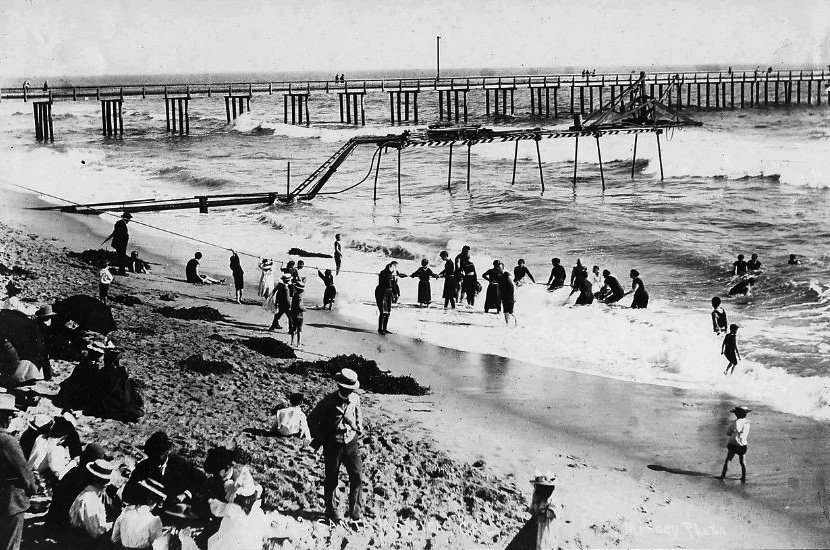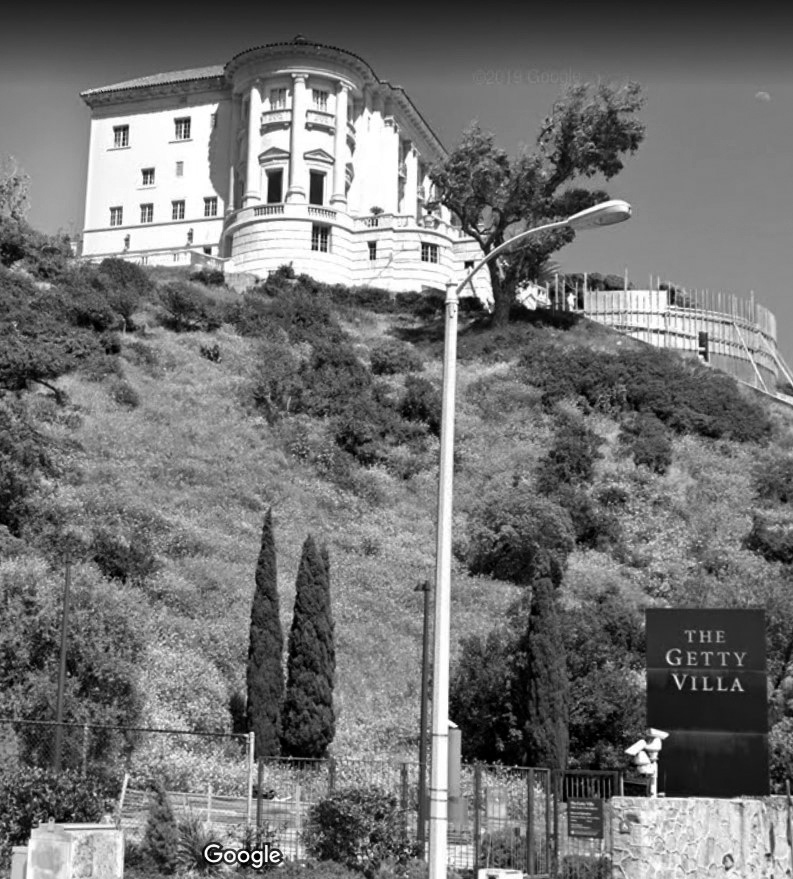Early Views of Santa Monica
Historical Photos of Early Santa Monica |
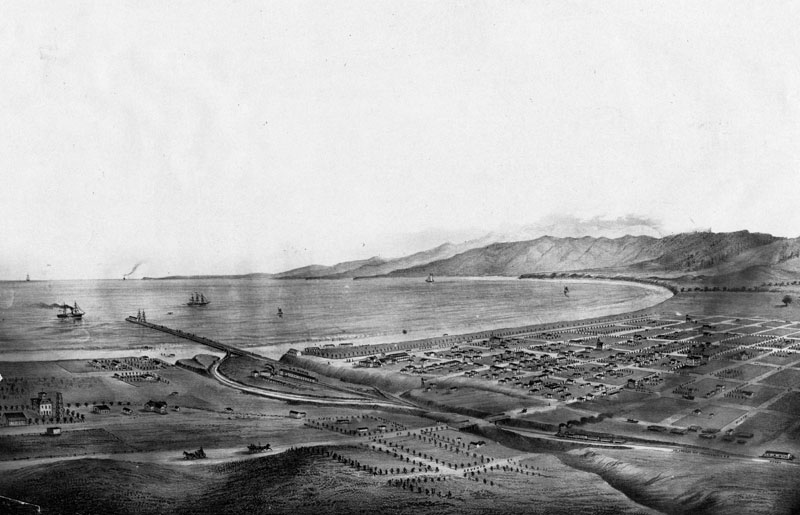 |
|
| (ca. 1875)* - View of Santa Monica and bay showing the road and wharf of the Los Angeles & Independence Railroad, about 1875. The wharf was completed in 1875 and sold in June 1877 to the Southern Pacific Railway Company, This print was photographed from an old lithograph. |
Historical Notes To make the town marketable, Jones built a 16-mile rail line between the Santa Monica Bay waterfront and downtown Los Angeles, naming it the Los Angeles and Independence Railroad. It was only the second railroad built in Los Angeles; the first was the Los Angeles and San Pedro, which opened in 1869. |
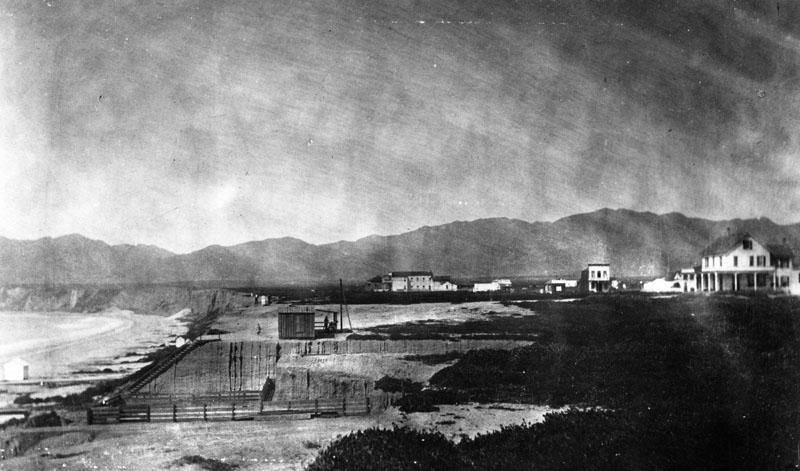 |
|
| (1877)* - View of Santa Monica looking north from the present Colorado Street, overlooking Ocean and 2nd Avenues. |
Historical Notes |
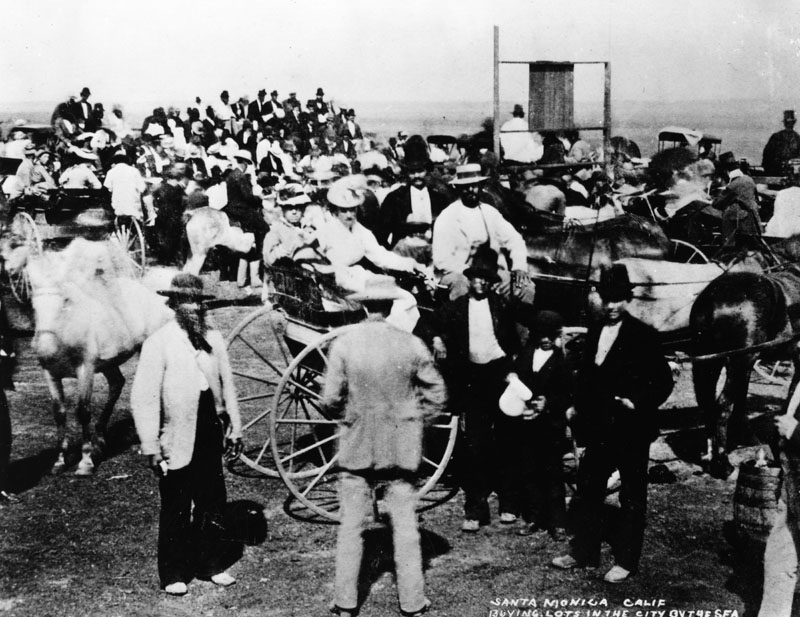 |
|
| (1875)* - Investors gathering to buy lots in Santa Monica which was promoted as the "City by the Sea." |
Historical Notes The land was auctioned on July 15, 1875 by the San Francisco Office of the Santa Monica Land Company. The advantages of Santa Monica were emphasized, particularly the superiority of its harbor over that of San Pedro. The lots sold for $500 and $750. Within a few weeks after the town lot sale a change had come over the barren plain. Houses and stores sprang up, a general store was opened and a newspaper started. |
* * * * * |
Third Street (Today, 3rd Street Promenade)
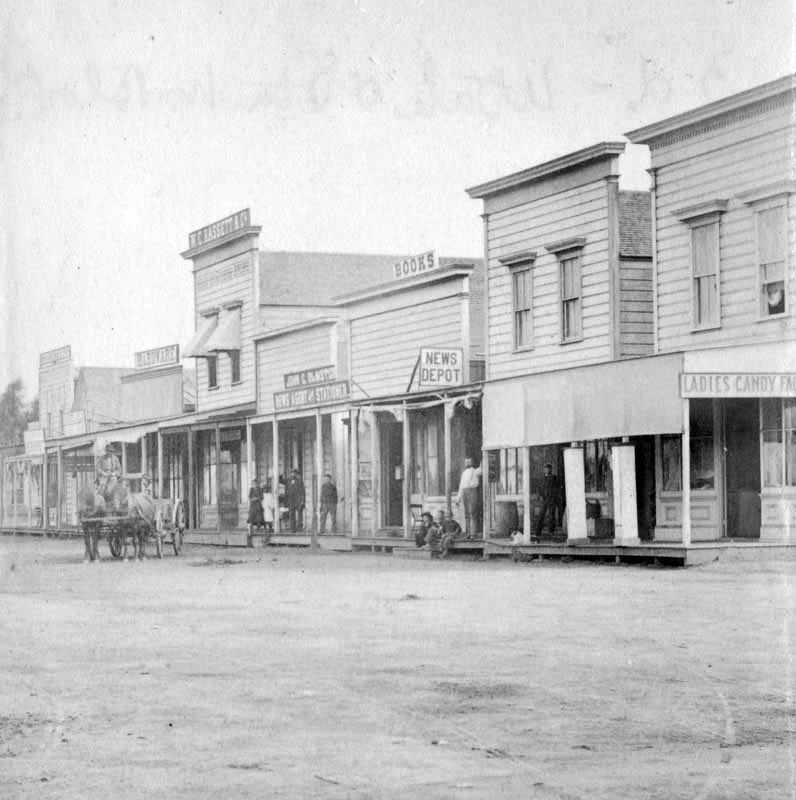 |
|
| (1880)* - A view of the business block on Third Street, between Utah (now Broadway) and Oregon (now Santa Monica Boulevard), shows what is today the site of the 3rd Street Promenade. This image was taken before Santa Monica became a city in 1886. |
Historical Notes The town continued to grow and, in November 1886, the electorate went to the polls and voted 97 to 71 to incorporate Santa Monica. |
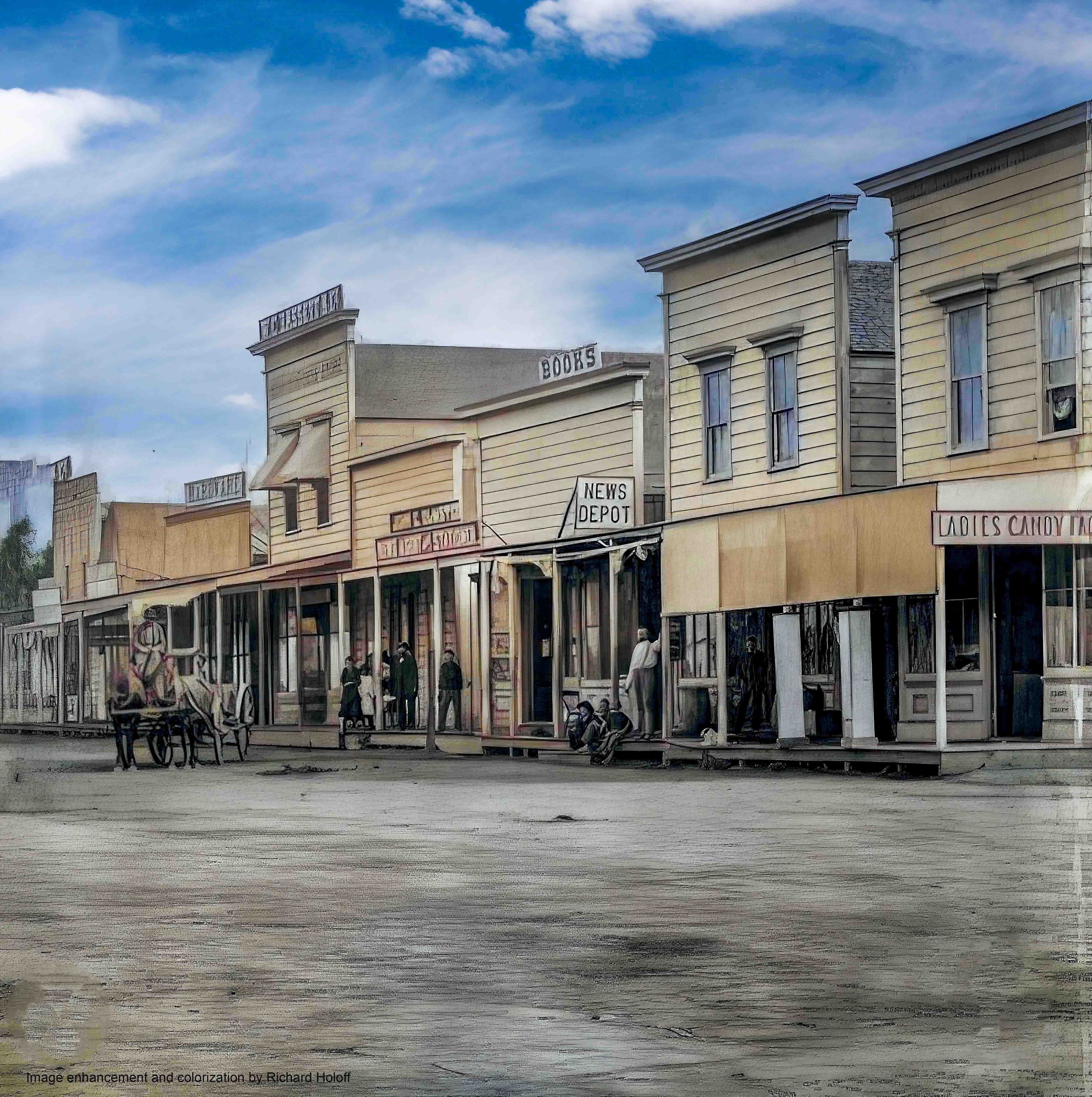 |
|
| (1880)* - A view of the business block on Third Street, between Utah (now Broadway) and Oregon (now Santa Monica Boulevard), shows what is today the site of the 3rd Street Promenade. This image was taken before Santa Monica became a city in 1886. Photo enhanced and colorized by Richard Holoff |
.jpg) |
|
| (ca. 1890)* - Four men and a child standing in the entrance to McKinnie's Pharmacy located on 3rd Street in Santa Monica, with a sign for "Mac's Favorite" on the sidewalk and the signs "Drug Store" and "Furnished Rooms" on the window of the brick building. Today, this site is located at Santa Monica’s 3rd Street Mall. Ernest Marquez Collection |
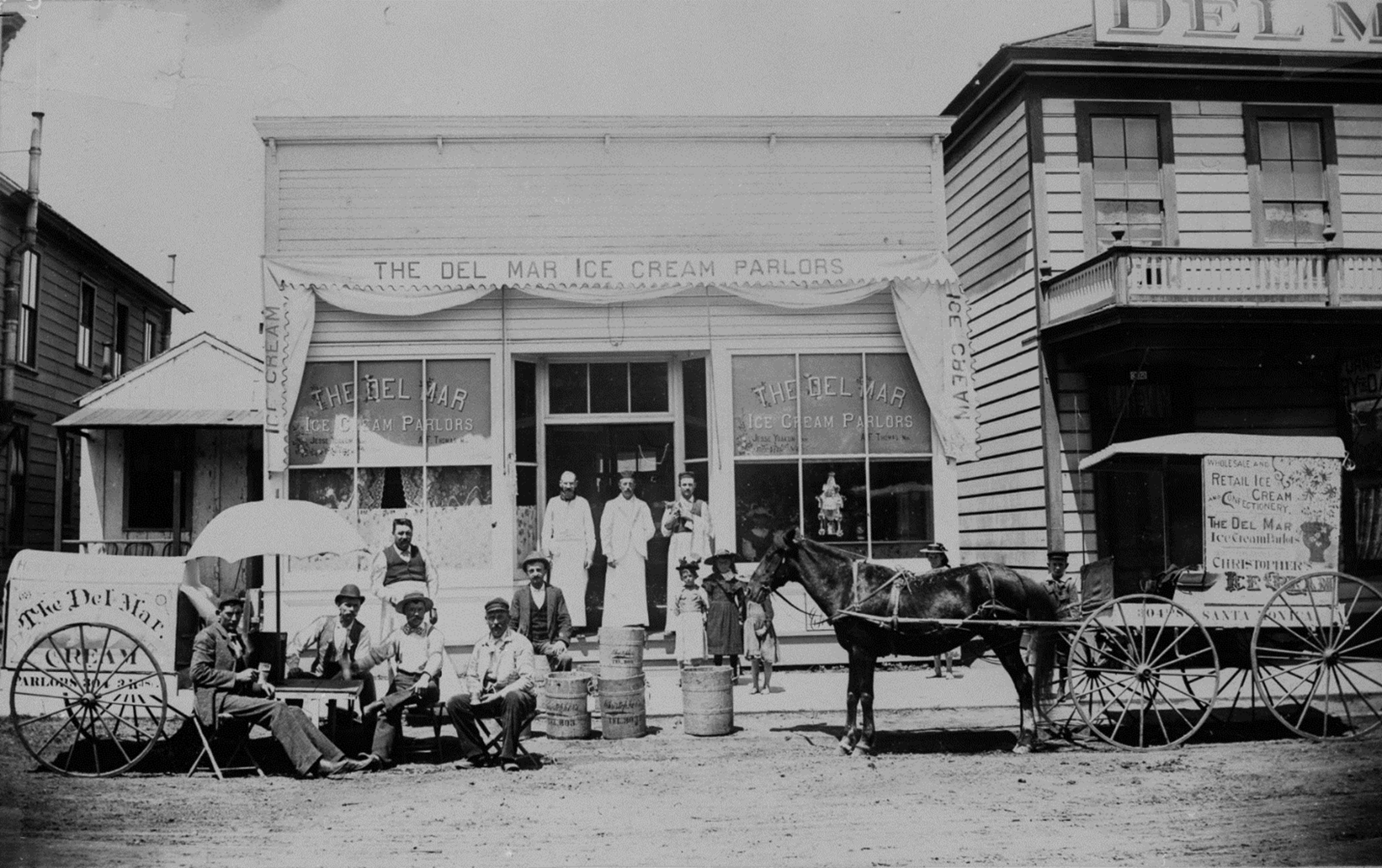 |
|
| (ca. 1890)* - A group of men and three young children pose for the camera in front of the Del Mar Ice Cream Parlor, located on the 1400 block of 3rd Street in Santa Monica. Signs painted on the side of a horse-drawn cart read "Wholesale and retail ice cream and confectionery, the Del Mar Ice Cream Parlors, Christopher's Ice Cream, Santa Monica." Today, this site is part of Santa Monica’s 3rd Street Mall. Ernest Marquez Collection |
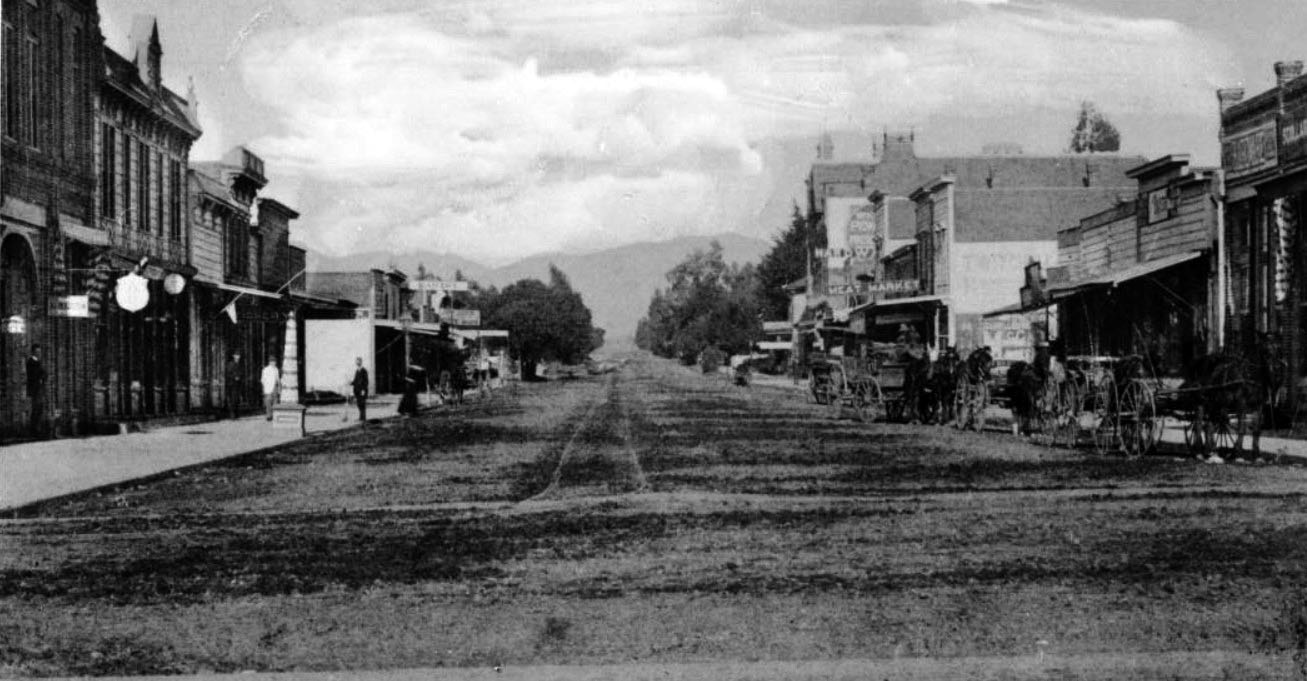 |
|
| (ca. 1891)* – Panoramic view of Santa Monica's Third Street from Utah (now Broadway) to Nevada Boulevard (now Wilshire). The dirt street is lined with square buildings containing various shops and stores. Several horse-drawn wagons are lined up at right, and there are pedestrians at left. The Opera House and the Catholic Church are on the right side of the street, while the First Presbyterian Church is on the corner of Nevada. The First Presbyterian Church can also be seen at the corner of Nevada Boulevard. |
Historical Notes The original naming convention for east-west avenues in Santa Monica, established when the townsite was laid out in 1875, used names of Western U.S. states and territories. In later years, many of these street names were changed. For example: |
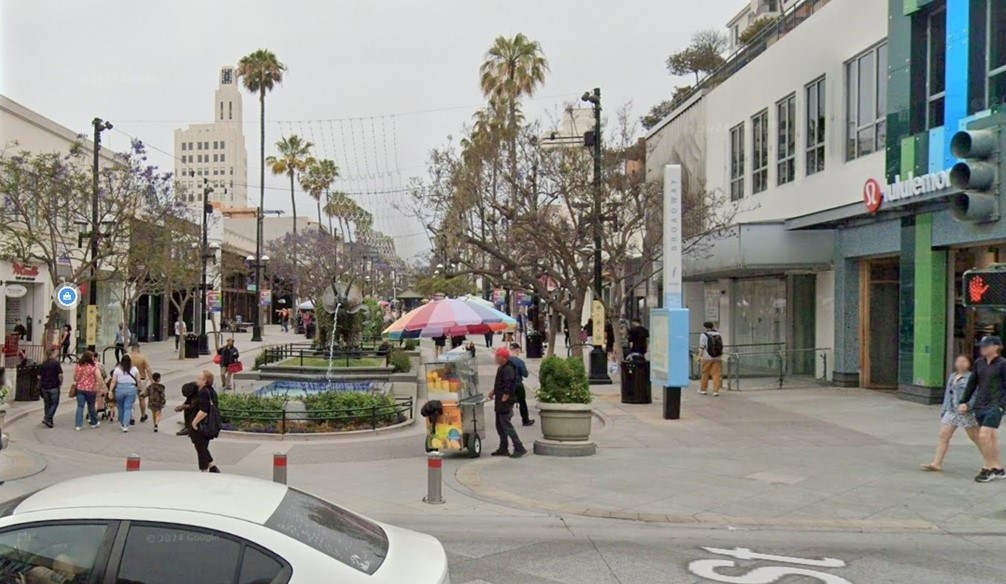 |
|
| (2024)* - Third Street Promenade in Santa Monica, looking northwest on Third Street at Broadway. |
Then and Now
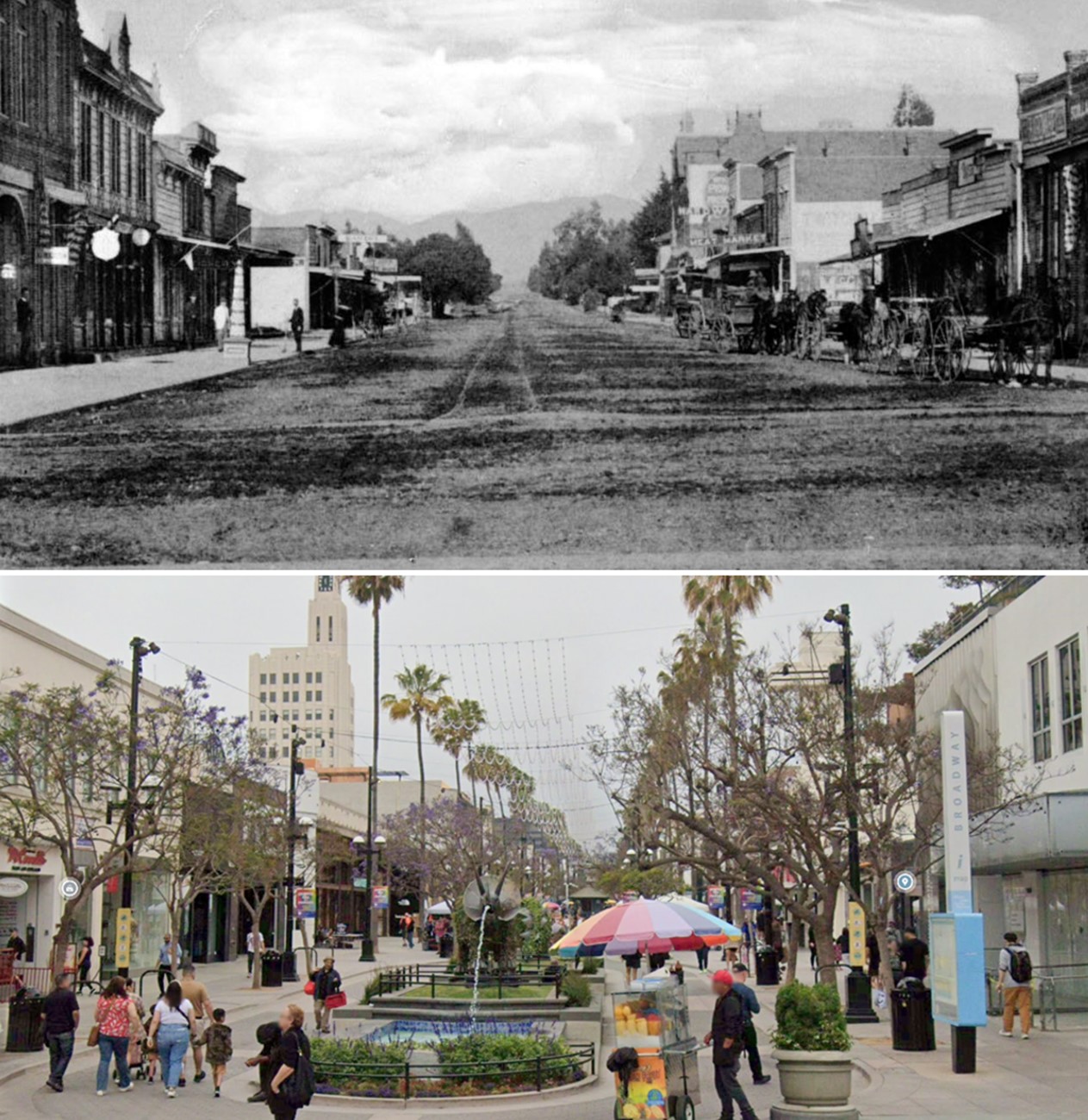 |
|
| (1891 vs 2024)* - Third Street Promenade in Santa Monica, looking northwest on Third Street at Utah (now Broadway). |
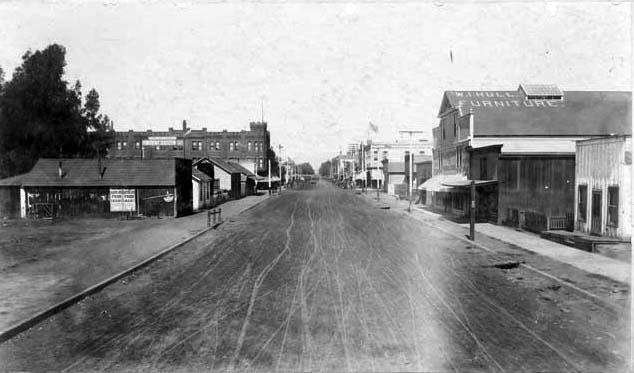 |
|
| (ca. 1896)^^ - Third Street looking north from Colorado Street, towards Broadway and Santa Monica Boulevard. View shows dirt street lined with clapboard stores and shops, one two-story brick castle-like building with crenelated turret (left center), W.T. Hull Furniture sign on roof of building at right, street trolley at distant center. |
Historical Notes Cllick HERE to see more early views of 3rd Street (1910), which would later become the 3rd Street Promenade. Click HERE to see more early views of the 3rd Street Promenade (1933+) |
* * * * * |
Los Angeles & Independence Railroad
.jpg) |
|
| (1876)* – A view of Los Angeles & Independence Railroad (LA&I) Locomotive No. 1, which operated between downtown Los Angeles and Santa Monica. Photo is from the Ernest Marquez Collection. |
Historical Notes The Los Angeles and Independence Railroad (LA&I) was a significant early railroad in Southern California, chartered in March 1874 and beginning operations on October 17, 1875. It ran a 16.67-mile steam-powered line between Santa Monica's Long Wharf and downtown Los Angeles. Initially ambitious, the LA&I aimed to reach San Bernardino and Independence, to serve the Cerro Gordo Silver Mines. Key figures in its establishment included former governor John G. Downey and banker F.P.F Temple. The railroad faced fierce competition from the Southern Pacific, engaging in the "Battle of the Pass" to secure a route through Cajon Pass. Despite completing its line and formally opening on December 1, 1875, the LA&I struggled to compete with Southern Pacific's extensive network and pricing strategies. |
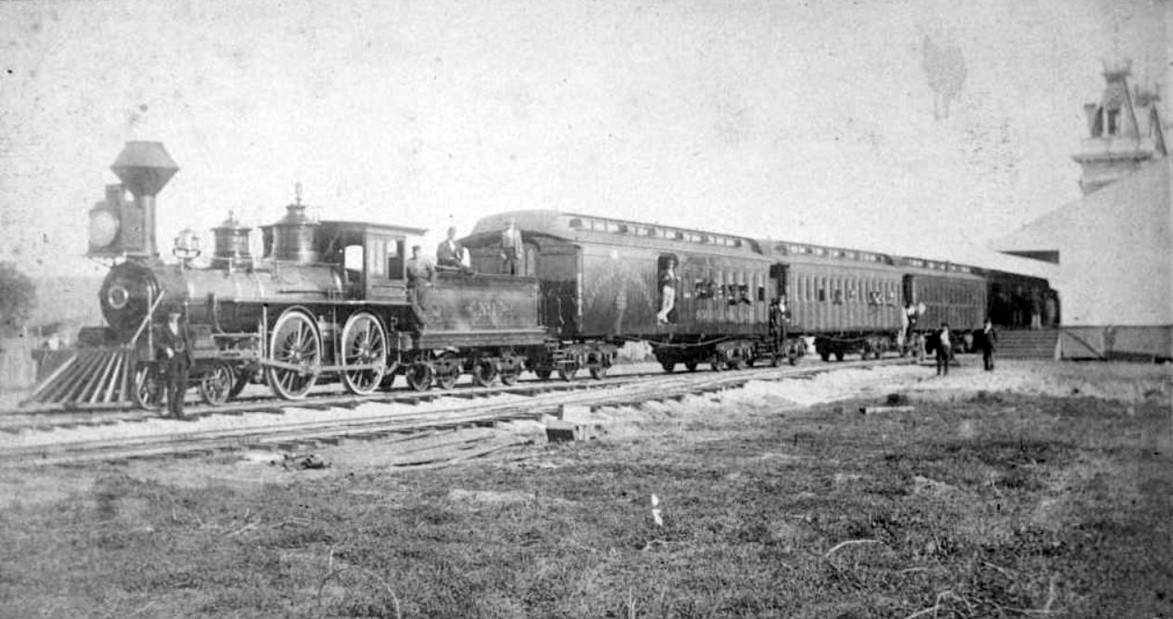 |
|
| (1876)* – View showing Locomotive No. 1 and passenger cars of the Los Angeles and Independence Railroad on train tracks next to the railroad's terminal at Fifth Street and San Pedro Street in Los Angeles. The train is full of passengers and is about to leave for Santa Monica. Photo from the Ernest Marquez Collection. |
Historical Notes The Los Angeles and Independence Railroad travelled from a wharf North of the current Santa Monica Pier in Santa Monica along a private right-of-way to 5th and San Pedro Street in downtown Los Angeles. The 16.67 miles of track between Los Angeles and Santa Monica were built by John P. Jones without government subsidies or land grants, all in a little over ten months - primarily using 67 Chinese laborers imported for the task. Right-of-way between Los Angeles and Santa Monica was given by local ranchers who were anxious to have access to a railroad. Click HERE to see more on the Los Angeles & Indempendent Railroad Depot in downtown Los Angeles. |
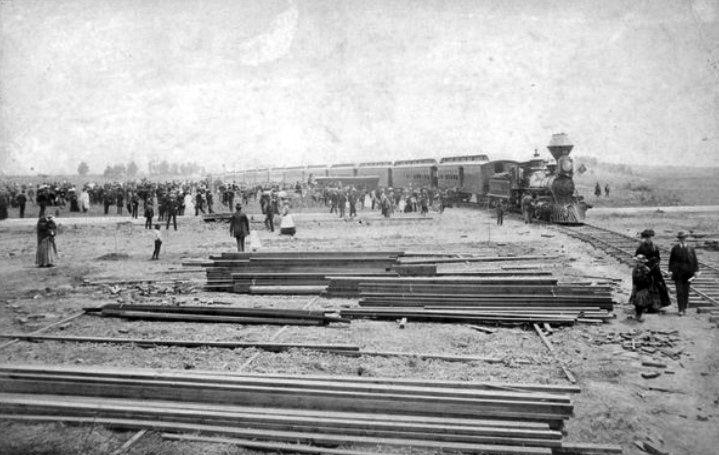 |
|
| (ca. 1878)* - Crowds of people surround a train in Santa Monica shortly after the Los Angeles & Independence RR was acquired by Southern Pacific. Piles of lumber are seen in the foreground. |
Historical Notes The line opened October 17, 1875, with two trains a day running between Santa Monica and Los Angeles; the fare was fixed at $1.00 per trip, freight at $1.00 per ton. |
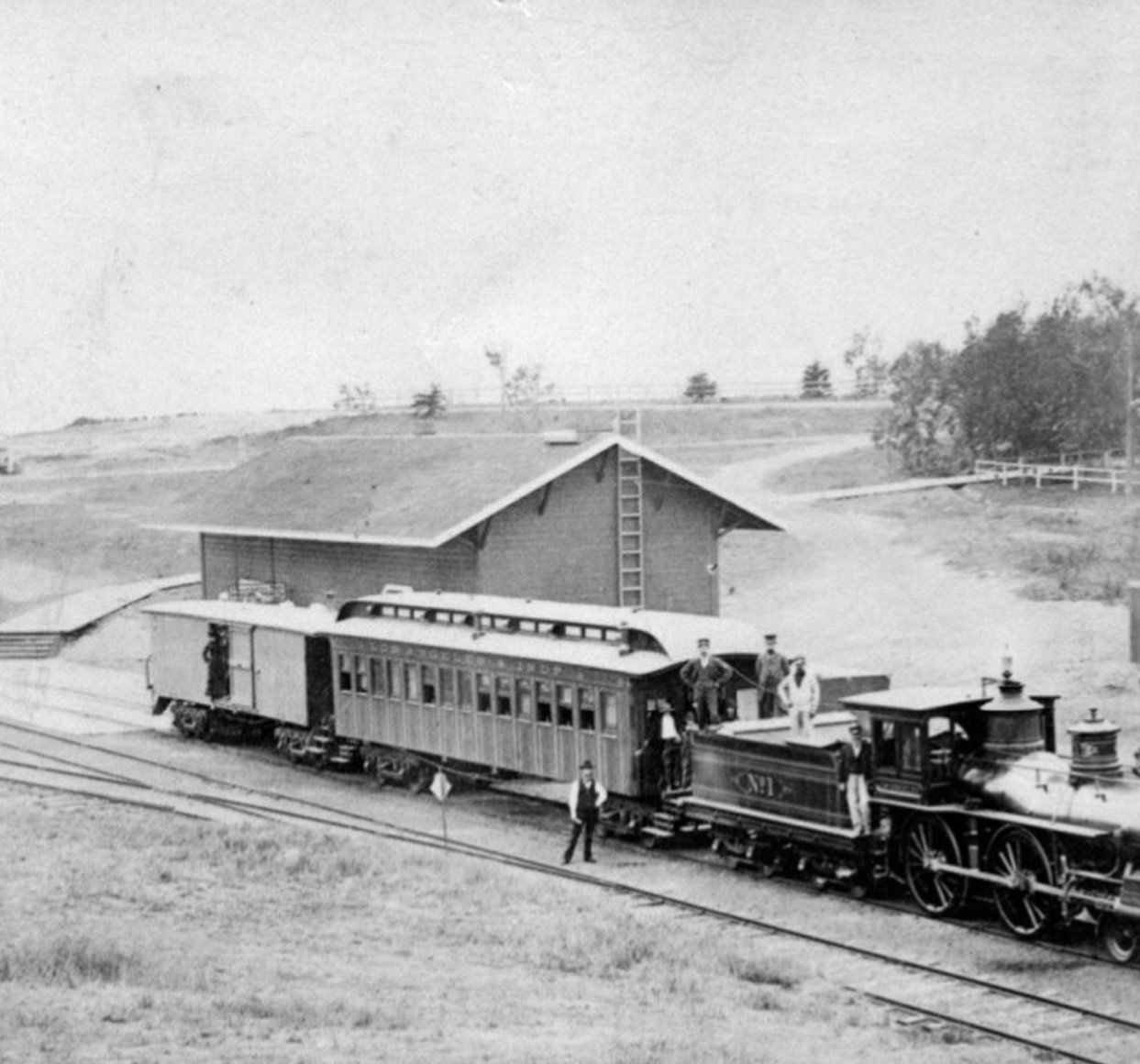 |
|
| (ca. 1878)* - View of a Los Angeles & Independence line passenger train sitting in front of the Santa Monica railway station. Several men standing on and adjacent to the train are posing for the photographer. |
Historical Notes The Los Angeles and Independence Railroad helped make Santa Monica palatable to real estate speculators and prospective residents, but Jones, who was politically well-connected as a U.S. senator from Nevada, had grander plans for the railroad. Intending to connect the line with the town of Independence in the Owens Valley, and from there to a silver mine he owned in the Panamint Mountains, Jones optimistically included "Independence" in his railroad's name. Jones, however, encountered financial problems stemming from his mines drying out. He reluctantly sold the Los Angeles and Independence to Collis P. Huntington's Southern Pacific Railroad on July 1, 1877 for $195,000. Click HERE for more on the Los Angeles and Independence Railroad. |
* * * * * |
Los Angeles & Independence Railroad Wharf (aka Shoo Fly Wharf)
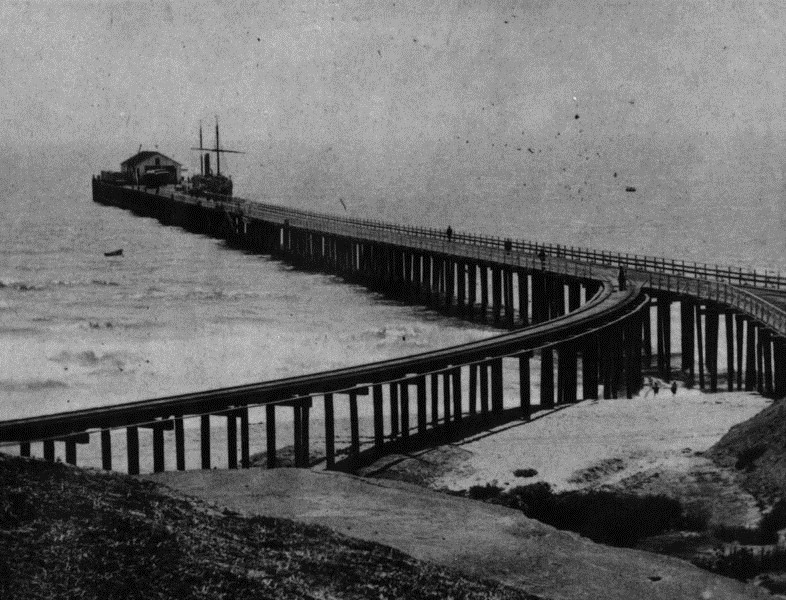 |
|
| (1877)* - View of the wharf built by the Los Angeles Independence Railroad Co. in Santa Monica (aka Shoo Fly Landing). |
Historical Notes As soon as work started on Los Angeles Independence Railroad line from Los Angeles to Santa Monica the construction of a new wharf was begun. This was located near the old "Shoo Fly" landing and near the present foot of Colorado Avenue, where a stub of the old wharf still remains. The first pile was driven April 22nd, 1875, and the first boat landed at the wharf in June. This wharf was 1700 feet in length and reached a depth of thirty feet at low tide. It was substantially built, with depot, and warehouses at its terminus and cost about $45,000. The wharf would be sold to Southern Pacific Railway Company in 1877. One short year later, Southern Pacific deemed the wharf unsafe for train usage and by 1888 it was torn down. |
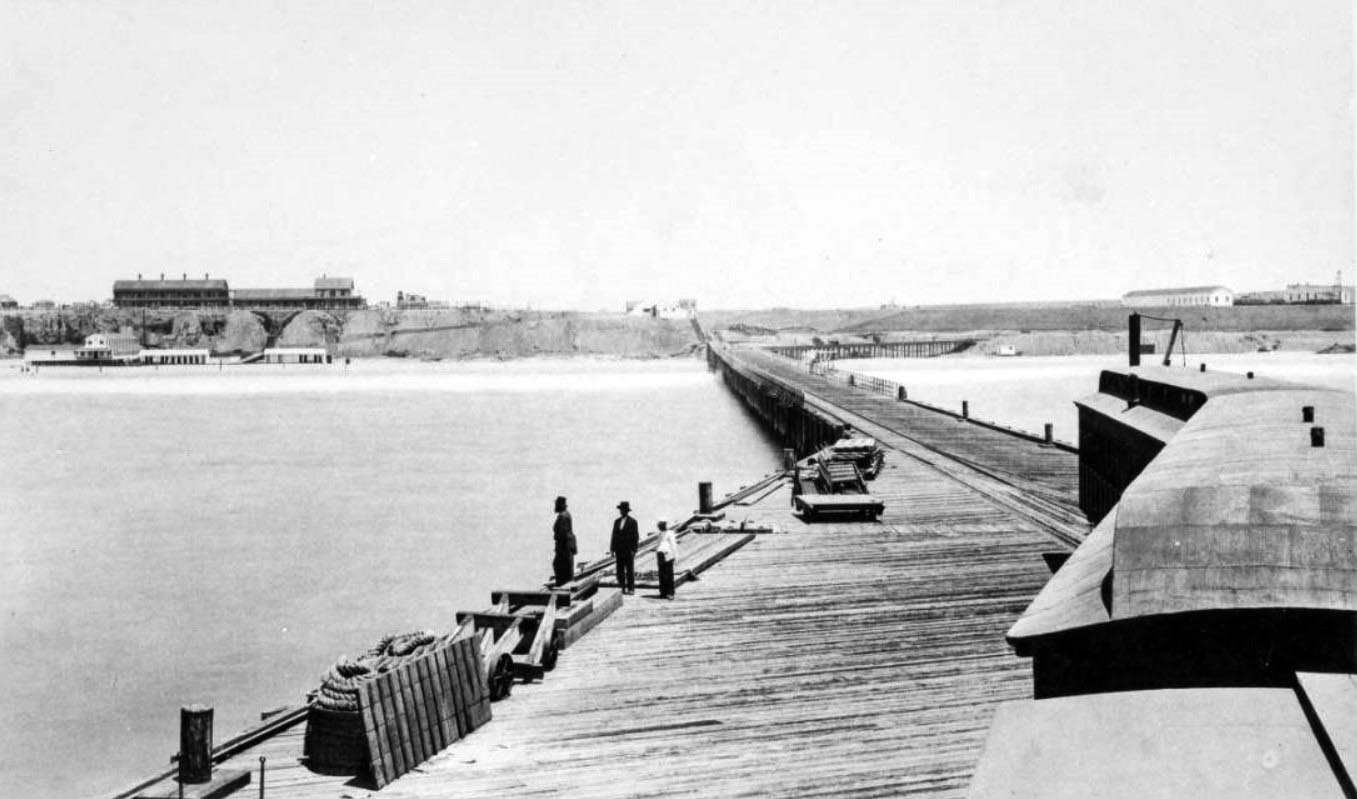 |
|
| (1877)* - Panoramic view of the shoreline as seen from the roof of a railroad train at end of the Los Angeles and Independence Wharf with the Santa Monica Hotel on the Palisades bluffs and the Santa Monica Bath House on the beach below. |
Historical Notes The wharf stood just south of the present location of the Santa Monica Pier at the foot of Colorado Avenue. Photo date devised based on the history of the Santa Monica Hotel, which was built in 1877 and the history of the photographer, Carleton E. Watkins, who made two visits to Southern California in 1877 and 1880. |
 |
|
| (ca. 1875)* - View of Santa Monica and bay showing the road and wharf of the Los Angeles & Independence Railroad (aka Shoo Fly Wharf). The wharf was completed in 1875 and sold in June 1877 to the Southern Pacific Railway Company, This print was photographed from an old lithograph. |
Historical Notes The east-west street adjacent to the railroad tracks was initially named "Railroad Avenue" due to its proximity to the rail line. This street would later be renamed Colorado Avenue in 1902, reflecting the practice of naming streets after western states. |
Then and Now
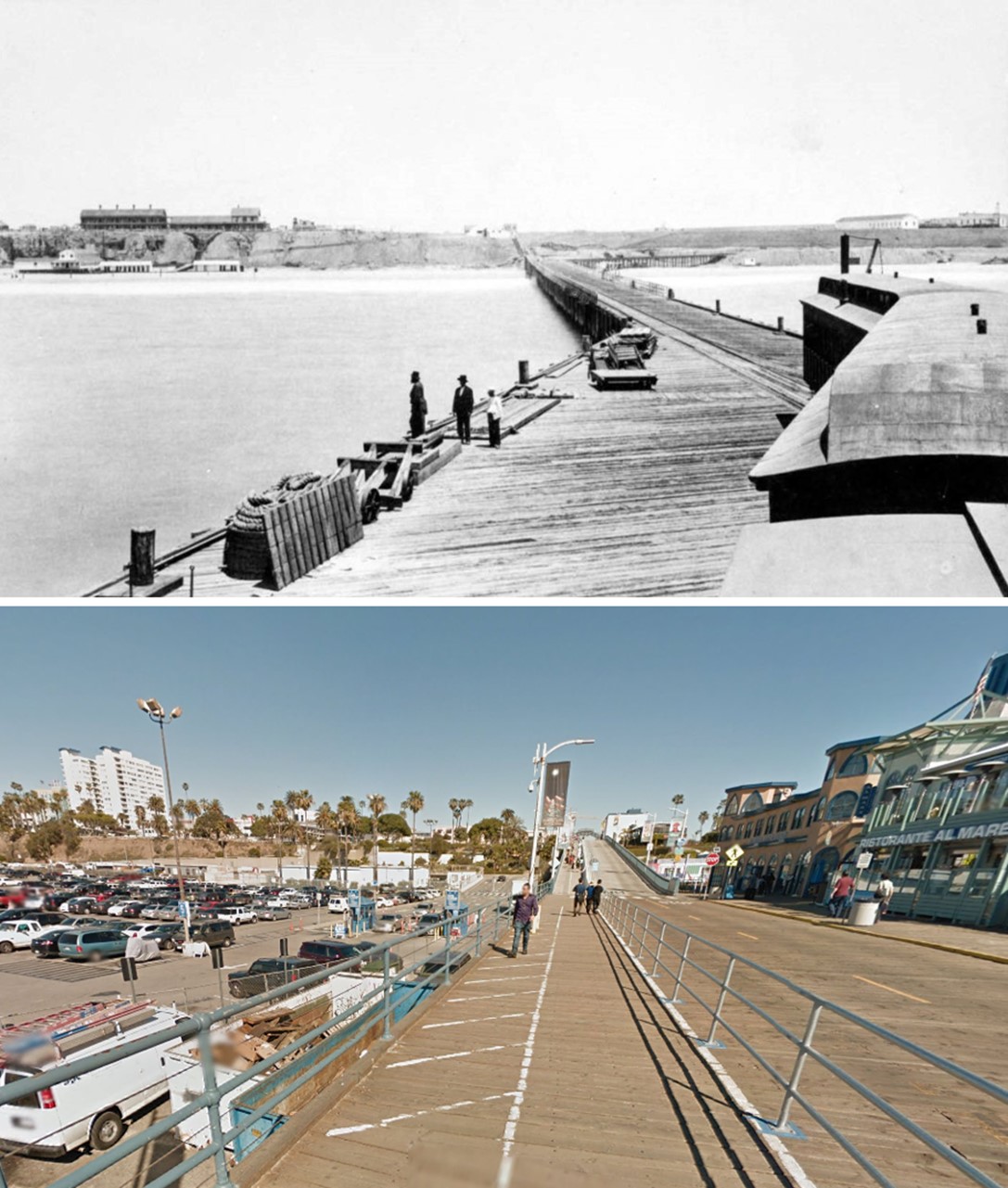 |
|
| (1877 vs. 2015)* – The coastline as seen from the Los Angeles and Independence Railroad Wharf and today’s Santa Monica Pier. |
Historical Notes Today, the Santa Monica Pier is located slightly south of the original wharf built by the Los Angeles Independence Railroad Co. in Santa Monica, also known as Shoo Fly Landing. For better perspective, the two piers are aligned in this Then and Now image. The larger building atop the bluffs in the earlier photo is the Santa Monica Hotel, built in 1877 and situated on Ocean Avenue between Railroad Street (now Colorado Avenue) and Oregon Avenue (now Santa Monica Boulevard). The contemporary image highlights a much wider beach, primarily due to human intervention through beach nourishment projects. Over 30 million cubic yards of sand have been added, sourced from infrastructure developments and dredging operations. |
* * * * * |
Santa Monica Beach and Bath Houses
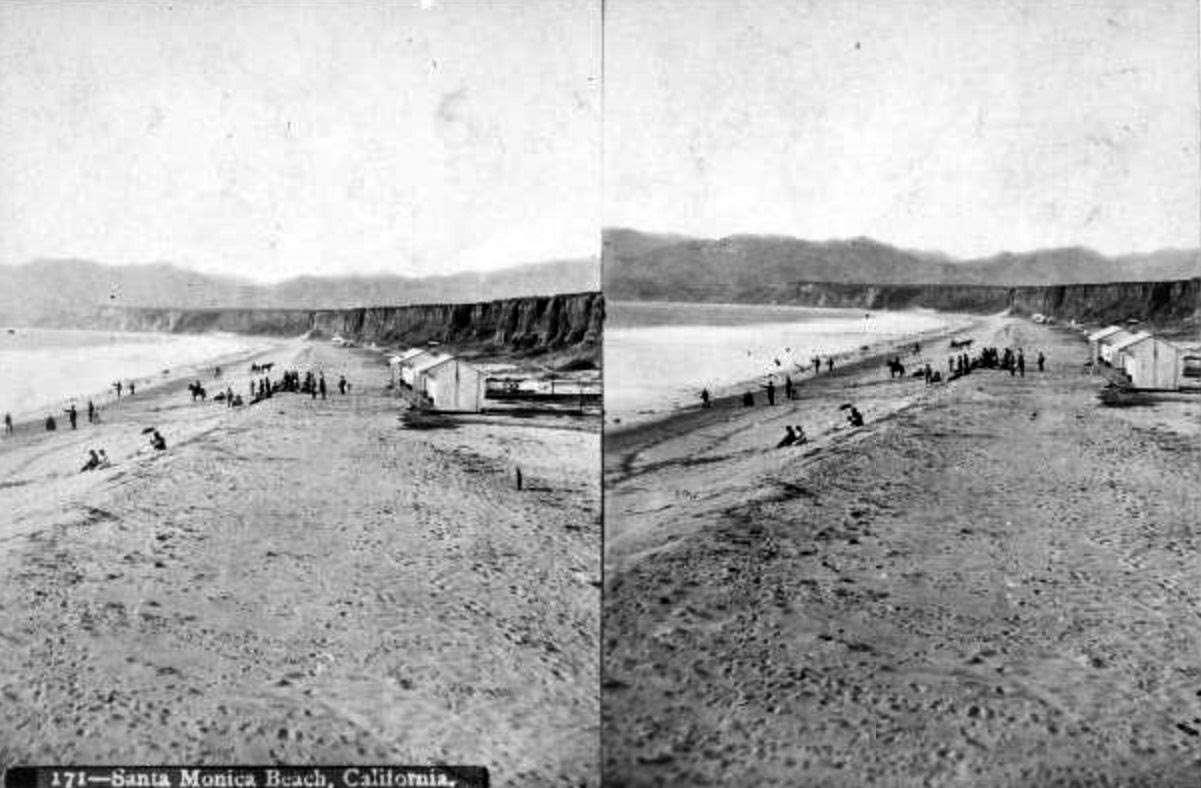 |
|
| (ca. 1876)* - Stereoscopic photo showing the beach in Santa Monica with beachgoers and buildings visible, including Michael Duffy's bathhouse visible in the background at the foot of the stairs along the Palisades cliffs. Note the horseback rider on the beach. |
Historical Notes Duffy’s Bathhouse, built in 1876 by entrepreneur Michael Duffy, was the first bathing establishment on Santa Monica’s beach. Located beneath the original Santa Monica Hotel at the base of the Palisades bluffs, it consisted of two simple structures housing 16 private rooms, each equipped with freshwater baths and showers—an uncommon amenity at the time. The facility operated until 1892 and played a foundational role in Santa Monica’s transformation from undeveloped coastline to a fashionable seaside retreat. |
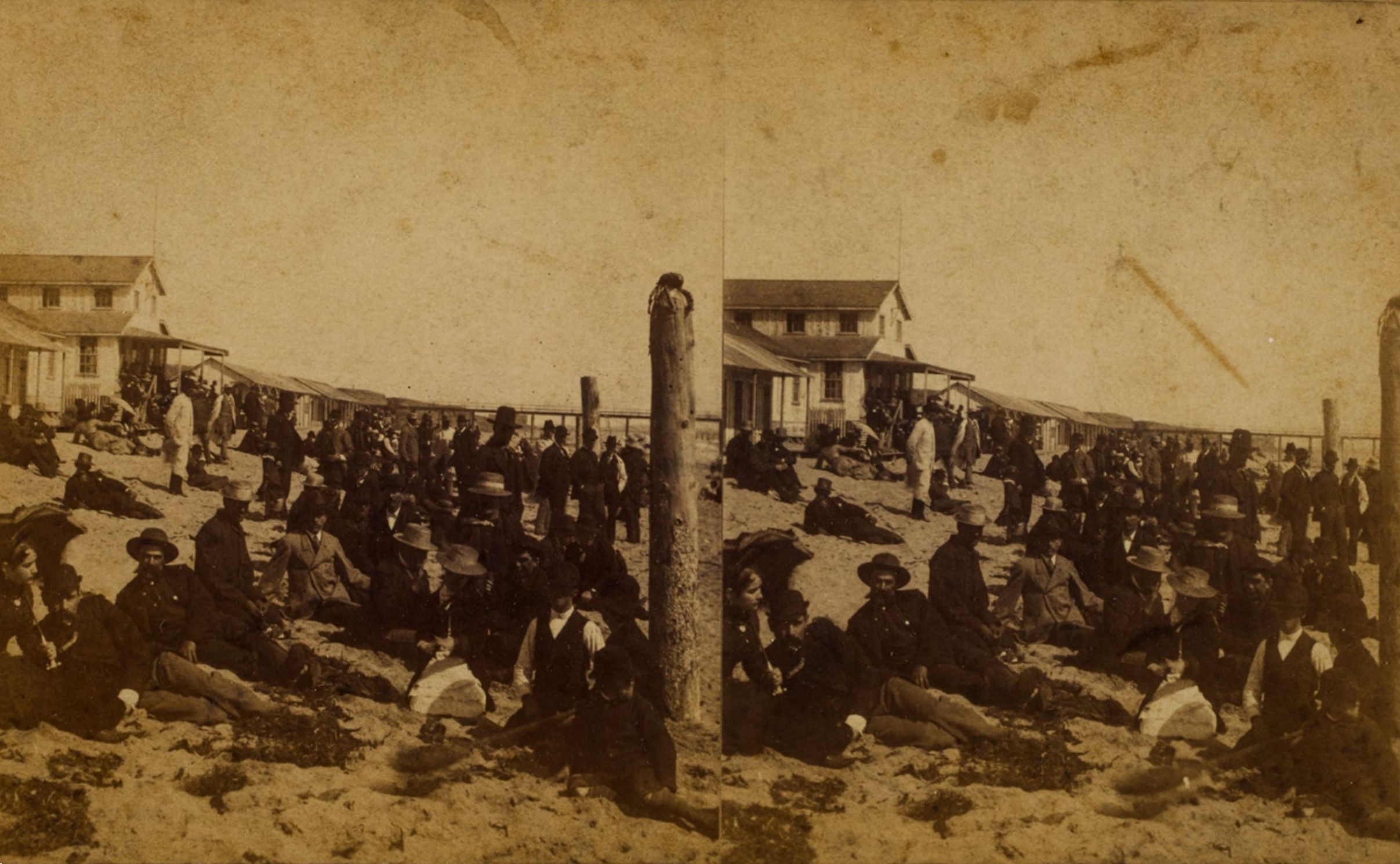 |
|
| (ca. 1877)* - Stereoscopic photo of people sitting on a beach, dressed in suit coats and hats, in front of the Santa Monica Bath House. In the distance, a portion of the Los Angeles and Independence Railroad Wharf is visible, near the approximate site of today’s Santa Monica Pier. Photo from the Ernest Marquez Collection. |
Historical Notes In 1877, Baker & Jones constructed the Santa Monica Bath House at the foot of Utah Avenue, just north of Duffy’s earlier structure. With steam baths, saltwater plunges, freshwater facilities, and rooms for rent, it was one of Southern California’s first purpose-built bathhouses. Its close proximity to the Los Angeles and Independence Railroad Wharf made it especially accessible to Angelenos seeking oceanfront recreation, contributing to the rise of the North Beach district as a premier coastal destination. |
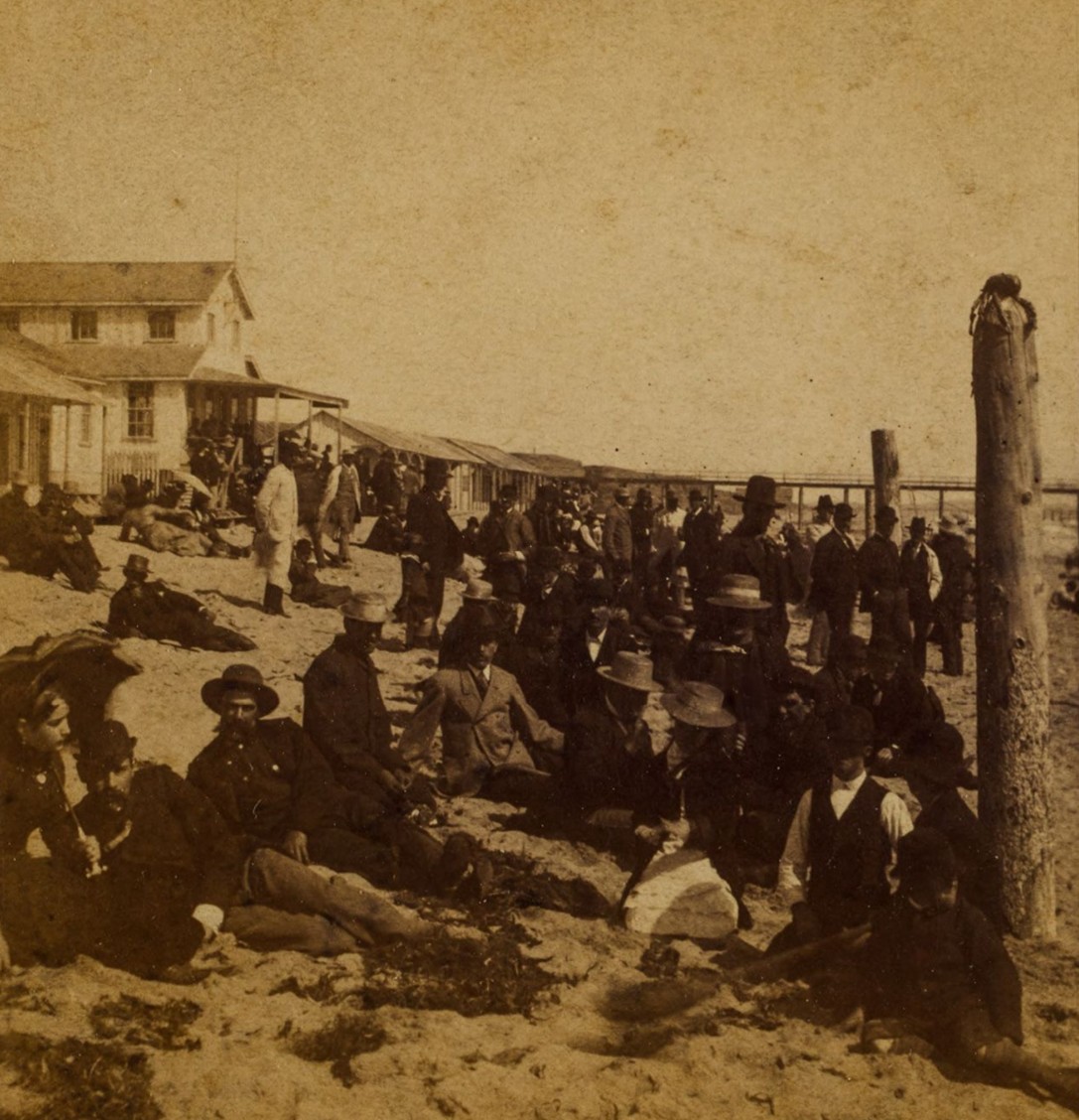 |
|
| (ca. 1877)* - Single (left-eye) view from the stereoscopic set showing Santa Monica’s early shoreline, with beachgoers in formal attire, a horseback rider, and the Santa Monica Bath House in the background. |
Historical Notes This left-eye panel from the 1877 stereoscopic image gives a clearer view of Santa Monica’s early recreational shoreline. The Santa Monica Bath House, built that same year, can be seen along with visitors arriving in their finest dress. The presence of the nearby railroad wharf helped turn what was once a quiet bluff-lined beach into a social and leisure hub for Los Angeles residents. |
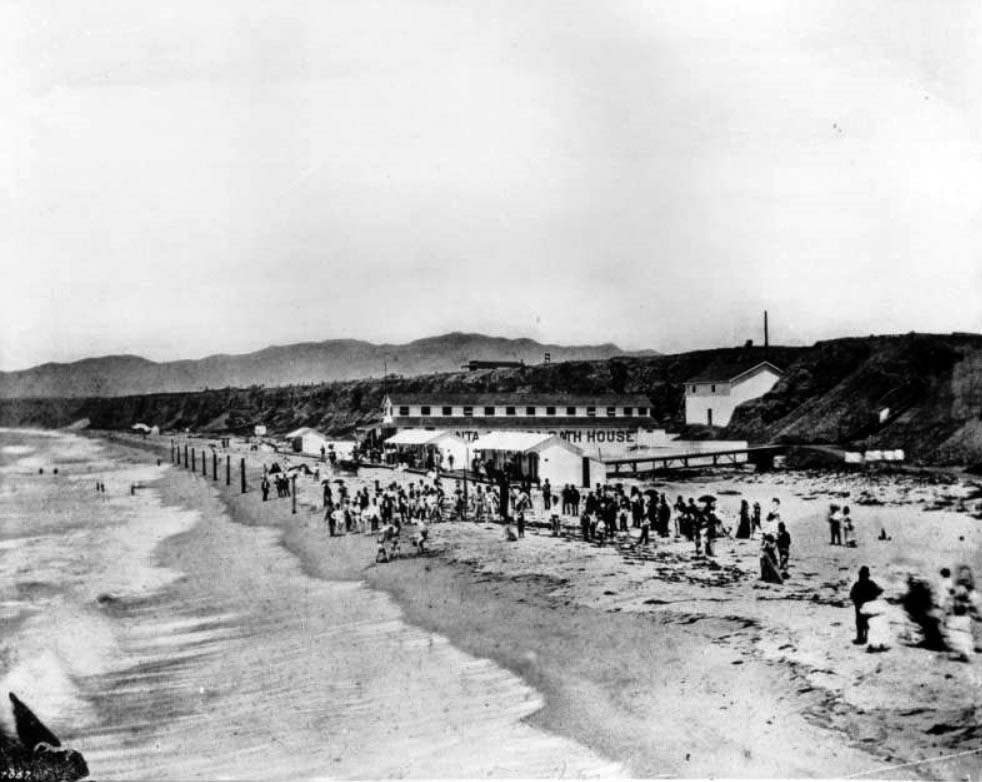 |
|
| (ca. 1884)* - View showing the Santa Monica Bath House next to Duffy's Bathhouse on Santa Monica Beach. The long, two-story, barn-like bathhouse stands at center below the bluff, with a small residence perched above. Crowds of beachgoers are seen along the shoreline. |
Historical Notes By the 1880s, the two neighboring bathhouses—Duffy’s original 1876 facility and the larger 1877 Santa Monica Bath House—defined the city’s emerging North Beach area. The Santa Monica Bath House featured oversized bathtubs, steam rooms, and rentable rooms, reflecting a more structured and resort-like approach to seaside leisure. These early facilities laid the groundwork for Santa Monica’s rise as a prominent beach town. |
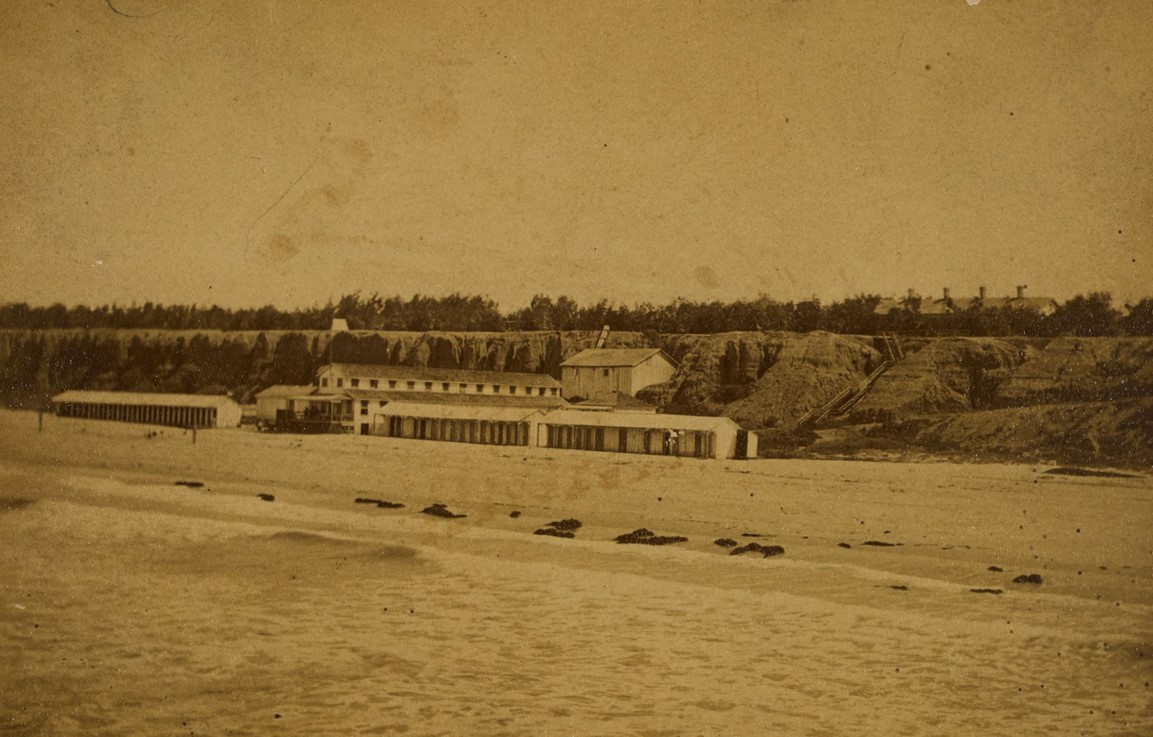 |
|
| (ca. 1885)* - View of the beachfront Santa Monica Bathhouse alongside Duffy's Bathhouse. At center-right can be seen the roofline of the new Santa Monica Hotel (built in 1877). Photo from the Ernest Marquez Collection. |
Historical Notes This image captures the peak of Santa Monica’s early bathhouse era. While Duffy’s modest operation was nearing its final years, the Santa Monica Bath House remained active into the late 1890s. Both were eventually surpassed by larger and more elaborate beachfront attractions like the North Beach Bath House (1894) and the Arcadia Hotel (1887), but their pioneering presence helped define Santa Monica’s coastal identity for decades to come. |
* * * * * |
Santa Monica Hotel
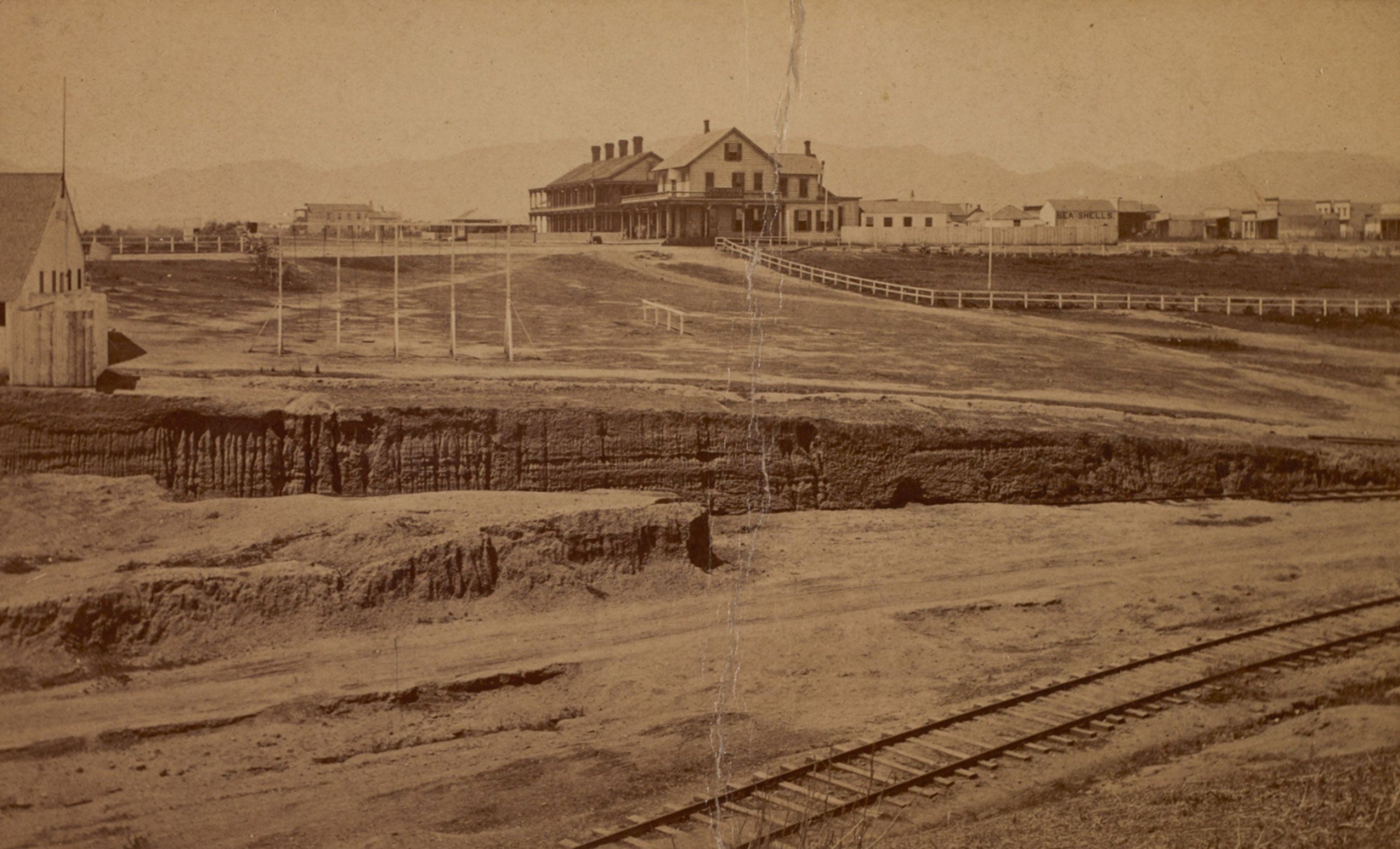 |
|
| (1877)* - Looking north toward the Santa Monica Hotel on Ocean Avenue, with railroad tracks visible in the foreground. A sign reading "Sea Shells" is painted on a building at right. A large gulch (ravine) sits between the hotel and the tracks. Photo by Carleton E. Watkins from the Ernest Marquez Collection. |
Historical Notes The Santa Monica Hotel, built in 1877, holds the distinction of being the first hotel in the city of Santa Monica, California. It was located on Ocean Avenue between what are now Colorado Avenue and Broadway, perched atop the coastal bluffs overlooking the Pacific Ocean. Its prime location offered guests sweeping ocean views and easy access to the beach below, making it a popular destination for early travelers. |
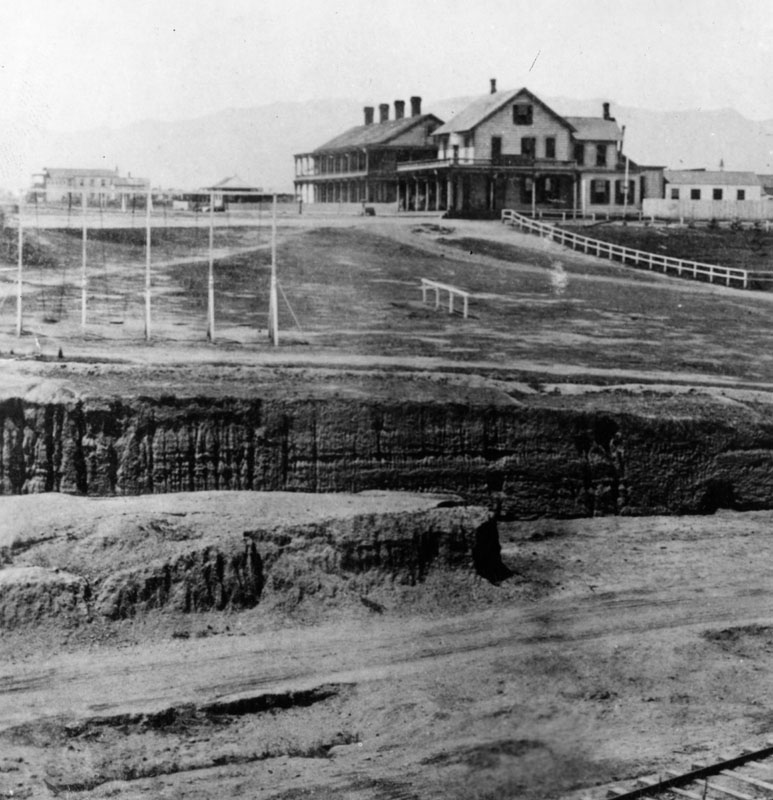 |
|
| (1877)* – Closer view of the Santa Monica Hotel, located on Ocean Avenue between Colorado and Utah (now Broadway). Note the large gulch (ravine) forming the southern boundary of the hotel's property. |
Historical Notes The historic gulch (ravine) in Santa Monica closely corresponds to the site of today’s McClure Tunnel, which passes through the ocean bluffs beneath the intersection of Colorado Avenue and Ocean Avenue, near the Santa Monica Pier. Historically, the gulch separated the bluffs north and south of Colorado Avenue and was a major topographical feature. The original railroad tunnel (built in 1886) and the later automobile tunnel (opened in 1936) were both constructed here to span the ravine, which was eventually filled in to create the modern connection between the Santa Monica Freeway (CA-1/CA-2) and Pacific Coast Highway (PCH). |
 |
|
| (2025)* – Google map showing the former location of the Santa Monica Hotel, which stood for only a decade before being destroyed by fire in 1887. |
Historical Notes The location of the historic gulch (ravine) in Santa Monica corresponds closely to the site of the present-day McClure Tunnel, which connects the Santa Monica Freeway (CA-1/CA-2) to Pacific Coast Highway (PCH). The McClure Tunnel passes through the Santa Monica ocean bluffs, directly underneath the intersection of Colorado Avenue and Ocean Avenue, and near the Santa Monica Pier. |
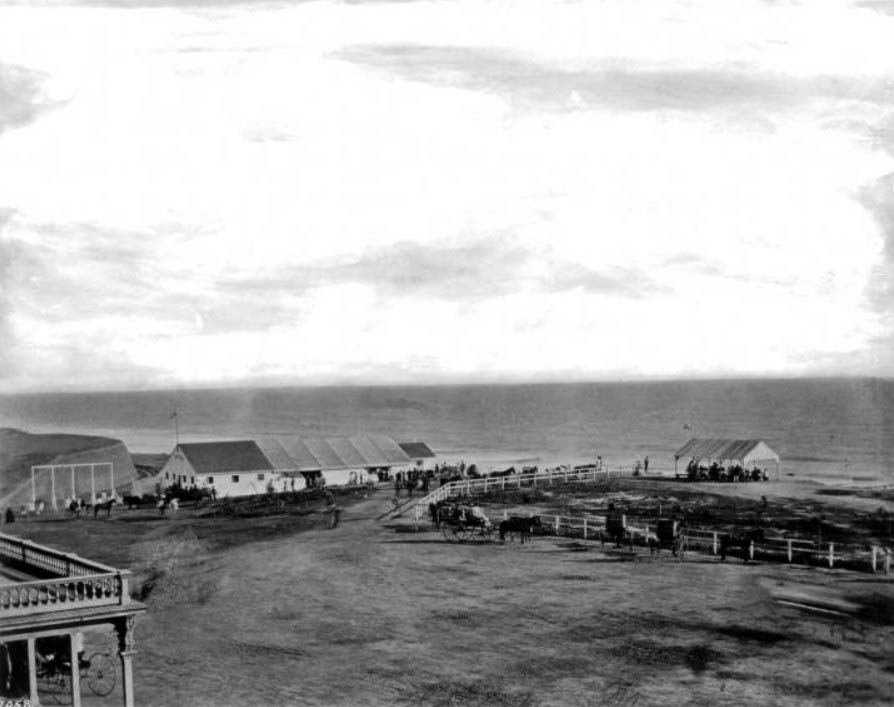 |
|
| (ca. 1885)* - Photograph of a view of the shore at Santa Monica taken from the Old Santa Monica Hotel. The balcony of the Old Santa Monica Hotel is visible in the left foreground while a long stable-style building stands surrounded with people in the distance. Horse-drawn carriages park and drive along the perimeter of a crescent of post-and-rail fence that demarcates a clearing at center behind which people are seated under a gazebo. Some kind of frame, possibly for the wall of a new building, has been erected to the far left. The ocean is visible in the background. |
Historical Notes At the time of the hotel’s construction, Santa Monica was a young and rapidly growing community, founded just two years earlier in 1875. The arrival of the Los Angeles and Independence Railroad brought a steady stream of visitors and investors, creating a demand for accommodations. The Santa Monica Hotel met that need and quickly became a local social and recreational hub. Nearby, the city’s first bathhouse—built in 1876—added to the area’s appeal by offering freshwater baths and showers to guests and residents. A later image with a bridge built over the ravine that is visible in the center of this image is seen HERE. |
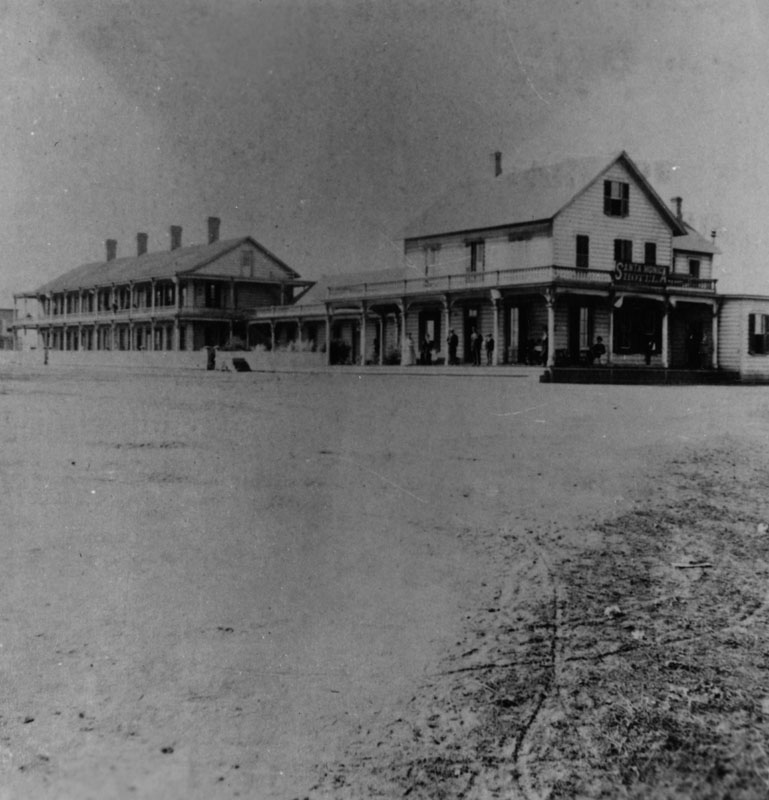 |
|
| (1885)* - A close-up view of the short-lived Santa Monica Hotel which burned down in 1887. |
Historical Notes At the time of the hotel’s construction, Santa Monica was a young and rapidly growing community, founded just two years earlier in 1875. The arrival of the Los Angeles and Independence Railroad brought a steady stream of visitors and investors, creating a demand for accommodations. The Santa Monica Hotel met that need and quickly became a local social and recreational hub. Nearby, the city’s first bathhouse—built in 1876—added to the area’s appeal by offering freshwater baths and showers to guests and residents. It's worth noting that while the Santa Monica Hotel was the first proper hotel in the town, there were earlier accommodations for visitors. For instance, in 1876, Michael Duffy constructed what is believed to be Southern California's first beachside bathhouse, which included 16 rooms with freshwater baths and showers. However, this was not considered a full-fledged hotel in the same sense as the Santa Monica Hotel. |
 |
|
| (ca. 1885)* - View showing the Santa Monica Hotel on Ocean Avenue with horse-drawn wagons and buggies in front and people standing on the porch and balcony. The larger back building housed the sleeping quarters, the front building had offices and the dining room. |
Historical Notes The Santa Monica Hotel helped shape the city’s early identity as a destination for leisure and tourism. Its legacy endures in Santa Monica’s continued status as a vibrant, world-renowned coastal retreat, and it remains an important chapter in the city's rich and colorful history. |
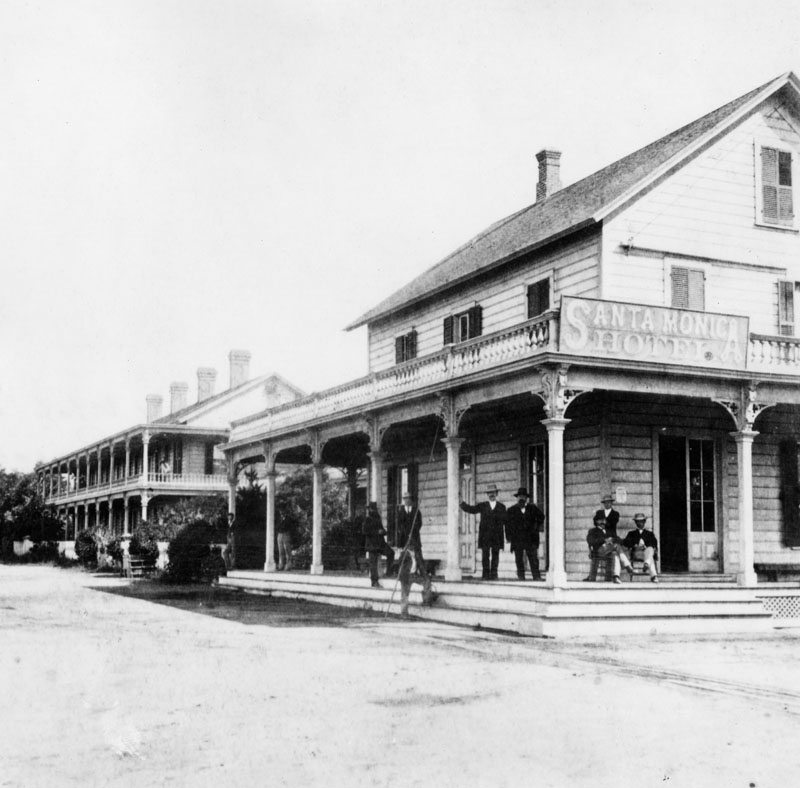 |
|
| (1885)* - A clearer image of the Santa Monica Hotel showing several people standing on the porch. |
Historical Notes Unfortunately, the Santa Monica Hotel's existence was short-lived. It burned down in 1887, just ten years after its construction. In the same year, a new hotel called the Arcadia Hotel was built near the site of the original Santa Monica Hotel. The Arcadia Hotel was a more luxurious establishment, featuring 125 rooms and the latest amenities of the time. |
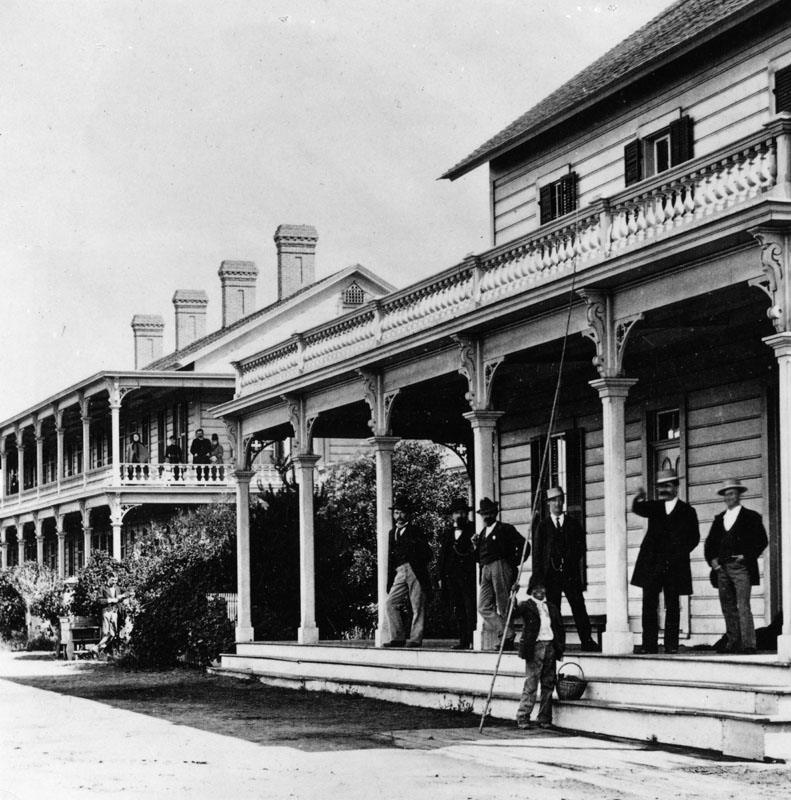 |
|
| (1885)* - An even closer view of the Santa Monica Hotel with what appears to be hotel guests standing on the porch and balcony looking toward the photographer. |
Historical Notes The hotel served Santa Monica for a decade before being destroyed by fire in 1887. Its owner, J.W. Scott, responded by building the larger and more luxurious Arcadia Hotel on a nearby site, which would go on to become a celebrated coastal landmark. Though its lifespan was brief, the Santa Monica Hotel played a key role in establishing the town’s reputation as a seaside resort. |
* * * * * |
Duffy's and Santa Monica Bathhouses
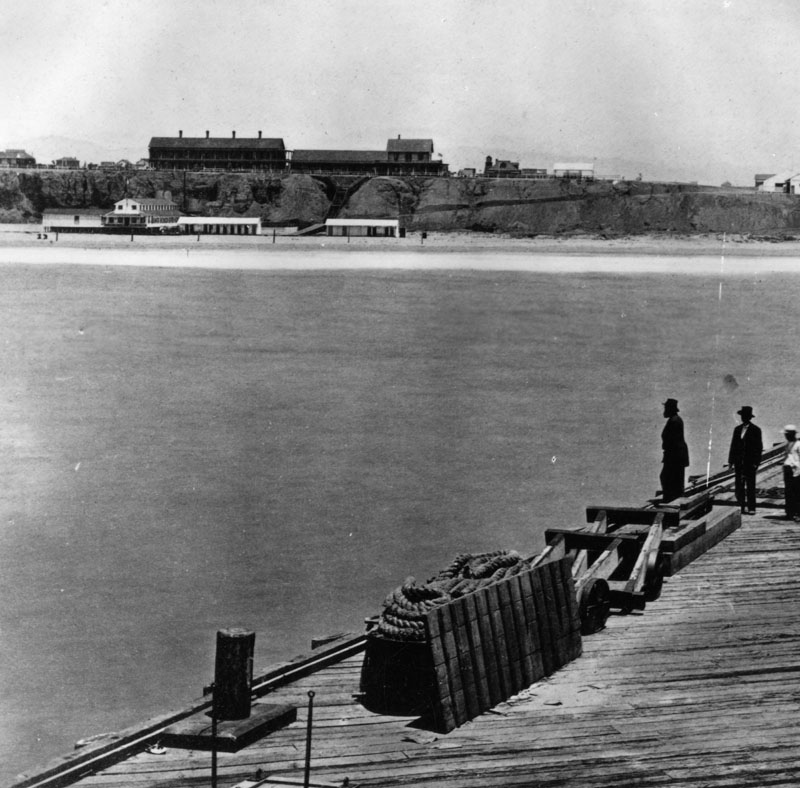 |
|
| (ca. 1877)* - View looking at the shoreline from near the end of the Los Angeles and Independence Wharf with the Santa Monica Hotel on the Palisades and the Santa Monica Bathhouse on Sunset Beach between Colorado and Utah (now Broadway). |
Historical Notes The first bathhouse on Santa Monica’s beach was built by Michael Duffy beneath the Santa Monica Hotel in 1876 and had 2 structures with 16 rooms with their own freshwater bath and shower. It closed in 1892. |
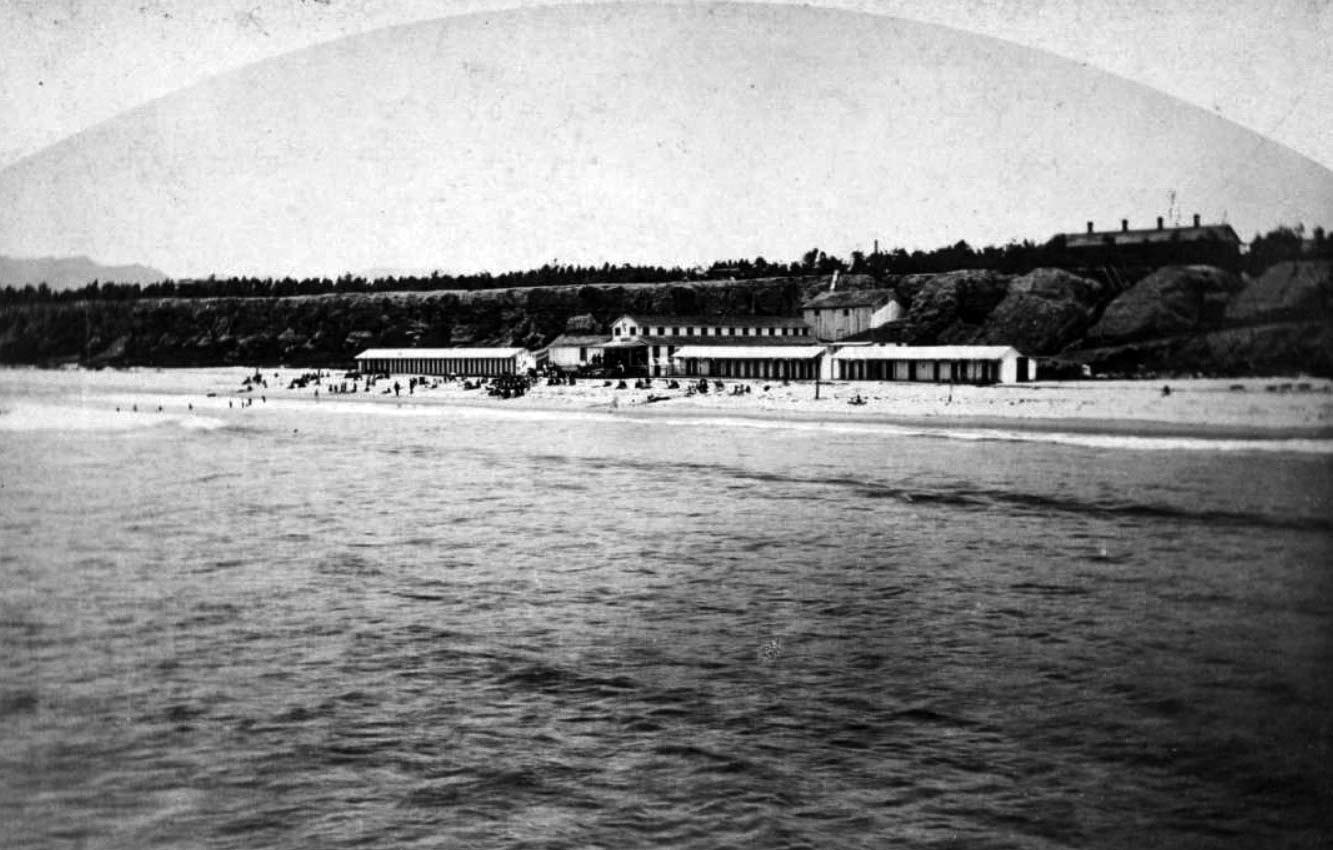 |
|
| (ca. 1877)* - Image of people on the beach in front of the Santa Monica Bath House and Michael Duffy's Bath House (two long one-story buildings at right of the two-story Santa Monica Bath House) with the Santa Monica Hotel on the bluffs at right and the Ocean House on the bluffs among the trees at far left. |
Historical Notes During the ensuing years several other bathouses were built at the same site. Bathouses, featuring hot saltwater baths, were a big tourist draw to Santa Monica in the late 1800s and early 1900s. |
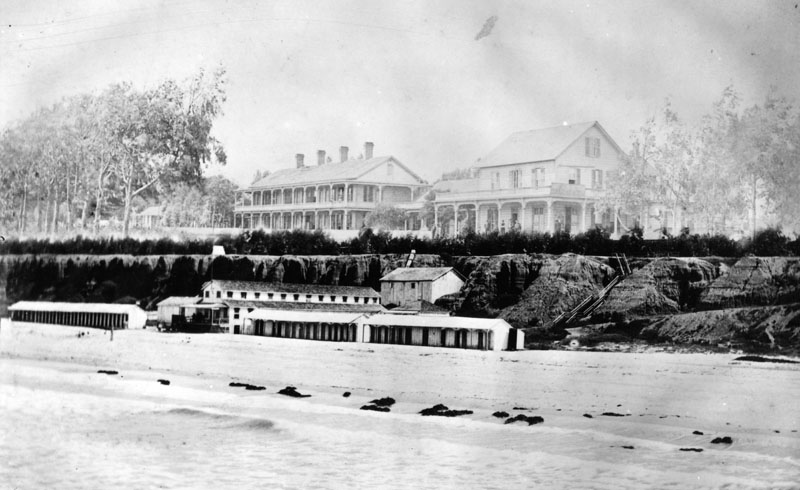 |
|
| (ca. 1880)* - The Santa Monica Hotel can be seen on the Palisades, which overlooks the beach at Santa Monica. Several people are standing or sitting on the veranda of the building on the right. A stairways (right) gives easy access from the Palisades to the beach. The two single-story structures in the lower center are Santa Monica beach's first bathouses. |
Historical Notes In 1887 the Santa Monica Hotel burned down. That same year the owner of the former Santa Monica Hotel, J. W. Scott, constructed a massive new hotel, the Arcadia Hotel. It was located near the site of the original Santa Monica Hotel at the corner of Ocean Avenue between Colorado and Pico Boulevard. The luxurious Arcadia Hotel had 125-rooms and featured the latest amenities. |
* * * * * |
Santa Monica Beach
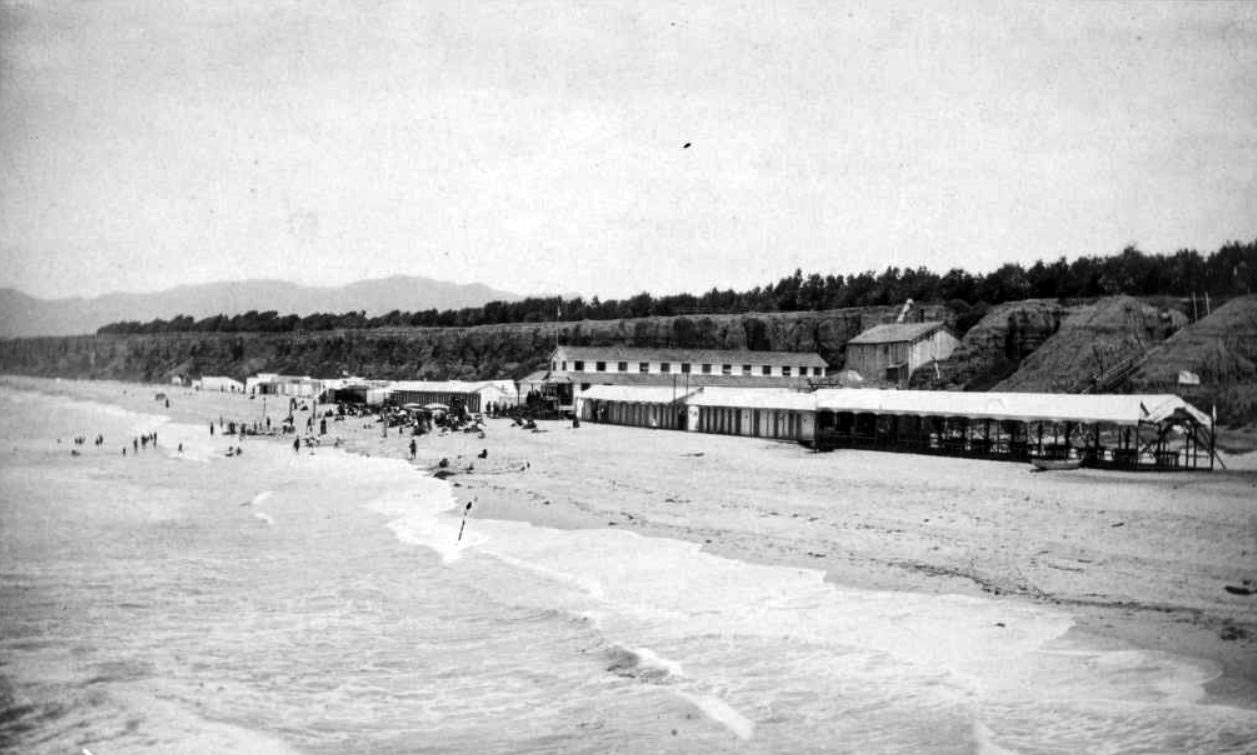 |
|
| (1880)* - Image of people on the beach in front of the Santa Monica Bath House and Michael Duffy's Bath House (two long one-story buildings at right of the two-story Santa Monica Bath House) with the Santa Monica Hotel on the bluffs at right and the Ocean House on the bluffs among the trees at far left. |
Historical Notes lIn the 1880s, Santa Monica's North Beach area already boasted several bath houses, setting the foundation for its reputation as a popular seaside resort. The trend began in 1876 when Michael Duffy constructed what is believed to be Southern California's first beachside bathhouse, featuring 16 rooms with freshwater baths and showers. The following year, the Santa Monica Bath House opened adjacent to Duffy's establishment, offering additional amenities such as steam baths and a saltwater pool. This bath house, built by Baker & Jones at the foot of Utah Avenue, continued to operate throughout the 1880s, as evidenced by images from that period. The area's popularity further increased with the opening of the Arcadia Hotel in 1887, which provided its guests with access to a large saltwater bathhouse. While these early facilities were not as grand as the famous North Beach Bath House that would be built in 1894, they played a crucial role in establishing Santa Monica's North Beach as a sought-after destination for beachgoers and tourists during the 1880s. |
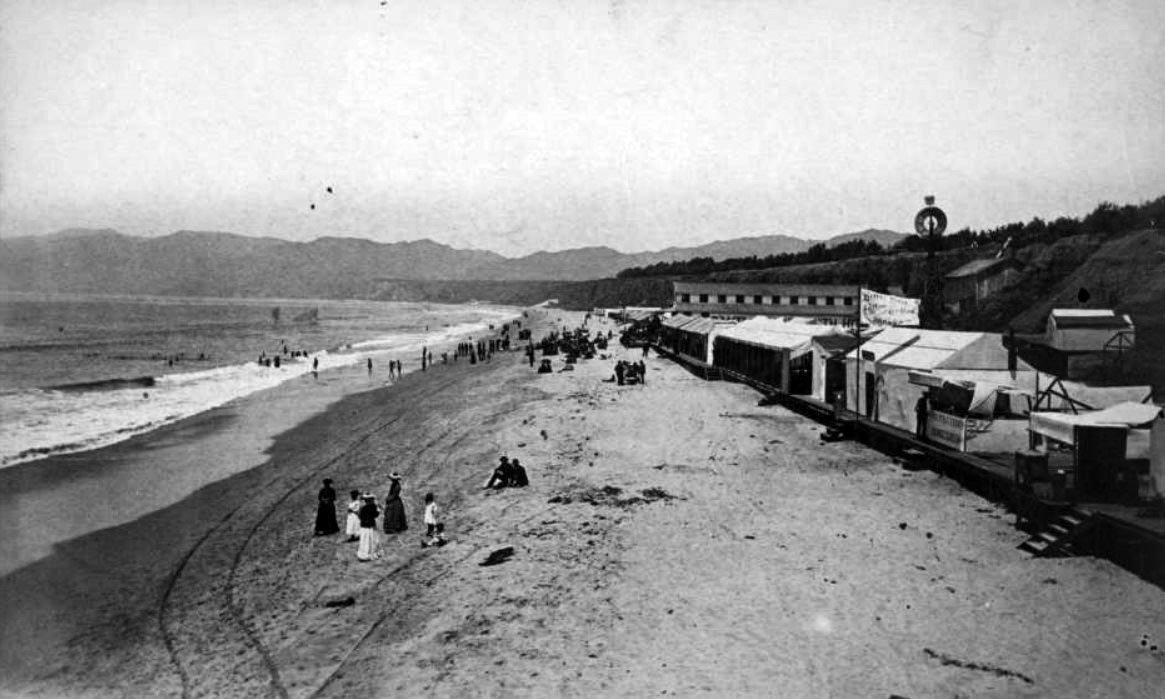 |
|
| (1880s)* - View showing people on the beach and in the surf in front of the Santa Monica Bath House in Santa Monica, with trees on the bluffs above. A group of women in plain clothes are standing in the foreground. There is a boardwalk near the shops with signs that read "Coffee and Ice Cream Parlor" and "Fruits, Candies, Lemonade, Cigars." A windmill is visible behind the buildings. |
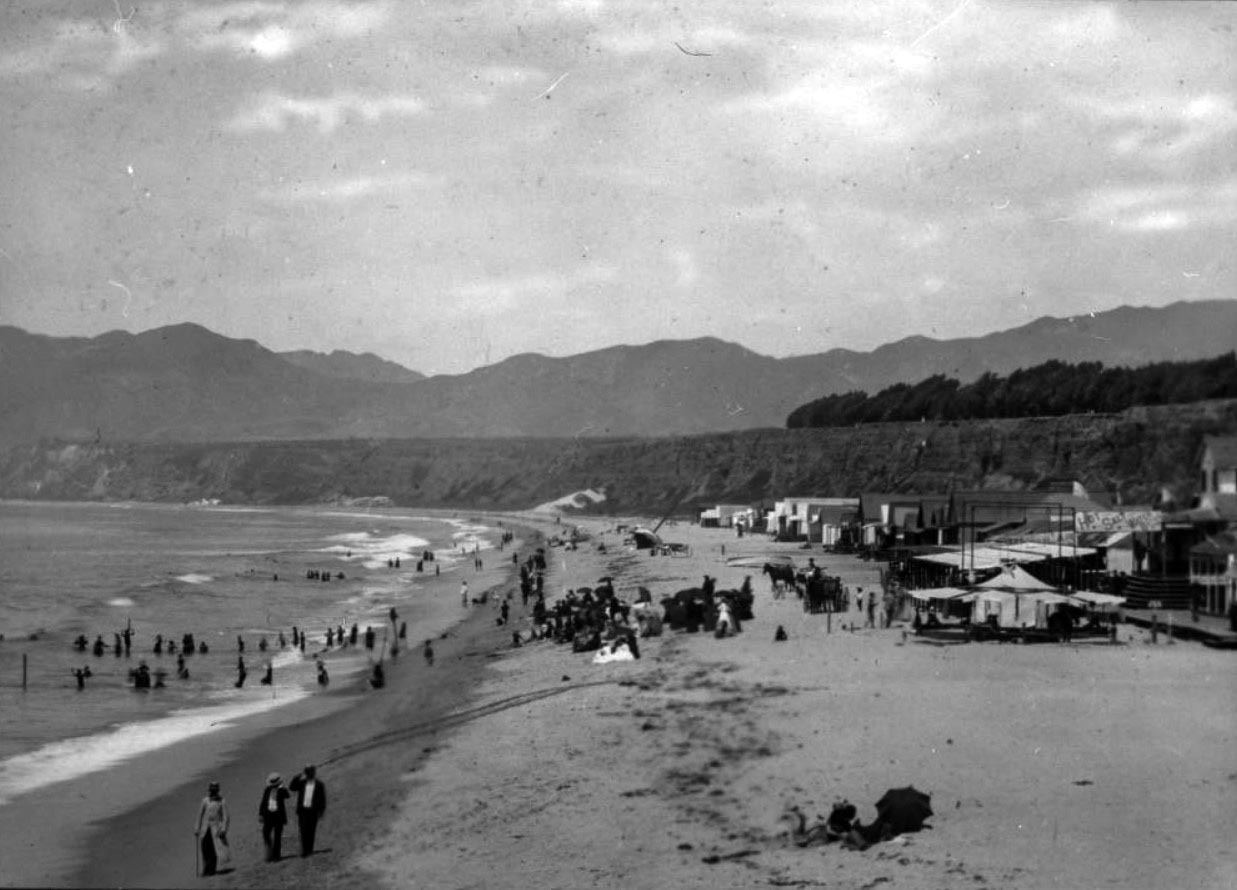 |
|
| (ca. 1880)* - Image of people on the beach and in the ocean in front of the Santa Monica Bath House, with sign "Hot Salt Water" and beach houses in Santa Monica, with a horse-drawn wagon at center. |
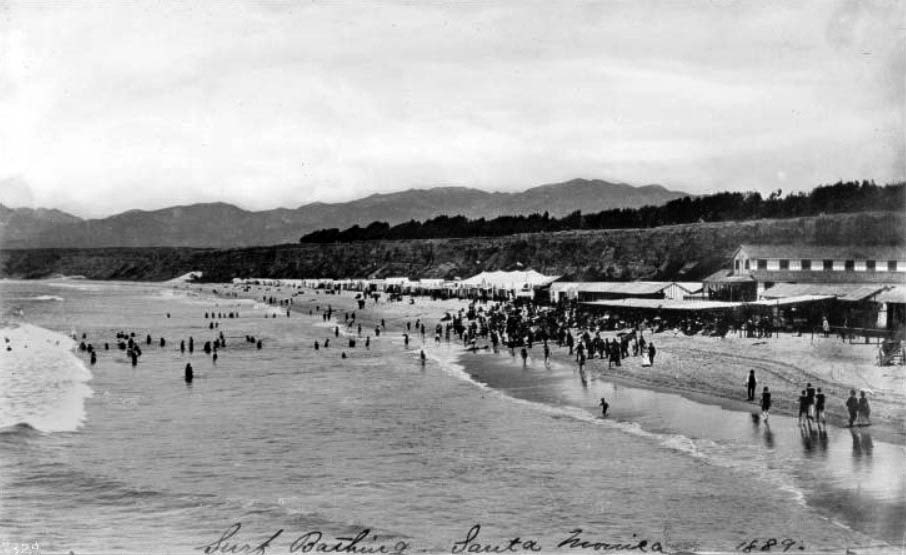 |
|
| (1889)* - Photograph of people at the shore on Santa Monica Beach. Beach houses and vendor's tents stand along the back end of the beach while a crowd of people moves into the surf at left from the shore. Mountains and trees can be seen above the cliff side in the background. Written-in text on the bottom of the image reads "Surf Bathing at Santa Monica". The Santa Monica Bathhouse is seen on the right. |
Historical Notes The above photo was taken from the L.A. & I. wharf. The Los Angeles and Independence Railroad (L.A. & I.) built a wharf in Santa Monica that opened in 1875, located near the present-day foot of Colorado Avenue, just north of where the Santa Monica Pier stands today. This original structure—also known as "Shoo Fly Landing"—was approximately 1,700 feet long and extended into waters 30 feet deep at low tide. Historical records confirm that the Santa Monica Pier is situated slightly south of the original wharf site. The L.A. & I. operated the wharf briefly before selling it, along with the railroad, to the Southern Pacific Railroad Company in 1877. By 1888, Southern Pacific had deemed the wharf unsafe for train operations and dismantled most of it, leaving behind only a shorter section or "stub" that remained in place until at least 1898. |
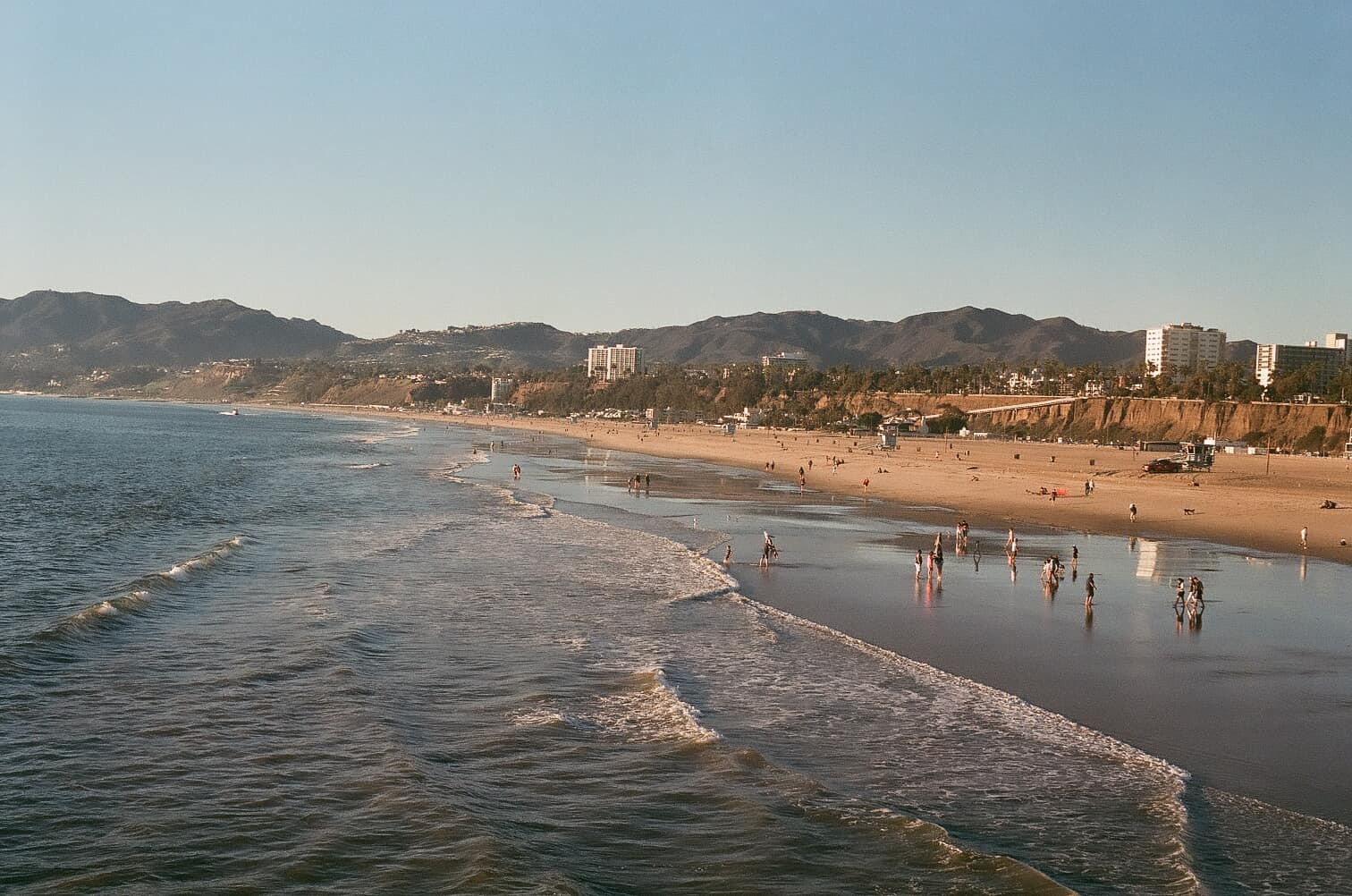 |
|
| (2022)* - View looking north from Santa Monica Pier showing about the same area as seen in previous photo. Photo courtesy of Davidus Vũdoo. |
Historical Notes The above photo was taken from the Santa Monica Pier which is situated slightly south of the original Los Angeles and Independence Rairloar wharf from where the previous photo was taken. |
Then and Now
 |
|
.jpg) |
|
| (1889 vs. 2020)* - Santa Monica Beach |
Historical Notes The bluff lines don’t match up exactly because the 1889 photo was taken from the old Los Angeles and Independence Railroad (L.A. & I.) wharf, which was closer to shore than the current view from the Santa Monica Pier, located slightly south of the original wharf. The beach is also much wider today—mainly because sand was added over the years through beach nourishment projects. More than 30 million cubic yards came from construction and dredging work. |
* * * * * |
Santa Monica Canyon
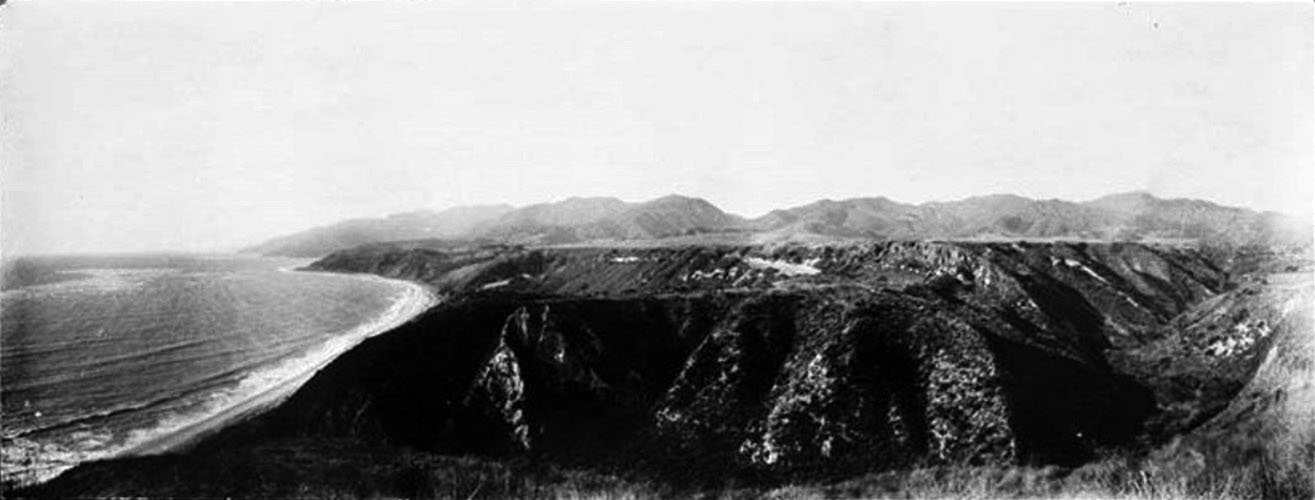 |
|
| (1900)#^- Panoramic view of the coastline and Santa Monica Canyon. |
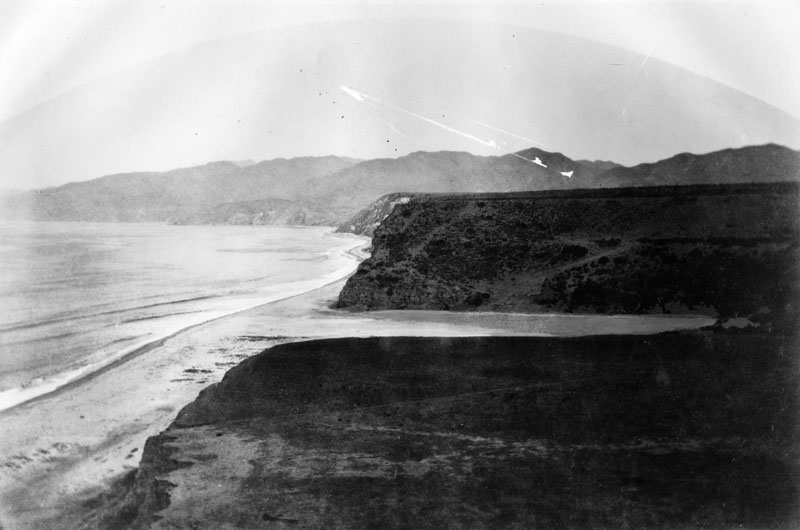 |
|
| (1880s)* - View of the mouth of the Santa Monica Canyon, originally part of the Rancho Boca de Santa Monica (mouth of the Santa Monica). |
Historical Notes In 1769, Francisco Reyes journeyed to Alta California to help establish Franciscan missions and claimed the land for Spain. Soldiers gave the name Santa Monica to a mountain creek that flowed to the Pacific. |
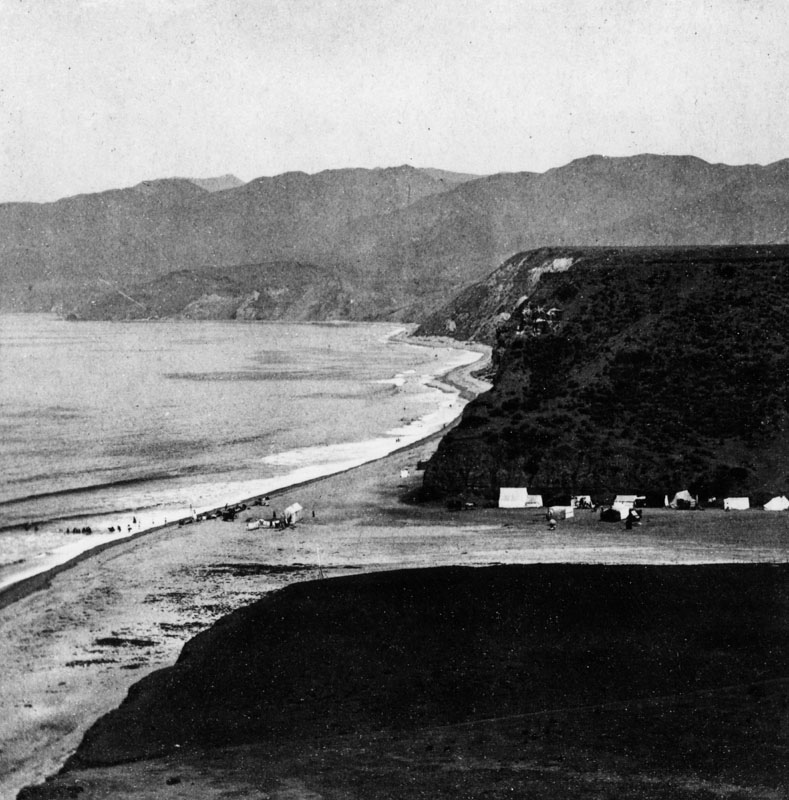 |
|
| (1880s)* - View of the mouth of the Santa Monica Canyon showing tents along the north canyon walls and on the beach. |
Historical Notes During the second-half of the 19th-century, the canyon was known as a camping area and rustic retreat near the beach hotels and resorts of nearby Santa Monica. |
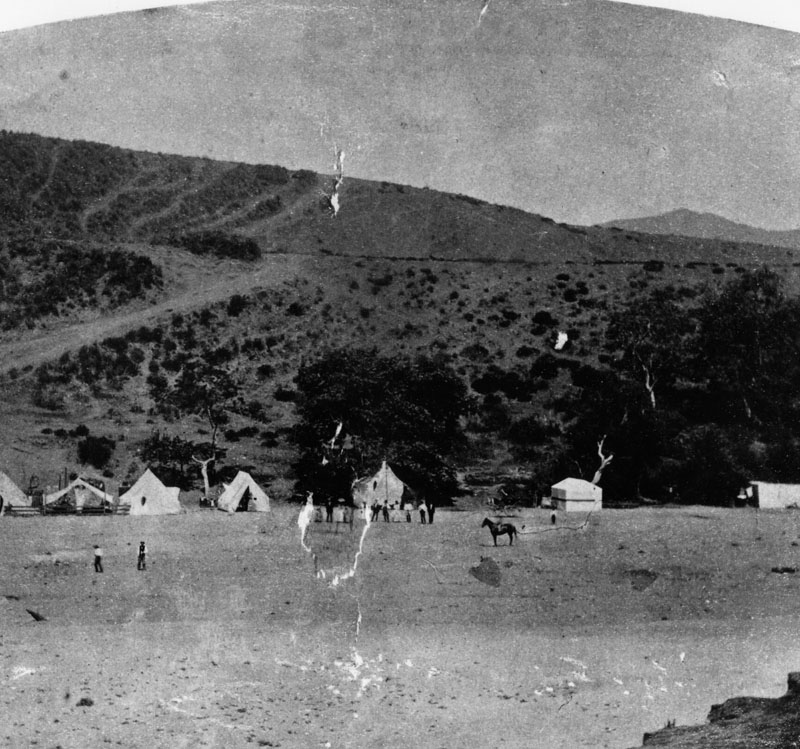 |
|
| (1880s)* - Near the mouth of the Santa Monica Canyon showing the summer camps in the 1880s. A man can be seen sitting on a horse. |
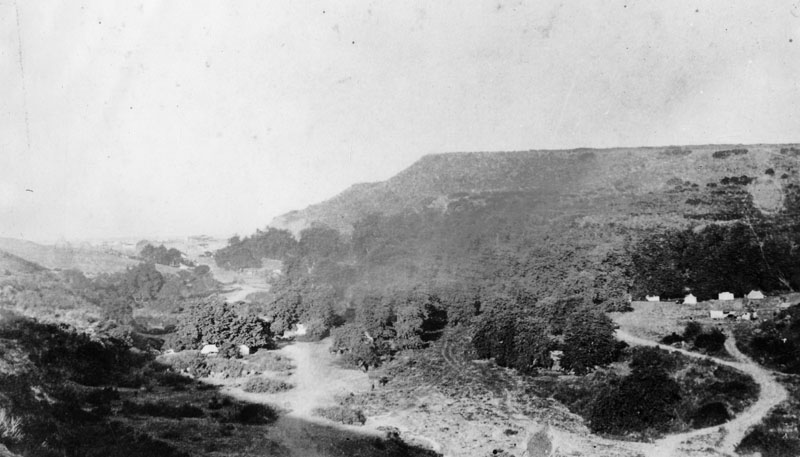 |
|
| (ca. 1890s)* - View of a campground located on the Rancho Boca de Santa Monica in Santa Monica Canyon, which once belonged to the Marquez Family. The family allowed visitors throughout the Los Angeles area to camp there and enjoy the scenery and the cool ocean breezes. |
Historical Notes In the late 1880s, Abbot Kinney, the developer best known for designing the nearby community of Venice to the south, established an experimental forestry station and planted eucalyptus trees, for which the canyon is still known today. |
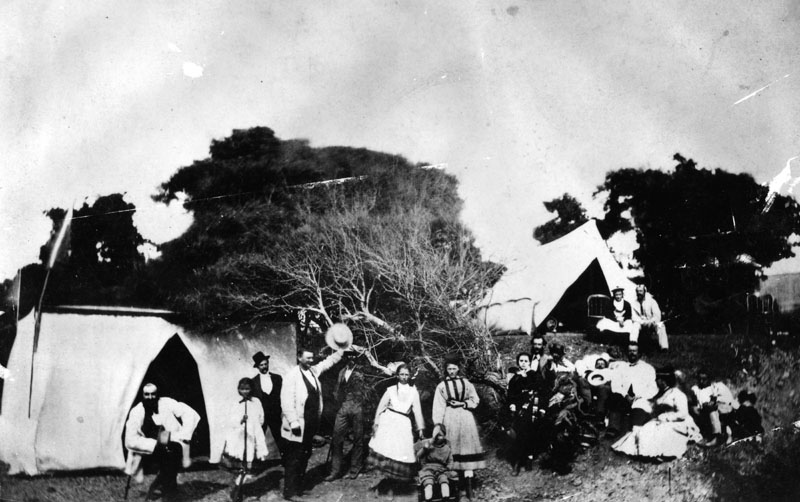 |
|
| (ca. 1890s)* - People in folk costumes are camping in tents in Santa Monica Canyon probably in the 1890s. |
Historical Notes Despite the challenges of Mother Nature, the beauty and peace of The Canyon began attracted near-by Angelenos. A small grocery store sold fresh produce and items from the local Rancheros and small tents dotted the mouth of The Canyon for picnicking and camping. |
* * * * * |
Marquez Adobe
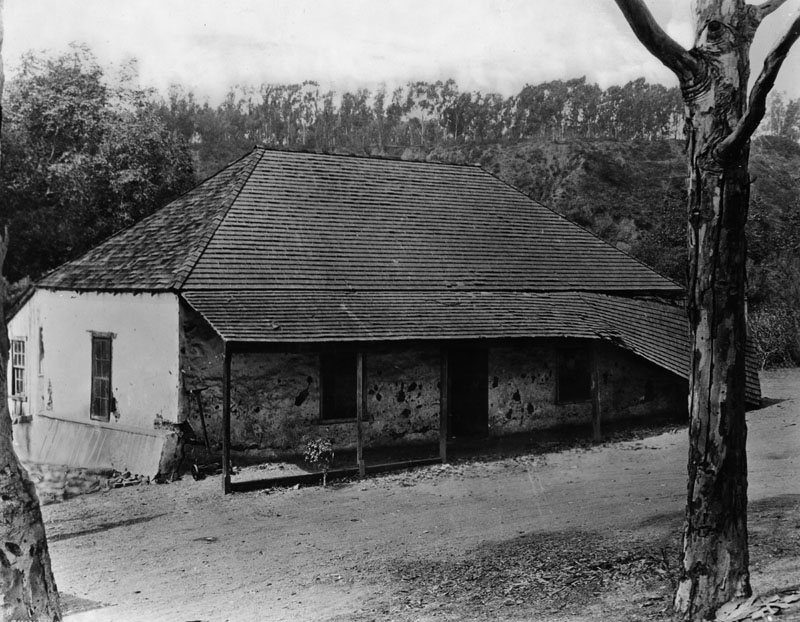 |
|
| (1900)* - Exterior of the Pascual Marquez adobe built about 1845 on the Boca de Santa Monica rancho. The adobe appears delapidated now. |
Historical Notes After Mexico won its independence from Spain, Francisco Reyes' grandson Ysidro and his neighbor, Francisco Marquez, were granted 6,656 acres of the Rancho Boca de Santa Monica (mouth of the Santa Monica). They built the area's first permanent structures. |
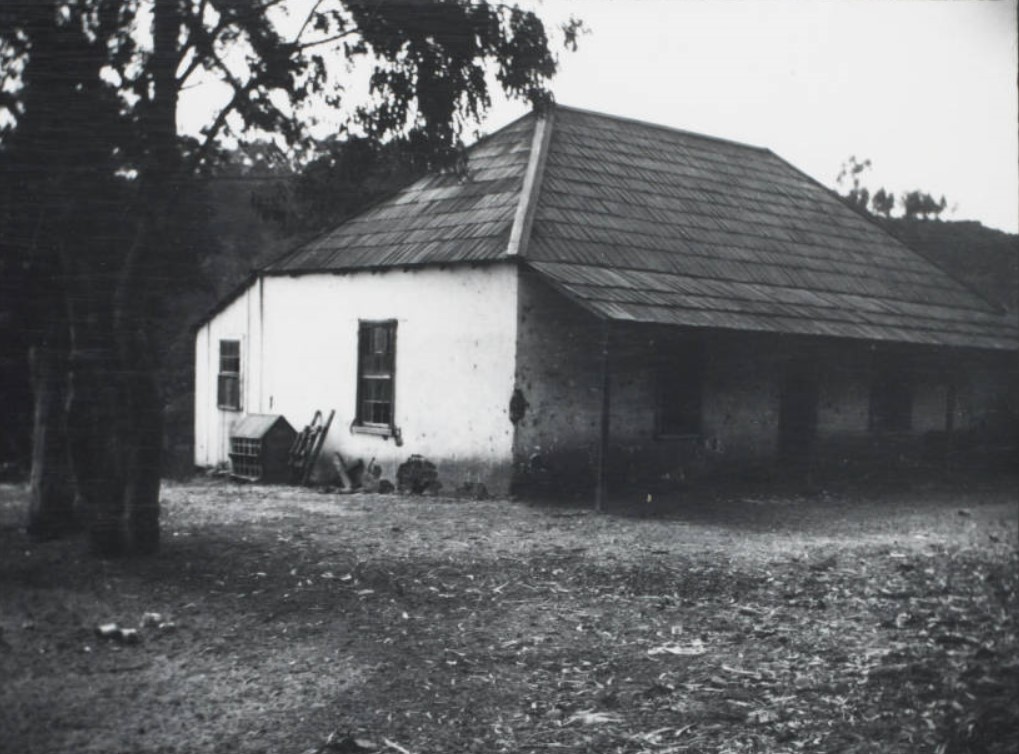 |
|
| (ca. 1900)* - Image of the adobe house built by Pascual Marquez located in Santa Monica Canyon. Ernest Marquez Collection |
Historical Notes Remarks from donor Ernest Marquez, 2015: "The adobe house was built by my grandfather Pascual Marquez in 1875, about 75 yards from the adobe where he was born, built by his father Francisco in 1839. I think Pascual’s adobe collapsed in an earthquake in the 1930s." |
* * * * * |
Marquez Bath House
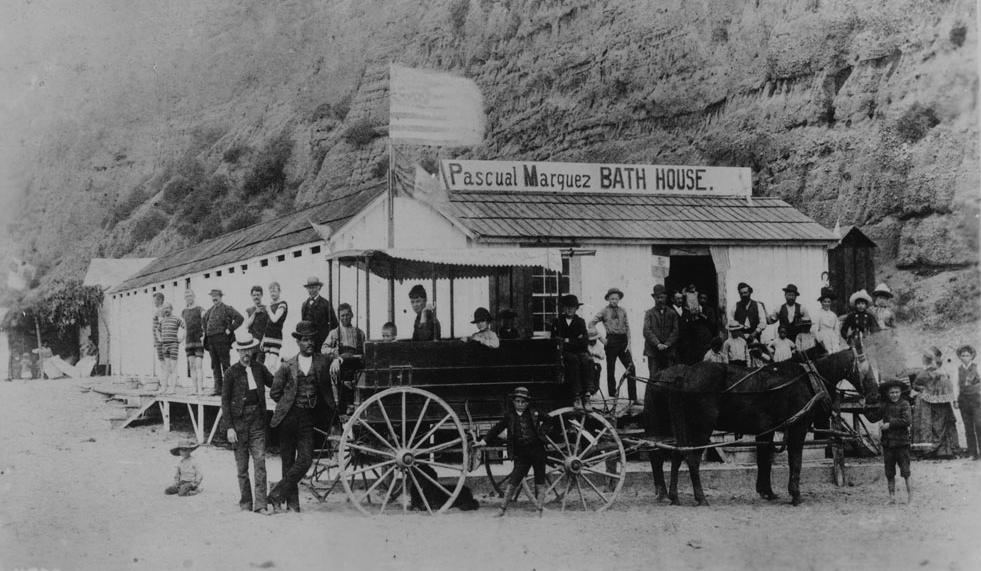 |
|
| (ca. 1887)* - Photograph of a group of about 30 people (men, women and children) posing in front of Pascual Marquez's bath house -- the first bath house in Santa Monica Canyon. A stagecoach -- the Santa Monica Canyon State -- drawn by a two-horse team stands in front. An American flag flies from the roof of the single-story wood structure. The nearly vertical rocky canyon wall looms behind. A sign on the roof reads "Pascual Marquez bath house". |
Historical Notes These type of horse-drawn wagons transported visitors from Los Angeles to Santa Monica before the arrival of train service to the area. |
* * * * * |
First Stage and Mail Service
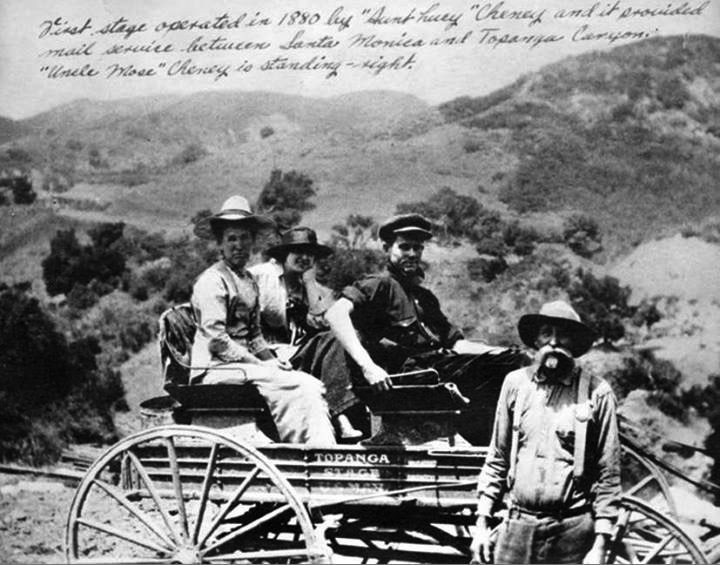 |
|
| (ca. 1880s)^ - First stage and mail service operated in 1880s between Santa Monica and Topanga Canyon. |
Historical Notes The 1st mail wagon was established by "Aunt Lucy" Cheney and began service in 1880. It provided mail service between Santa Monica and Topanga Canyon. They began to carry passengers (as shown here) in 1885. Also pictured is "Uncle Mose" Cheney.* |
* * * * * |
Early Santa Monica Beach Views
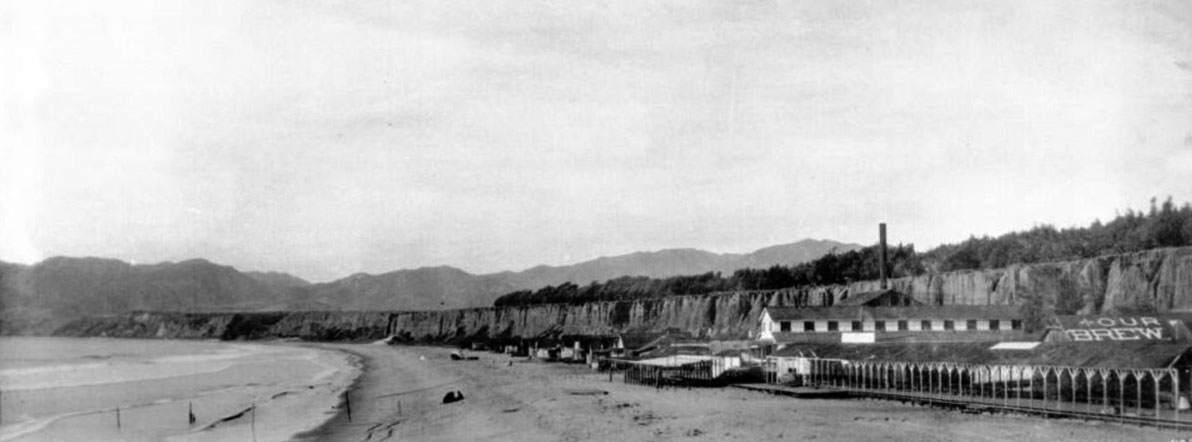 |
|
| (ca. 1887)* – Panoramic view showing the old Bath House looking north at North Beach, Santa Monica. The beach is deserted except for a group of 2 or 3 people. A long covered boardwalk runs along the front of the bath house. A tall smokestack sticks up above the bath house. The billboard on one roof at right reads "Our Brew". |
Historical Notes North Beach in Santa Monica emerged as a popular tourist destination in the 1880s, setting the stage for the area's future development. The arrival of the Los Angeles and Independence Railroad, owned by Senator John P. Jones, made the beach easily accessible to visitors from Los Angeles. Following a business depression in the late 1870s, Santa Monica's economy rebounded in the early 1880s, largely due to its appeal as a beach destination. By 1887, North Beach facilities were attracting 2,000 to 3,000 visitors daily during summer months, and in 1889, the Southern Pacific Railroad alone brought 200,000 tourists to Santa Monica. While the iconic North Beach Bath House wasn't built until 1894, its construction was a direct result of the area's growing popularity in the preceding decade. Financed by Senator Jones, this impressive $50,000 structure featured saltwater plunges, dressing rooms, a rooftop garden, and various entertainment facilities. The bath house, designed by architect Sumner P. Hunt, became a centerpiece of Santa Monica's beachfront attractions, further cementing North Beach's status as a premier seaside resort destination. |
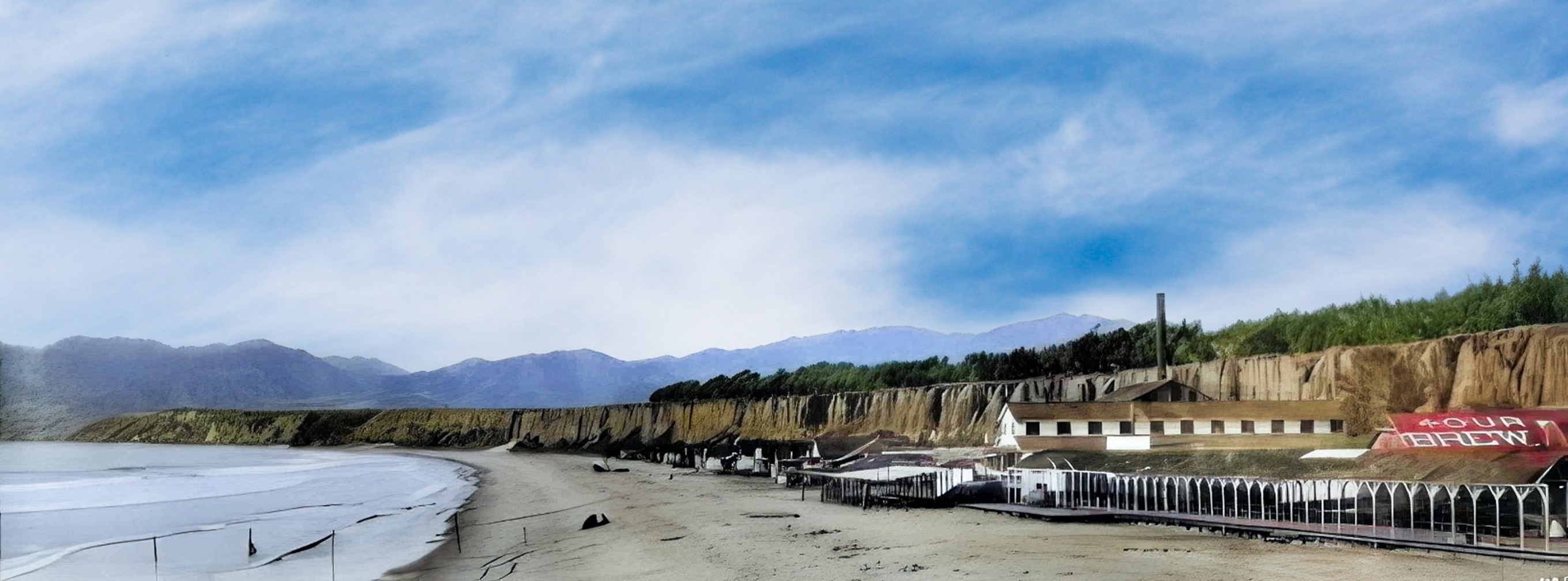 |
|
| (ca. 1887)* – Panoramic view of Santa Monica Beach and the Palisades. (AI image enhancement and colorization by Richard Holoff) |
Then and Now
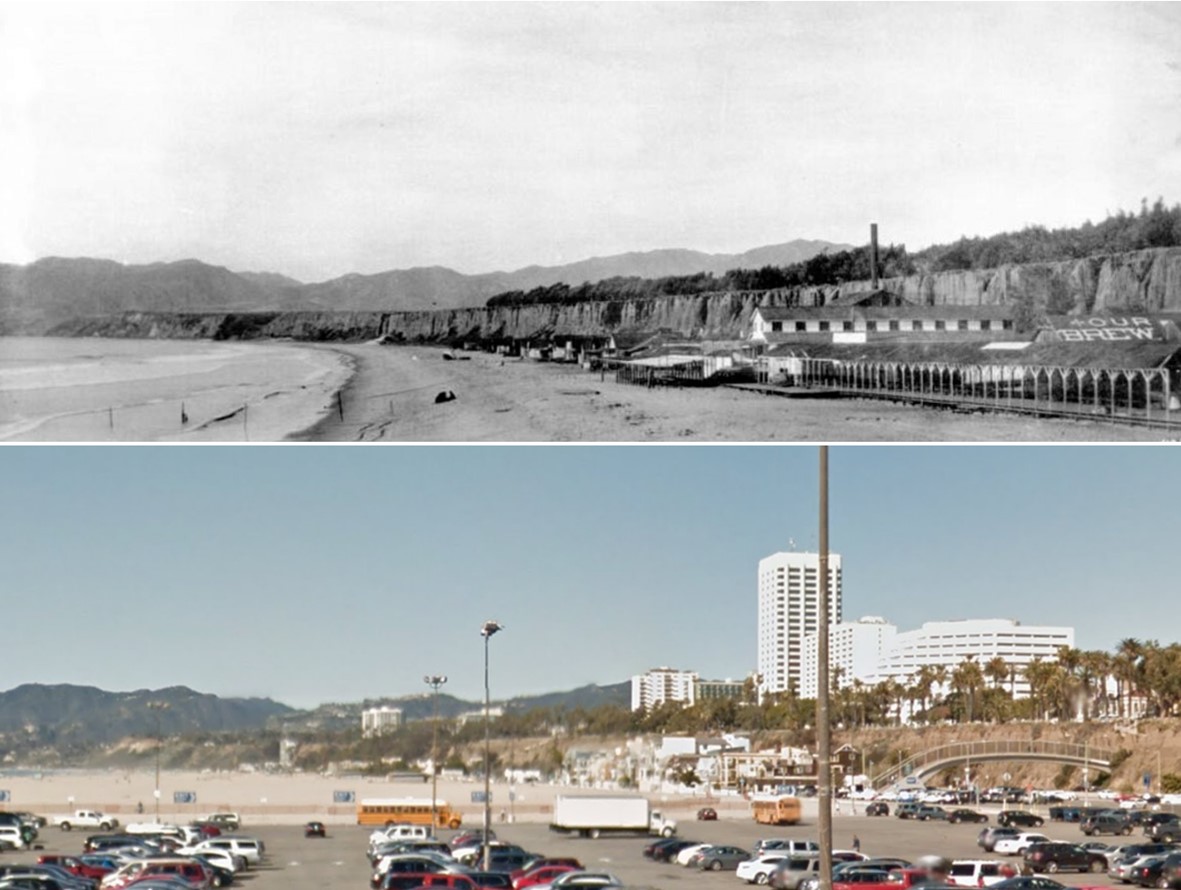 |
|
| (1887 vs. 2015)* –Panoramic view of Santa Monica Beach with what is now Palisades Park in the background. |
Historical Notes While the camera angles differ slightly, the contemporary image clearly shows more sand on the beach. This increase is largely due to human intervention, particularly through beach nourishment projects. Over the past century, efforts have been made to widen and enhance the beach to boost tourism and recreation. Key factors include adding approximately 30 million cubic yards of sand, sourced from infrastructure projects and dredging operations, and the desire to make Santa Monica Beach resemble the wider, flatter beaches of the East Coast. In 1947, for example, nearly 14 million cubic yards of sand were removed to make way for El Segundo's Hyperion power plant. They were deposited onto Santa Monica's beaches. Another million cubic yards came a couple years later, the sand this time recovered from dredging operations along a nearby breakwater. In all, some thirty million cubic yards of sand have been dumped onto the beaches of Santa Monica and Venice. |
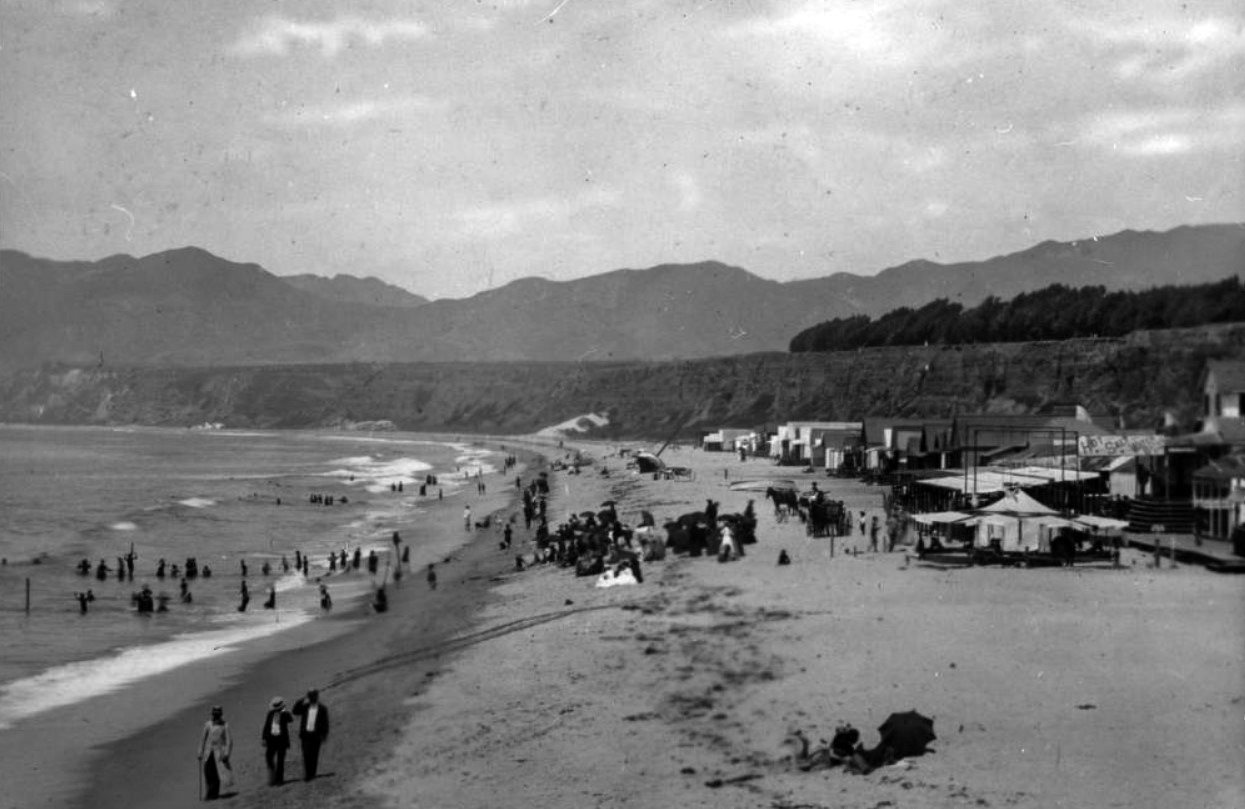 |
|
| (1880s)* - View showing people on the beach and in the ocean in front of the Santa Monica Bath House, with sign "Hot Salt Water" and beach houses in Santa Monica, with a horse-drawn wagon at center-right. |
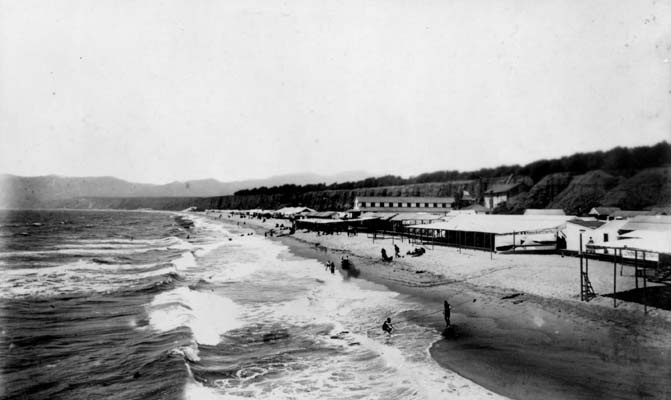 |
|
| (1887)*^ - View of Santa Monica Beach looking north in 1887. The Palisades can be seen in the background. |
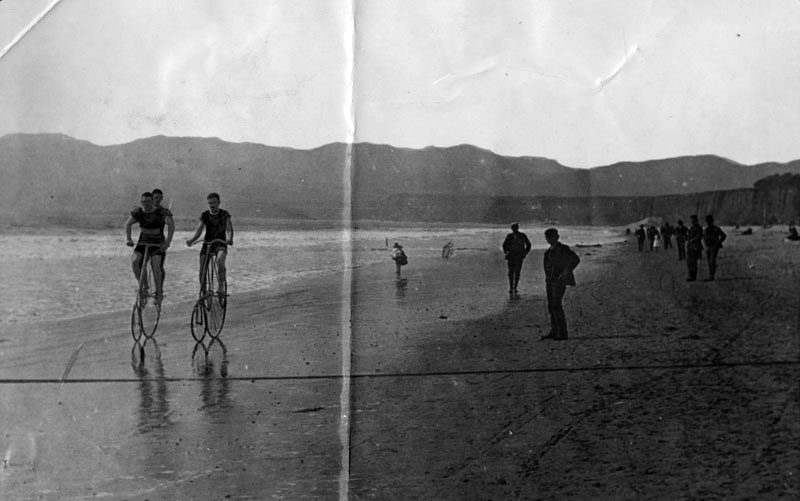 |
|
| (1887)* - Men are walking and riding bicycles on a beach in Santa Monica. The familiar palisades are visible on the right and the Santa Monica Mountains are visible in the background. |
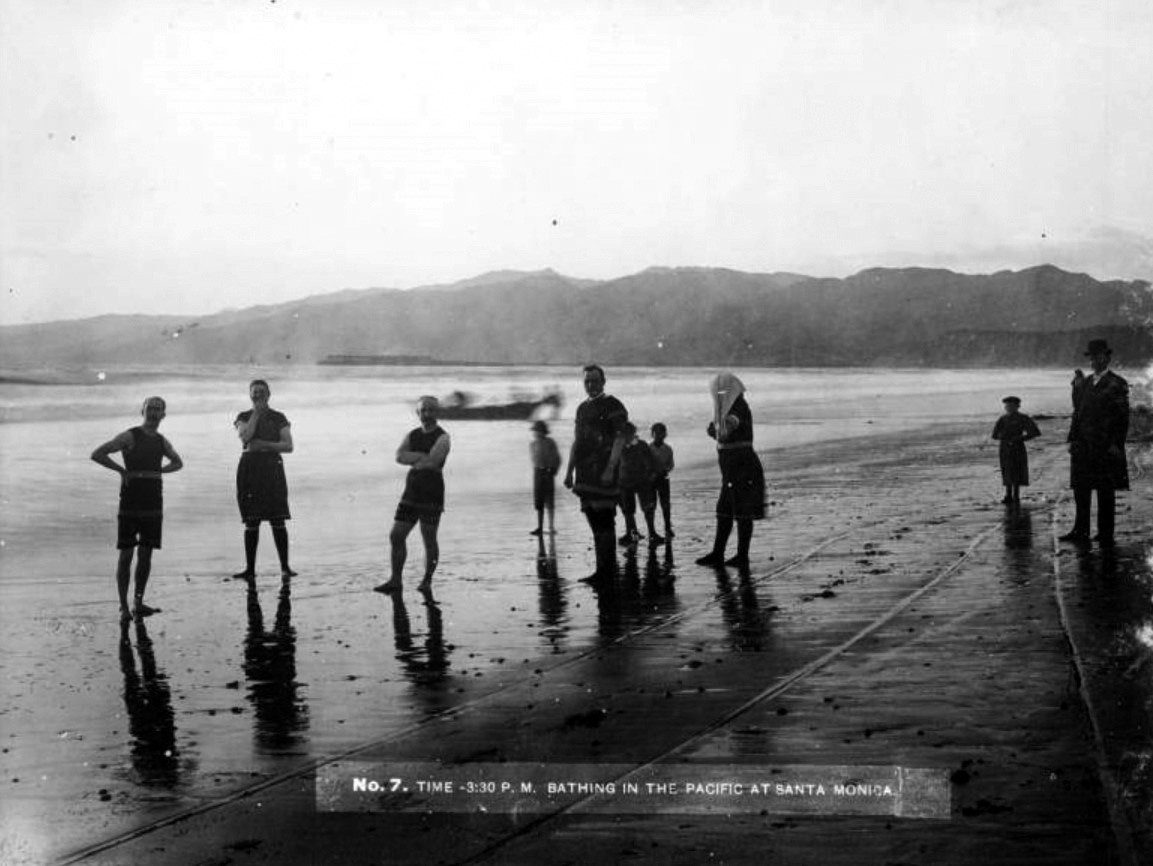 |
|
| (1890s)* – View showing people standing on the beach in bathing suits in Santa Monica. There are horse tracks and carriage wheel tracks in the sand. |
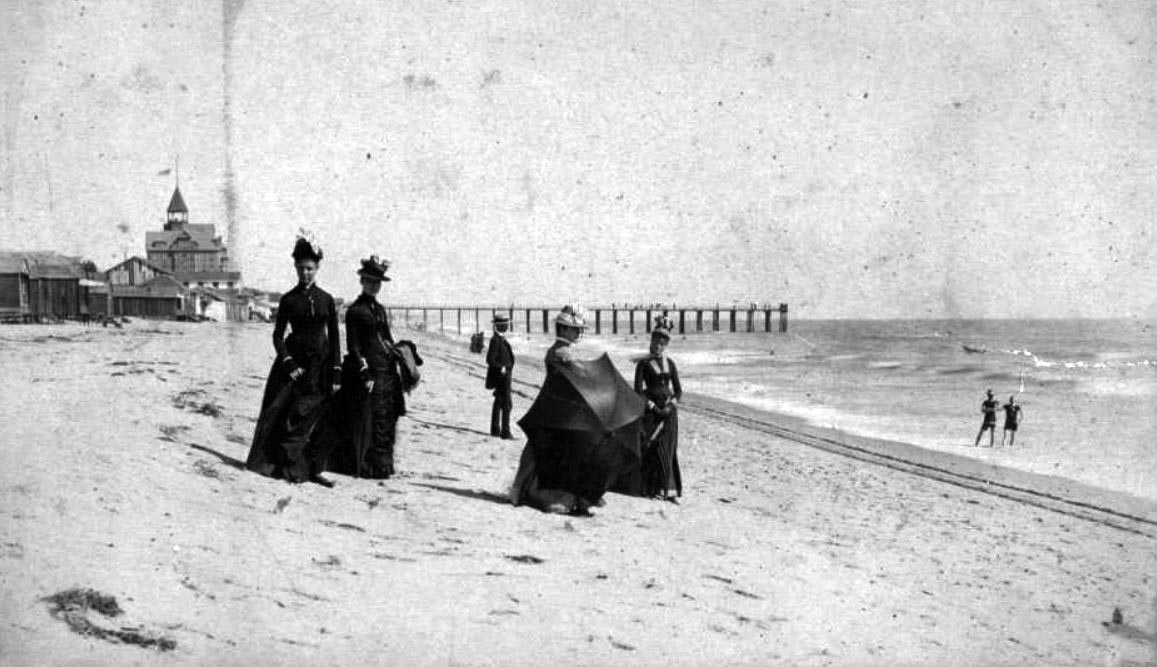 |
|
| (1888)* - Image of a group of people with an umbrella on the beach in Santa Monica. The Arcadia Hotel and the remains of the Los Angeles and Independence Wharf are seen in the distance. |
Historical Notes The Arcadia Hotel opened for business in 1887 and was located on Ocean Avenue between Railroad Avenue (later known as Colorado Avenue) and Front (later known as Pico Boulevard). The Arcadia was the largest structure in Santa Monica at the time of its construction. The 125-room hotel was owned by J.W. Scott, the proprietor of the city's first hotel, the Santa Monica Hotel. The hotel was named for Arcadia Bandini de Baker, the wife of Santa Monica cofounder Colonel R. S. Baker. |
* * * * * |
Early Santa Monica Cottages and House-Tents
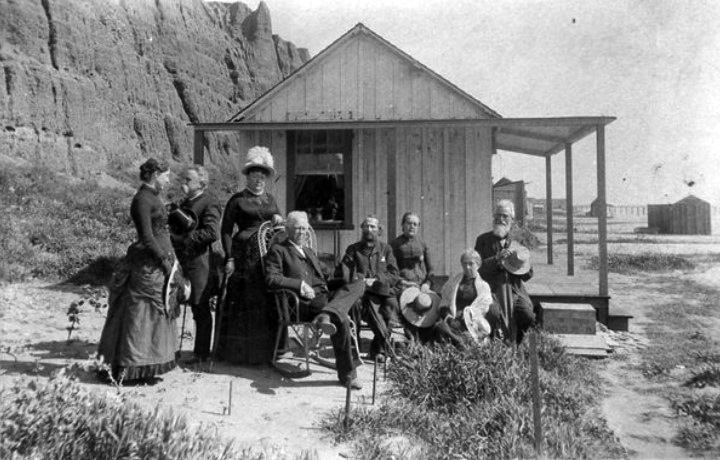 |
|
| (1888)* - Visitors to Santa Monica Beach in front of a beach cottage. The pier can be seen in the background with the Arcadia Hotel out of view behind the beach shack. Photo from the Ernest Marquez Collection. |
Historical Notes In the 1880s and 1890s, North Beach in Santa Monica featured various temporary structures like house tents, beach cottages, vendor tents, and bath houses. House tents provided simple, affordable seaside accommodations, while small beach cottages offered more permanent lodging. Vendor tents and bath houses, including the Santa Monica and North Beach Bath Houses, provided amenities like refreshments and saltwater baths. These developments reflect Santa Monica's early growth as a beach resort, catering to the increasing demand for oceanfront leisure and recreation. |
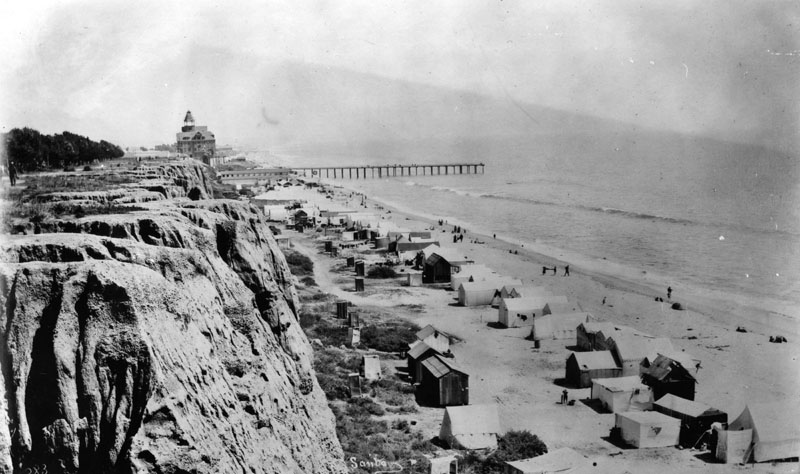 |
|
| (ca. 1887)* - View of Santa Monica beach looking south from Santa Monica Canyon rim. The newly constructed Arcadia Hotel can be seen in the background along with the remains of the Los Angeles & Independence Wharf. House-tents are seen along the beach. |
Historical Notes The Los Angeles and Independence Railroad Wharf was in use between 1875 and 1879, at which time it was partially dismantled. In 1898, a new pier would be built, North Beach Pier, just to the north of where the above wharf is seen. |
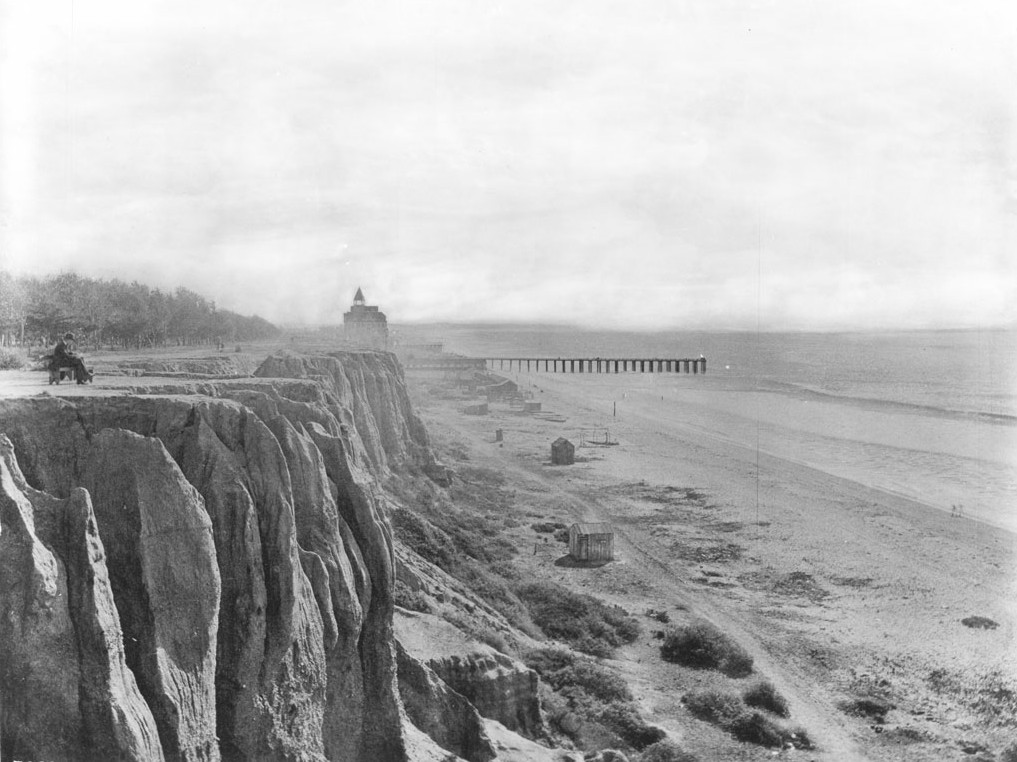 |
|
| (ca. 1889)** - Looking south from the '99 steps' toward the Arcadia Hotel. In the upper left can be seen a man sitting on a bench very close to the edge of the palisades (This area would become Palisades Park). The stub of the Los Angeles and Independence Railroad Wharf can also be seen. |
Historical Notes Originally known as “Linda Vista Park,” Palisades Park was the first officially-designated public open space in Santa Monica. The land was donated to the City by Santa Monica's founder, Senator John P. Jones, in 1892. |
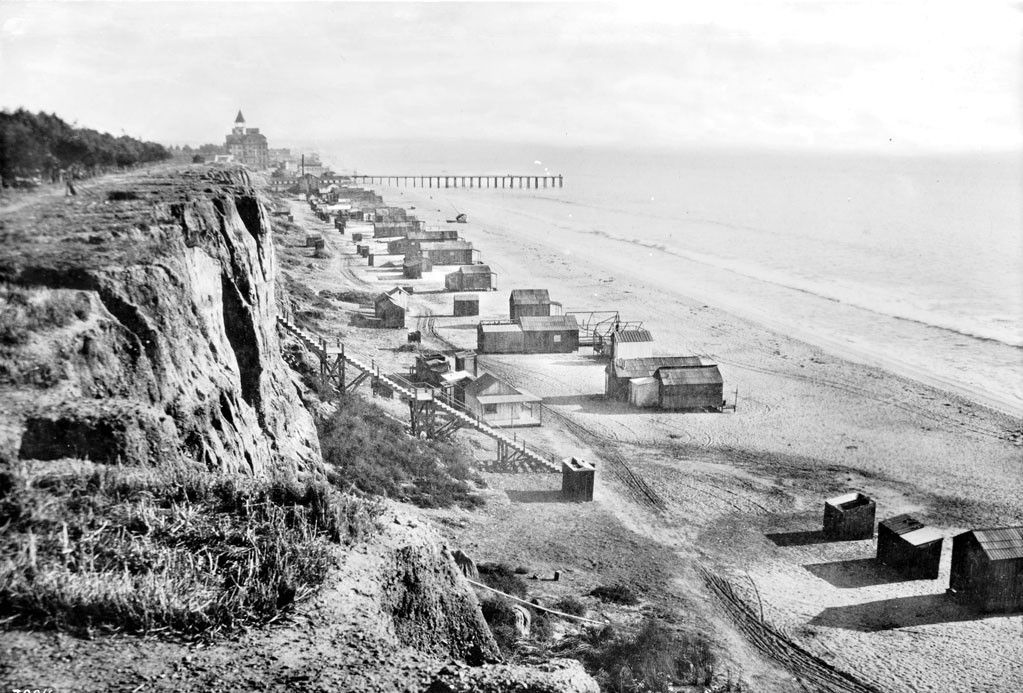 |
|
| (ca. 1890)^- View looking south from the rim of the Palisades, overlooking the original "99 Steps," which provided access to the northern portion of Santa Monica beach. Seen in the distance is the Hotel Arcadia and the stub of the Los Angeles and Independence Railroad Co. Wharf. The vantage point of this photograph is near the foot of Wilshire Avenue. |
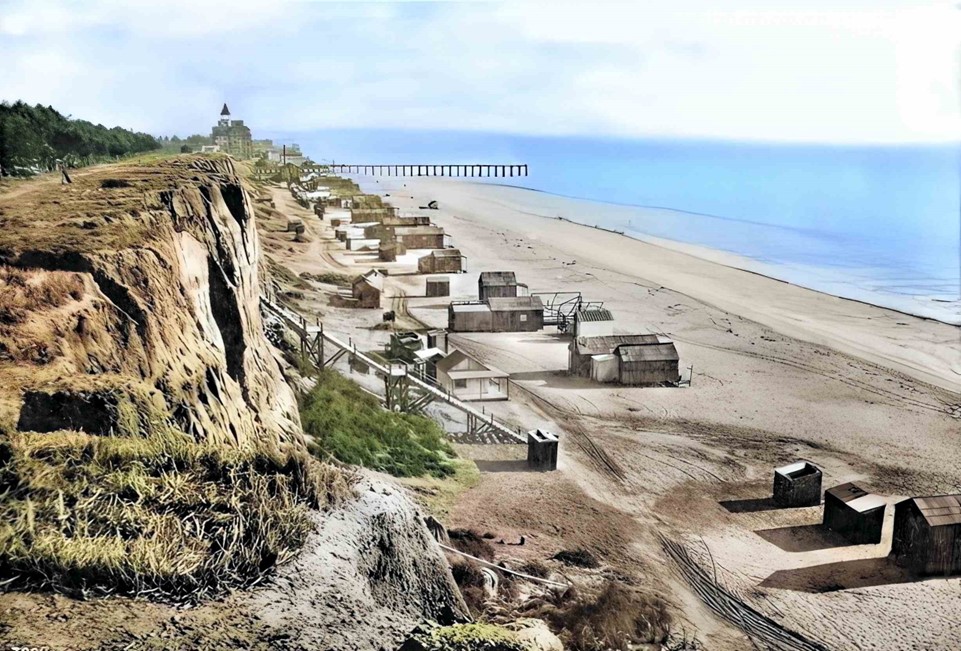 |
|
| (ca. 1890)^- View looking south from the rim of the Palisades, overlooking the original "99 Steps," which provided access to the northern portion of Santa Monica beach. Seen in the distance is the Hotel Arcadia and the stub of the Los Angeles and Independence Railroad Co. Wharf. The vantage point of this photograph is near the foot of Wilshire Avenue. AI image enhancement and colorization by Richard Holoff |
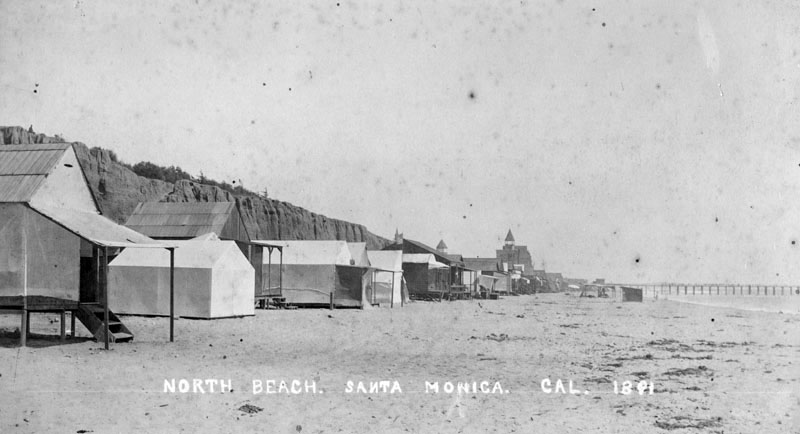 |
|
| (1891)* - View of North Beach looking south towards the Arcadia Hotel. Tent houses line the beach area. |
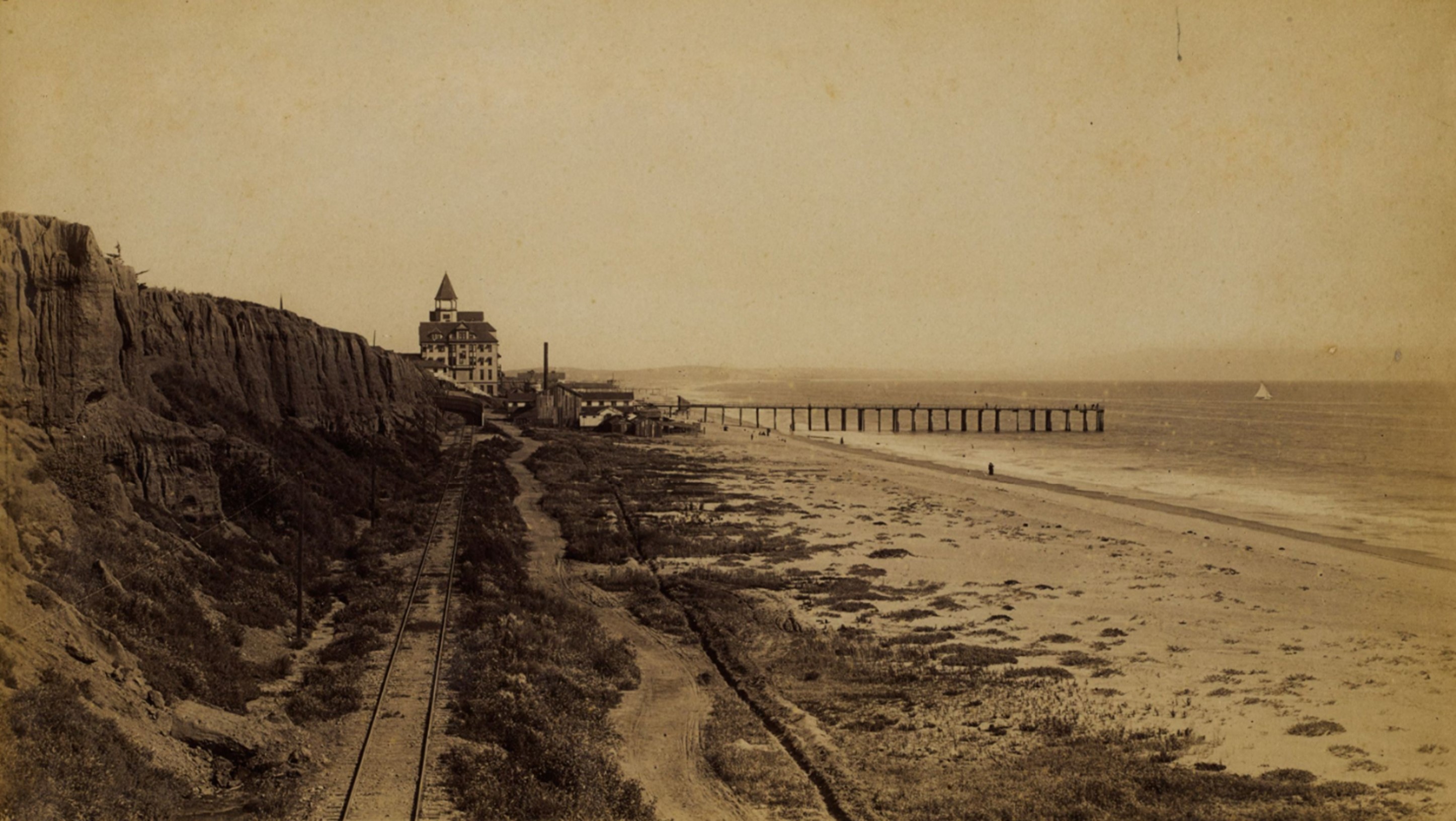 |
|
| (1893)* - View looking south showing North Beach and the Arcadia Hotel with the Southern Pacific Railroad tracks running next to the Beach Road in Santa Monica. The Santa Monica Bath House and the remains of the Los Angeles and Independence Wharf are visible at right and the Palisades Bluffs are visible at left. Photo from the Ernest Marquez Collection. |
Historical Notes Tracks were first laid in Santa Monica in 1875 with the construction of the Los Angeles and Independence Railroad. This steam-powered rail line connected Santa Monica to downtown Los Angeles, running from the Santa Monica Long Wharf north of the current Santa Monica Pier to 5th and San Pedro streets in Los Angeles. This line was intended to serve both freight and passenger purposes, facilitating the transport of mined ore and beachgoers. The Los Angeles and Independence Railroad was purchased by the Southern Pacific Railroad on July 1, 1877. In 1892, the Southern Pacific Railroad extended the existing tracks, seen above, to their new Long Wharf (completed in 1893) north of Santa Monica Canyon, enhancing the line's capacity to handle larger ships and increasing its importance for freight and passenger transport. Beach Road became Roosevelt Highway in Santa Monica in 1927. This change was part of a larger effort to develop the highway system along the California coast, and the Roosevelt Highway would later become known as the Pacific Coast Highway (PCH). The railroad tracks along Santa Monica Beach were in use from 1891 until 1933. It appears that the majority of beach shacks along Santa Monica's North Beach were removed with the laying of railroad tracks by Southern Pacific in 1892. No photos of these beach shacks have been found after 1892. |
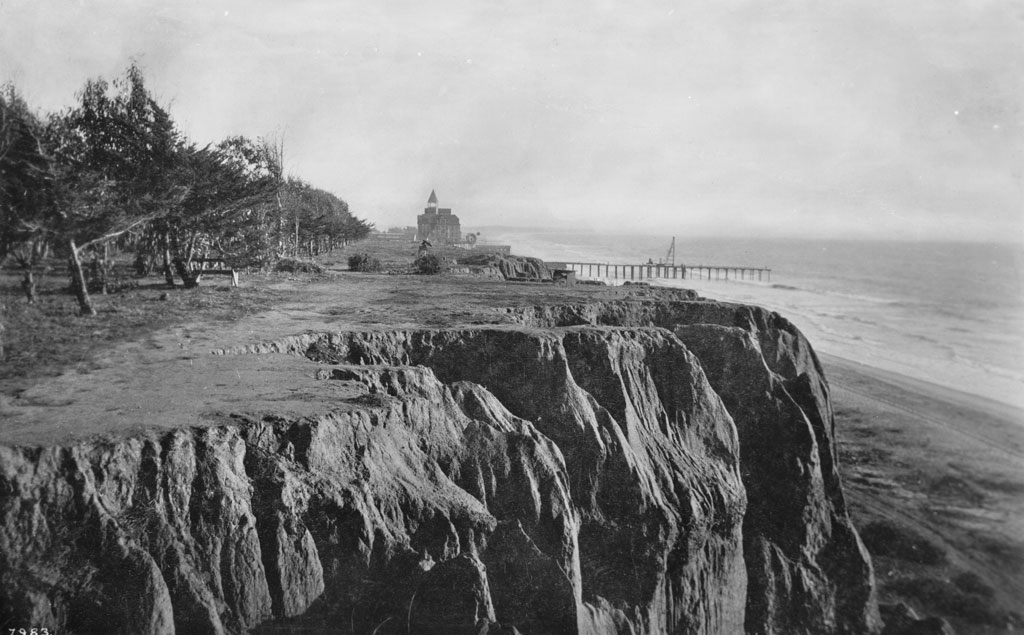 |
|
| (ca. 1895)* - View of the Santa Monica seaside bluffs (Linda Vista Park, later Palisades Park). The Arcadia Hotel and Los Angeles and Independence Wharf - forerunner to today’s Santa Monica Pier - are both visible in the distance. |
Historical Notes Originally known as “Linda Vista Park,” Palisades Park was the first officially-designated public open space in Santa Monica. The land was donated to the City by Santa Monica's founder, Senator John P. Jones, in 1892. Linda Vista Park was renamed Palisades Park in the 1920s. |
Then and Now
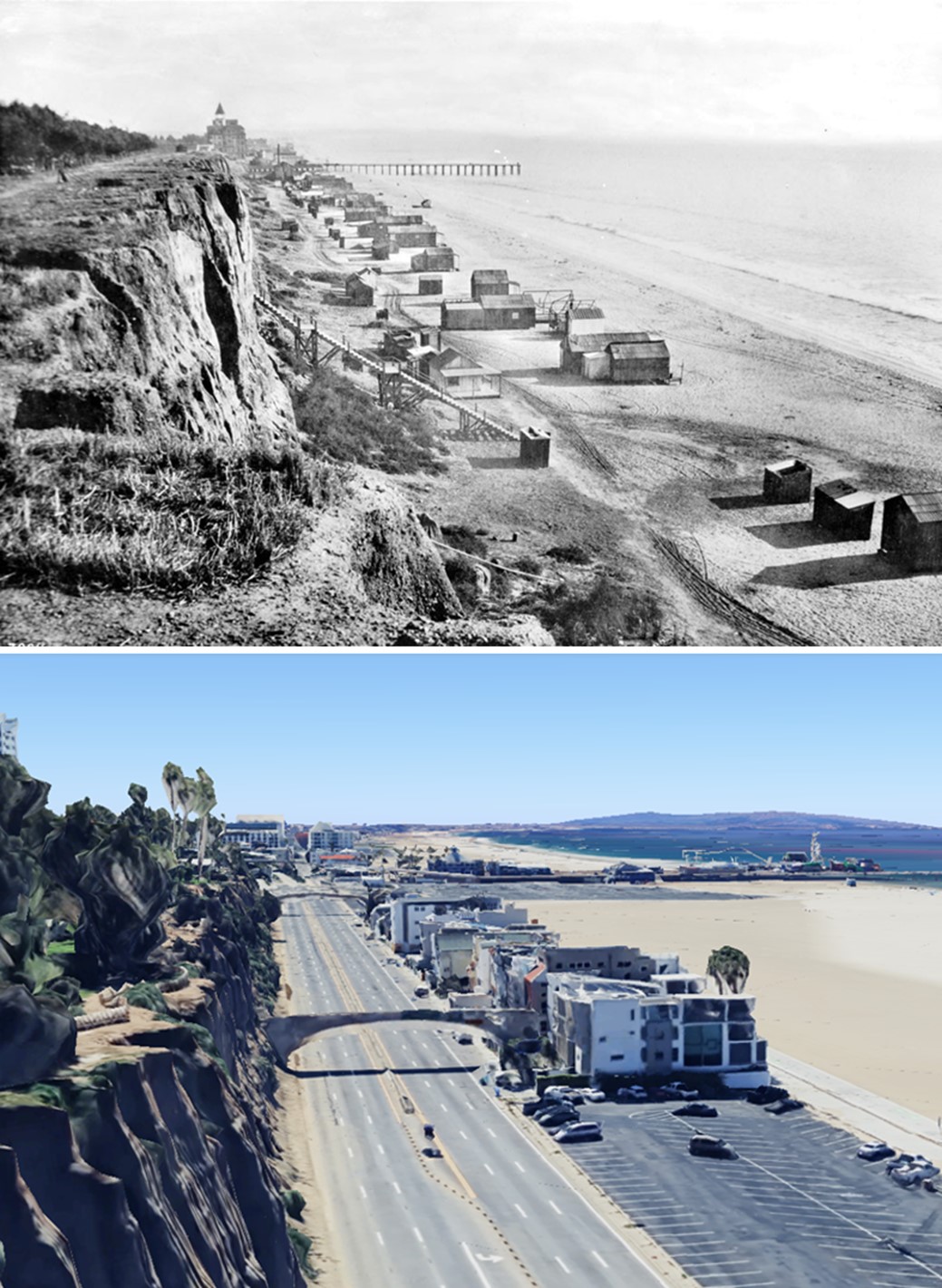 |
|
| (1890 vs. 2023)* – View looking south from the rim of what is now Palisades Park near the foot of Wilshire Boulevard. The 1890 photo shows the original "99 Steps," which provided access to the northern portion of Santa Monica Beach. In the distance, the Hotel Arcadia and the remains of the Los Angeles and Independence Railroad Co. Wharf are visible. The 2023 photo shows the Pedestrian Bridge, connecting the Palisades at the end of Arizona Avenue to the beach below, located at the site of the original "99 Steps" built in 1875. |
Historical Notes While the camera angles differ slightly, the contemporary image clearly shows more sand on the beach. This increase is largely due to human intervention, particularly through beach nourishment projects. Over the past century, efforts have been made to widen and enhance the beach to boost tourism and recreation. Key factors include adding approximately 30 million cubic yards of sand, sourced from infrastructure projects and dredging operations, and the desire to make Santa Monica Beach resemble the wider, flatter beaches of the East Coast. In 1947, for example, nearly 14 million cubic yards of sand were removed to make way for El Segundo's Hyperion power plant. They were deposited onto Santa Monica's beaches. Another million cubic yards came a couple years later, the sand this time recovered from dredging operations along a nearby breakwater. In all, some thirty million cubic yards of sand have been dumped onto the beaches of Santa Monica and Venice. |
* * * * * |
Arcadia Hotel
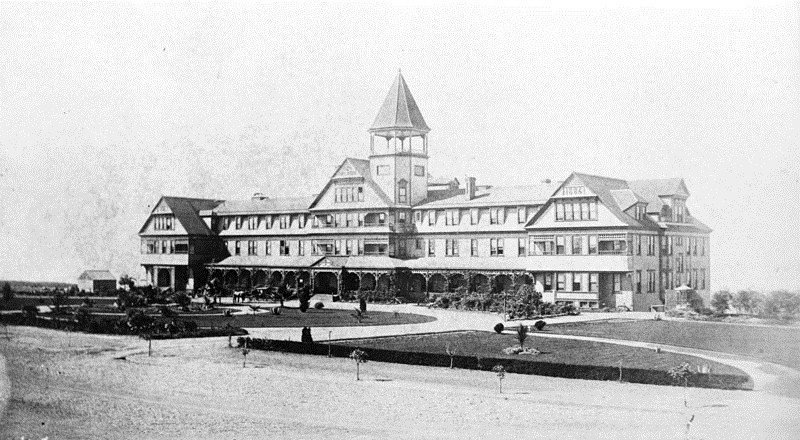 |
|
| (1887)* - Exterior view of the east front of the Arcadia Hotel in Santa Monica soon after opened in March 1887. It was located on Ocean Avenue immediately south of the bridge over the gulch that was later occupied by Roosevelt Highway. The hotel was built next to a steep cliff and shows only 3 stories on the Ocean Avenue side and 5 stories on the beach side. |
Historical Notes The Arcadia Hotel opened for business in 1887 and was located on Ocean Avenue between Railroad Avenue (later known as Colorado Avenue) and Front (later known as Pico Boulevard). The Arcadia was the largest structure in Santa Monica at the time of its construction. The 125-room hotel was owned by J.W. Scott, the proprietor of the city's first hotel, the Santa Monica Hotel. The hotel was named for Arcadia Bandini de Baker, the wife of Santa Monica cofounder Colonel R. S. Baker. |
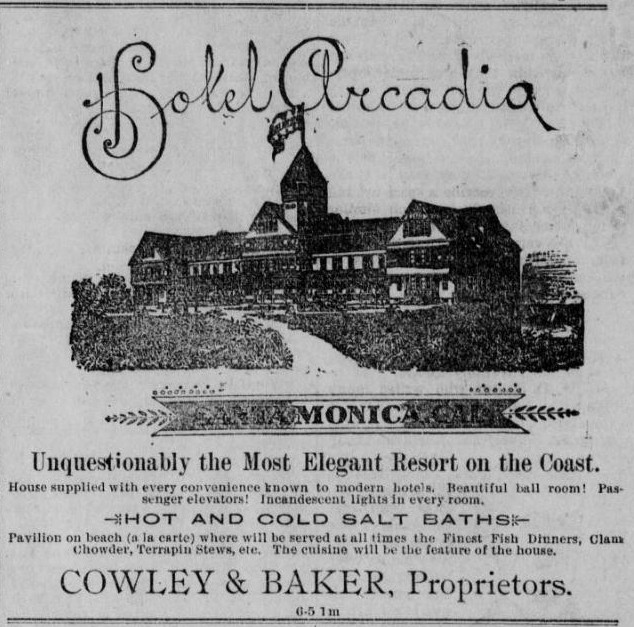 |
|
| (1890)**^ - Hotel Arcadia - 'The Most Elegant Resort on the Coast....with Passenger Elevators!' |
Historical Notes Being located on a bluff, all 125 rooms in the 5-story building boasted unobstructed views. It featured a grand ballroom, upscale dining room and its own roller coaster. A bathhouse was located on the beach directly below the hotel, offering guests hot saltwater baths. The pinnacle of the hotel was an observation tower, offering breathtaking views in every direction a dizzying 136 feet above the beach level. |
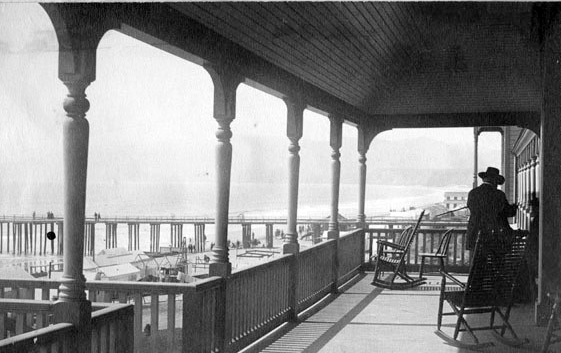 |
|
| (ca. 1890)* - View looking north from the veranda of the Arcadia Hotel showing pier and Santa Monica shoreline. |
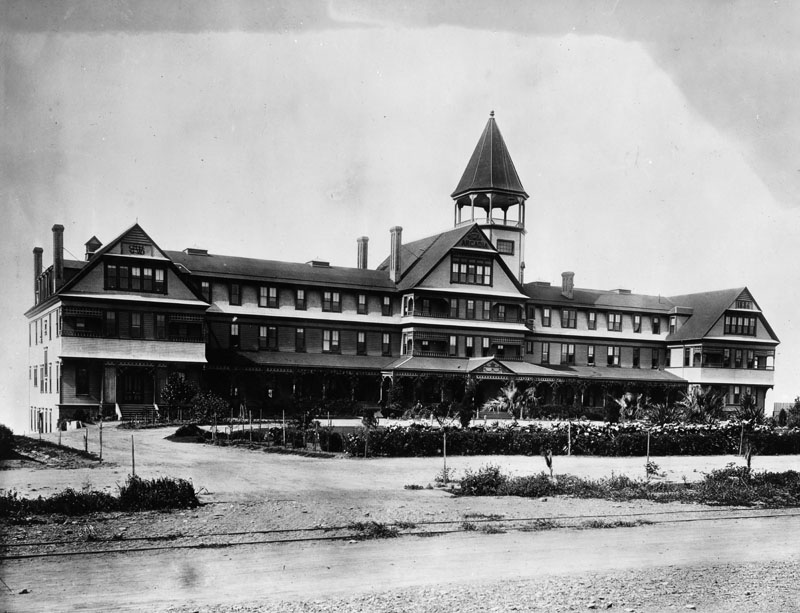 |
|
| (1890)* - Arcadia Hotel from the street side. The hotel was named for Arcadia Bandini de Baker, the wife of Santa Monica cofounder Colonel R. S. Baker. |
Historical Notes The Arcadia Hotel was the site where Colonel Griffith J. Griffith shot his wife in 1903, which led to their divorce and his (short) imprisonment. In 1882 Griffith moved to Los Angeles and purchased approximately 4,000 acres of the Rancho Los Feliz Mexican land grant. On December 16, 1896, Griffith and his wife Christina presented 3,015 acres of the Rancho Los Feliz to the city of Los Angeles for use as a public park. Griffith called it "a Christmas present." After accepting the donation, the city passed an ordinance to name the property Griffith Park, in honor of the donor. Griffith later donated another 1,000 acres along the Los Angeles River. |
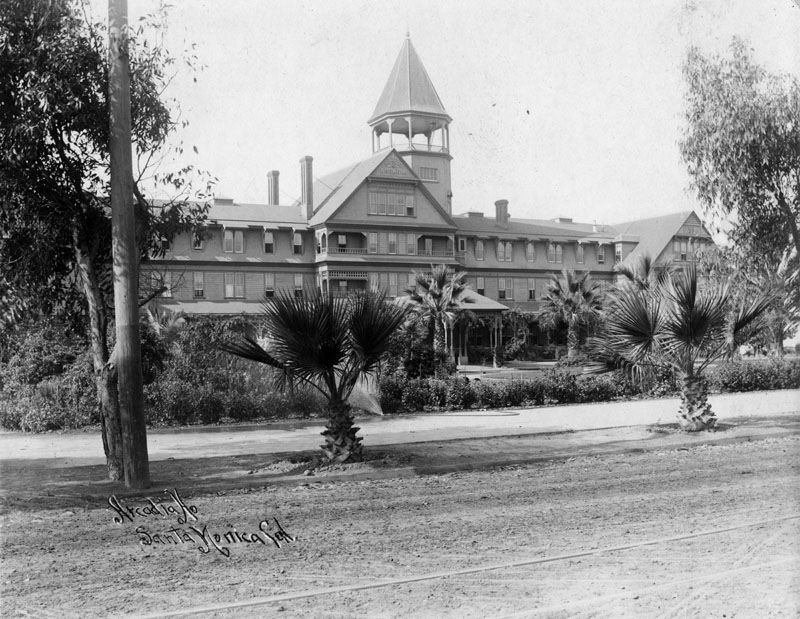 |
|
| (1890s)* - View of the Arcadia Hotel from the street. The landscaping is now more fully developed. |
Historical Notes The Arcadia Hotel was a landmark, hailed as one of the finest hotels in Southern California in its day. However, like many hotels in the area, the Arcadia hotel was forced to close in times of slow business; the hotel closed for one year from 1888-1889, and permanently in 1906 when the building boom subsided. In 1907, there was a failed attempt to convert the hotel into a private school for the California Military Academy, but the property stood abandoned until it was demolished in 1909 to make room for beach improvements, homes, and hotels. |
 |
|
| (1890s)* - Panoramic view of the Arcadia Hotel looking towards the ocean. In front of the hotel are extensive, well manicured lawns and gardens. |
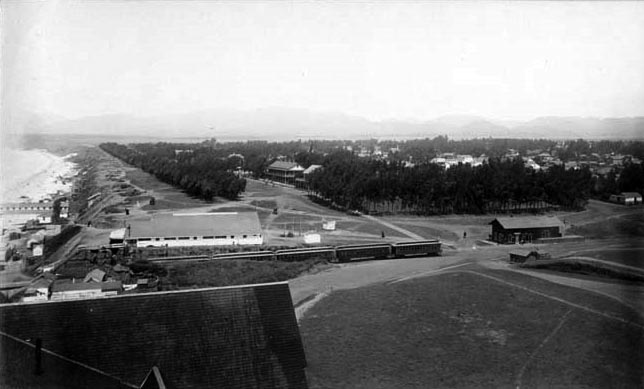 |
|
| (1887)* – View looking North from top of the newly-built Arcadia Hotel showing the Los Angeles & Independence Railroad Santa Monica station. The coastline and Palisades are seen on the left. |
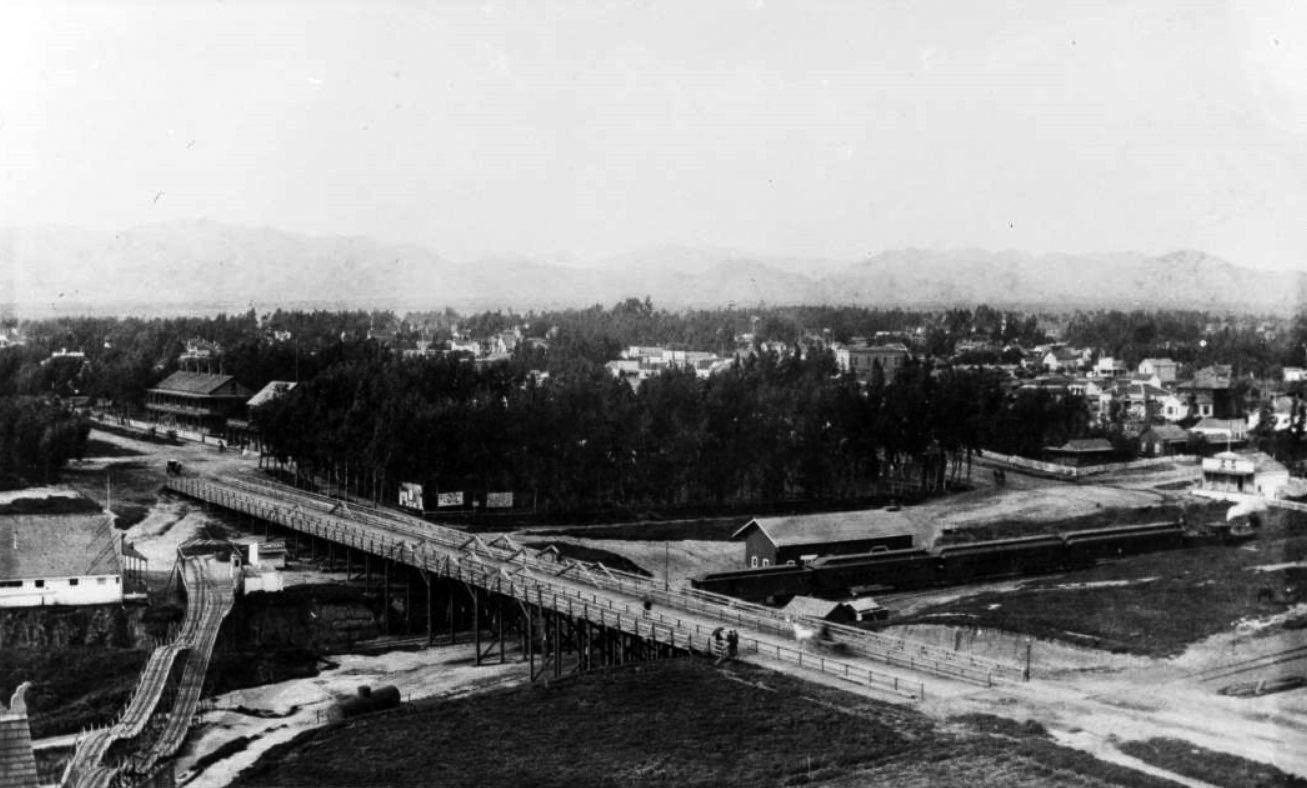 |
|
| (1888)* - View showing the Thompson Gravity Switchback Railroad (aka Switchback Roller Coaster) on the left, which traveled across the ravine between the Arcadia Hotel (not pictured) and the north side of the Southern Pacific Railroad tracks. The Los Angeles & Independence Railroad Santa Monica Depot is on the right. |
* * * * * |
Thompson Gravity Switchback Railroad (aka Switchback Roller Coaster)
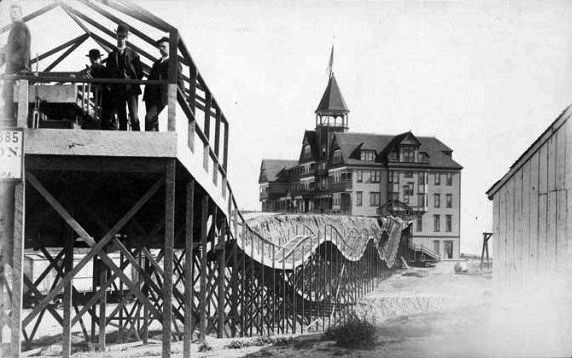 |
|
| (ca. 1887)*^* - The 'Switchback Roller Coaster' with the Arcadia Hotel in the background. |
Historical Notes A special delight for Arcadia Hotel guests was a two-track gravity switchback roller coaster, which in a one minute journey, could whisk guests either to or from the hotel and back again. For five cents, riders would climb a platform to board the large bench-like car and were pushed off to coast 300 ft. down the track across the ravine. The car went just over 6 mph. At the top of the other platform the vehicle was switched to a return track or "switched back" (hence the name). |
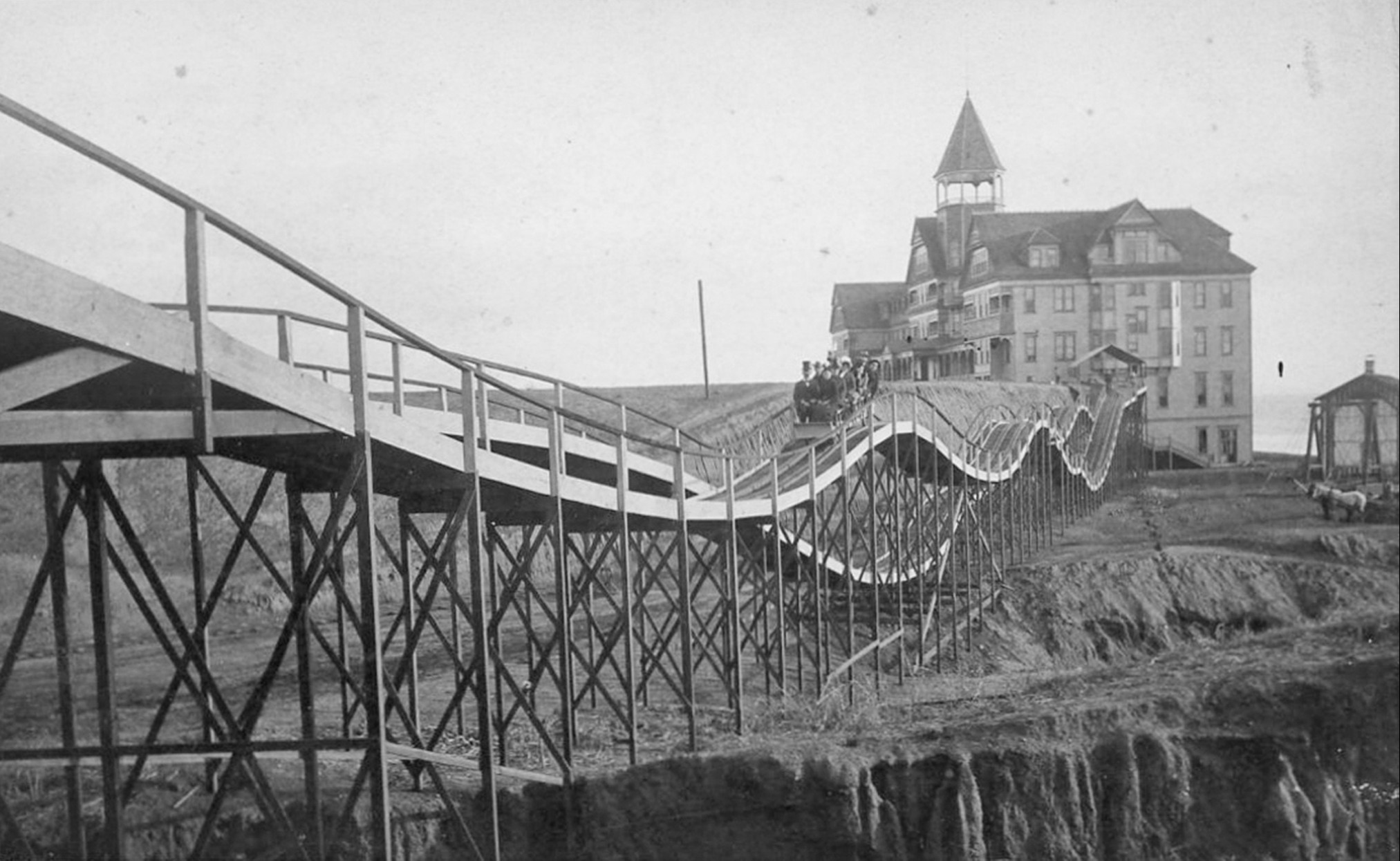 |
|
| (1880s)* - View of the switchback roller coaster in motion halfway between the Arcadia Hotel and its end point on the Santa Monica bluffs. |
Historical Notes The original Switchback Railway (Coney Island) was the first roller coaster designed as an amusement ride in America. It was designed by LaMarcus Adna Thompson in 1881 and constructed in 1884. It appears Thompson based his design, at least in part, on the Mauch Chunk Switchback Railway which was a coal-mining train that had started carrying passengers as a thrill ride in 1827. |
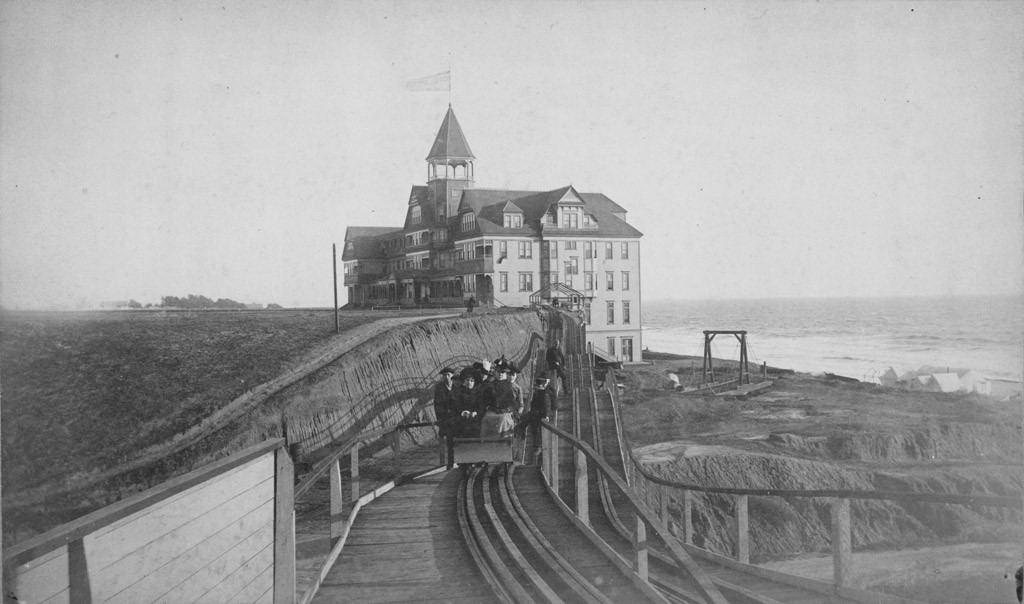 |
|
| (ca. 1887)#^^ - View showing several men and women in a roller coaster as it comes to the end of its ride across the Santa Monica bluffs. In the background is seen the Arcadia Hotel with a flag flying high from the top of its observation tower. |
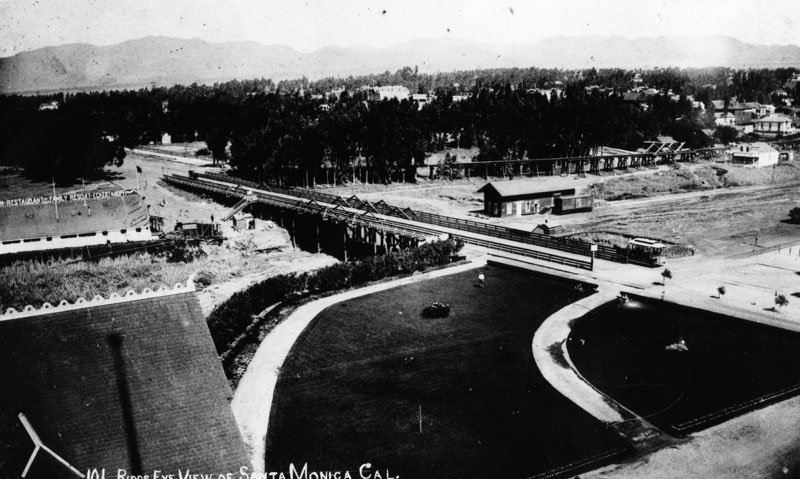 |
|
| (1894)* - Bird’s eye view looking north from the Arcadia Hotel showing the bridge over the gulch that was later occupied by the Roosevelt Highway. Note that the Switchback Roller Coaster is no longer there. Click HERE to see same view in 1888. |
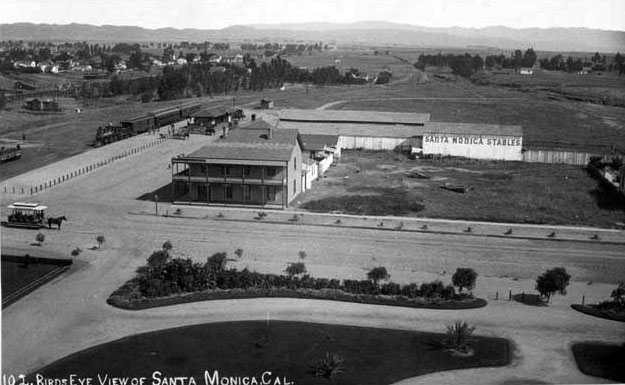 |
|
| (1894)* – View looking northeast from the Arcadia Hotel showing hotel on corner, horse-drawn trolley in street (left), Santa Monica railroad station with train (distant left), Santa Monica Stables (center right), and landscaped parkway (center foreground). |
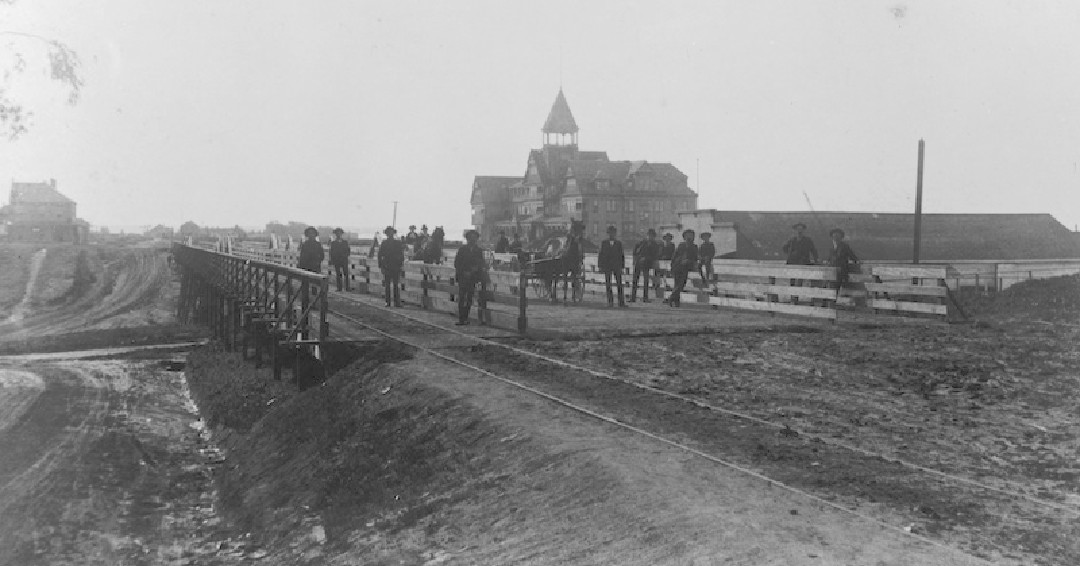 |
|
| (ca. 1890s)* - Railroad Avenue (now Colorado). The Arcadia Hotel is seen in the background. The famed beachfront establishment was on Ocean Avenue between Railroad Avenue and Front Street (now Pico Boulevard). |
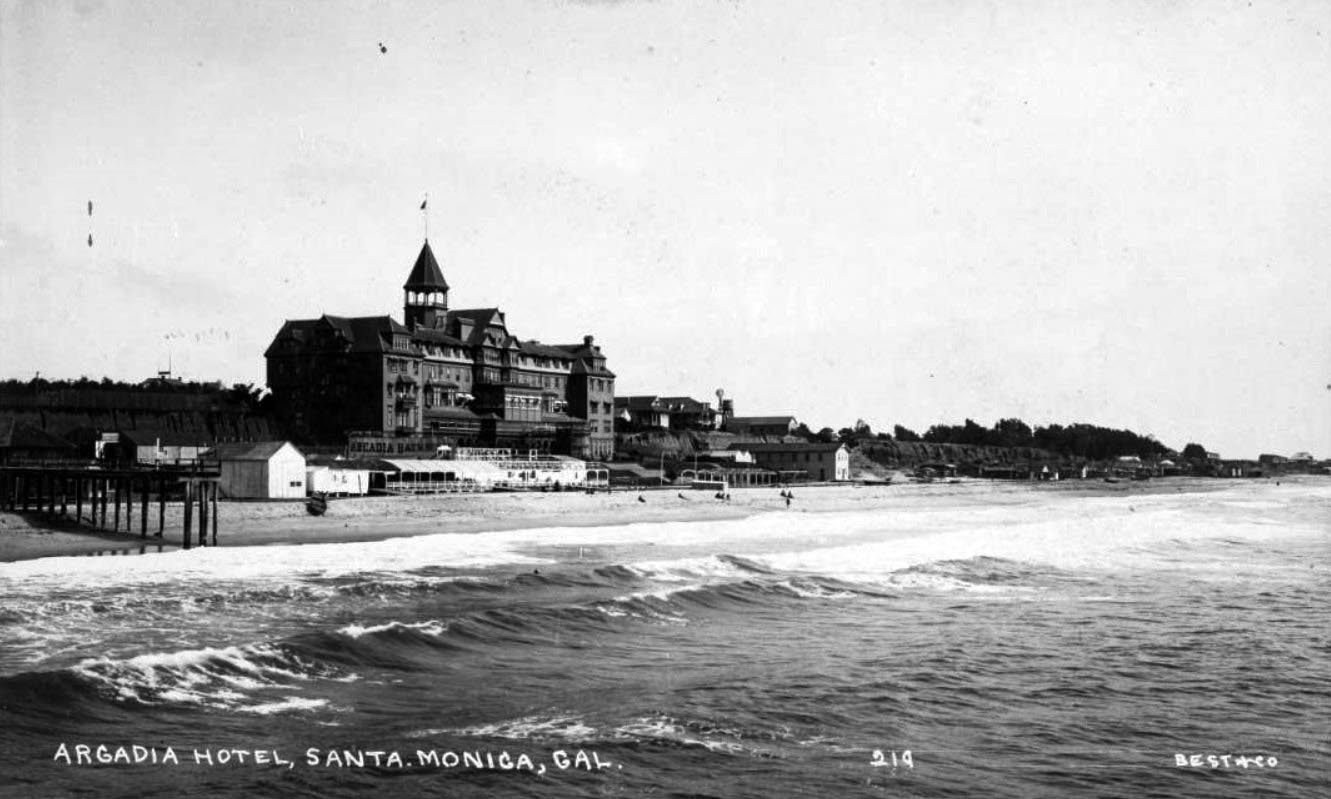 |
|
| (ca. 1898)^ - Postcard view showing the beach side of the Arcadia Hotel and bath house as seen from the 1898-built North Beach Bath House Pier. The portion of a pier at left is the remains of the Los Angeles & Independence Railroad Wharf. |
Historical Notes The Arcadia Hotel opened for business in 1887 and was located on Ocean Avenue between Railroad Avenue (later known as Colorado Avenue) and Front (later known as Pico Boulevard). The Arcadia was the largest structure in Santa Monica at the time of its construction. The 125-room hotel was owned by J.W. Scott, the proprietor of the city's first hotel, the Santa Monica Hotel. The hotel was named for Arcadia Bandini de Baker, the wife of Santa Monica cofounder Colonel R. S. Baker. The hotel was built next to a steep cliff and shows only 3 stories on the Ocean Avenue side and 5 stories on the beach side as seen above. |
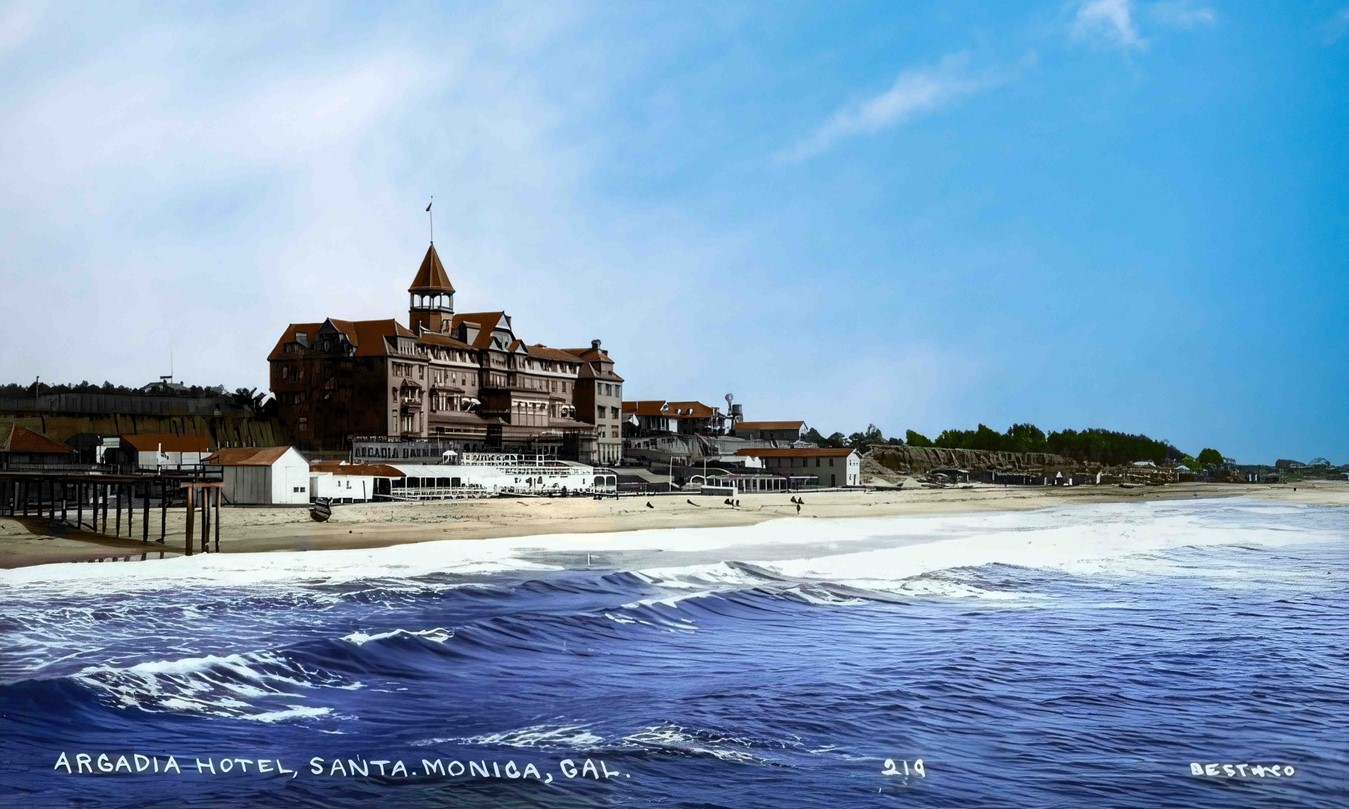 |
|
| (ca. 1898)* - Postcard view showing the beach side of the Arcadia Hotel and bath house as seen from the 1898-built North Beach Bath House Pier. The portion of a pier at left is the remains of the Los Angeles & Independence Railroad Wharf. Image enhancement and colorization by Richard Holoff. |
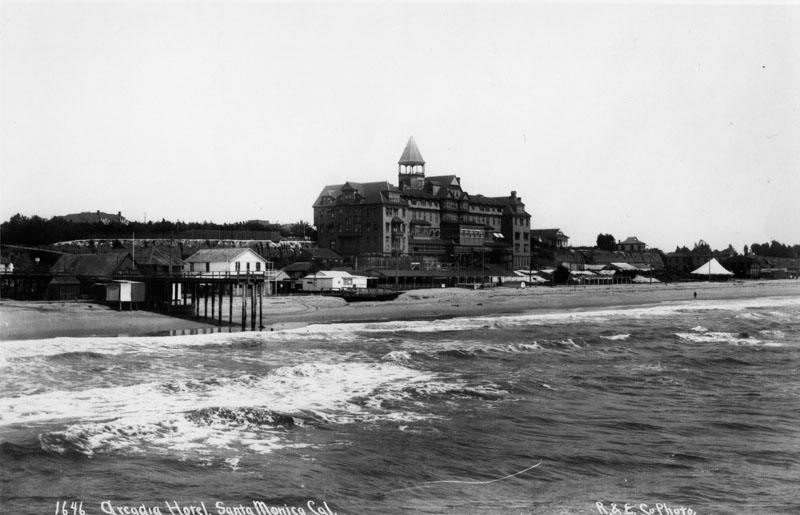 |
|
| (1890s)* - Slightly different view of the Arcadia Hotel with the remains of the Los Angeles & Independence Railroad Wharf on the left. |
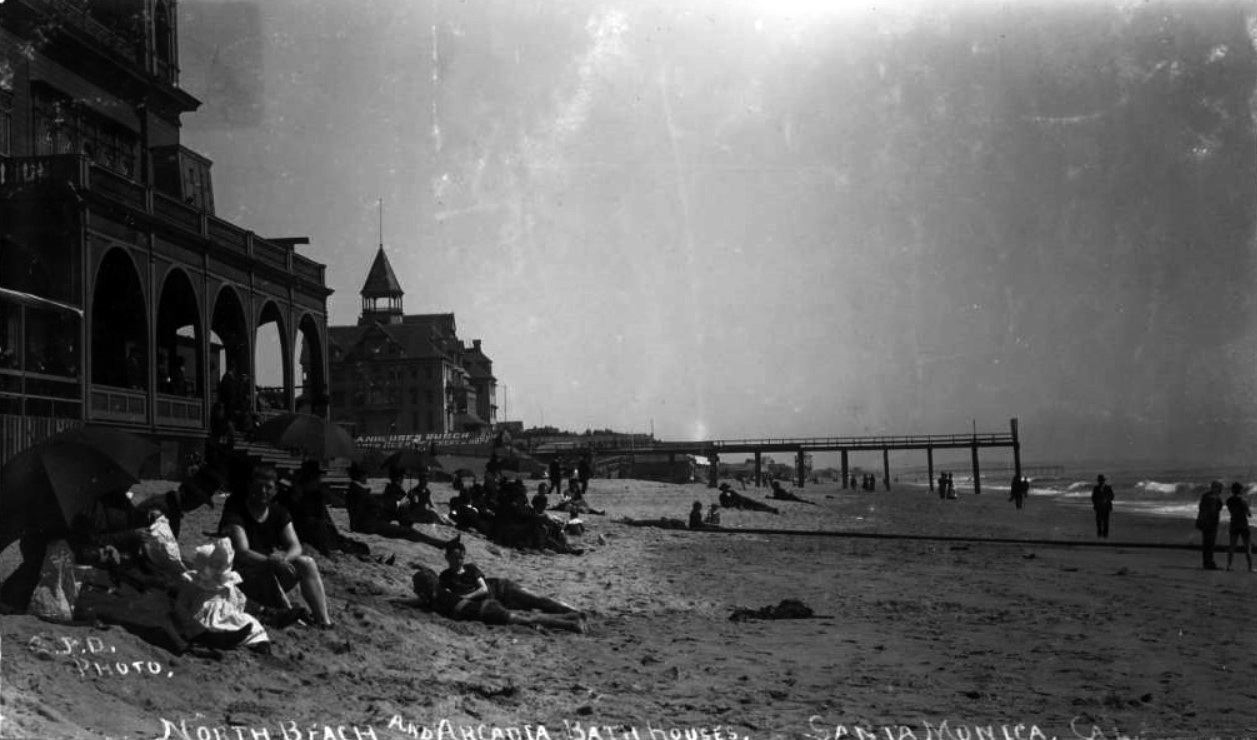 |
|
| (ca. 1898)* - Image of the North Beach Bath House and Arcadia Bath Houses on the beach with people lying in the sand and piers visible in the distance. Signs are visible that read "Anheuser Busch beer St. Louis Eckert & Hopf" and "Arcadia Bathhouse." The portion of the pier at center is the remains of the Los Angeles & Independence Railroad Wharf. |
Historical Notes The North Beach Bath House was built in 1898 and replaced the 1876-built Santa Monica Bath House. |
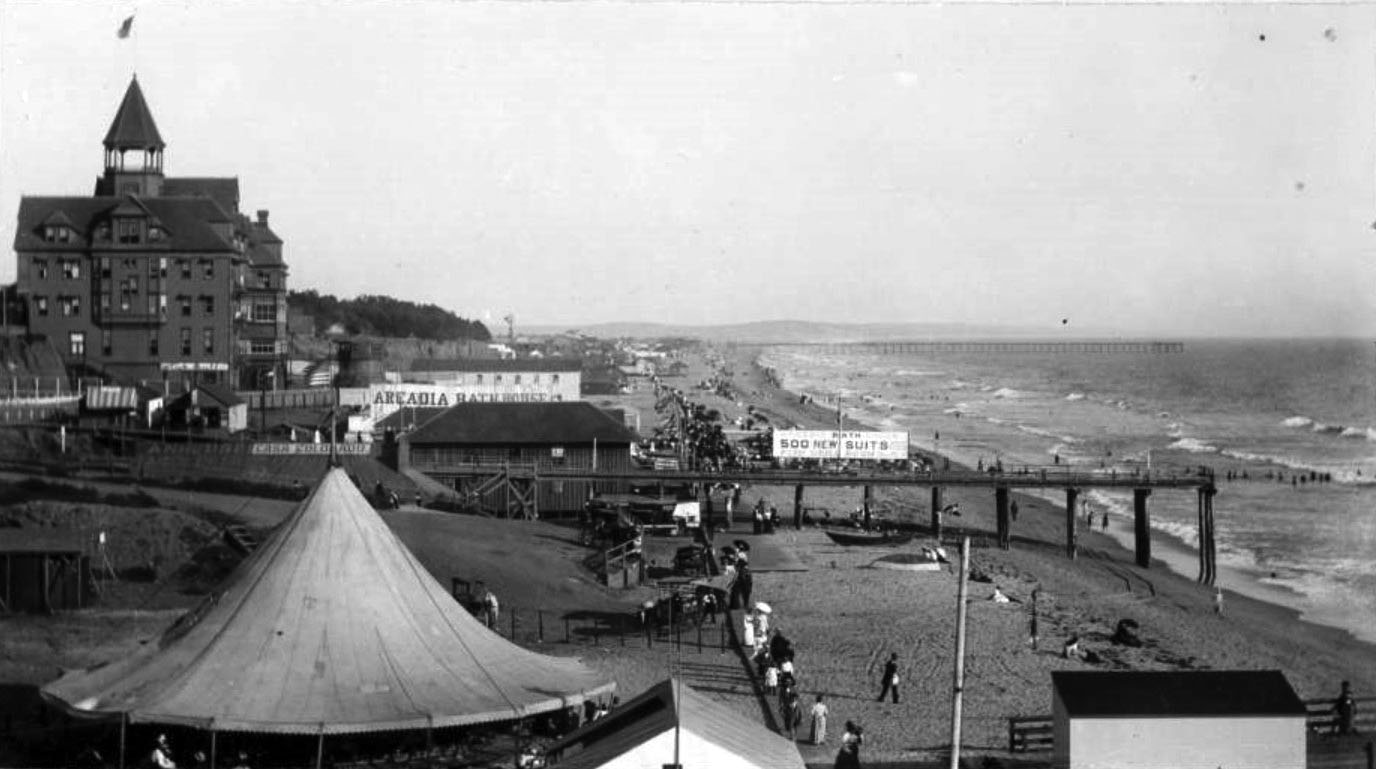 |
|
| (ca. 1898)* - View looking south from the North Beach Bath House showing the beach and pier (remaining portion of the Los Angeles and Independence Pier) near the Arcadia Hotel and Arcadia Bath House. Visible signs include "Arcadia Bath House, 500 new suits, new tubs, fish grill room" and "Casa Colorado" (partially painted over Anheuser Busch lettering). People are seen walking along a wooden boardwalk, including women with parasols, horse-drawn wagons, a carousel tent, and various small boats on the sand are also visible. A windmill can be seen in the distance. |
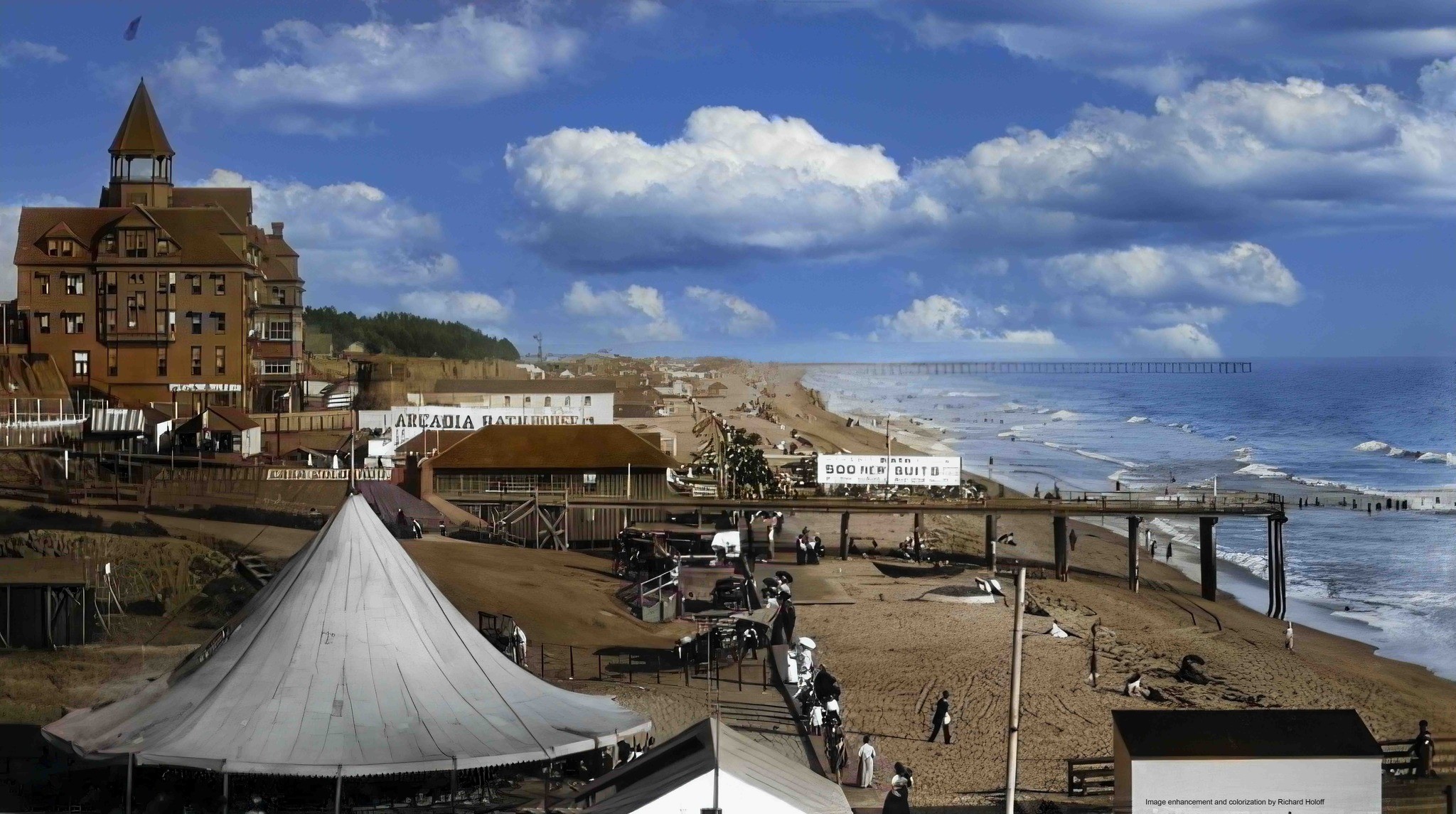 |
|
| (ca. 1898)* - Looking south from the North Beach Bath House showing the beach and pier (remaining portion of the Los Angeles and Independence Pier) near the Arcadia Hotel and Arcadia Bath House. Image enhancement and colorization by Richard Holoff |
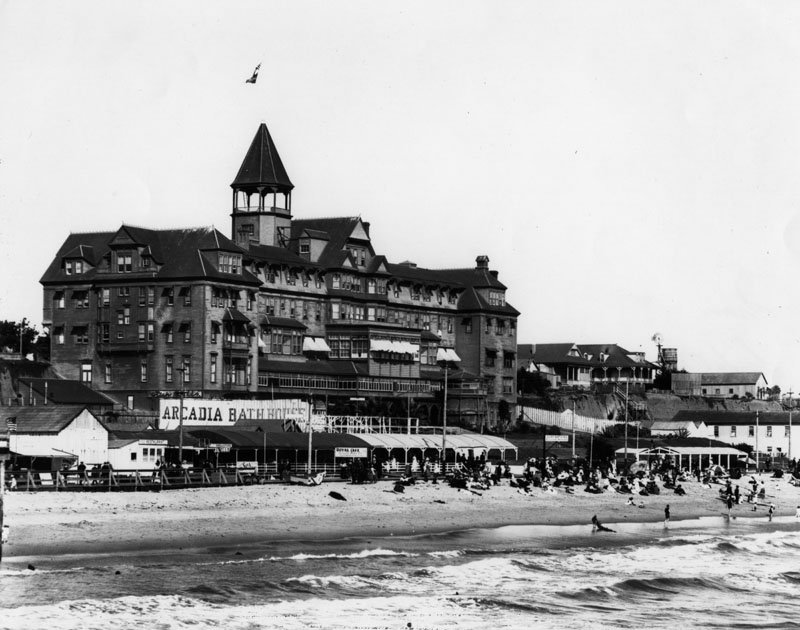 |
|
| (ca. 1890)* - Another view from the pier showing the Arcadia Hotel on Santa Monica South Beach behind the Arcadia Bath House. |
Historical Notes When it opened in 1887, Santa Monica's ritzy Arcadia Hotel offered its guests a large saltwater bathhouse, the Arcadia Bath House. |
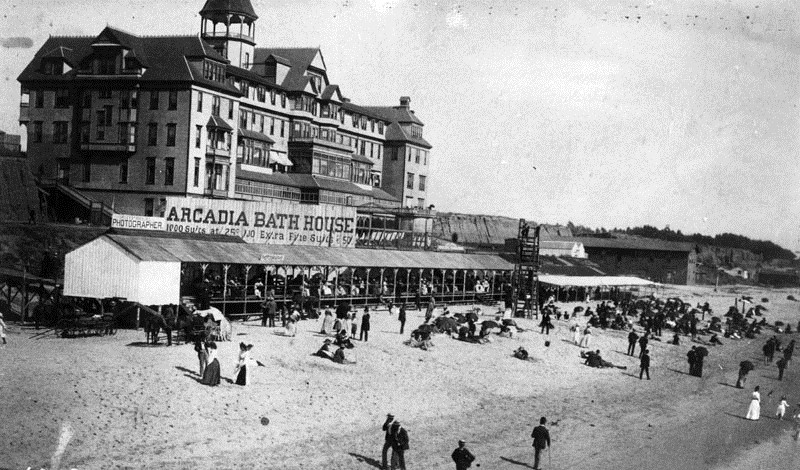 |
|
| (1890)* - A closer view of South Beach. People are walking and sitting in front of the Arcadia Bath House with the Arcadia Hotel sitting in the background. |
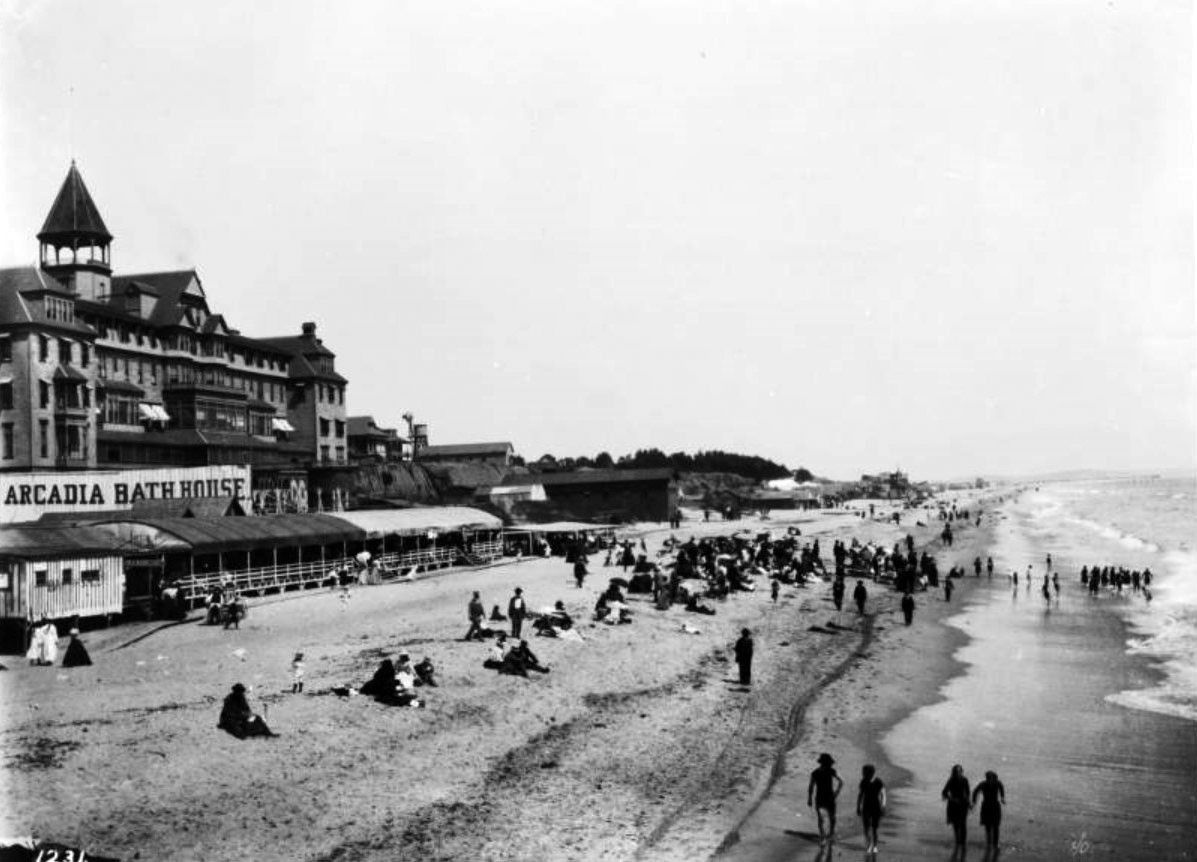 |
|
| (ca. 1892)* - Photograph of the Arcadia Hotel and Bath House in Santa Monica, ca.1892-1898. The beach is at low tide and to the far right, the ocean can be seen crashing against the shore. Groups of people play or walk in the surf while others sunbathe on the sandy beach. To the far left, sits the large four-story wooden Arcadia Hotel with a turret on its roof. Along the base of the hotel, a tented pavilion is visible on the beach. Legible signs include: "Arcadia Bath House" and "Clam Chowder” |
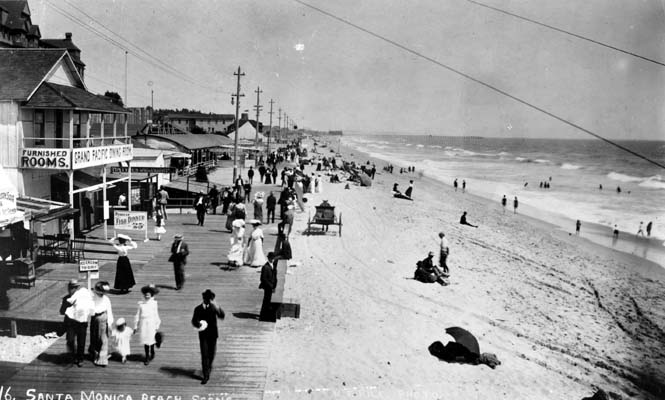 |
|
| (1890)* - People walking on the Santa Monica Beach boardwalk. A horse-drawn carriage (center of photo) appears to be heading south along the sand, parallel to the boardwalk. |
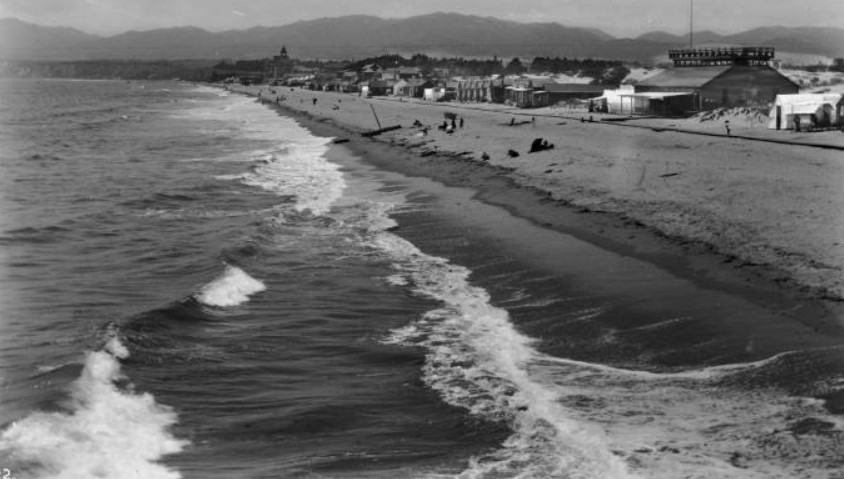 |
|
| (ca. 1895)* - View of South Beach looking north toward the Arcadia Hotel and Palisades. The long boardwalk can be seen extending all the way to the hotel. |
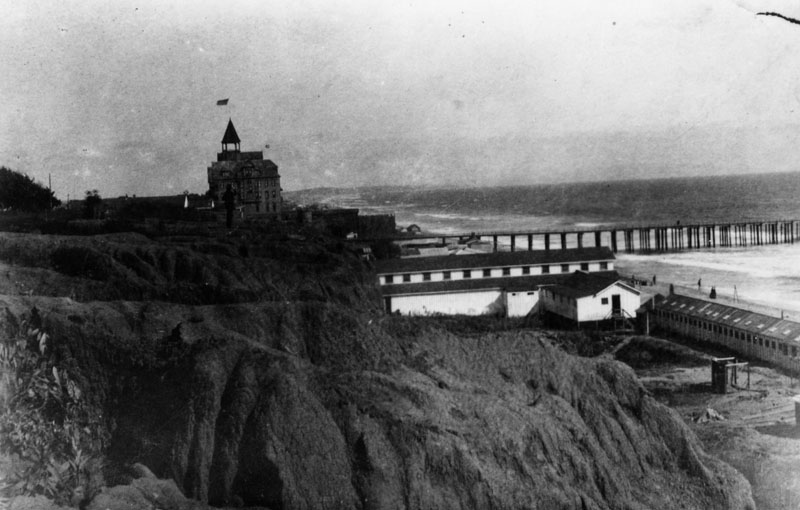 |
|
| (1888)* - Bathhouses on the beach near Santa Monica with the Arcadia Hotel standing in the background. The pier can also be seen. |
* * * * * |
Southern Pacific Railroad Tunnel
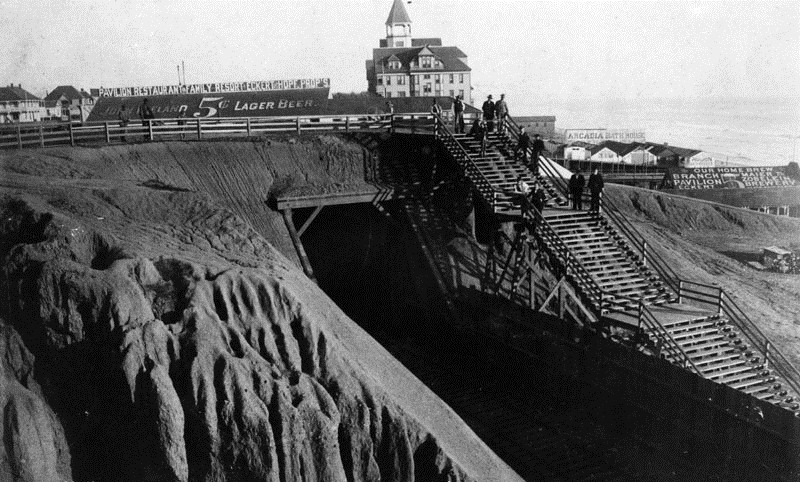 |
|
| (1890s)* - View looking south of the Arcadia Hotel and the Arcadia Bath House. The Southern Pacific Railroad tunnel is seen at center. At right are the '55 steps' that enabled visitors to have quick access to the beach below. |
Historical Notes In 1891, the Southern Pacific Railroad built a tunnel under Ocean Avenue for its new rail line to Santa Monica Canyon that was later sold to the Pacific Electric Railway . The rail line was in use from 1891 to 1933. |
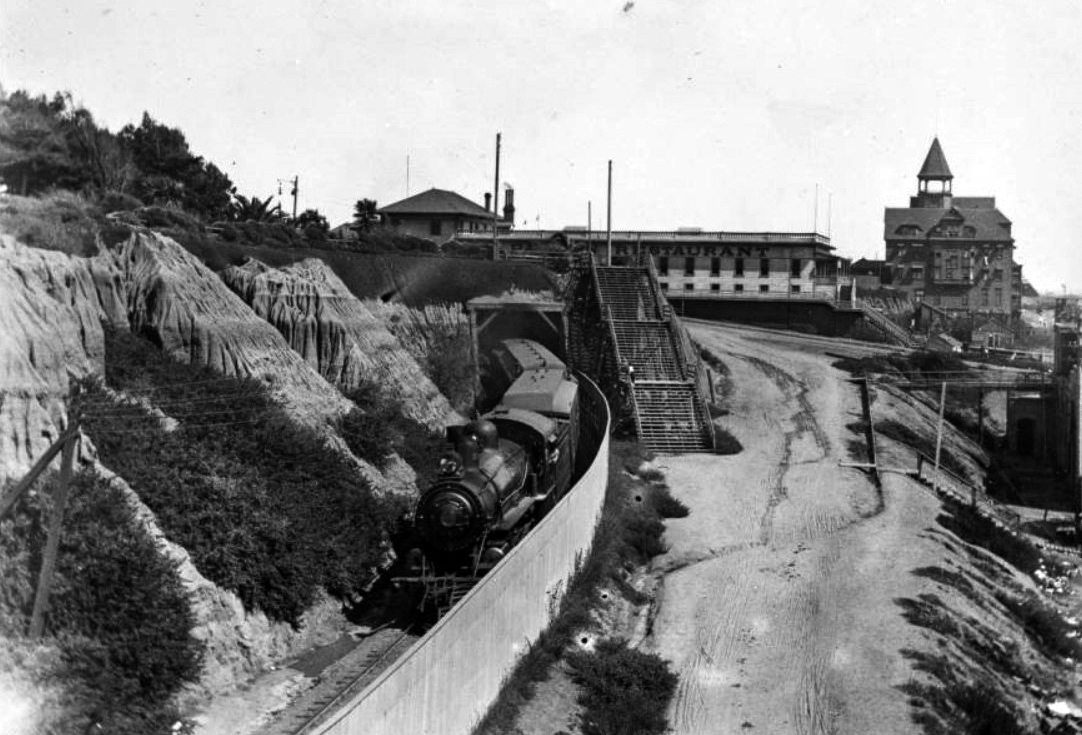 |
|
| (1896)^ – View showing a Southern Pacific train emerging from a tunnel, with the Arcadia Hotel in the distance on the right. |
Historical Notes In 1936, the Southern Pacific Tunnel was enlarged for vehicular use (later renamed McClure Tunnel) and connected Lincoln Boulevard with the Roosevelt Highway (later PCH). Click HERE to see more. |
Then and Now
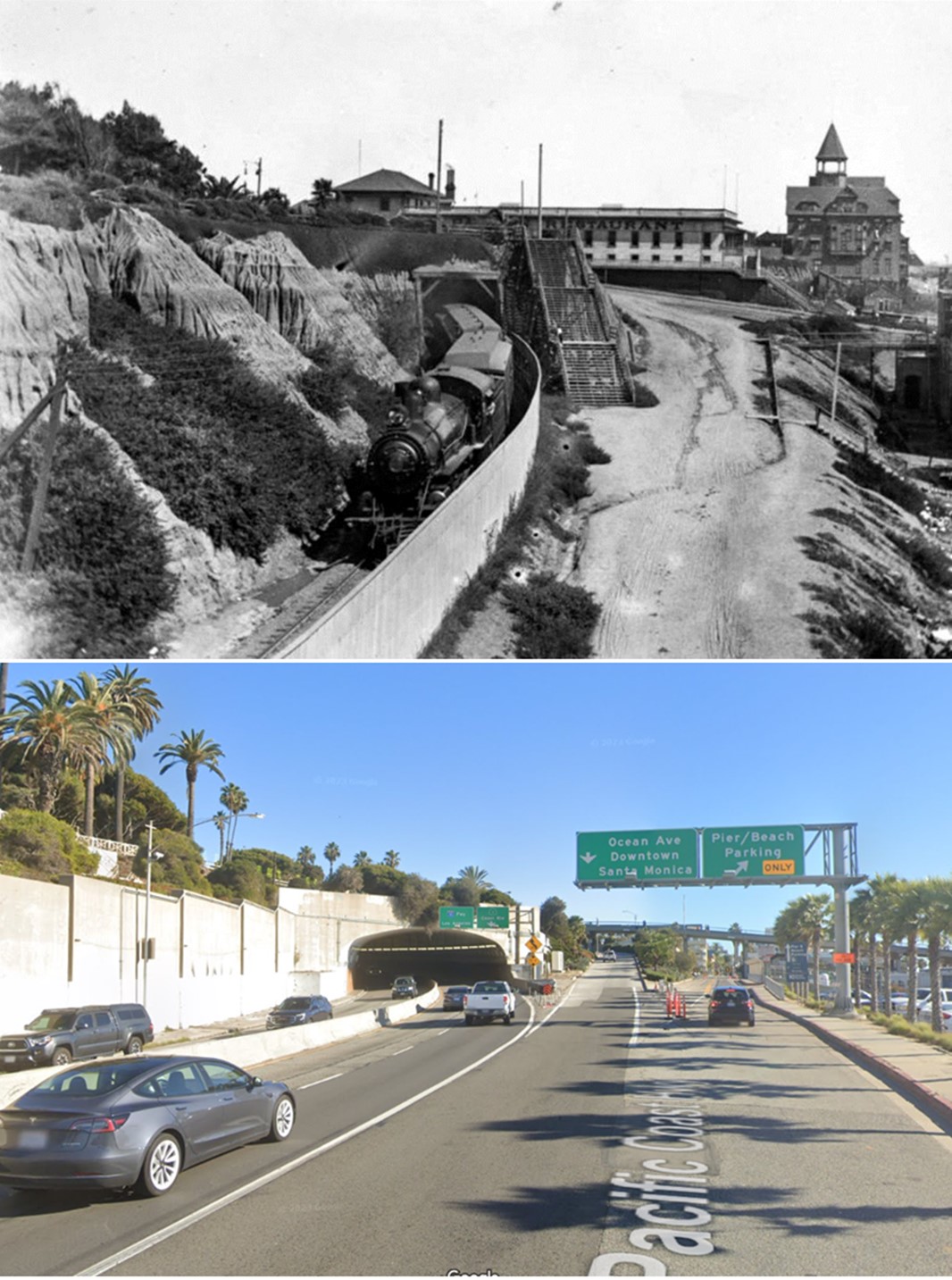 |
|
| (1896 vs. 2023)* - Southern Pacific Railroad Tunnel, today the McClure Tunnel. |
* * * * * |
Arcadia Hotel
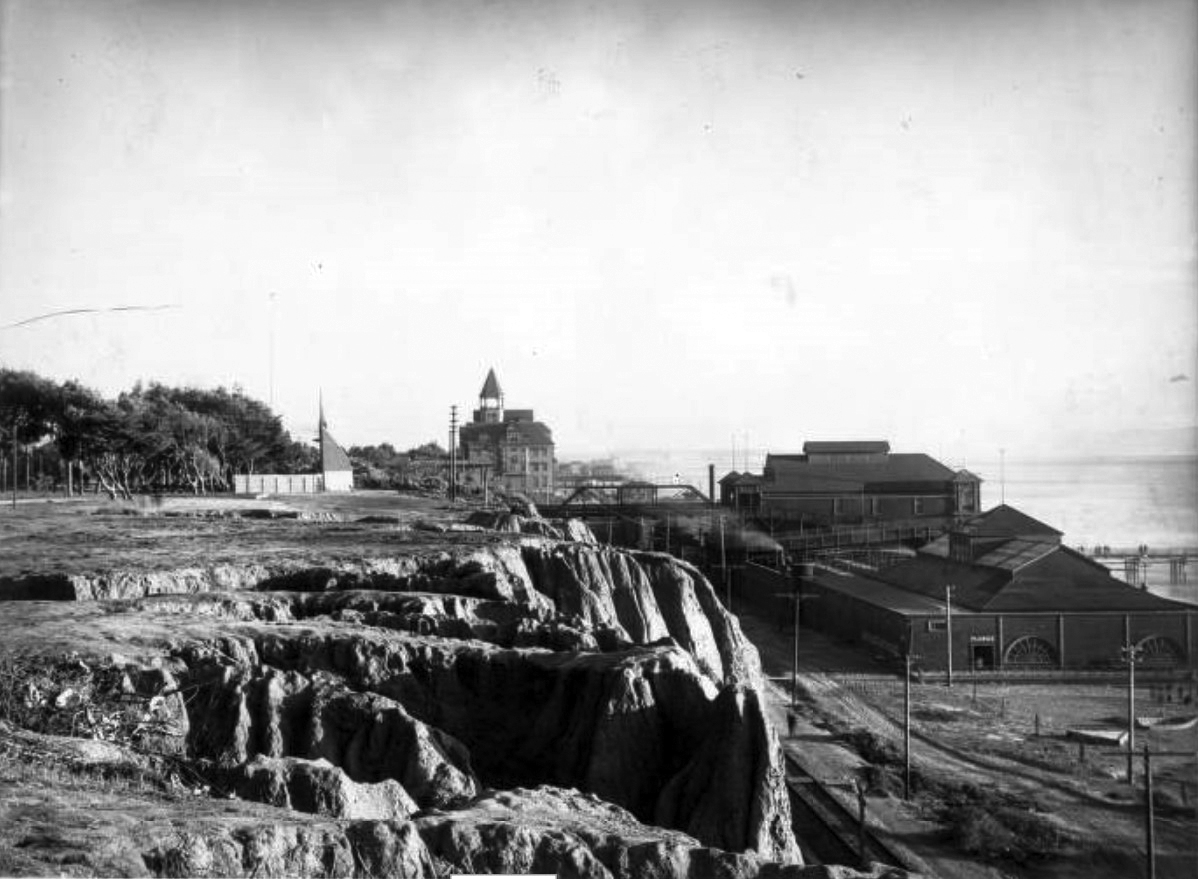 |
|
| (1904)^ – View showing the alluvial bluffs of Linda Vista Park (renamed Palisades Park in the 1920s) with the Arcadia Hotel in the distance at center and the North Beach Bath House at right. Train tracks are visible below the cliffs, behind the bathhouse and the North Beach Pier (built in 1898) is seen at far right. |
Historical Notes The Arcadia Hotel was built in 1887 and demolished in 1907. |
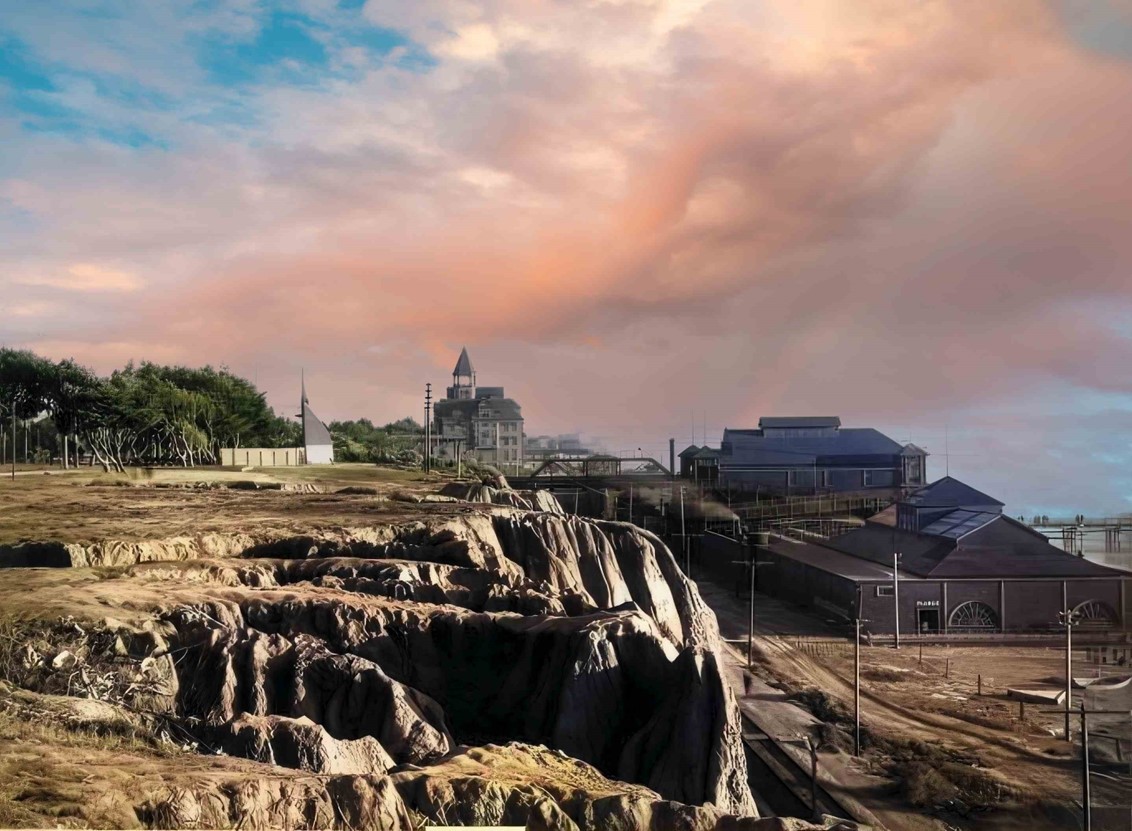 |
|
| (1904)^ – View showing the alluvial bluffs of Linda Vista Park (renamed Palisades Park in the 1920s) with the Arcadia Hotel in the distance at center and the North Beach Bath House at right. (AI image enhancement and colorization by Richard Holoff) |
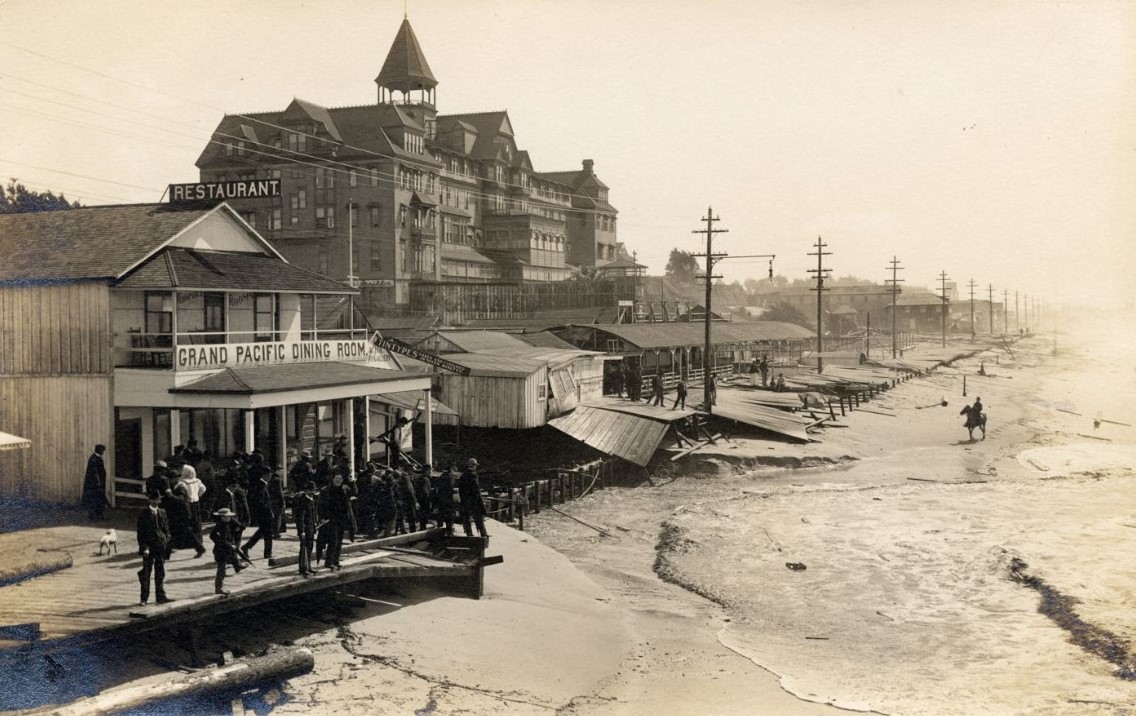 |
|
| (ca. 1905)* - Spectators stand on a partially destroyed boardwalk looking at the damage in the aftermath of a storm. A man on horseback is seen on the beach and the Arcadia Hotel stands in the background. |
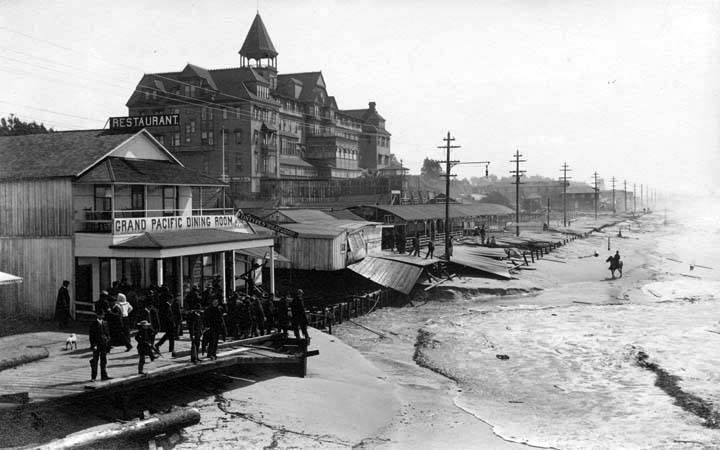 |
|
| (ca. 1905)* - Spectators stand on a partially destroyed boardwalk looking at the damage in the aftermath of a storm. A man on horseback is seen on the beach and the Arcadia Hotel stands in the background. |
* * * * * |
Santa Monica Bathing
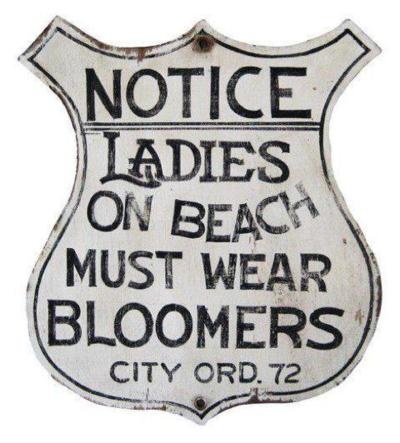 |
|
| (1910s)* - Neighboring Venice Beach sign. (Truth or Fiction?) |
Historical Notes The sign reading “NOTICE: LADIES ON BEACH MUST WEAR BLOOMERS – CITY ORD. 72” appears to be a novelty reproduction rather than an authentic municipal posting from Venice Beach or nearby coastal towns. However, its message draws from real history. In the early 1900s, many seaside communities in Southern California, including Venice, enforced strict modesty laws that dictated what women could wear at the beach. Bloomers and full-length bathing attire were often required, and so-called “swimsuit police” or “beach censors” patrolled the sand, sometimes measuring women’s suits to ensure compliance. Famous photographs from the 1920s and 1930s show officers at Venice Beach inspecting beachgoers’ attire—evidence of genuine social norms that inspired signs like this, whether in jest or homage. While no known city ordinance matches “ORD. 72,” the sign captures, through exaggeration or satire, the era’s tension between public decency codes and evolving fashion freedoms. |
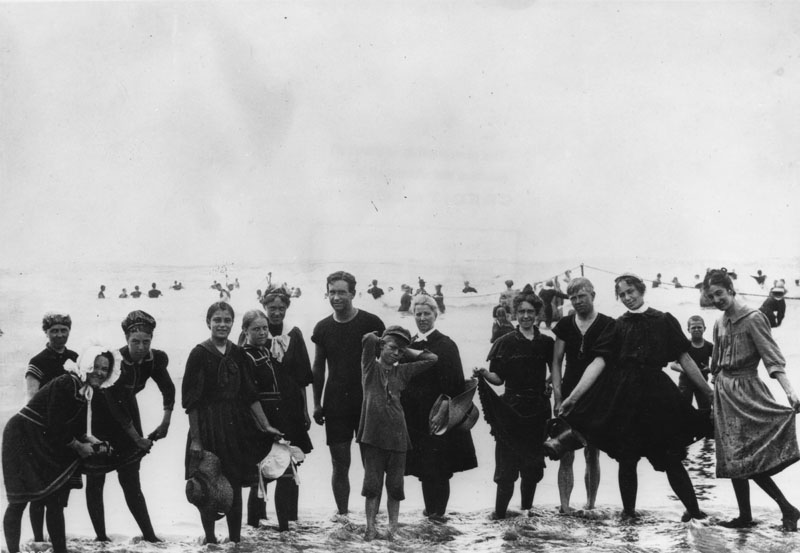 |
|
| (1890)* - Group photo of men and women in their bathing suits, standing in ankle deep water on Santa Monica beach. |
Historical Notes In the 1890s, Santa Monica Beach was a burgeoning seaside resort, attracting visitors eager to enjoy the Pacific surf and the burgeoning amenities of the area. Group photographs from this era often depict bathers in modest swimwear, reflective of the Victorian and Edwardian sensibilities of the time. These group photos were more than mere snapshots; they served as cherished mementos of seaside excursions. Photographers would set up along the beach, offering visitors the opportunity to capture their leisure moments, which were then printed as souvenir postcards or keepsakes. Such images not only documented personal memories but also contributed to the broader cultural narrative of beach-going as a fashionable and wholesome activity during that period. |
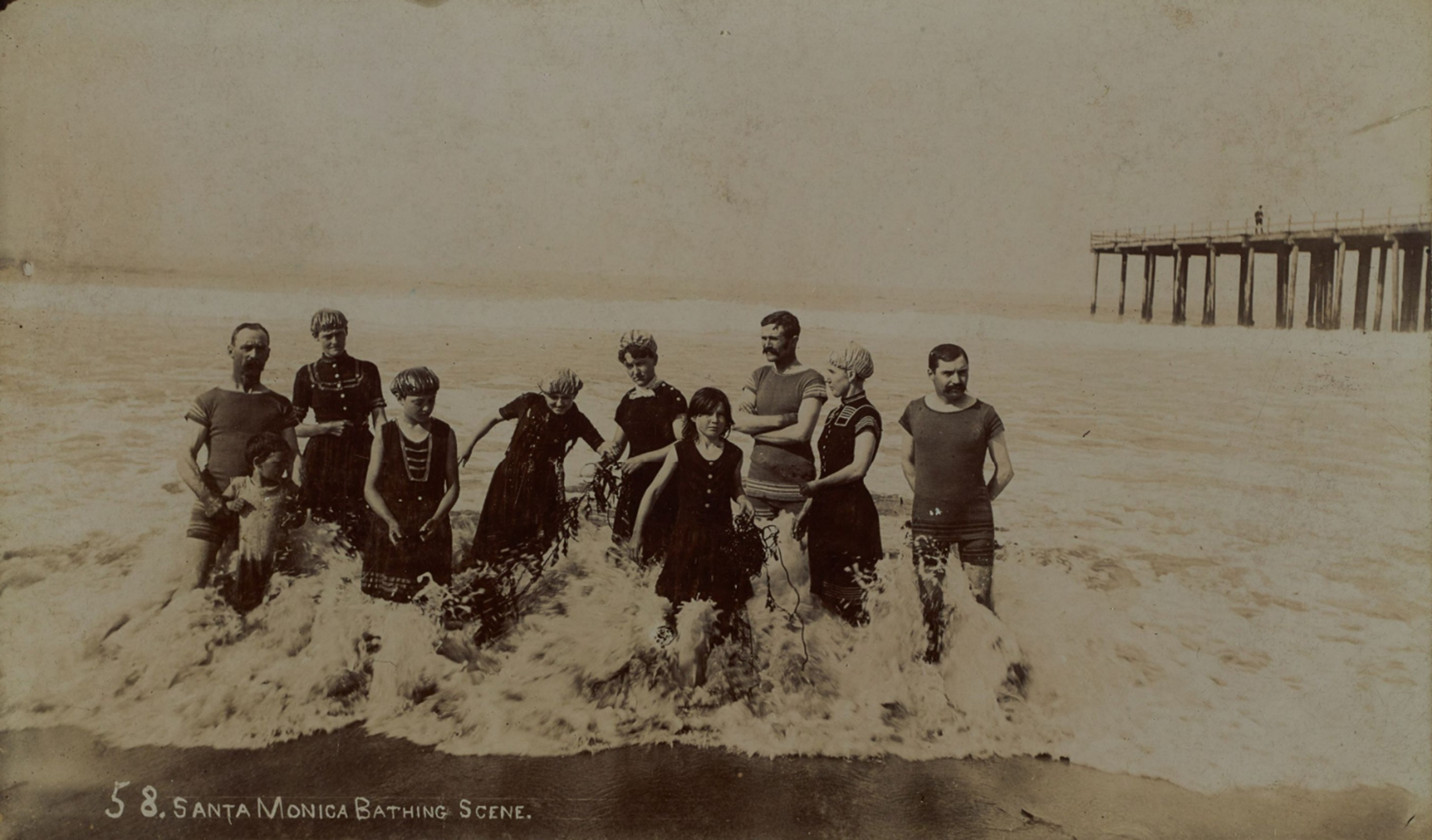 |
|
| (1890s)* - View showing a group of men, women and children wearing bathing suits and caps and holding seaweed while standing in an incoming wave on the beach in Santa Monica, with a pier at right. |
Historical Notes Women's bathing attire typically consisted of dark-colored, knee-length dresses with puffed sleeves, worn over bloomers or stockings, and complemented by bathing caps or wide-brimmed hats to shield from the sun. Men's swimwear was usually one-piece woolen suits that covered the torso and extended to the mid-thigh, often in darker hues. |
* * * * * |
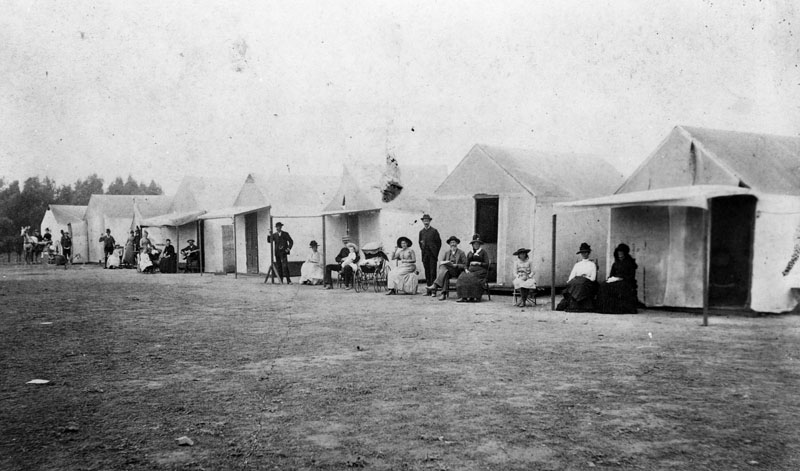 |
|
| (1890)* - People in front of their house-tents near the Santa Monica beach. |
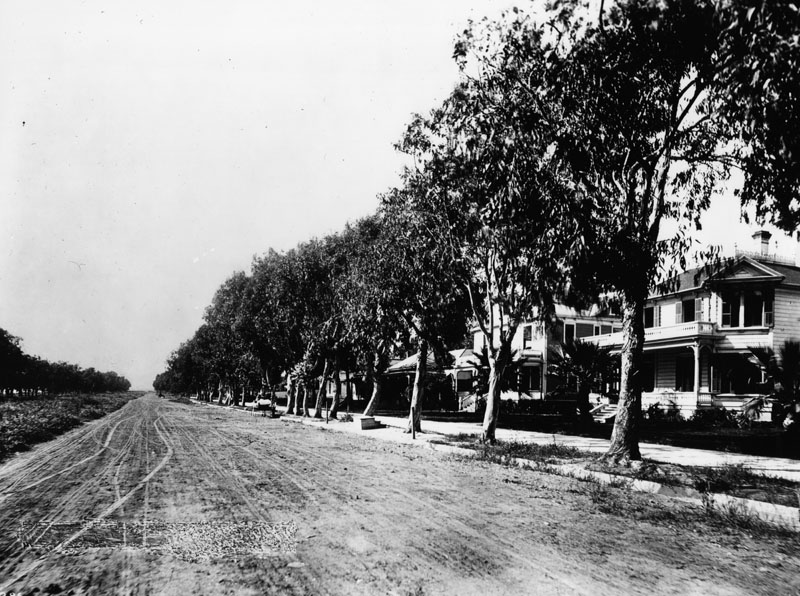 |
|
| (1890)* - View of an unpaved Ocean Avenue showing large residences and many trees lining the sidewalk. |
* * * * * |
Santa Monica Cycle Path
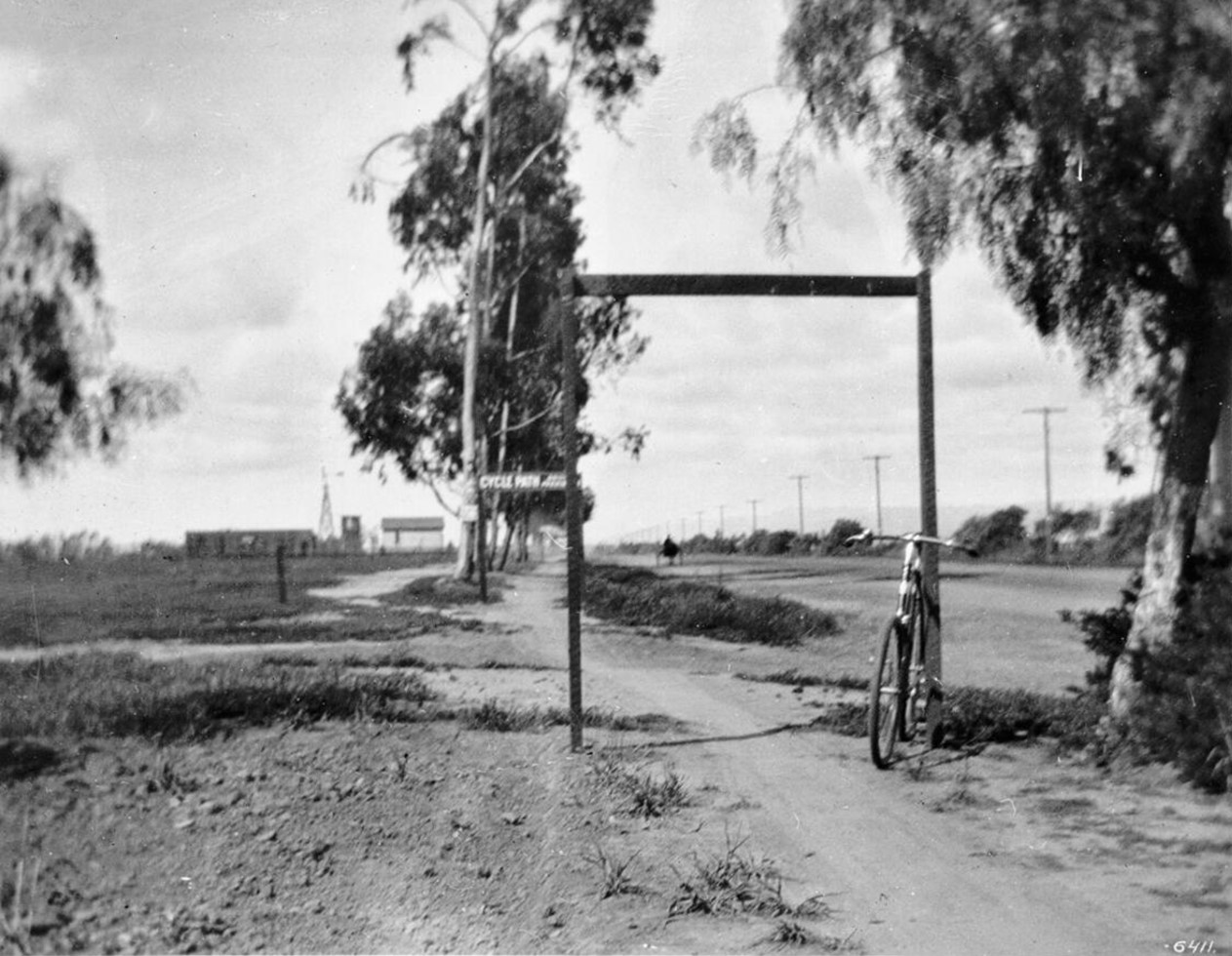 |
|
| (1896)* - The beginning of the Santa Monica Bicycle Path on Washington Street (later Boulevard) and Third Avenue in Los Angeles. The view is looking west. A bicycle is leaned against a trellis that reads "Cycle Path" across its top. A horse and buggy can be seen making their way along Washington. The photo by C.C. Pierce is dated 1896, although the entire Santa Monica Bike Path wasn't completed until 1900, according to various sources. |
| Historical Notes
The Santa Monica Cycle Path was a pioneering bicycle route in Los Angeles, completed in 1900. It was an 18 mile cycleway that provided a smooth and reliable route from downtown Los Angeles to the coast at Santa Monica. At a time when most roads were rough and poorly maintained, the path offered cyclists a safer and more efficient alternative. The cycle path was a six foot wide gravel road reserved for cyclists and pedestrians. Decorative arches marked the route and prevented wagons and buggies from entering. These arches also displayed advertisements that helped fund construction and maintenance of the path. Along the route, riders passed through open farmland, meadows, and developing industrial areas, including the Hauser slaughterhouse. Newly planted pepper trees provided shade and made the ride more comfortable. When the path opened, it greatly reduced travel time between Los Angeles and Santa Monica. It quickly became popular with cyclists who no longer had to rely on difficult wagon roads. Location note |
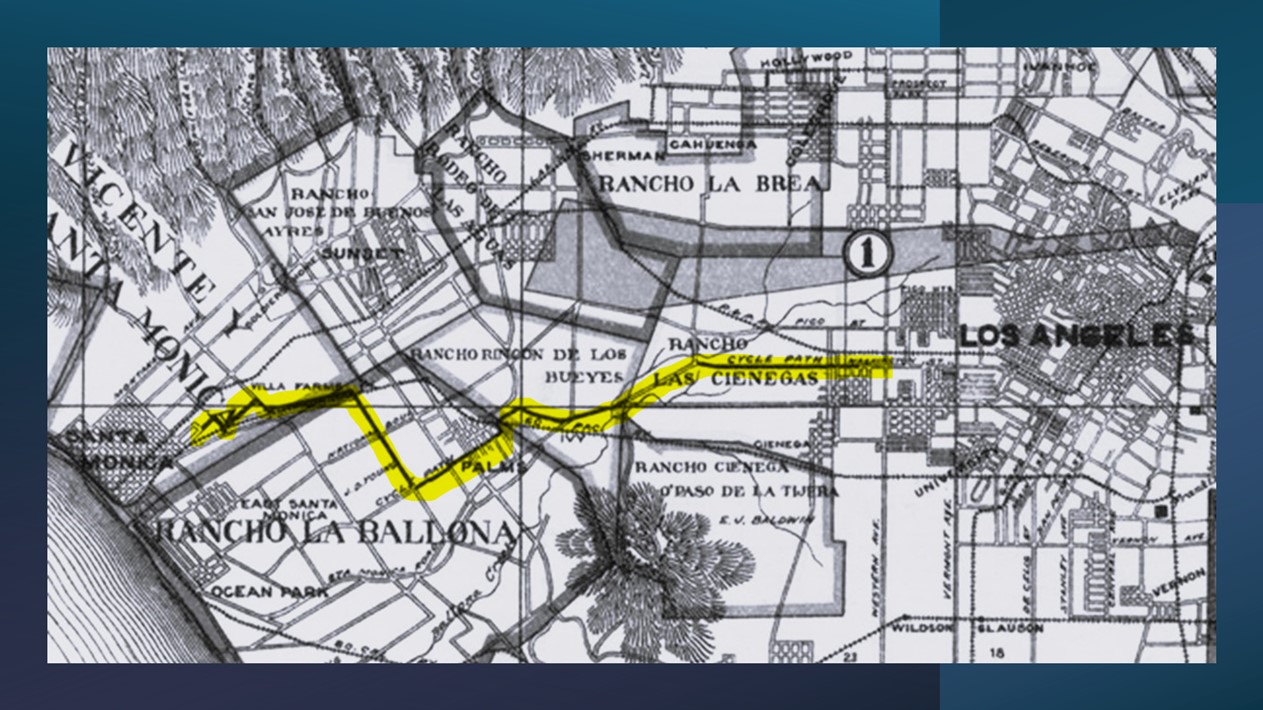 |
|
| (1900)* - The Santa Monica Cycle Path is highlighted in this 1900 map of Los Angeles County by A.L. George. Courtesy of the Library of Congress. |
| Historical Notes
The 18 mile Santa Monica Cycle Path was a dedicated bicycle route that connected downtown Los Angeles with the coastal city of Santa Monica. Beginning near the city center, the path followed Washington Street, later renamed Washington Boulevard, creating a direct east west route across the city. Key intersections along the way included Third Avenue and Western Avenue. West of these points, the path passed through less developed areas, including what is now Culver City, before reaching Santa Monica and its coastal attractions. Washington Street was renamed Washington Boulevard in the early 1900s as the roadway was widened and improved. By 1905, it was already commonly referred to as Washington Boulevard and was used for organized horse driving events west of Western Avenue. |
 |
|
| (1900)* - Photograph of the Santa Monica Cycle Path on Washington Street (by 1905, Boulevard) and Western Avenue, looking west, Los Angeles. A bicycle stands upright in the middle of the unpaved path, while a rider on his bicycle can be seen in the distance, pedaling along a row of telephone poles. |
| Historical Notes
The Santa Monica Cycle Path was built as part of the good roads movement led by the League of American Wheelmen. The movement focused on improving road conditions, first for cyclists and later for all travelers. Fundraising for the path also served as publicity, with supporters purchasing good roads buttons instead of paying a toll. The path crossed Washington Boulevard at Western Avenue, an important point along the route between Los Angeles and Santa Monica. |
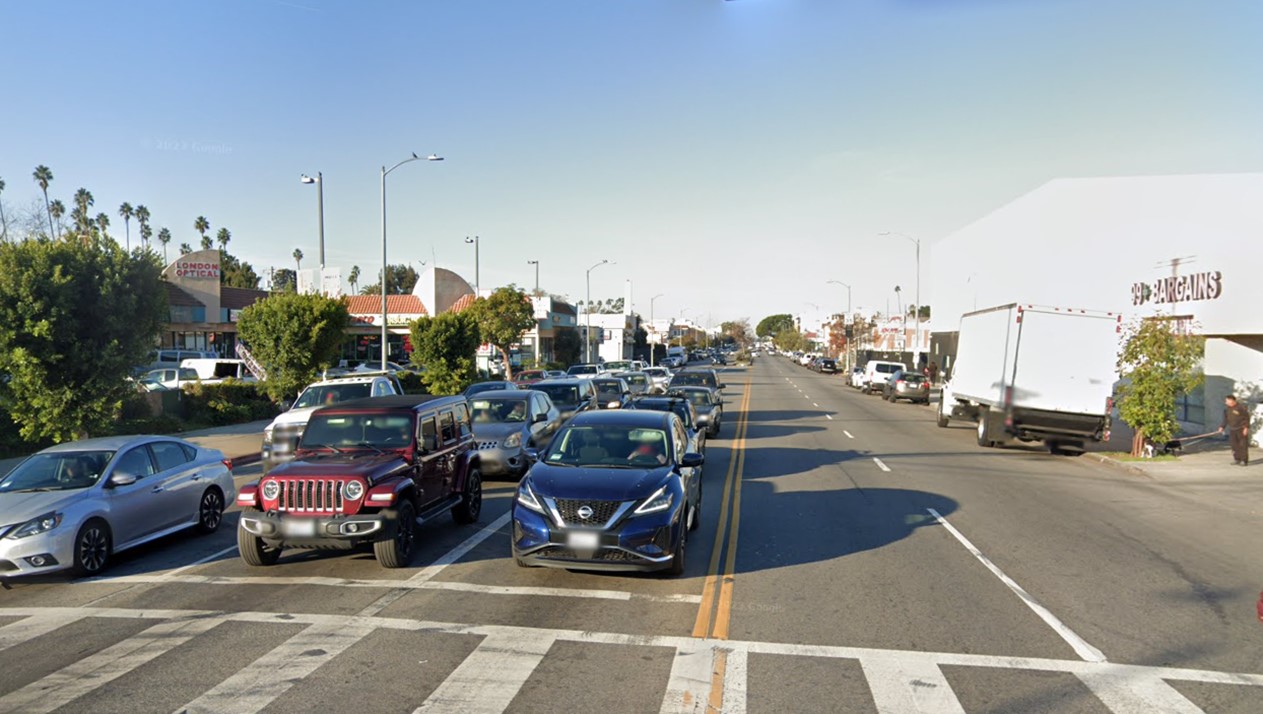 |
|
| (2022)* - Looking west on Washington Boulevard at Western Avenue, showing the location where the Santa Monica Cycle Path once existed. |
| Historical Notes
Despite its early success, the rise of the automobile in the early 20th century led to the decline of dedicated bicycle paths like this one. The Santa Monica Cycle Path eventually fell into disuse as streets were redesigned to serve cars. Even so, it remains an important chapter in Los Angeles transportation history and an early example of dedicated infrastructure for cyclists. |
Then and Now
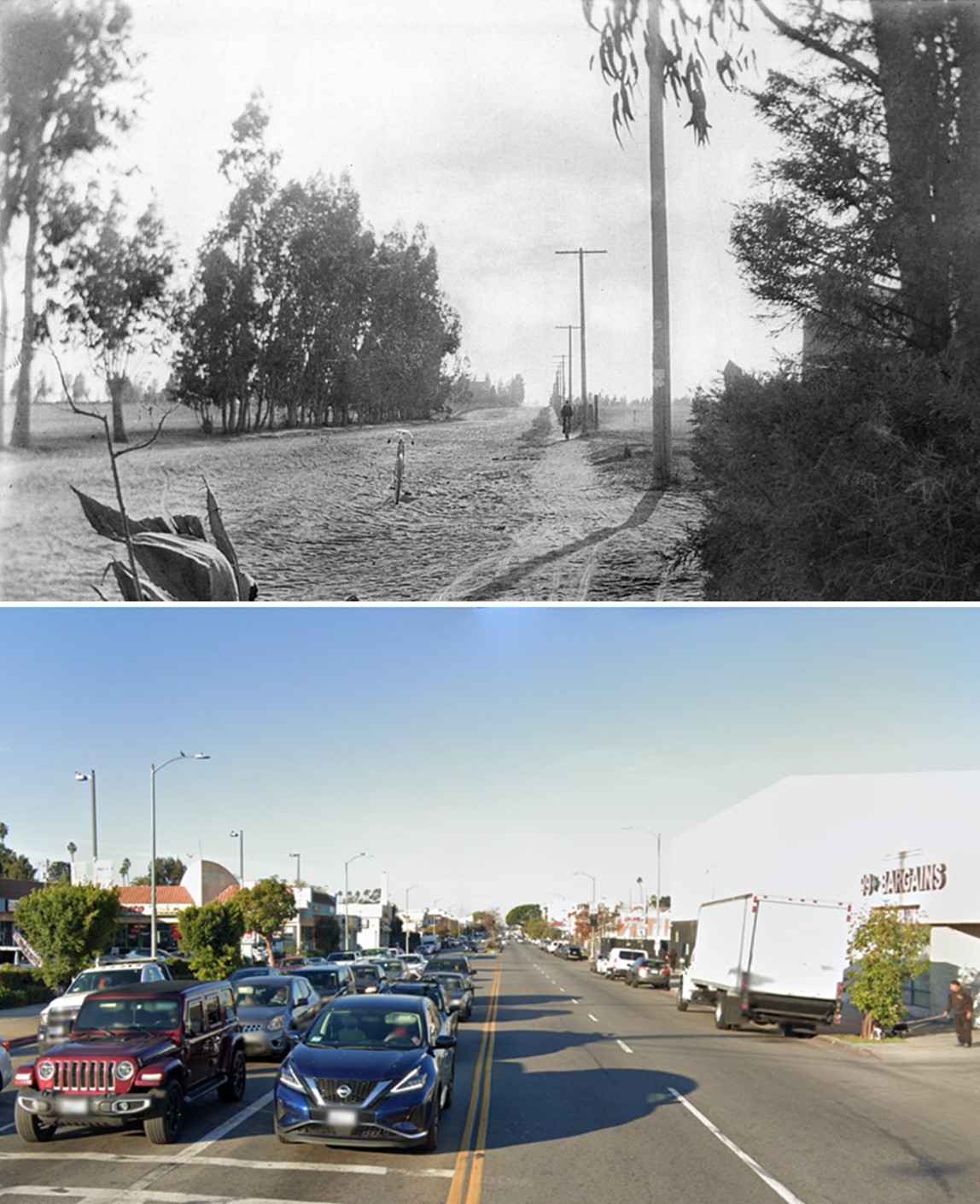 |
|
| (1900 vs 2022)* - Looking west on Washington Boulevard at Western Avenue, showing the location of the Santa Monica Cycle Path. |
| Historical Notes
The Santa Monica Cycle Path, along with the California Cycleway in Pasadena, reflected the cycling boom of the 1890s, when Los Angeles had more than 35,000 cyclists. These projects were early attempts to create dedicated infrastructure for non motorized travel, long before automobiles shaped the region. Although neither project lasted for many years, both remain important chapters in the history of transportation and urban planning in Southern California. |
* * * * * |
Senator Jones Residence (Miramar Hotel)
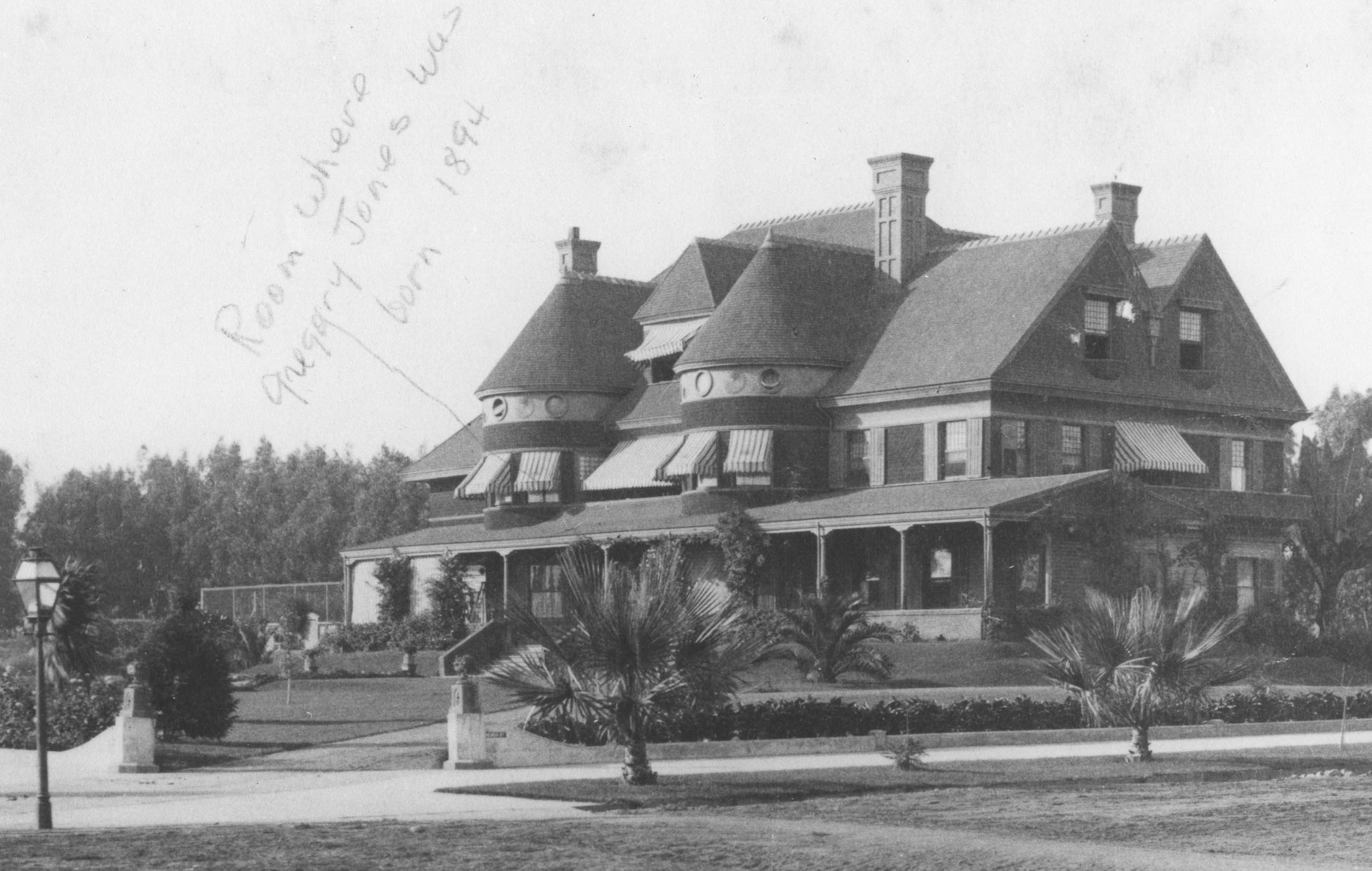 |
|
| (ca. 1890s)* - View of Miramar, the home of Senator John P. Jones and Georgina Frances Sullivan Jones, built in 1889 and located Ocean Avenue and Wilshire Boulevard. Photo is inscribed with an arrow, "Room where Gregory Jones was born 1894." |
Historical Notes Senator Jones built a mansion, Miramar, and his wife Georgina planted a Moreton Bay Fig tree in its front yard in 1889. The tree is now in the courtyard of the Fairmont Miramar Hotel and is the second-largest such tree in California, the largest being the tree in Santa Barbara. |
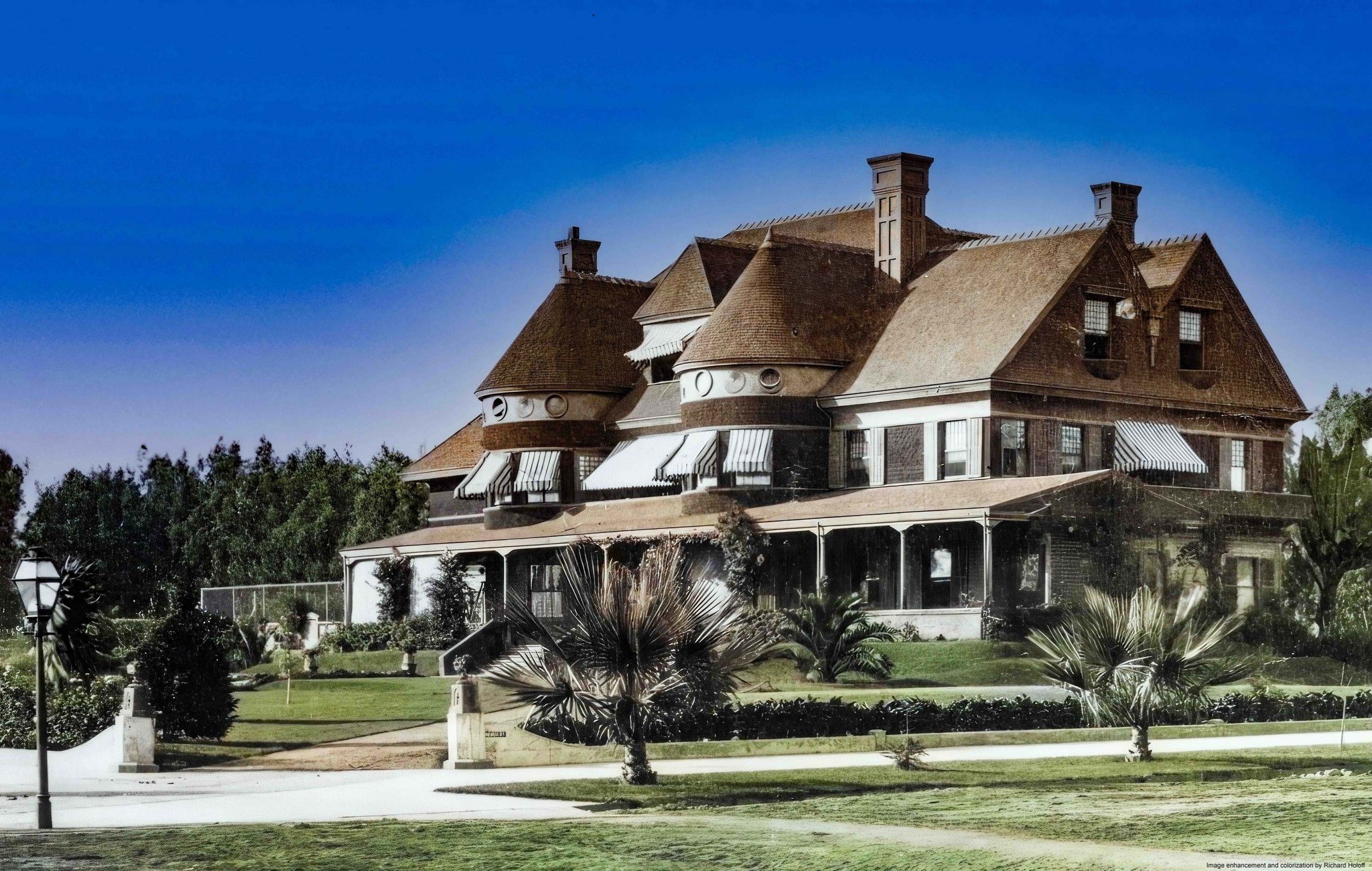 |
|
| (ca. 1890s)* - View of Miramar, the home of Senator John P. Jones and Georgina Frances Sullivan Jones, built in 1889 and located Ocean Avenue and Wilshire Boulevard. Photo is inscribed with an arrow, "Room where Gregory Jones was born 1894." Image enhancement and colorization by Richard Holoff. |
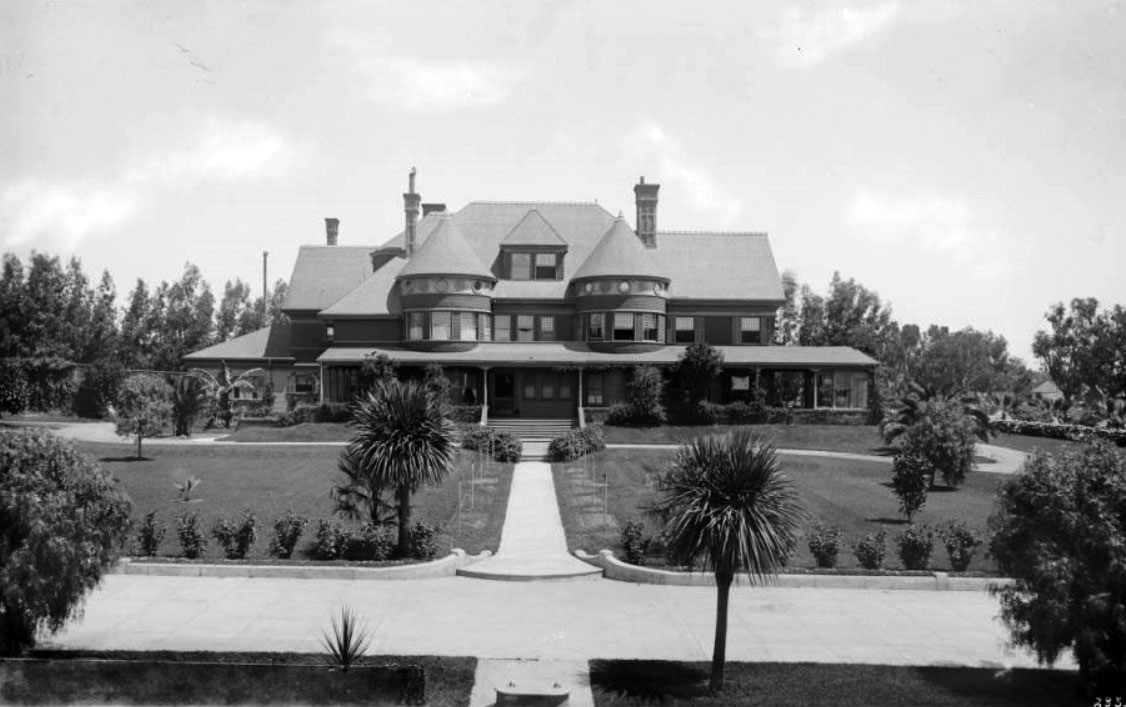 |
|
| (ca. 1890)* - View of Senator Jones residence (later the site of the Miramar Hotel) in Santa Monica showing front lawn across drive. A footpath leads from the drive to the house and is crossed by another path which goes around the house. The house itself has two round turrets in front. |
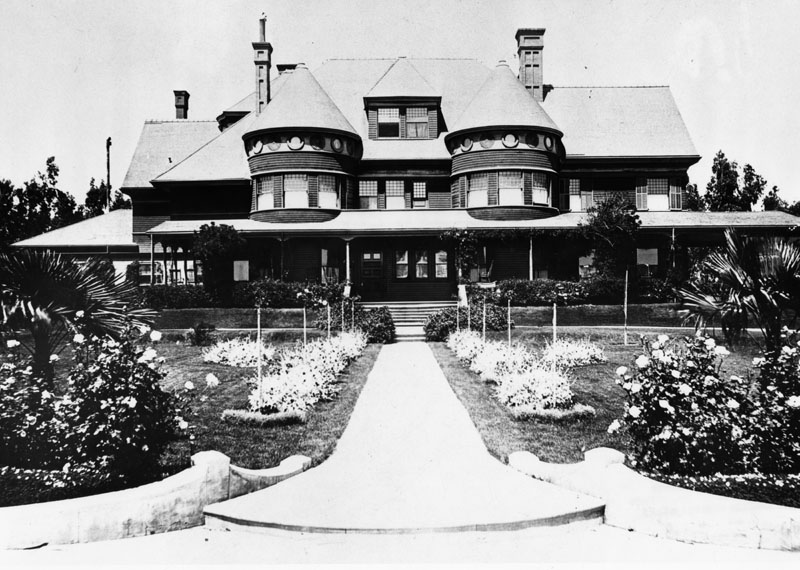 |
|
| (ca. 1890)* - Closer view of Senator John P. Jones' residence on Ocean Avenue. |
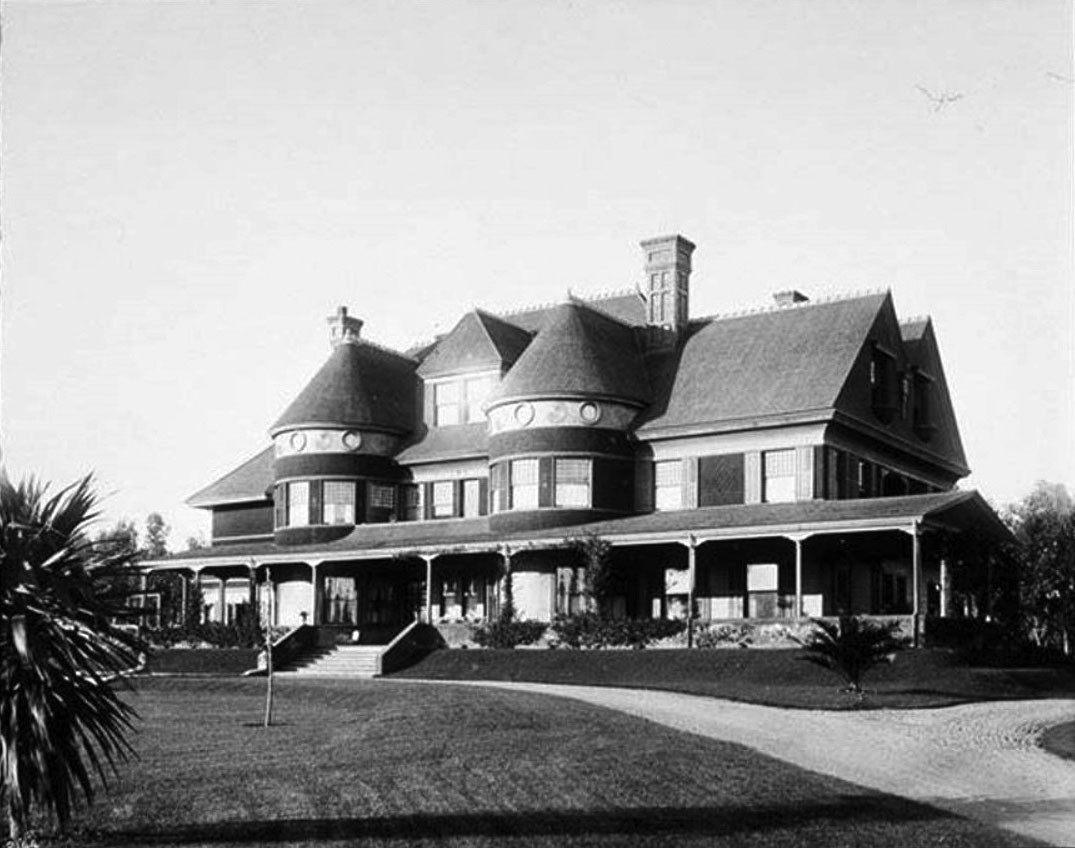 |
|
| (1895)* - Residence of Senator John P. Jones called Miramar on Ocean Avenue. |
| Historical Notes
In 1924 Senator Jones’ mansion became the grand Miramar Hotel |
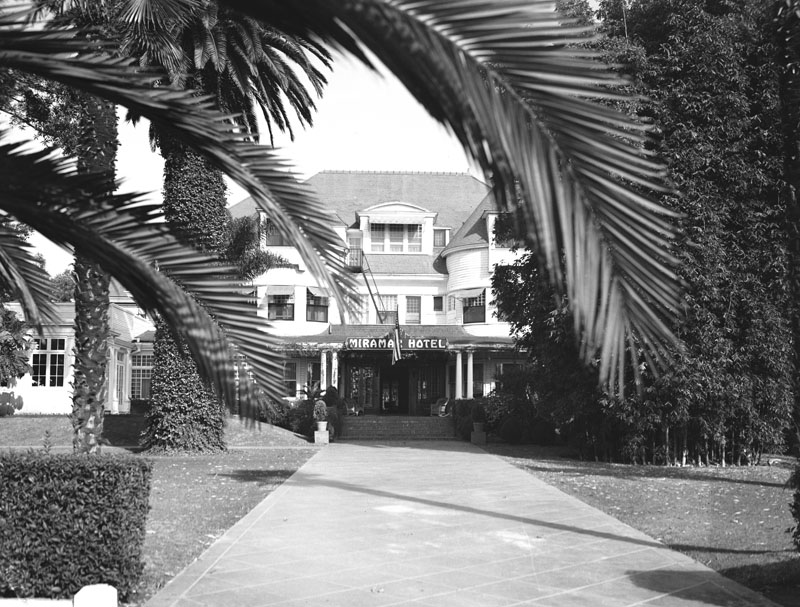 |
|
| (1937)* - Exterior view of the entrance to the Miramar Hotel in Santa Monica, located on the northeast corner of Ocean Park and Wilshire Blvds. It is one of Santa Monica's oldest landmarks, dating back to 1888. |
| Historical Notes
Originally the location of Santa Monica's founding father Senator Jones mansion, the Miramar has provided shelter for rich and famous guests looking for an extended beach stay since the 1920s. Notables include Cary Grant, John F Kennedy, Charles Lindbergh and Eleanor Roosevelt. In 1924 the six-story Palisades Wing was constructed to provide apartments for guests who planned lengthy stays at the beach. Scandinavian beauty Greta Garbo was one of the first celebrity guests to move into the wing and resided there for more than four years. Sultry blonde Jean Harlow rented one of the Miramar's bungalows in the early 1930s, and years later another famous blonde, Marilyn Monroe, frequently retreated to the Miramar when she wanted to disappear from the media. |
* * * * * |
Santa Monica Map
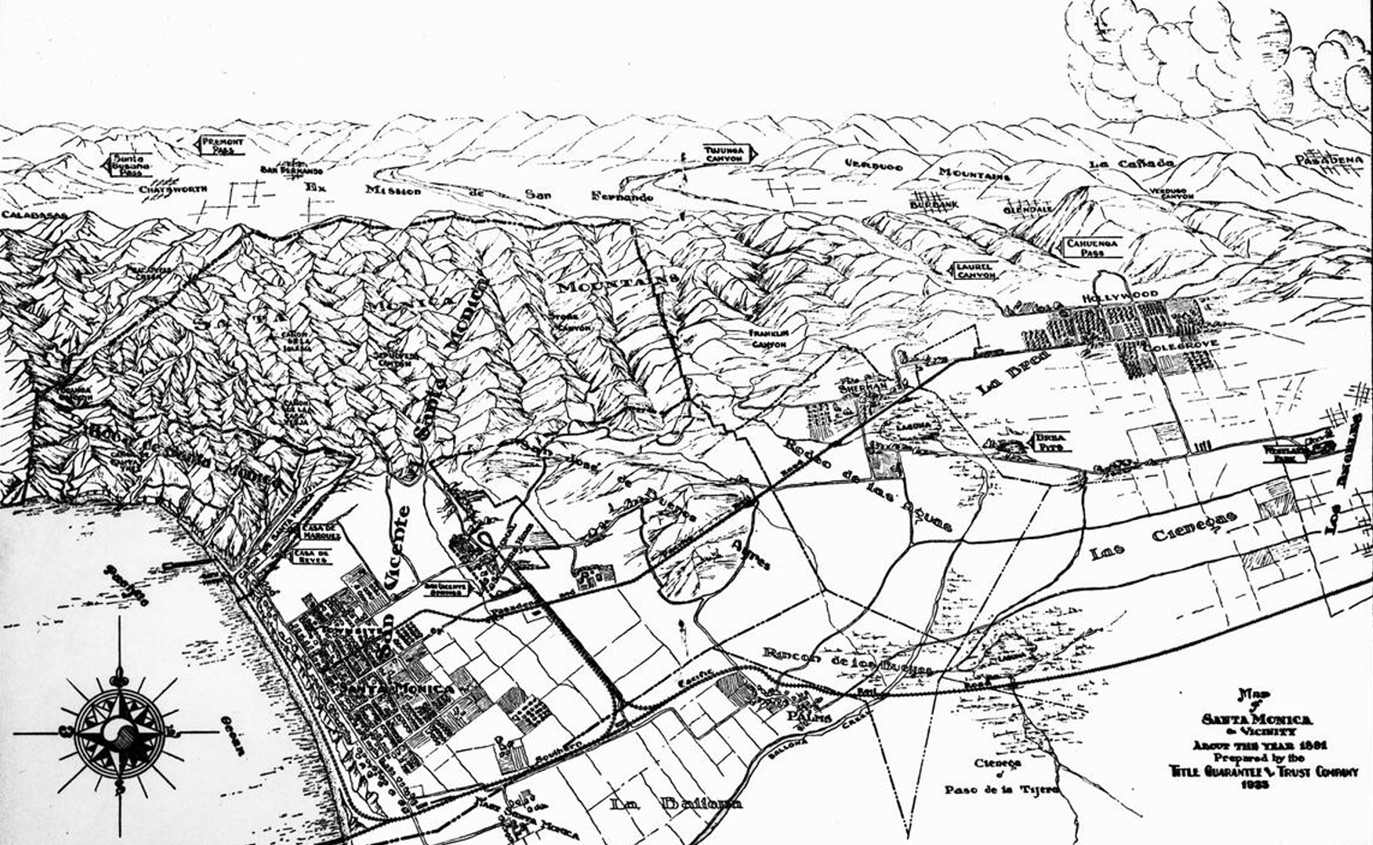 |
|
| (1891)*– Photo of a map of Santa Monica and vicinity as it appeared in 1891. Santa Monica can be seen in the lower left corner, near a small part of the Pacific Ocean. Mountains are visible above Santa Monica, and the city of Los Angeles can be seen in the lower right corner. |
| Historical Notes
The above map was prepared by the Title Guarantee & Trust Company in 1935. Other landmarks on the map include, from left to right, top to bottom: Calabasas, Santa Susana Pass, Chatsworth, Fremont Pass, San Bernardo, El Mission de San Fernando, Tujunga Canyon, Verdugo Mountains, Burbank, Glendale, Laurel Canyon, Cahuenga Pass, La Canada, Verdugo Canyon, Pasadena, Santa Monica Mountains, Sepulveda Canyon, Franklin Canyon, Sherman, Laguna, La Brea, Brea Pits, Hollywood, Colegrove, Bath House, Canon de Santa Monica, Casa de Reyes, Casa de Marquez, Rodeo de las Aguas, Las Cienegas, Westlake Park, Los Angeles, Santa Monica, Rincon de los Bueyos, and La Ballona. |
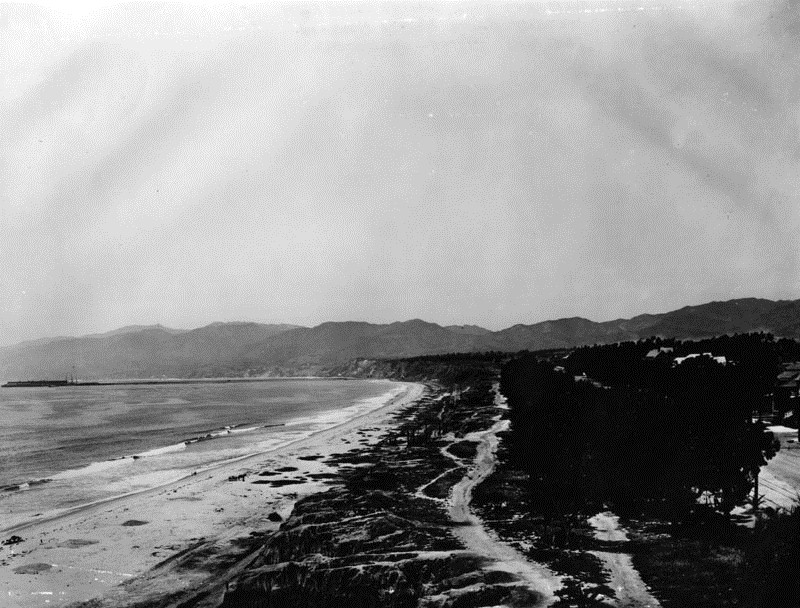 |
|
| (1890s)* - View of Palisades Park in Santa Monica, looking north from present Santa Monica Blvd. On the left is the Santa Monica beach, and the Santa Monica mountains can be seen in the background. The Long Wharf can be seen in the distance. |
* * * * * |
Santa Monica Long Wharf
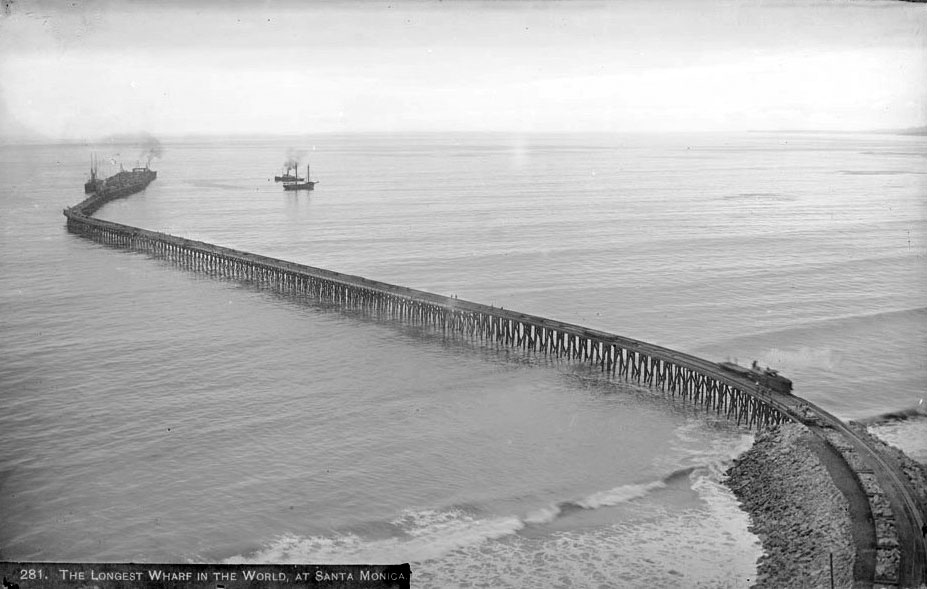 |
|
| (ca. 1893)* - The longest wharf in the world located off Pacific Palisades. A train can be seen close to the shoreline while several ships are seen near the end of the long wharf. |
Historical Notes The Long Wharf, also known as Port Los Angeles or the Mile Long Pier, was constructed between 1892 and 1894 by the Southern Pacific Railroad Company just north of Santa Monica Canyon. At nearly a mile in length, it was the longest wooden pier in the world at the time. The wharf was built to serve as a deep-water port for the Los Angeles region, addressing the area’s lack of a natural harbor and facilitating the transfer of goods and passengers between ships and railroads. |
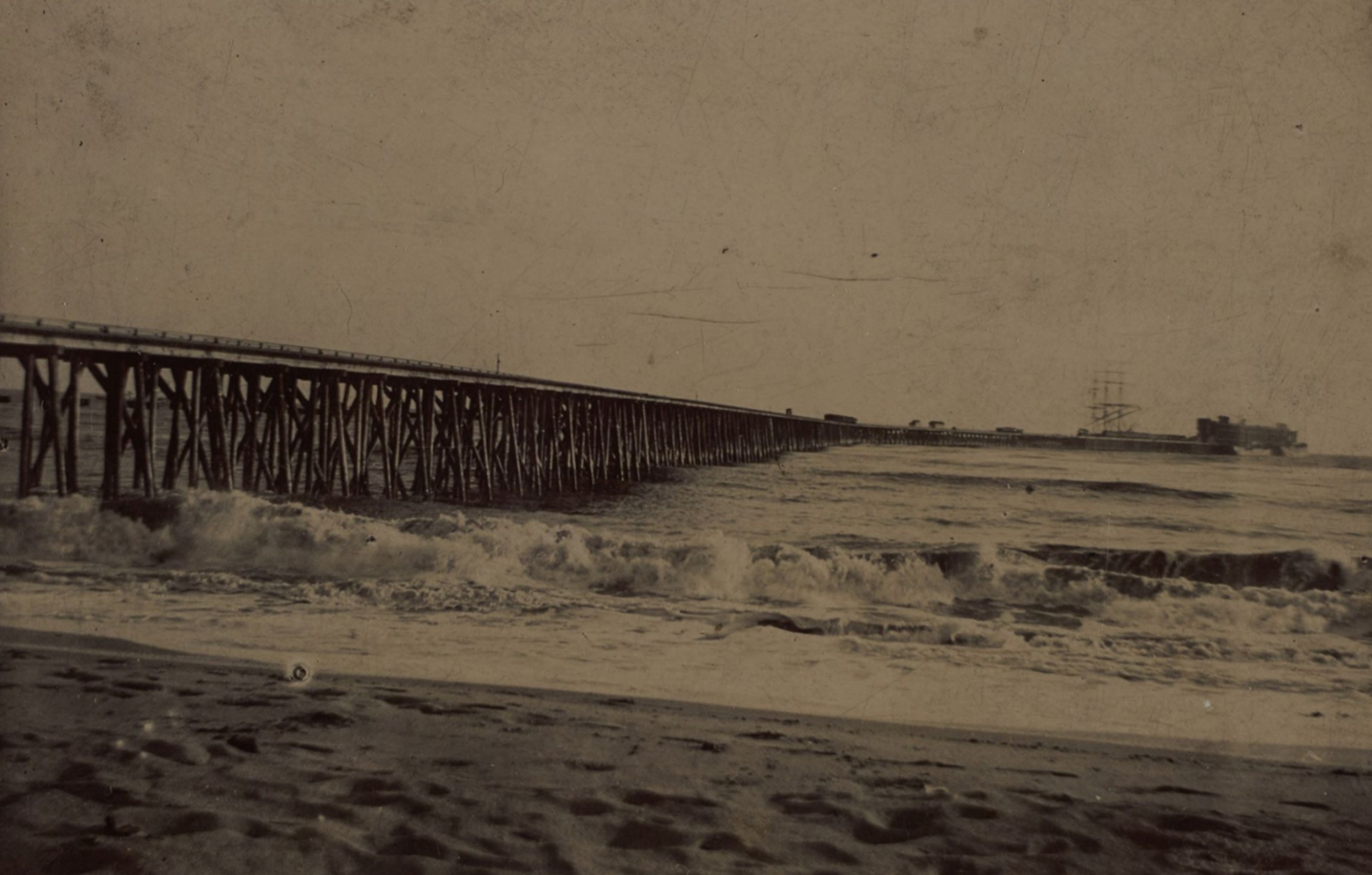 |
|
| (1893)* – A rare view of the Long Wharf from the beach! Surf crashes in the foreground as a tall ship waits at the end of the 4,600-foot wharf, once planned to be the official Port of Los Angeles. Built by the Southern Pacific Railroad, it stretched nearly a mile into the ocean—an ambitious vision that soon gave way to San Pedro. Photo by C. M. Young from the Ernest Marquez Collection. |
Historical Notes The Long Wharf, also known as the Santa Monica Wharf, was constructed in 1893 by the Southern Pacific Railroad as part of an ambitious plan to establish a deep-water port for Los Angeles at Santa Monica. Stretching 4,600 feet into the Pacific Ocean, it was the longest wooden pier in the world at the time. Southern Pacific sought to control the region’s shipping access and bypass the shallow, undeveloped port at San Pedro. The wharf allowed cargo ships to dock directly offshore and transfer goods to waiting trains. However, political pressure—led by the "Free Harbor Fight" and backed by the federal government—ultimately favored San Pedro, which became the official Port of Los Angeles in 1897, rendering the Long Wharf obsolete within just a few years. |
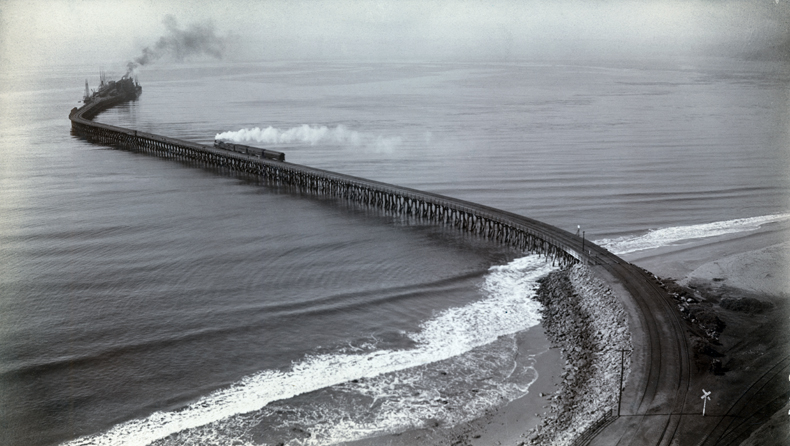 |
|
| (ca. 1893)* - Aerial view of the Southern Pacific Mammoth Wharf, Port Los Angeles, Calif. The wharf was also known as the old Santa Monica Long Wharf, north of Canyon. A white cloud of smoke can be seen from a train travelling on the tracks to the business end, at the end of the wharf. |
Historical Notes The wharf’s construction was part of a larger vision by railroad magnate Collis P. Huntington and Nevada Senator John P. Jones, who hoped to make Santa Monica Bay the principal port of Los Angeles. With double railroad tracks running its length, the Long Wharf quickly became a bustling hub for lumber and other imports essential to Southern California’s rapid development. Its impressive size and modern facilities made it a symbol of the region’s ambitions. |
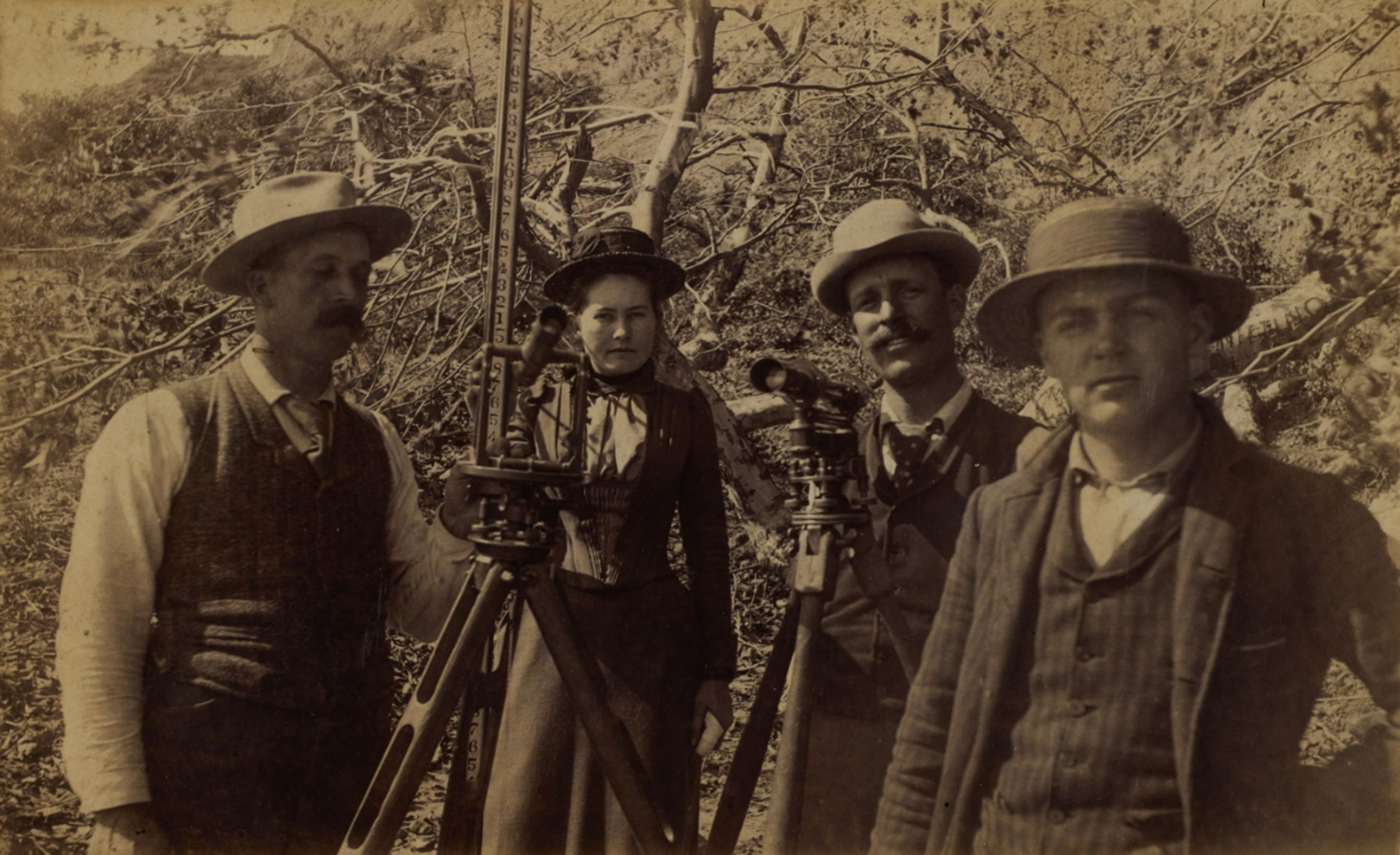 |
|
| (ca. 1892–1894)* – Surveyors planning the Long Wharf in Santa Monica. Photo from the Ernest Marquez Collection. |
Historical Notes Pictured with surveying instruments during the early planning of the Long Wharf in Santa Monica are (left to right): Fred Strichfield, Edna Orr (later Nellie Coffman of Desert Inn fame), Mr. Donovan, and Casper Tyler. The Long Wharf—built between 1892 and 1894—was once the longest pier in the world. This rare image captures a young Edna Orr before her rise as a pioneering figure in Palm Springs hospitality. Nellie Coffman (1867–1950), née Edna Beatrice Orr, was a pioneering hotelier who helped transform Palm Springs into a premier desert resort. After moving there in 1909 for her husband’s health, she opened a modest boarding house that grew into the famed Desert Inn. Known for her high standards and charm, “The Duchess of Palm Springs” attracted celebrities, dignitaries, and investors, shaping the city’s early identity as an upscale retreat. She managed the Inn until shortly before her death in 1950, leaving a lasting legacy in the region. |
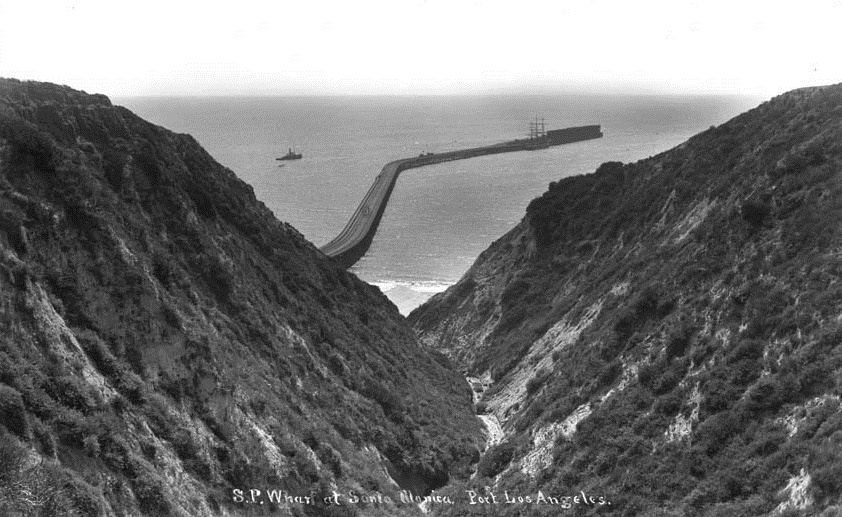 |
|
| (1895)* - View through the coastal canyon at the Long Wharf in Santa Monica, which was referred to as “Port Los Angeles” during the 1890s by the Southern Pacific Railroad. |
Historical Notes Also referred to as “Port Los Angeles” during the 1890s, the Long Wharf was promoted by the Southern Pacific Railroad as the region’s future deep-water harbor. Stretching over 4,700 feet into the bay, it was the longest pier in the world at the time. |
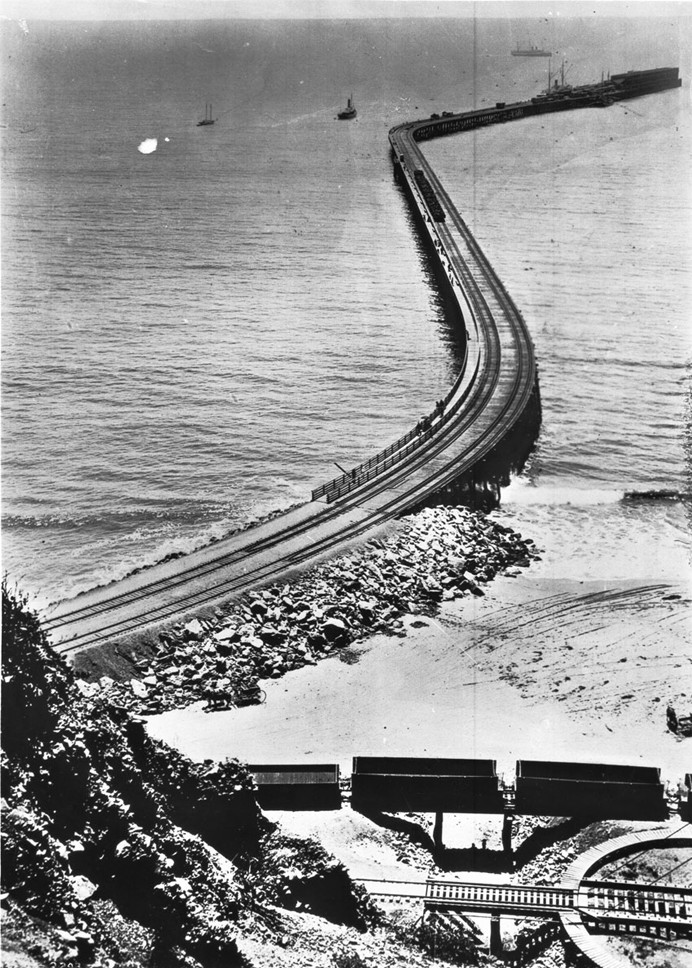 |
|
| (1893)* - View of the entire length of the Long Wharf from the beach all the way to its extremity almost a mile away. Note the RR turntable in the lower right corner. A horse-drawn carriage can be seen on the beach between the rail cars and the wharf. Empty railcars sit on a bridge over a gully. |
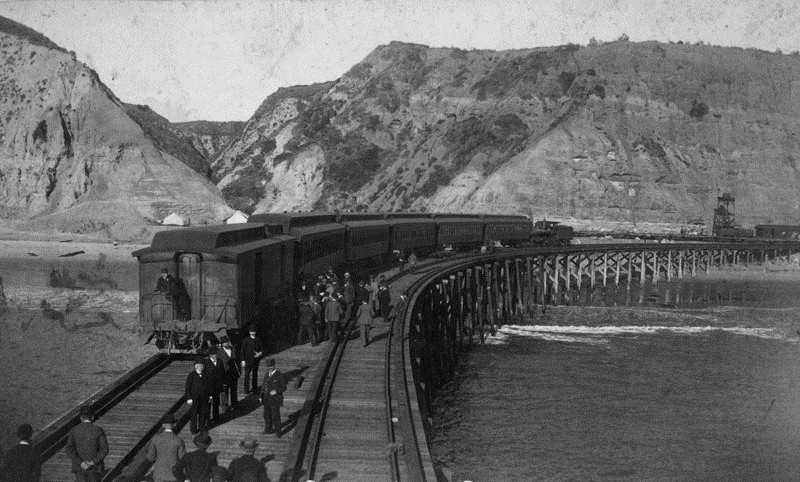 |
|
| (ca. 1890s)* - Southern Pacific Mammoth Wharf, built in 1893. Well dressed men are seen standing near a train on the 4700 foot-long wharf. |
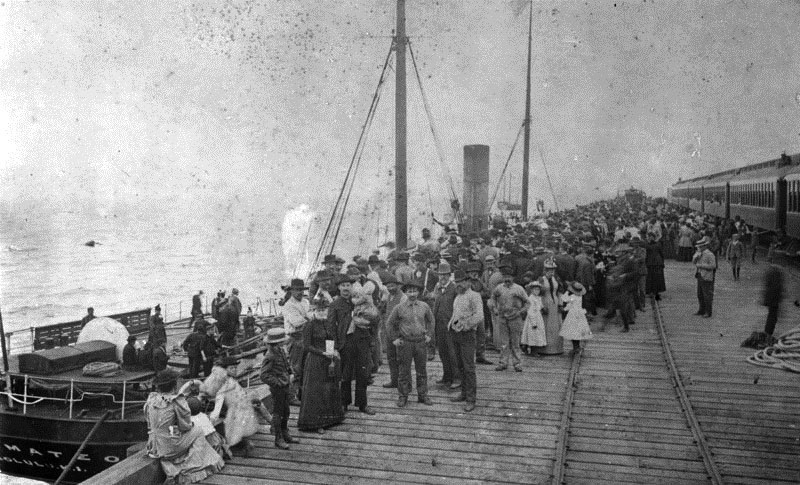 |
|
| (1893)* - This photograph shows the arrival of the first steamer at the Southern Pacific wharf. |
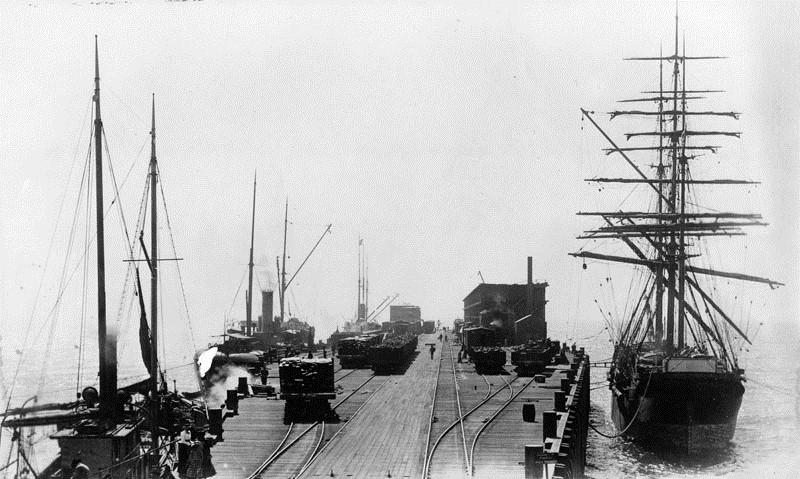 |
|
| (1898)* - Photo shows the business end of the mammoth wharf in Santa Monica. Several fully loaded railcars can be seen. |
Historical Notes The Long Wharf’s prominence was short-lived due to intense political and commercial rivalry known as the "Free Harbor Fight." Huntington and Jones used their influence to delay federal investment in San Pedro Bay, advocating instead for a breakwater and port facilities at Santa Monica. However, local business interests, led by Los Angeles Times publisher Harrison Gray Otis and U.S. Senator Stephen White, lobbied for San Pedro. In 1897, a federal commission led by Rear Admiral John Grimes Walker selected San Pedro Bay as the official site for the Port of Los Angeles, ending Santa Monica’s bid. |
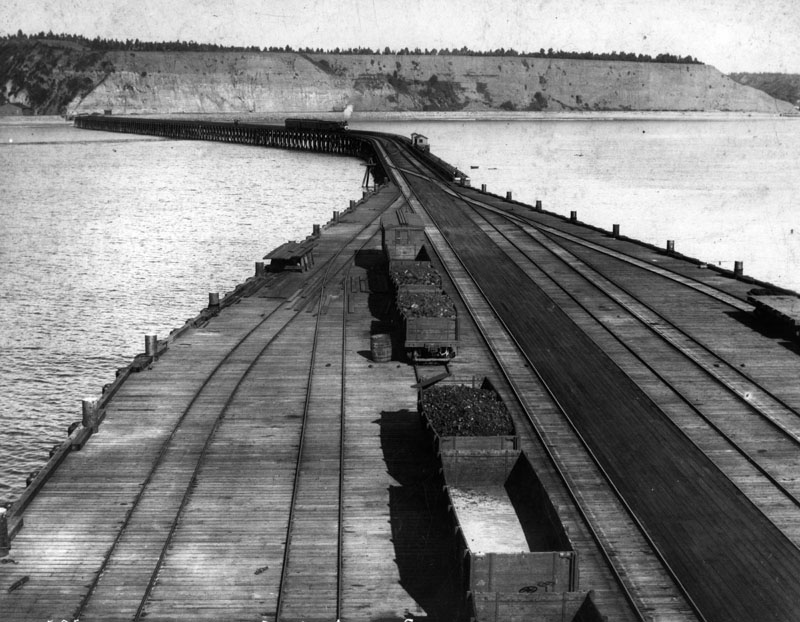 |
|
| (ca. 1893)* - Southern Pacific wharf, 4700 feet long, for the projected Port of Los Angeles. View is from the end of the wharf towards the shore. A train is seen heading toward to end of the wharf. |
Historical Notes With San Pedro’s selection and subsequent harbor improvements, shipping traffic shifted away from the Long Wharf. The wharf ceased major shipping operations by 1913, and demolition began soon after. By 1919, the tip of the pier was removed, and the remaining structure was used as a fishing pier until its complete removal in 1933. Today, no physical trace remains, but a California Historical Landmark plaque marks the site at Will Rogers State Beach in Pacific Palisades. |
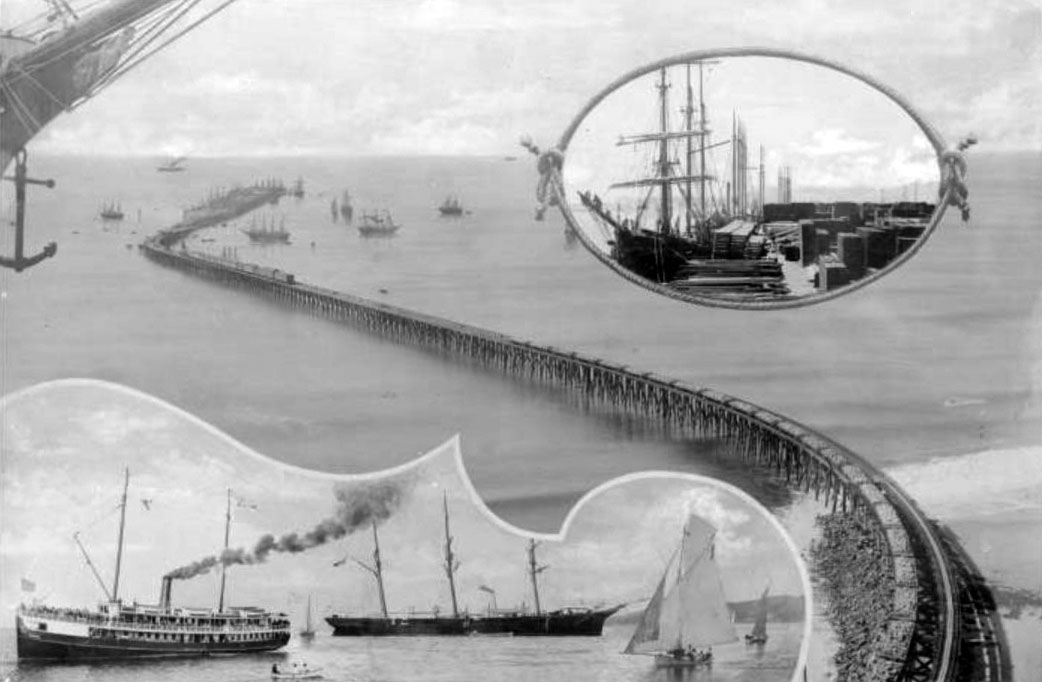 |
|
| (1894)* - A composite image showing 4 areas of the Southern Pacific Railroad Long Wharf: the wharf extending from the coast to its terminus in the ocean, ships surround the terminus and a train is visible on the tracks (middle of image); close-up of ship's prow showing anchor and figurehead of a half-nude woman (upper left); encircled by a doubly knotted rope is a docked sailing ship, on the dock are piles of dry goods (upper right); close-ups of 2 large ships (sailboat & steamer) and several smaller sailboats (lower left). |
Historical Notes n 1897, San Pedro Bay, now known as the Port of Los Angeles, was selected by the United States Congress to be the official port of Los Angeles (Port of Los Angeles) over Santa Monica. Still, the Long Wharf acted as the major port of call for Los Angeles until 1903. Though the final decision disappointed the city's residents, the selection allowed Santa Monica to maintain its scenic charm. The rail line down to Santa Monica Canyon was sold to the Pacific Electric Railway, and was in use from 1891 to 1933. Click HERE to see more in Early Views of San Pedro and Wilmington. |
 |
|
| (ca. 1911)* – Los Angeles Pacific streetcar no. 235 on the Santa Monica Long Wharf. Four men pose in front, two in uniform, with coastal cliffs visible behind—a rare view of early electric rail travel at the edge of the Pacific. Before being absorbed into the Pacific Electric system later that year, the Los Angeles Pacific Railroad operated passenger service out onto the former Southern Pacific freight wharf, once touted as “the only ocean voyage on wheels.” Tourists marveled at the novelty of riding a streetcar over open water along what was briefly the world’s longest pier. Photo from the Ernest Marquez Collection. |
Historical Notes Tourists marveled at riding streetcars out over the ocean on the old freight wharf, promoted as “the only ocean voyage on wheels.” When Pacific Electric absorbed LAP in 1911, the line was operated as the Santa Monica Canyon Local or Port Los Angeles Line, but its function remained recreational rather than practical transit. Passenger service continued on a diminishing basis, with cutbacks in the 1920s as the wharf deteriorated and automobile tourism supplanted the red cars. By the early 1930s, only a token daily shuttle remained, and the line was formally abandoned in 1933. The last remnants of the Long Wharf were demolished that same year. Though short-lived and lightly used, the line had a notable impact on regional tourism and helped shape Santa Monica’s identity as a beach resort instead of a shipping port. |
* * * * * |
Japanese Fishing Village
 |
|
| (ca. 1915)* - Japanese fishing village north of the Long Wharf, approximately ¼ mile from Santa Monica Canyon and near today's Will Rogers State Beach. Visible on the pier are the utility poles used by the electric streetcar line—originally operated by Los Angeles Pacific Railway (LAP) and taken over by Pacific Electric in 1911. Photo by Charles C. Pierce. |
Historical Notes In the late 19th and early 20th centuries, a Japanese fishing village known as Maikura was established at the foot of the Long Wharf in what is now Pacific Palisades, just north of Santa Monica Canyon. The settlement took root around 1899, led by Issei (first-generation Japanese immigrants) such as Hatsuji Sano, who were drawn to the area for its rich fishing grounds and proximity to the enormous, soon-abandoned wharf built by the Southern Pacific Railroad in 1893 as part of an unsuccessful attempt to establish Port Los Angeles. |
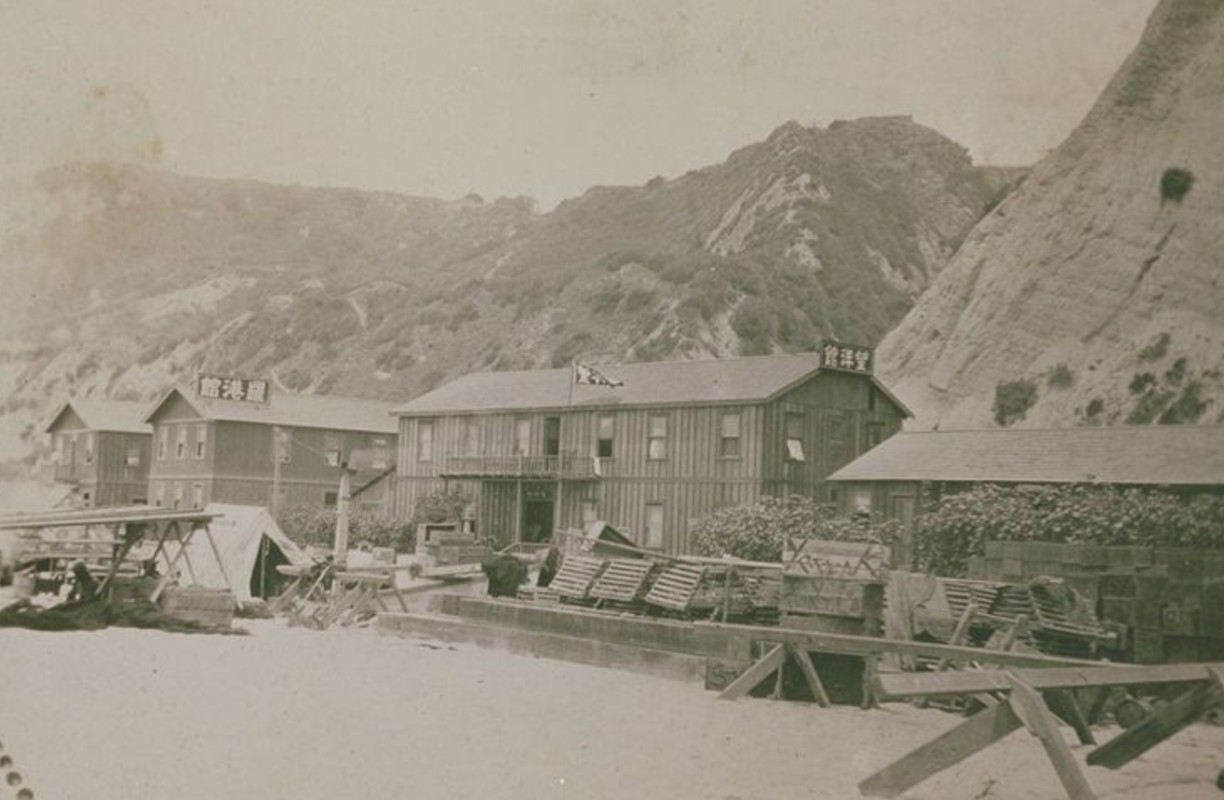 |
|
| (1910s)* - Japanese fishing village located at the foot the Long Wharf north of Santa Monica Canyon. |
Historical Notes Fishing was the foundation of the local economy. Japanese fishermen supplied fresh seafood to Japanese communities in Los Angeles and Santa Monica, while others opened seafood shops and related businesses inland. The Long Wharf and the village’s seaside location also drew day visitors from the city, many of whom came to fish, dine, or enjoy the beach. The mix of hard work and cultural continuity gave the village a uniquely communal and industrious character. |
 |
|
| (ca. 1915)* – View showing a Japanese fishing village along the old Beach Road just north of the Long Wharf in Pacific Palisades. |
Historical Notes By 1910, Maikura had grown into a small but vibrant community of about 50 residents—two-thirds Japanese and one-third Russian. As the years went on, the population swelled to nearly 300 people. Families built modest homes along the beach and up Temescal Canyon’s coastal shelf, constructing their own roads, laying down power and gas lines, and opening businesses such as small hotels and restaurants. The residents rebuilt after storms and setbacks, forming a self-sufficient, resilient community. |
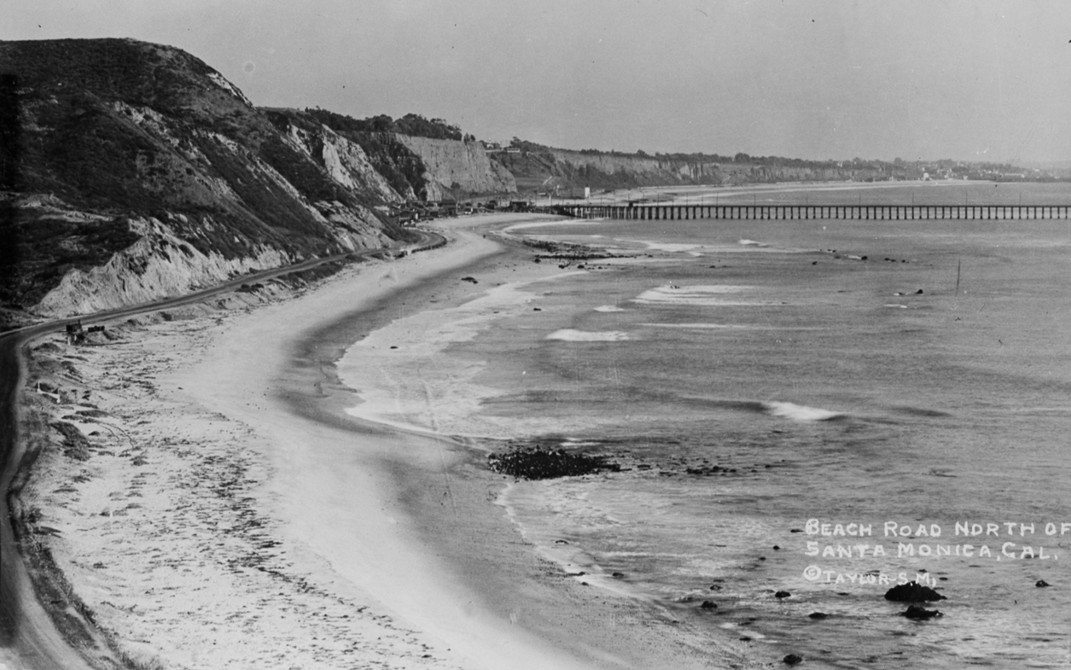 |
|
| (ca. 1916)* - Beach Road looking south toward the Long Wharf of Santa Monica (in present-day Pacific Palisades), with the Japanese fishing village visible at the foot of the wharf. The Santa Monica Canyon Beach House can be seen at the mouth of the canyon beyond the wharf, with the beaches of Santa Monica and the bluffs farther south. |
Historical Notes Despite its coastal isolation, the Maikura community maintained strong cultural and social ties with other Japanese neighborhoods, especially Little Tokyo and Sawtelle. Villagers participated in religious observances, sporting events, and social gatherings in those areas. The community’s character was often compared to the better-known Japanese enclave on Terminal Island—tight-knit, industrious, and proudly self-reliant. |
 |
|
| (ca. 1916)* - Panoramic view looking south along the beach toward the Long Wharf. A collection of beach huts can be seen on the left which were part of a Japanese fishing village. To the right, the ocean surf can be seen lapping at the shore, with the Long Wharf extending out to deeper water. |
Historical Notes By the early 1910s, the land had been annexed by Los Angeles County and fell under the control of developer Robert Gillis. Gillis sought to turn the coastal region into a whites-only, affluent suburb. Using the excuse of substandard sanitation infrastructure, he orchestrated the removal of the Japanese community. By 1916, the village was razed and the Long Wharf dismantled. Many former residents relocated to Terminal Island or to Santa Monica, where they shifted into farming, labor, and trades. The Maikura fishing village was one of over 40 Japanese communities in California that ultimately vanished—many during or after World War II. Though short-lived, its legacy is significant. It stands as a testament to the contributions of early Japanese immigrants to the Los Angeles region and the broader patterns of exclusion and forced removal that shaped Southern California's urban and cultural history. |
* * * * * |
Santa Monica Canyon
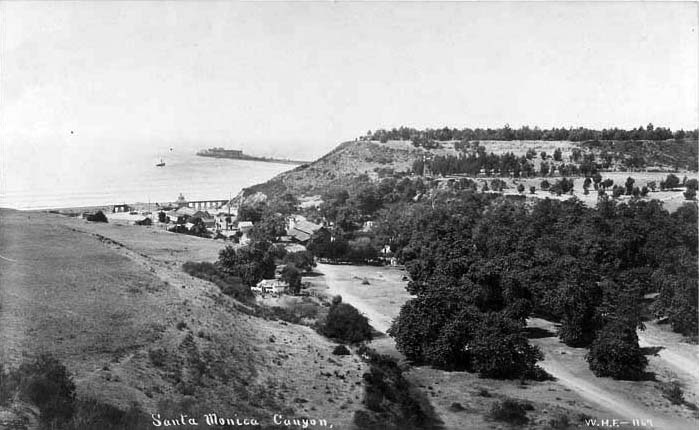 |
|
| (1890s)* - View from the hills looking toward the mouth of the Santa Monica Canyons. The Long Wharf can be seen in the distance. |
Historical Notes CThe Santa Monica Canyon area was experiencing a land boom during the late 1880’s attracting tycoons (either actual or potential) of every industry. One such industrious man was Abbot Kinney who opened the first forestry station in the adjacent Rustic Canyon in 1887. One of his objectives was to test trees, primarily eucalyptus, as cash crops. On 247 acres of land Kinney began planting trees. Despite the success of the trees, it was clear they were not an effective cash crop and Kinney soon sold the property. Notwithstanding a devastating fire in 1904, many of the trees survived creating the plentiful and beautiful eucalyptus groves in Rustic Canyon today. A plaque was dedicated on August 18, 1971, officially designating the eucalyptus groves as a California State Historical Landmark. Click HERE to see more California HIstorical Landmarks. |
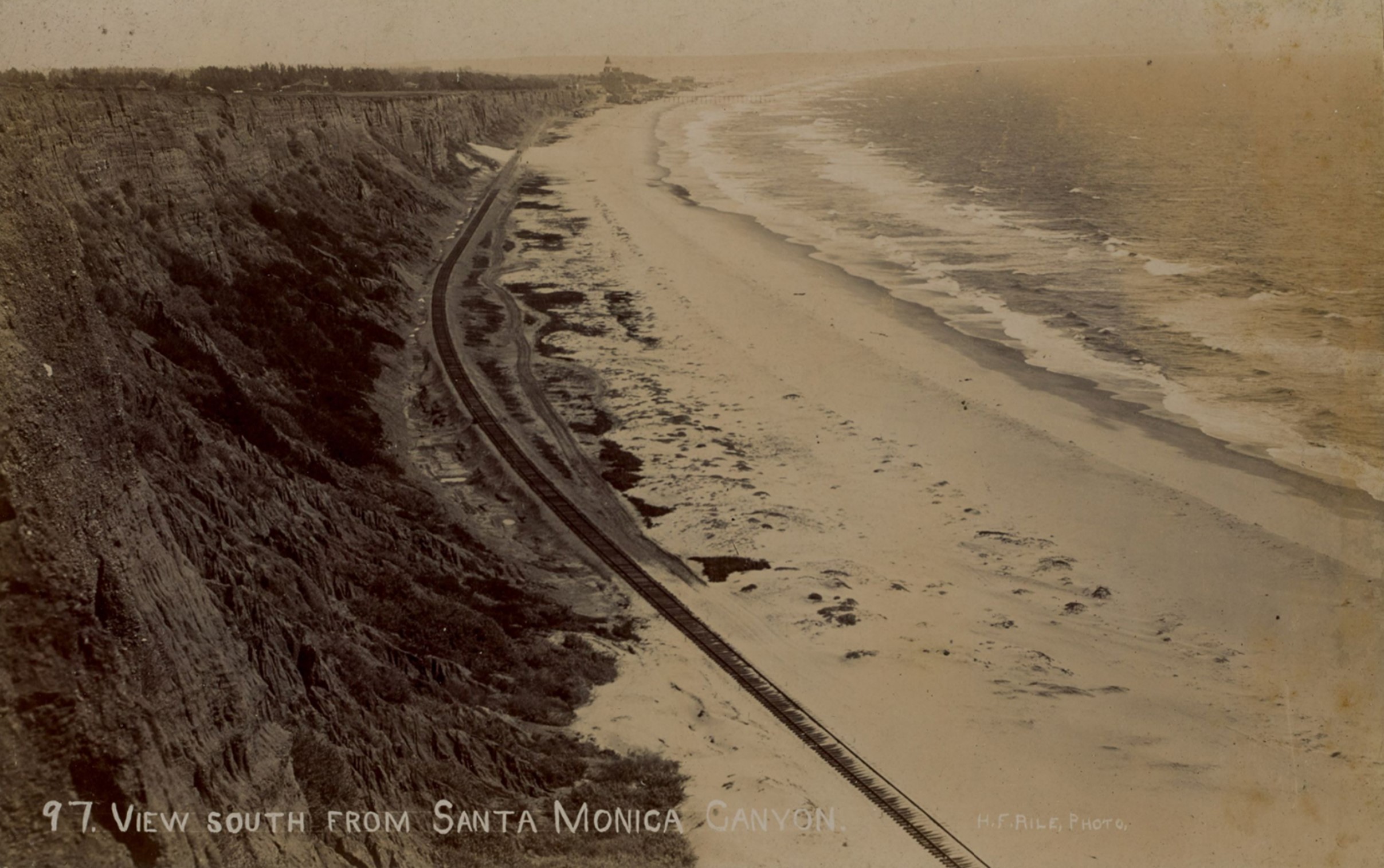 |
|
| (ca. 1892)* - Image of the cliffs and beach looking south from Santa Monica Canyon with the Arcadia Hotel in distance, and the Southern Pacific Railroad tracks running next to the Beach Road. The remains of the Los Angeles and Independence Wharf are visible at upper right center of image. Photo from the Ernest Marquez Collection. |
Historical Notes Because of the construction of the nearby Long Wharf, a railroad was built right by the mouth of the Santa Monica Canyon. The area now became accessible to hundreds of people. Traveling characters enjoyed days of croquet, horseback riding, and, of course, bathing. |
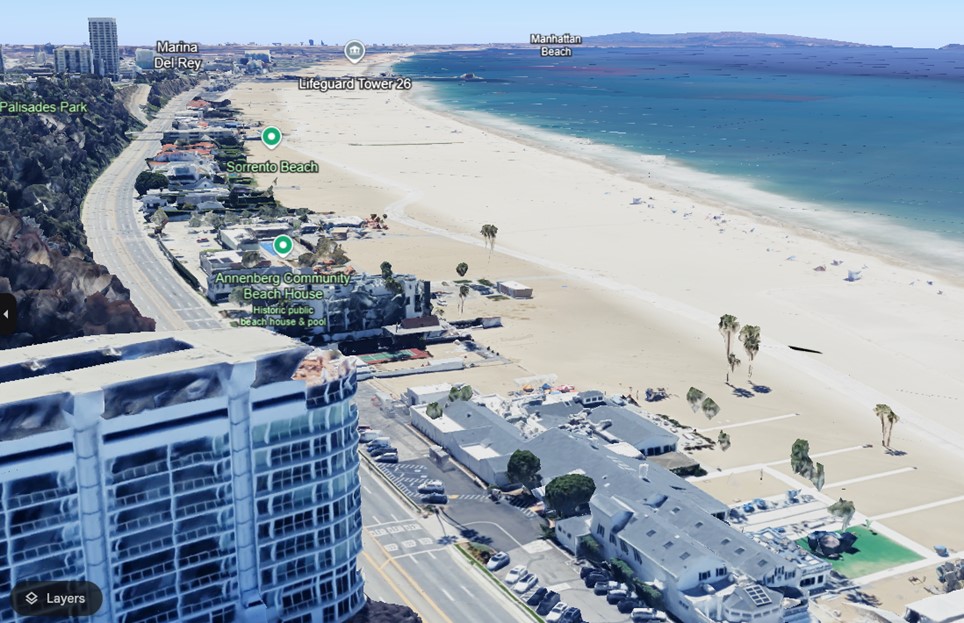 |
|
| (2023)* - Google Earth view looking south from near the Santa Monica Canyon from a slightly different angle than the previous photo. |
Historical Notes The increased sand on Santa Monica Beach compared to 100 years ago is largely due to human intervention, particularly through beach nourishment projects. Over the past century, efforts have been made to widen and enhance the beach to boost tourism and recreation. Key factors include the artificial widening of the beach by adding approximately 30 million cubic yards of sand, sourced from infrastructure projects and dredging operations, and the desire to make Santa Monica Beach resemble wider, flatter East Coast beaches. In 1947, for example, nearly 14 million cubic yards of sand were removed to make way for El Segundo's Hyperion power plant. They were deposited onto Santa Monica's beaches. Another million cubic yards came a couple years later, the sand this time recovered from dredging operations along a nearby breakwater. In all, some thirty million cubic yards of sand have been dumped onto the beaches of Santa Monica and Venice. |
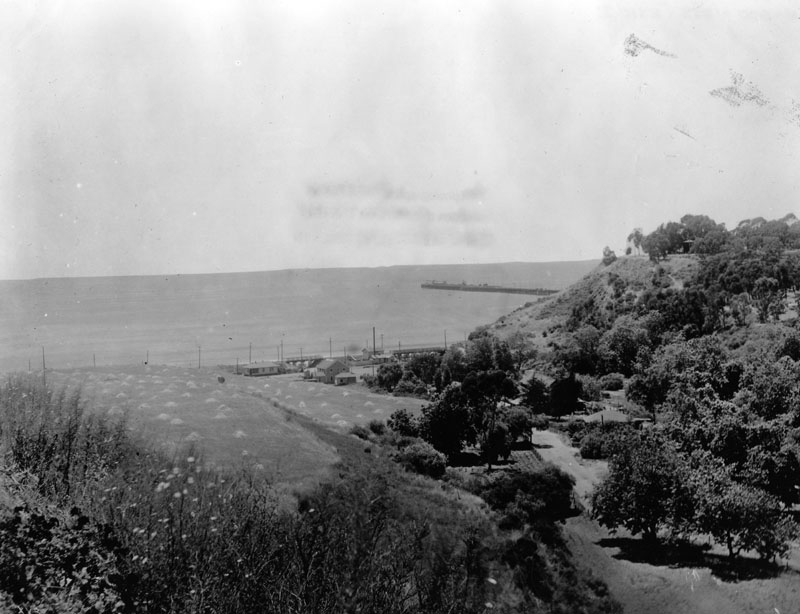 |
|
| (1910)* - View of the mouth of the Santa Monica Canyon with ocean and the Long Wharf in the background. |
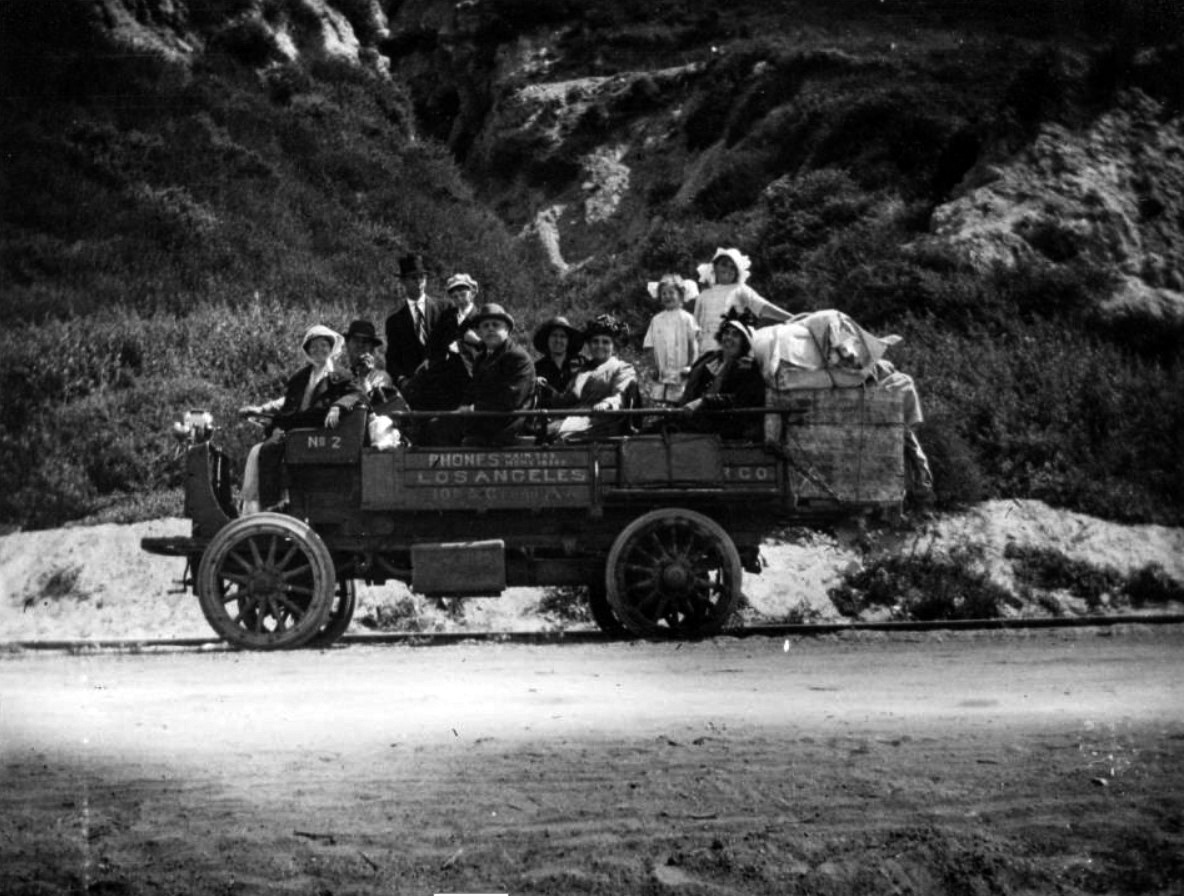 |
|
| (1914)* - View showing an open-air truck filled with men, women and children with cargo strapped to the back of the vehicle and heading for the Port of Los Angeles (Long Wharf) in present-day Pacific Palisades. The truck is running on or near the tracks. |
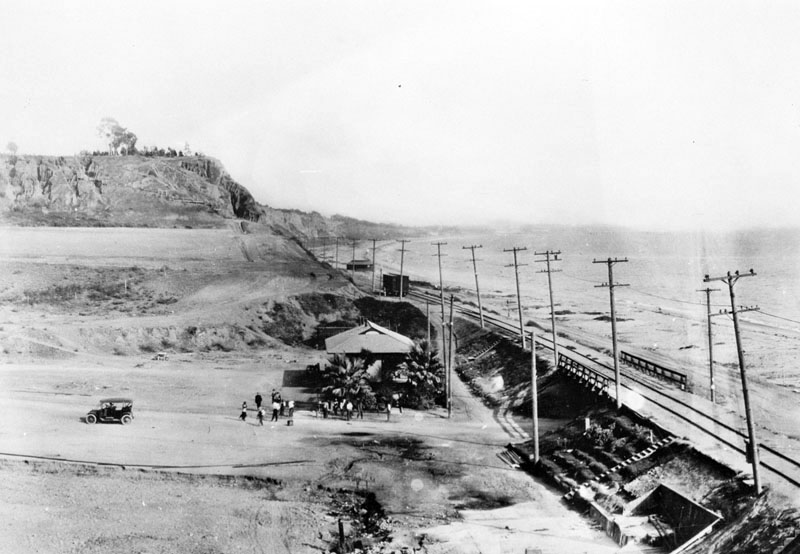 |
|
| (ca. 1910)* - View of Santa Monica Canyon looking south from the north side of the canyon mouth. Several people are seen standing in front of the railroad depot as a car appears to be pulling away. On the right, a railroad bridge crosses the canyon near the water. The bluff at left distance later became picnic grounds. |
Historical Notes The railroad depot seen in the above photo is still standing today. The original 1890’s structure is the entrance to Patrick’s Roadhouse Restaurant, 106 Entrada Drive. The lunch counter and booth area of the restaurant appear to be the original fixtures as well. |
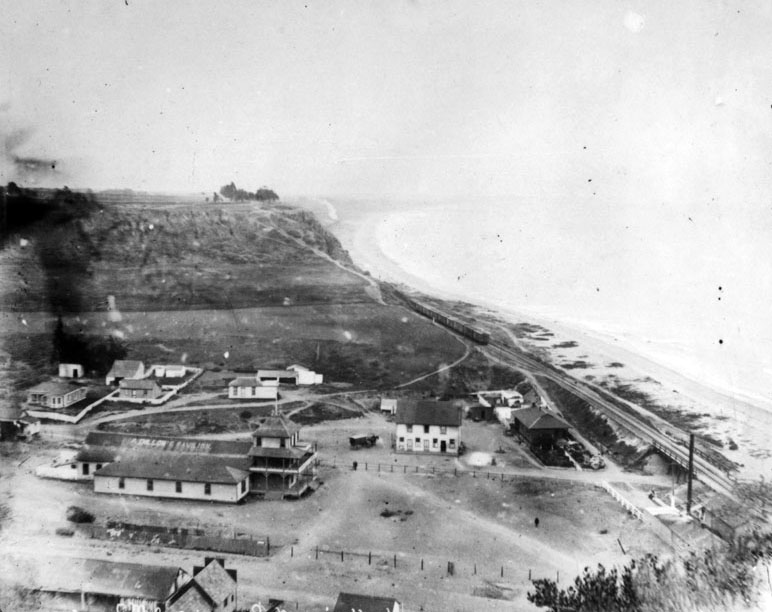 |
|
| (ca. 1910)* - View looking souh from the bluffs overlooking the mouth of Santa Monica Canyon. A train can be seen on the tracks. |
Historical Notes After San Pedro Bay was selected over the Long Wharf as the location of the new Los Angeles Harbor, the rail line down to Santa Monica Canyon was sold by Southern Pacific Railroad to the Pacific Electric Railway. The track was in use from 1891 to 1933. |
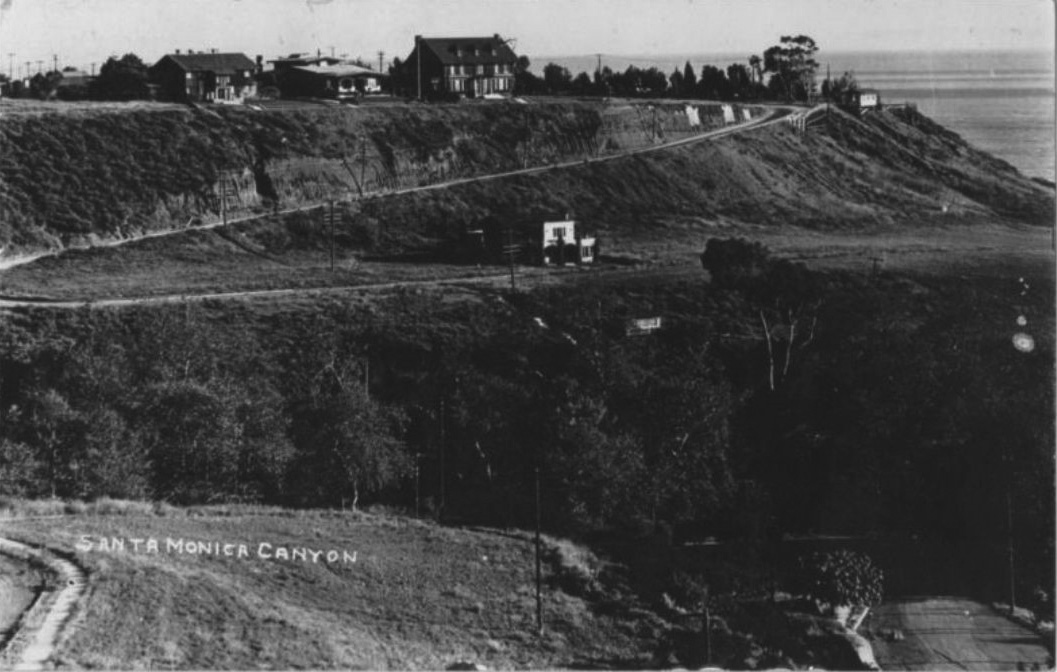 |
|
| (1915)* – Close-up panoramic view showing the southern bluffs of Santa Monica Canyon with the first three houses now appearing on top at Adelaide Drive. A fourth house is also seen at the base of the bluffs. |
Historical Notes Adelaide Dr. and 4th house is still there. It was built in 1906 for R C Gillis as a summer house. Gillis and partners subdivided area as The Palisades and marketed it as a place to build summer houses for Los Angeles residents. |
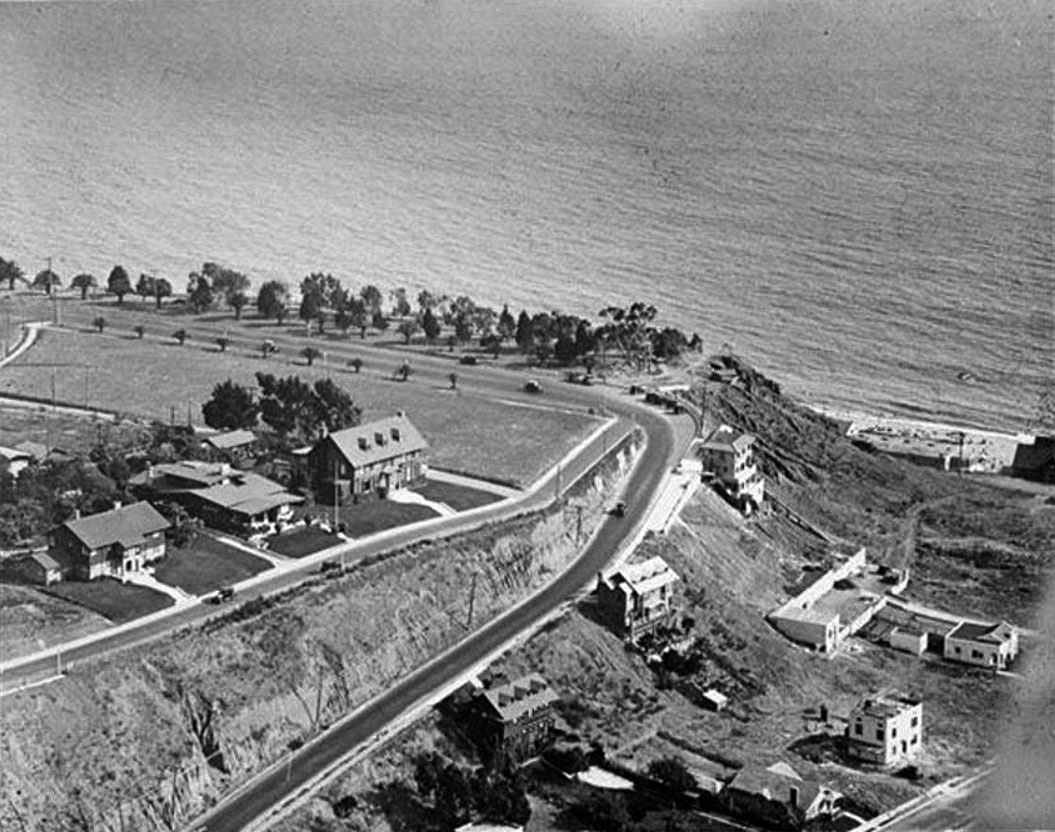 |
|
| (ca. 1918)* – Aerial view looking down at the southern bluffs of Santa Monica Canyon showing where Ocean Avenue meets Adelaide Drive (center of photo). Ocean Avenue runs parallel to the Palisades bluffs and the ocean. Several more homes now appear on the hillside facing Santa Monica Canyon. Click HERE for contemporary view. |
Historical Notes Ocean Avenue starts at the residential Adelaide Drive (seen above) on the north end of Santa Monica and ends at Pico Boulevard. It is westernmost street in Santa Monica, and for most of its course it runs parallel to Palisades Park, whose bluffs overlook Pacific Coast Highway and Santa Monica State Beach. |
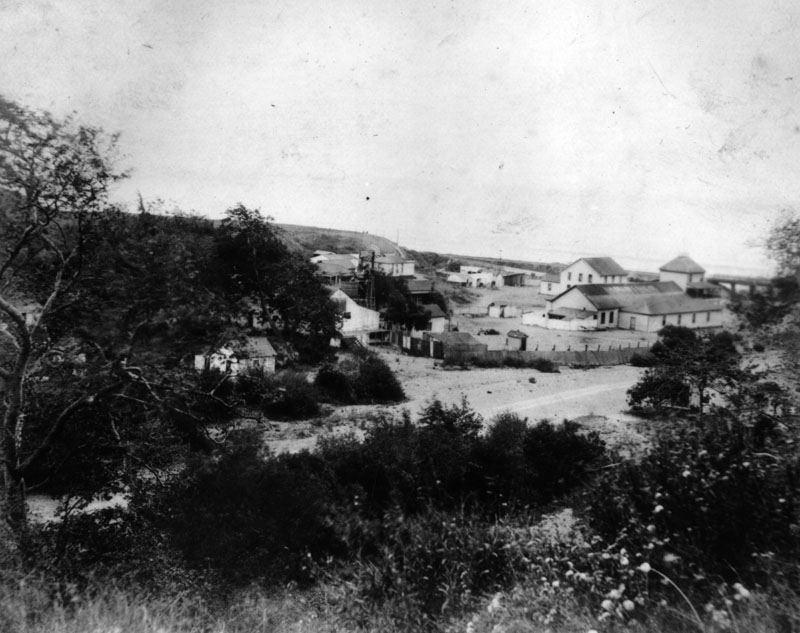 |
|
| (Early 1900s)* - Close-up view of buildings in Santa Monica Canyon. |
* * * * * |
Santa Monica Canyon (Before and After the Long Wharf)
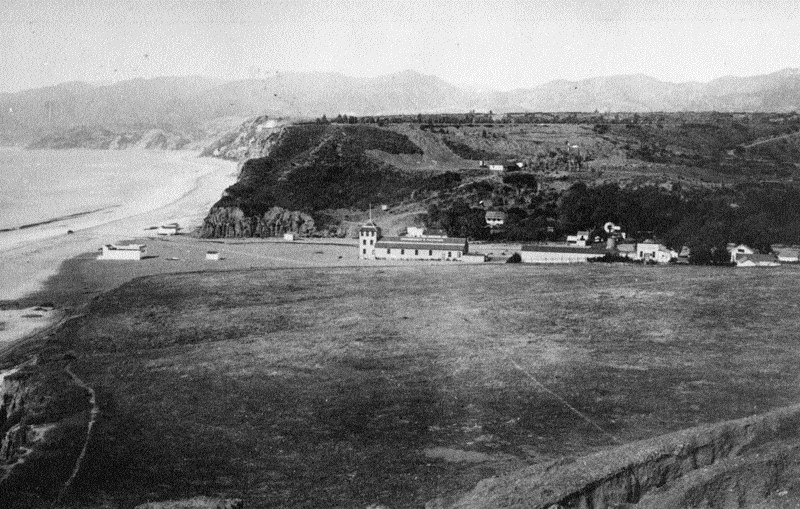 |
|
| (1880s)* - Entrance to the Santa Monica Canyon looking from the hills toward the ocean. Several buildings are situated at the mouth of the canyon. This photo was taken prior to the construction of the Long Wharf (1893). |
Historical Notes Santa Monica Canyon in the 1880s was a landscape in transition, poised on the brink of significant development. Originally part of the Mexican land grant Rancho Boca de Santa Monica, the area experienced a land boom in the late 1880s, though the first formal subdivision wouldn't be created until 1912. A pivotal moment came in 1887 with the establishment of the Old Santa Monica Forestry Station in Rustic Canyon, the nation's first experimental forestry station. This facility tested exotic trees and conducted important management studies, setting a precedent for scientific research in the area. The canyon was renowned for its natural water resources, with streams formed by moisture gathering on the hills, making the land particularly fertile. Infrastructure development was also underway, with railroad tracks laid near the canyon by 1885. This decade marked the beginning of Santa Monica Canyon's transformation from expansive ranchland to a more settled area, laying the foundation for the intensive development that would follow in subsequent years. |
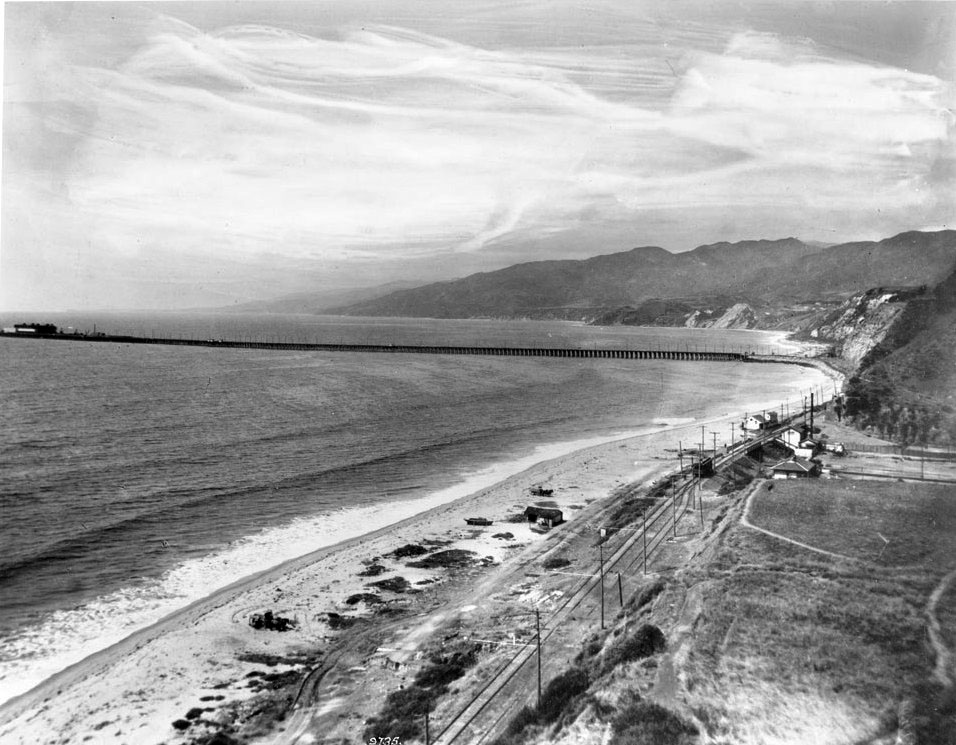 |
|
| (ca. 1912)* - View of Santa Monica Canyon and Long Wharf. The entrance to the Santa Monica Canyon is to the right. Railroad tracks and a pole line can be seen running parallel to the beach. The mountains along the Pacific coastline are visible in the distance. The long dock extends from the beach on the right to a large ship in the open ocean on the left. |
Historical Notes The Long Wharf, also known as Port Los Angeles, was a major infrastructure project built by the Southern Pacific Railroad Company. Construction began in 1892 and was completed in 1894. At the time of its opening, it was the longest wharf in the world, stretching approximately 4,700 feet (1,400 meters) into Santa Monica Bay, just north of Santa Monica Canyon. The wharf served as a cargo and passenger port until 1913. It was constructed to establish Port Los Angeles, as the city lacked a natural harbor, and was a collaborative effort between Collis P. Huntington of Southern Pacific Railroad and Nevada Senator John P. Jones, who also founded Santa Monica. The Santa Monica Canyon Line, a tram line built in 1891, connected the wharf to the city, running from Ocean Avenue and Colorado Avenue through a tunnel to the beach. The Long Wharf played a vital role in the region's development by bringing lumber from Northern ports to support Southern California’s construction boom. |
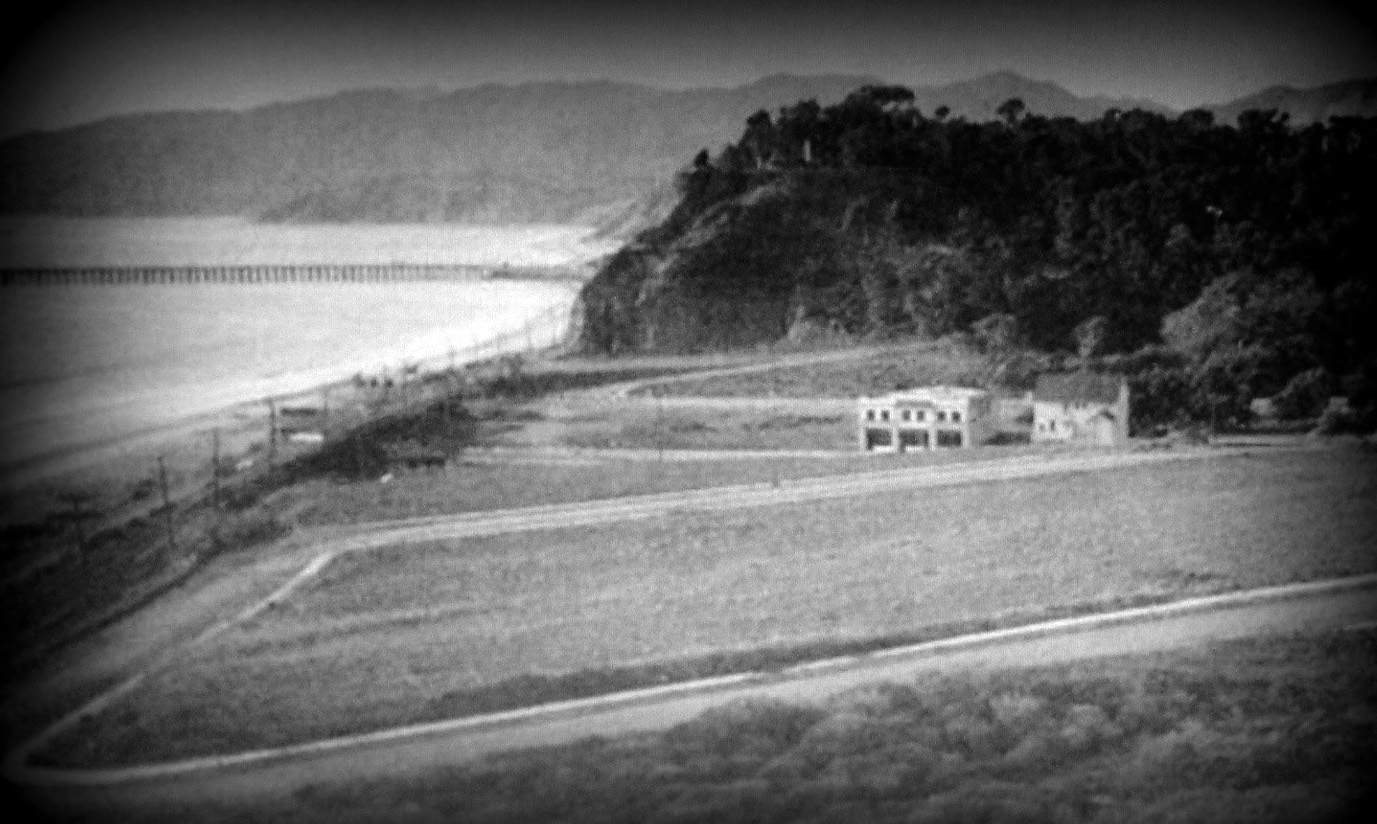 |
|
| (ca. 1912)* - View looking down at Santa Monica Canyon from Adelaide Drive on top of the southern bluff of the canyon with the Long Wharf seen in the distance. |
Historical Notes The Long Wharf's prominence was short-lived despite its initial success. It began losing significant traffic to San Pedro after the latter was selected as the site for the Port of Los Angeles in 1897. The wharf's dismantling commenced in 1919, with its tip removed by 1920. The remaining structure served as a fishing pier until its complete removal in 1933. Today, the former site of the Long Wharf is recognized as a California Historical Landmark (site number 881) and is located in present-day Pacific Palisades at Will Rogers State Beach, preserving the memory of this once-impressive maritime structure. |
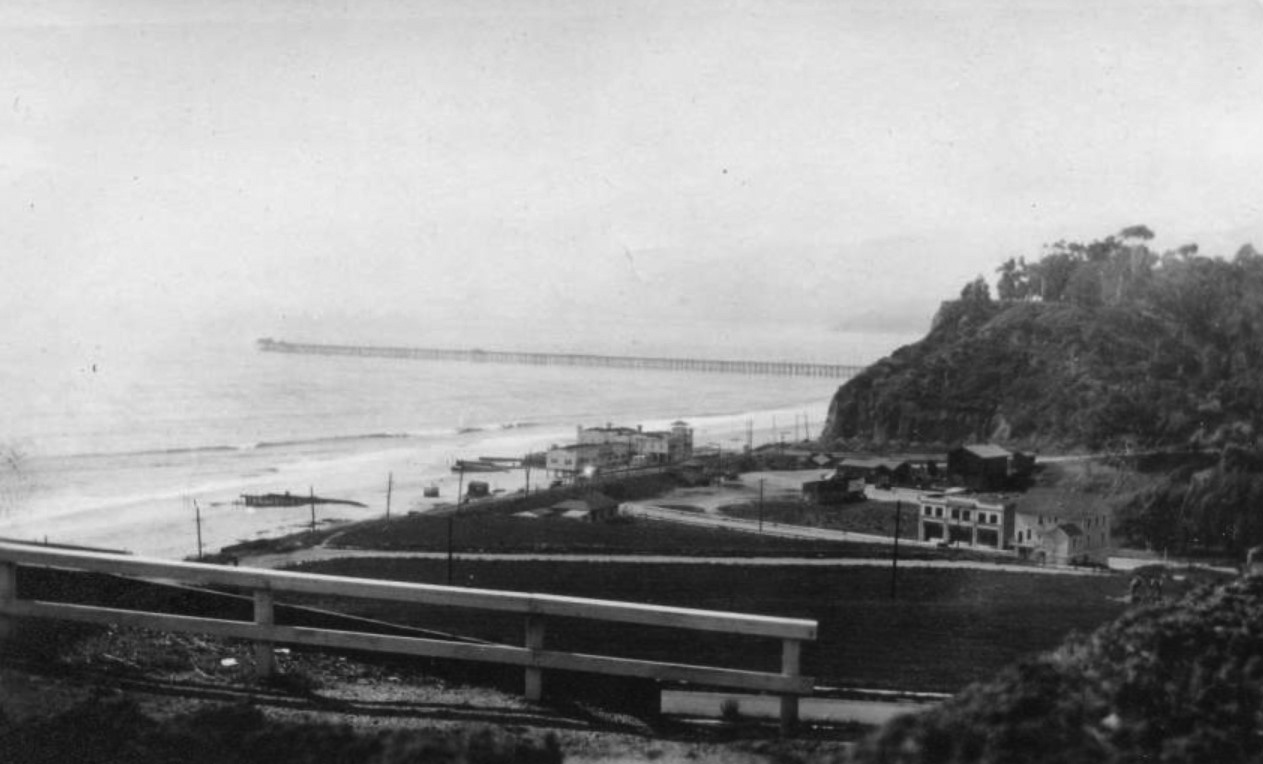 |
|
| (ca. 1915)* - Postcard view showing the mouth of Santa Monica Canyon (present-day Chautauqua Blvd / W. Channel Rd. / Pacific Coast Highway). A bath house, sometimes identified as Bundy's Bathhouse, is visible on the beach, and the Long Wharf of the Port of Los Angeles (dismantled in 1920) appears in the background. |
Historical Notes Tract planning for residential homes in the Santa Monica Canyon began in 1912. Santa Monica Land Companies owned by Gillis, Sherman, and C.L. Bundy promoted one expensive new tract after another. At the place Where the Mountains meet the Sea (as The Canyon was advertised), the Bundy’s built a bath house with picnic area, refreshments, and dance pavilion. It became the favorite oasis of many until it burned down in 1927. Francis Eugene "Frank" Bundy (1870-1944), commonly known as F.E. Bundy, was part of the Bundy family that played a significant role in the development of Santa Monica, including having Bundy Drive named after them. F.E. Bundy was one of the Bundy brothers, which included G.G. Bundy, C.L. Bundy, Nathan P. Bundy, and Thomas C. Bundy. The Bundy family originally moved to Santa Monica from Ames, Iowa, where they established a home in Santa Monica Canyon. F.E. Bundy became a prominent real estate developer in Santa Monica, acquiring substantial real estate holdings through his business ventures. |
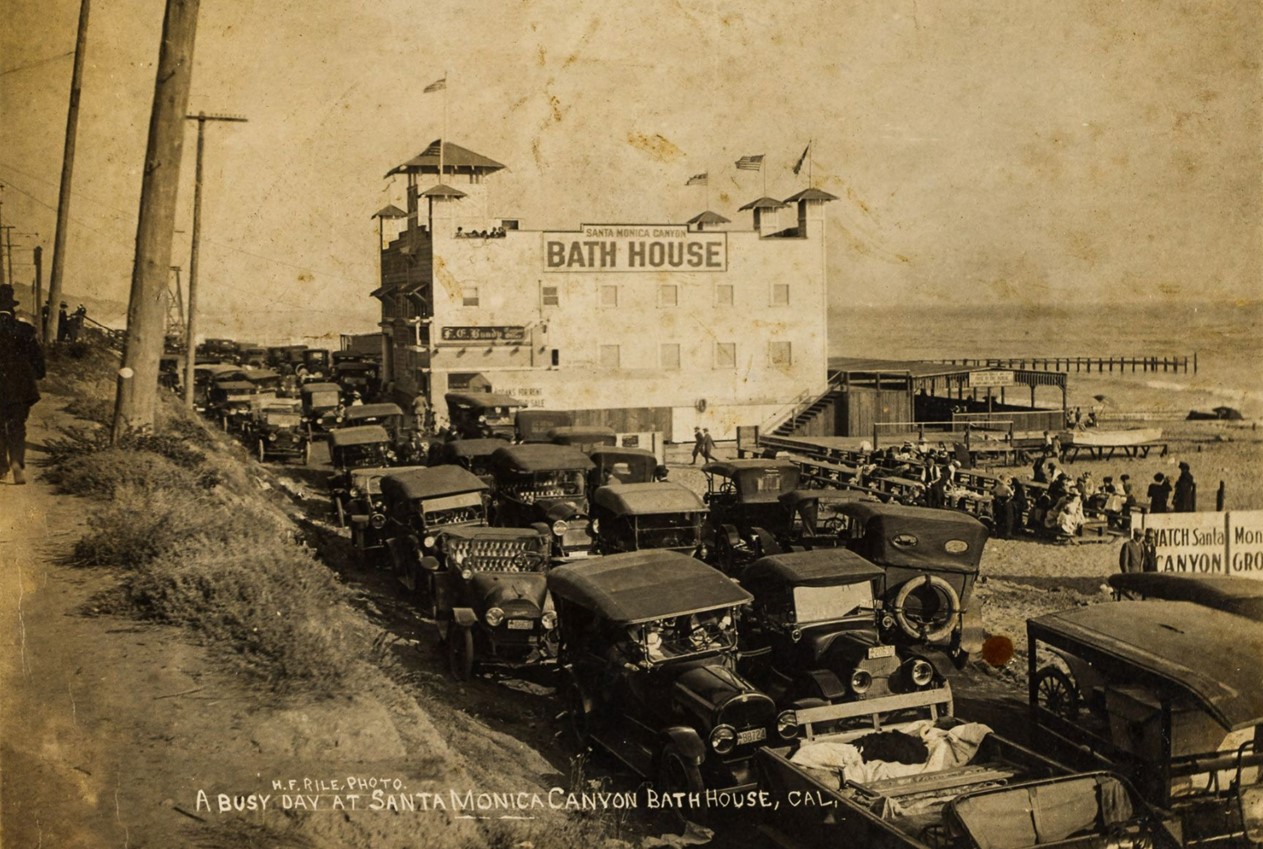 |
|
| (1916)* – A busy day at the Santa Monica Canyon Bath House (also known as Bundy Bath House). Automobiles are tightly packed into every available parking space in front of the bath house during the July 4th weekend. Signs on the north side of the building read 'Santa Monica Canyon Bath House' and 'F.E. Bundy' (the owner), while a sign on the beach to the right proclaims, 'Watch Santa Monica Canyon Grow. Photo from the Ernest Marquez Collection. |
Historical Notes The Santa Monica Canyon Bath House, also known as Bundy Bath House, was a prominent recreational landmark in the early 20th century. Situated at the mouth of Santa Monica Canyon on the beach, it operated from at least 1915 to 1927. Built and owned by F.E. Bundy, a member of the Santa Monica Land Company, the bathhouse played a key role in promoting the area's residential development. The Bundy Bath House offered a range of amenities, including refreshment stands, picnic areas, a dance pavilion, and changing rooms, making it a popular destination for locals and visitors. As Santa Monica Canyon developed into a recreational and residential hub, the bathhouse’s location near the Pacific Electric Railway tracks leading to the Long Wharf made it easily accessible. Described as "the favorite oasis of many," the bathhouse was central to the growing leisure culture of the period. However, in 1927, it was destroyed by fire, marking the end of its brief but impactful existence. The area continued to evolve, and the Pacific Coast Highway was later constructed near its former site. Despite its short lifespan, the Bundy Bath House was an important part of Santa Monica Canyon’s transition from a rural landscape to a thriving residential community. |
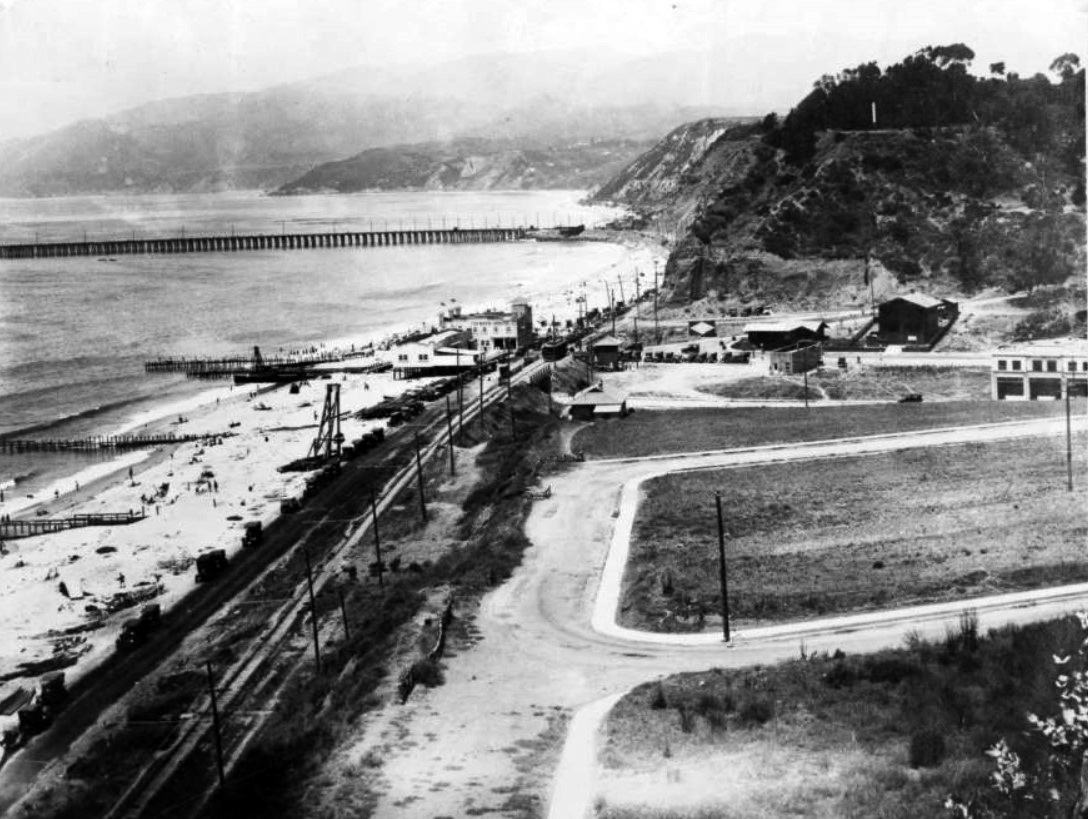 |
|
| (1916)* - View showing the F.E. Bundy bathhouse on the beach at the mouth of Santa Monica Canyon. The Pacific Electric tracks to Long Wharf are seen in the distance and Mayberry Road is in the foreground. |
Historical Notes In November 1919 the Pacific Electric Railway announced they were going to pull down the entire wharf. By the middle of the next summer not a trace of it was left. |
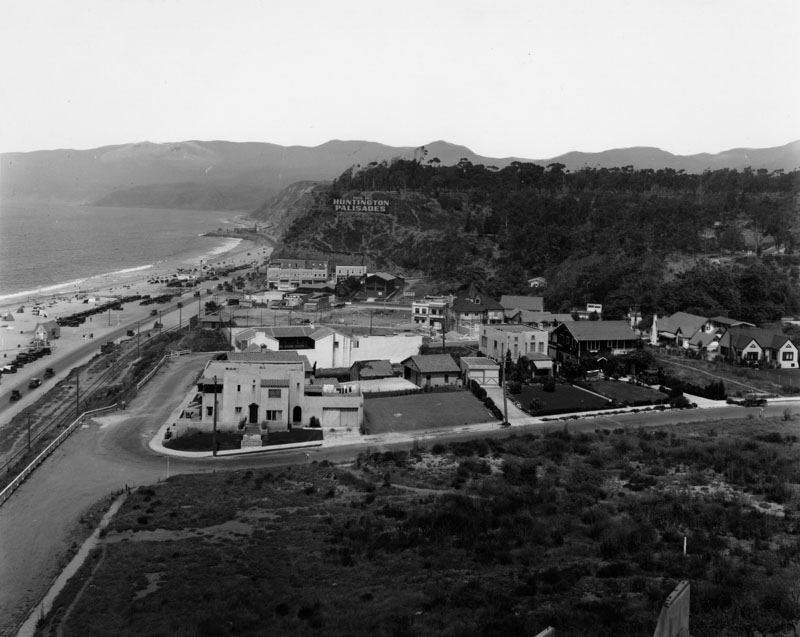 |
|
| (late 1920s)* - Santa Monica Canyon by the ocean looking across to the Huntington Palisades. Sign on the hillside reads: HUNTINGTON PALISADES. The Long Wharf no longer appears. It was demolished in 1920. Also, Bundy's Bath House, seen in previous photos, is now gone. It burned down in 1927. |
Historical Notes Pacific Palisades was founded in 1920 by Dr. Charles Holmes Scott of the Methodist Episcopal Church, who sought permanent roots for his religious community. Scott, along with a delegation of Methodist ministers and laymen, purchased 16.6 acres of Rustic Canyon property (then-owned by scholar and widow Julia Edmond) and 11.8 acres of land adjacent to a forestry station. That same year, the Pacific Palisades Association was established to implement Scott’s plans and to further expand the community — in land and in population. January 14, 1922 was Pacific Palisades’ official “opening day.” In 1926, the Pacific Palisades Association purchased the land that was owned by the Huntington family of New York. Both a commemorative gesture and a way to benefit from the prestige associated with the Huntington name, the area was deemed “Huntington Palisades.” |
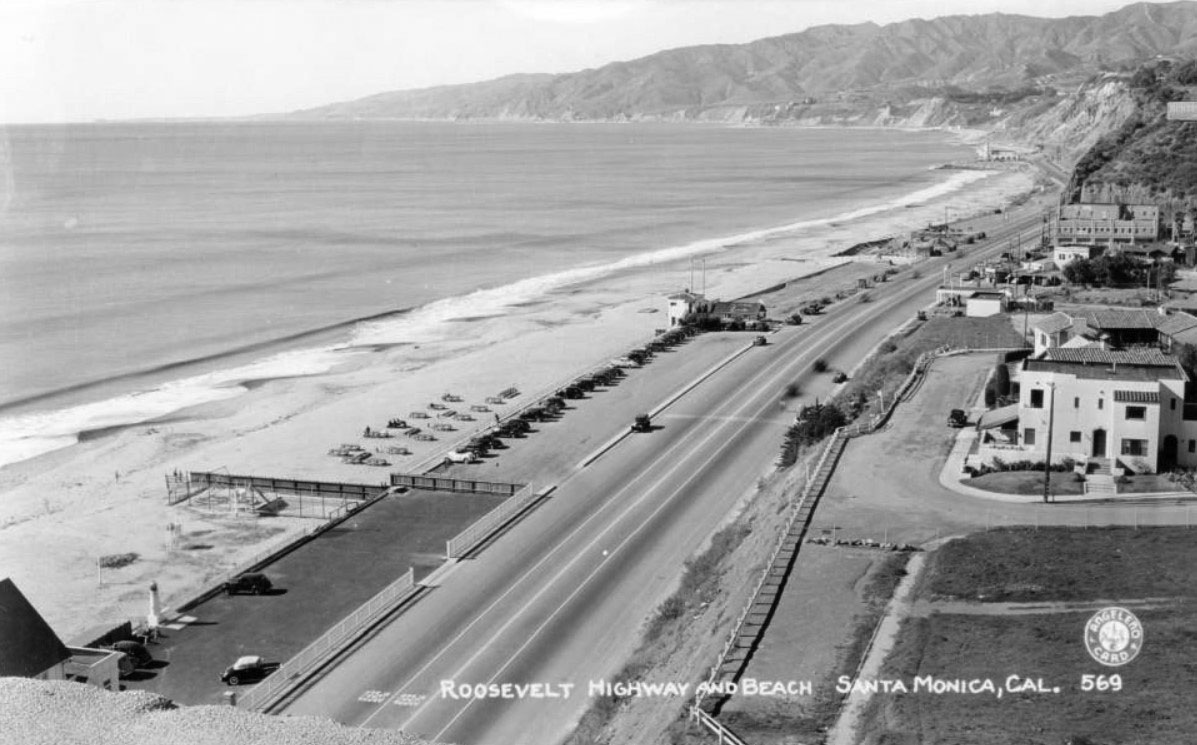 |
|
| (1930s)* - Postcard view looking north toward Malibu showing the Roosevelt Highway (now Pacific Coast Highway) at Santa Monica Canyon. The Lighthouse Cafe is visible up the coast. |
Before and After
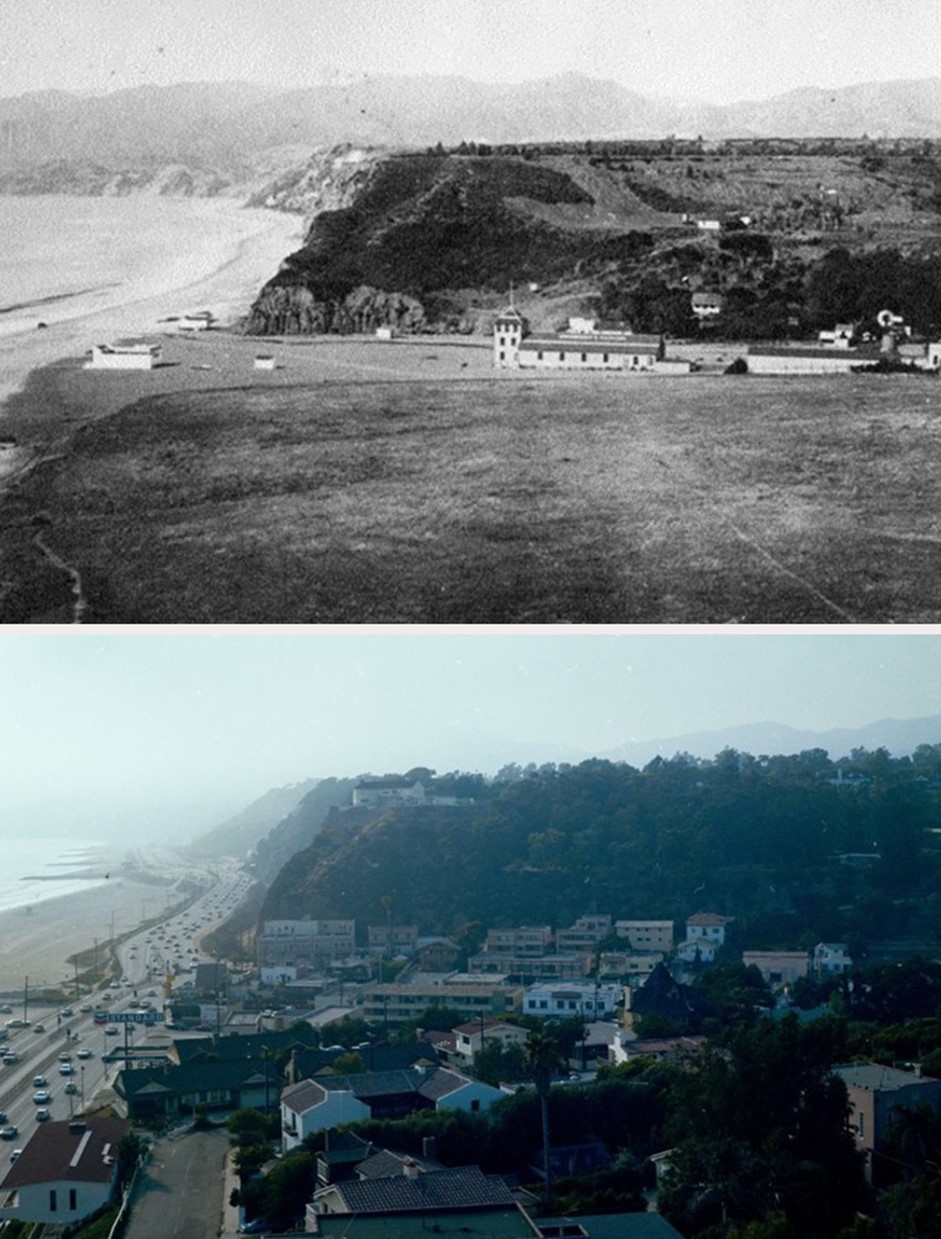 |
|
| (1880s vs 1978)* - Image looking north from the bluff overlooking Santa Monica Canyon. |
Historical Notes Click HERE to see more early views of Santa Monica Canyon |
Roosevelt Highway
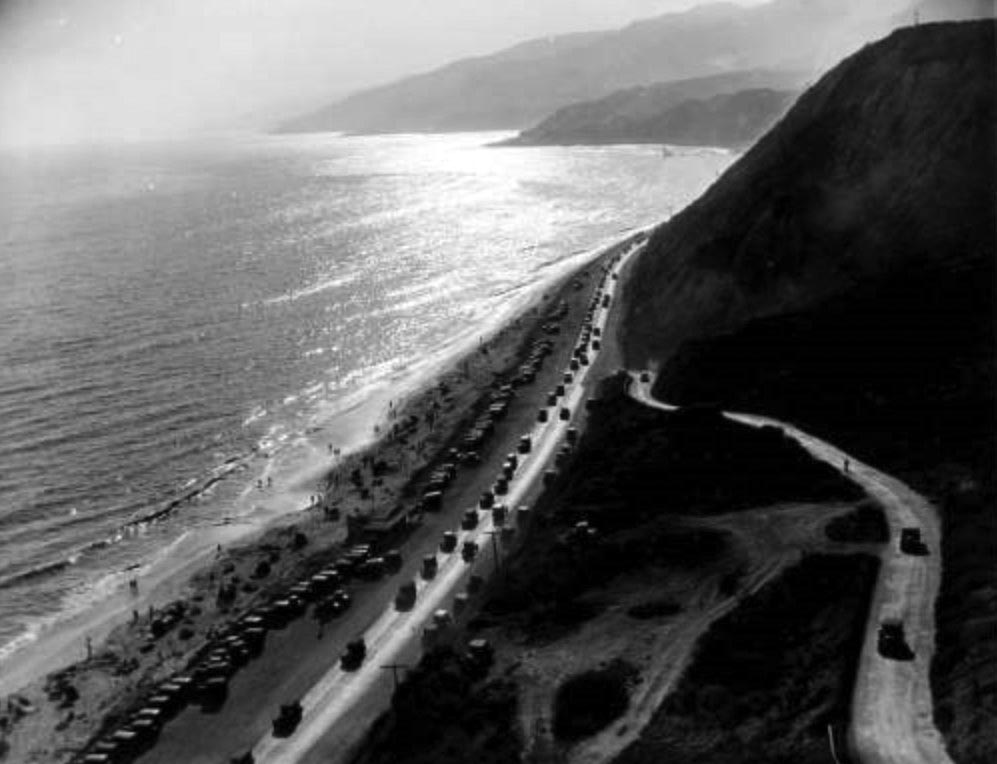 |
|
| (1930)* - View looking north showing the Roosevelt Highway (later Pacific Coast Highway) with the Pacific Ocean, mountains, beach, and automobiles visible along the coastline in Pacific Palisades near Topanga Canyon. |
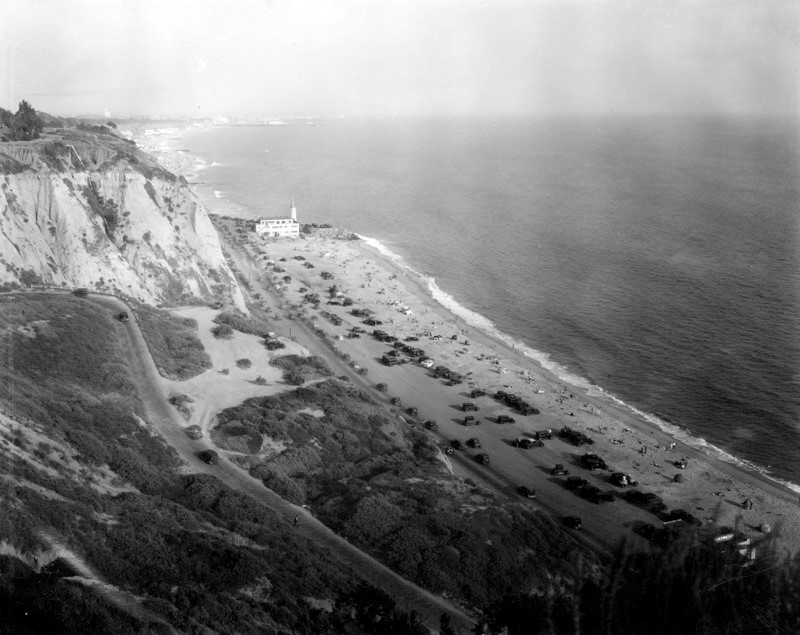 |
|
| (1920s)* - Looking south along Roosevelt Highway (PCH by end of 1930), in Pacific Palisades. The highway runs parallel with the ocean where visitors enjoy the sun and surf. Visible in the distance, the landmark Lighthouse Bathhouse that stood on Pacific Coast Highway at the point where the Santa Monica Mountains come down to the shore. |
Pacific Palisades Lighthouse and Bathhouse
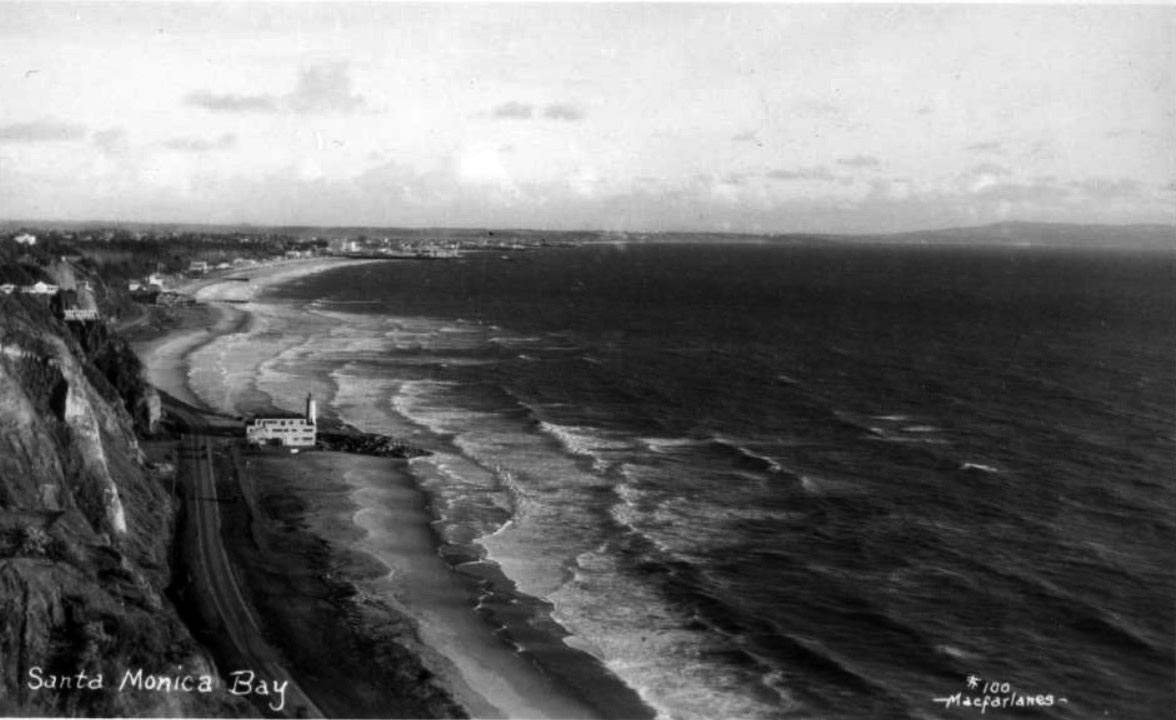 |
|
| (ca. 1927)* - Panoramic view of Santa Monica Bay showing the Roosevelt Highway (later Pacific Coast Highway), Santa Monica Bay, and coastline with the Lighthouse Bathhouse on the beach next to the remains of the Long Wharf stone jetty in Pacific Palisades. The Santa Monica Pier can be seen in the distance at upper left center. A sign for "Huntington Palisades" is seen at left edge of image. |
Historical Notes The Pacific Palisades lighthouse was built as a bathhouse with a working light in 1927. In the early 1930s the structure along with the beach was sold to Will Rogers and later the beach was given to the state of California and renamed the Will Rogers State Beach. |
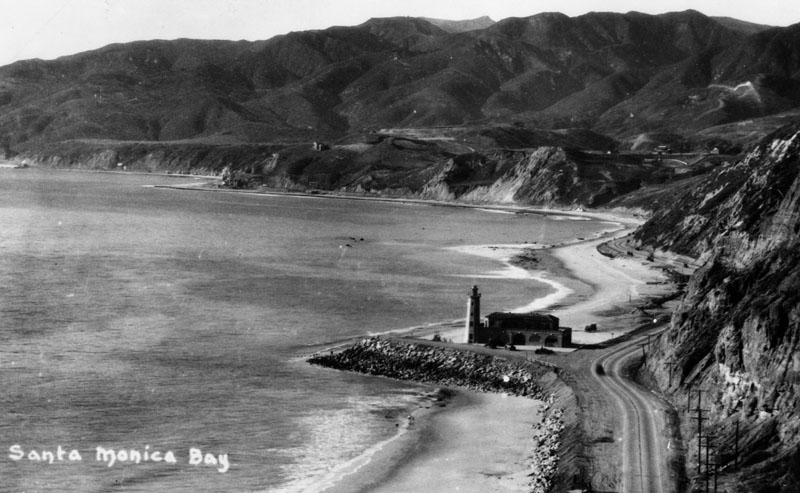 |
|
| (ca. 1927)* - View of the Santa Monica Bay coastline, showing a lighthouse and bathhouse near the Pacific Palisades. The lighthouse stands at the spot where the Long Wharf used to extend out into the ocean. |
Historical Notes “The Lighthouse” restaurant and bathhouse opened for business on Memorial Day, 1927. Built by the Pacific Palisades Association and designed by architect Thomas P. Barber, the bathhouse featured a second floor dining room, a wrap-around Venetian colonnade, and was large enough to accommodate 500 patrons. |
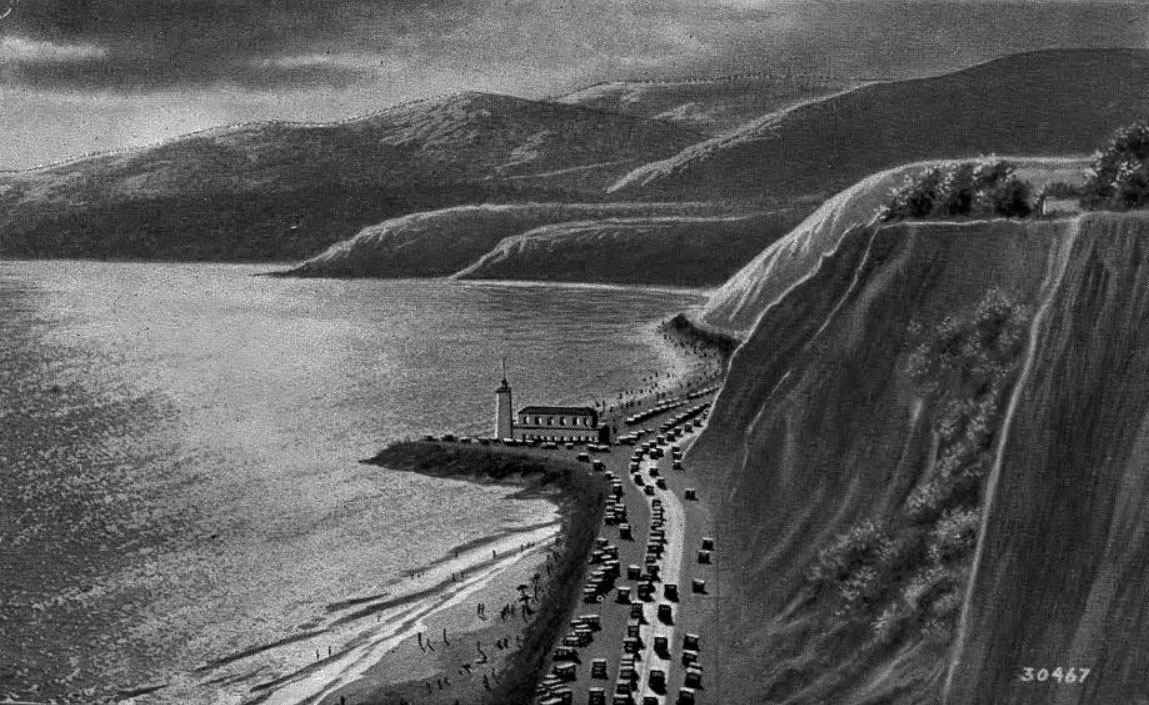 |
|
| (ca. 1930)* - Postcard view showing the Roosevelt Highway (later Pacific Coast Highway) stretching westward from Santa Monica to Pacific Palisades, with Malibu in the background. The Lighthouse was a restaurant and cafe, and later the lifeguard headquarters. It marks the spot where the Long Wharf once projected into the Bay. |
Historical Notes Although it was not a true lighthouse, the picturesque building was commonly featured in promotional photographs and materials advertising Southern California. It was also an important visual point of reference for boats navigating into Santa Monica Bay. |
 |
|
| (ca. 1920s)* - View looking down from the canyon of where the Long Wharf used to extend into the ocean. The Pacific Palisades Lighthouse and Bathhouse are seen with an adjacent parking lot full of cars. |
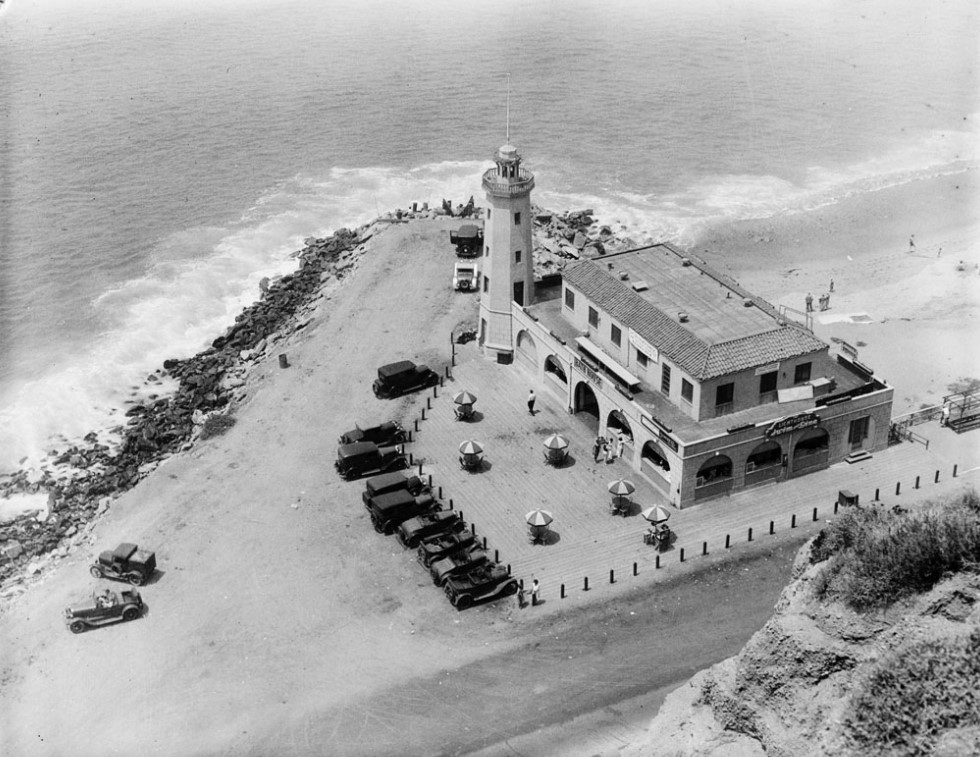 |
|
| (ca. 1930)* - View of the lighthouse, restaurant and bathhouse on the Long Wharf outcropping, Roosevelt Highway. Six tables with striped umbrellas can be seen to the left of the restaurant, while several automobiles are parked in front of the building at left. |
Historical Notes The most distinctive feature was the 50-foot tall lighthouse tower with a functioning beacon powered by eight 500-watt lamps. The Lighthouse was a popular destination and become an iconic landmark as the Roosevelt Highway (later the PCH) opened up through Malibu in 1929, connecting all of California along a single coast highway. |
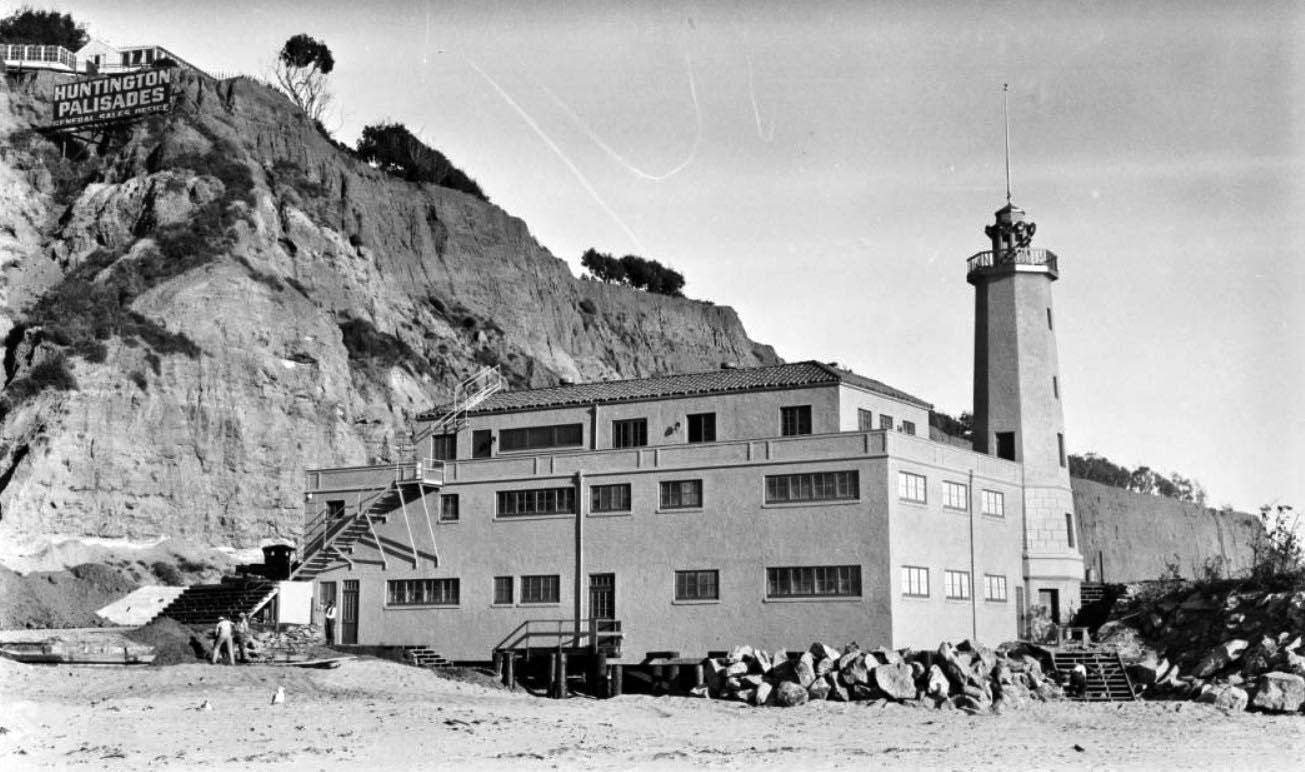 |
|
| (ca. 1927)* - View showing construction workers working on a walkway and staircases of the Lighthouse Bathhouse on the beach in Pacific Palisades, with a small part of the remains of the Long Wharf at far right. A sign for the Huntington Palisades general sales office can be seen on a cliff above. |
Historical Notes In 1926, the Pacific Palisades Association purchased the land that was owned by the Huntington family of New York. Both a commemorative gesture and a way to benefit from the prestige associated with the Huntington name, the area was deemed “Huntington Palisades.” |
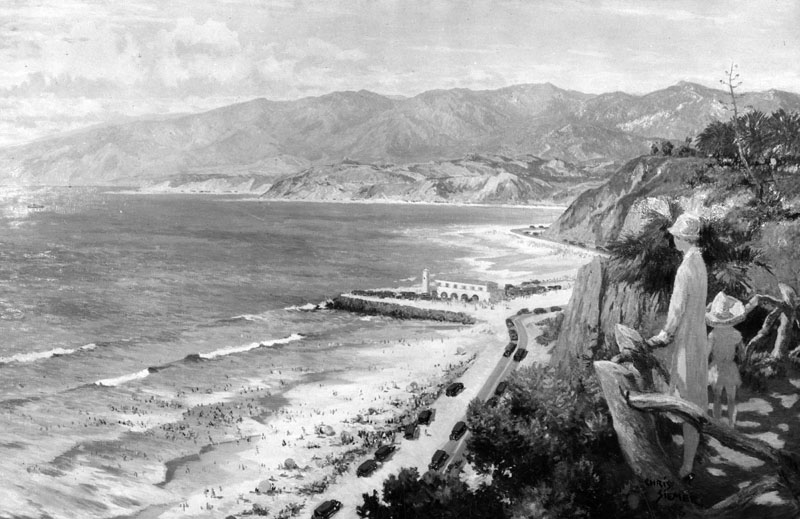 |
|
| (ca. 1930)* - Looking down from Palisades Park in Santa Monica north towards the Lighthouse bathhouse and restaurant that stood on Pacific Coast Highway at the point where the Santa Monica Mountains come down to the shore. This is a photograph of a painting by Chris Siemer. The painting was created for display by the L.A. Chamber of Commerce. |
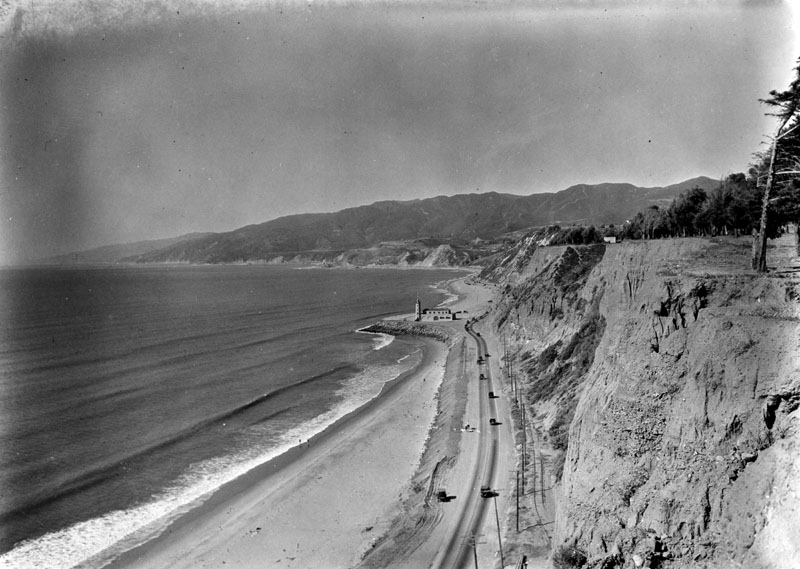 |
|
| (1927)* - A view of the palisades of Santa Monica, looking north along Roosevelt Highway next to an unbuilt beach (today's Will Rogers Beach). |
Before and After
 |
|
 |
|
| (1916)* vs. (1927)* - View showing the Long Wharf (1893 - 1920) and the Pacific Palisades Lighthouse and Bathhouse (1927 - 1972) at the same location. The beach seen in the foreground is today's Will Rogers Beach. |
Historical Notes The Long Wharf was the longest ocean wharf in the world at 4700 feet. It was built in 1893 by the Southern Pacific Railroad, and it was destroyed in 1920 by the Pacific Electric Railroad Co. The Long Wharf was designated California HIstorical Landmark No. 881. Click HERE to see more California Historical Landmarks in L.A. |
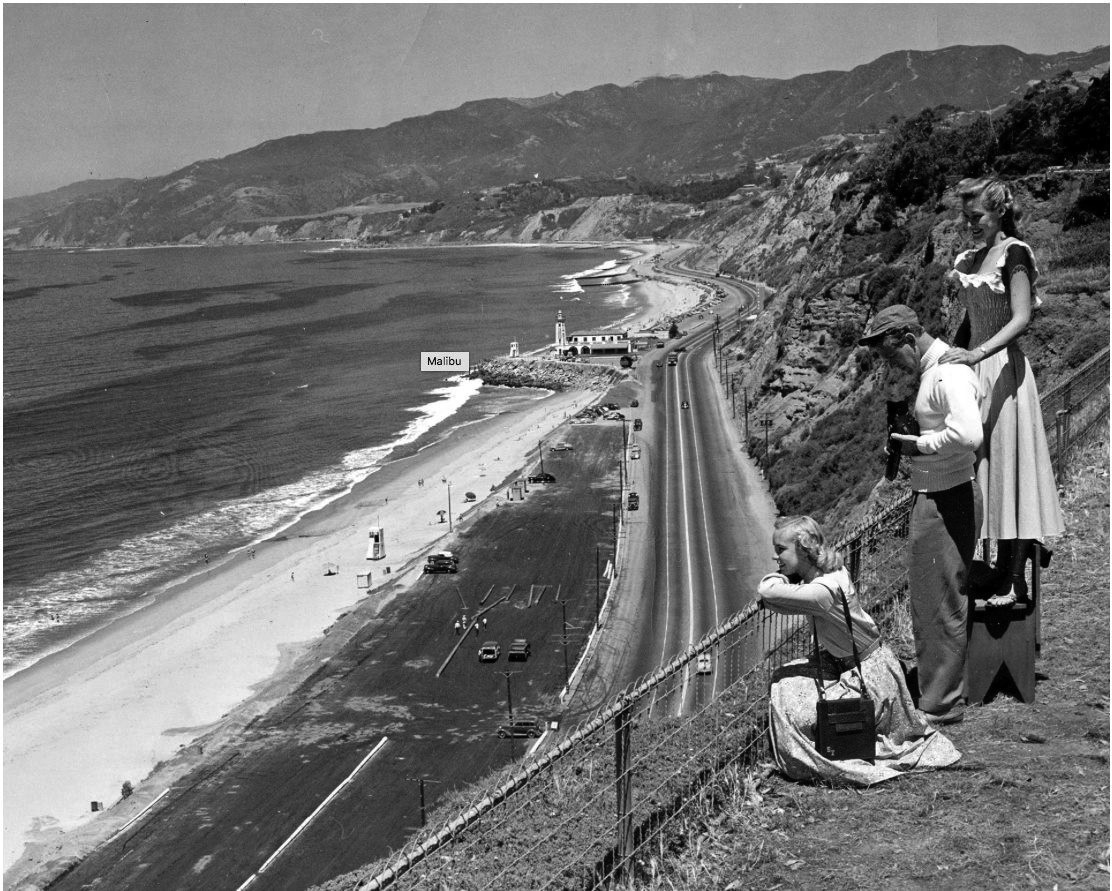 |
|
| (1940s)* – View showing tourists admiring the scenery from the bluffs above Santa Monica Canyon (Huntington Palisades), with the Pacific Palisades Lighthouse seen in the distance. Photo courtesy of Eric Wienberg |
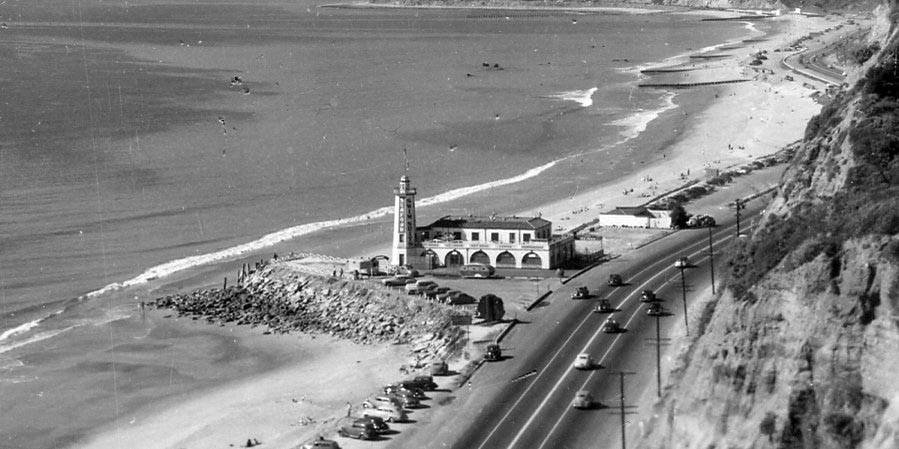 |
|
| (ca. 1940)* – Panoramic view showing the Pacific Palisades Lighthouse, restaurant and bathhouse and Pacific Coast Highway. |
Historical Notes Over the decades, as the popularity of bathhouses faded, the patronage of the Lighthouse diminished. Eventually, the building was taken over by the Will Rogers State Beach lifeguard, serving as a part of the lifeguard headquarters. By 1972, the Lighthouse structure was determined to be unsuitable for habitation and was razed. |
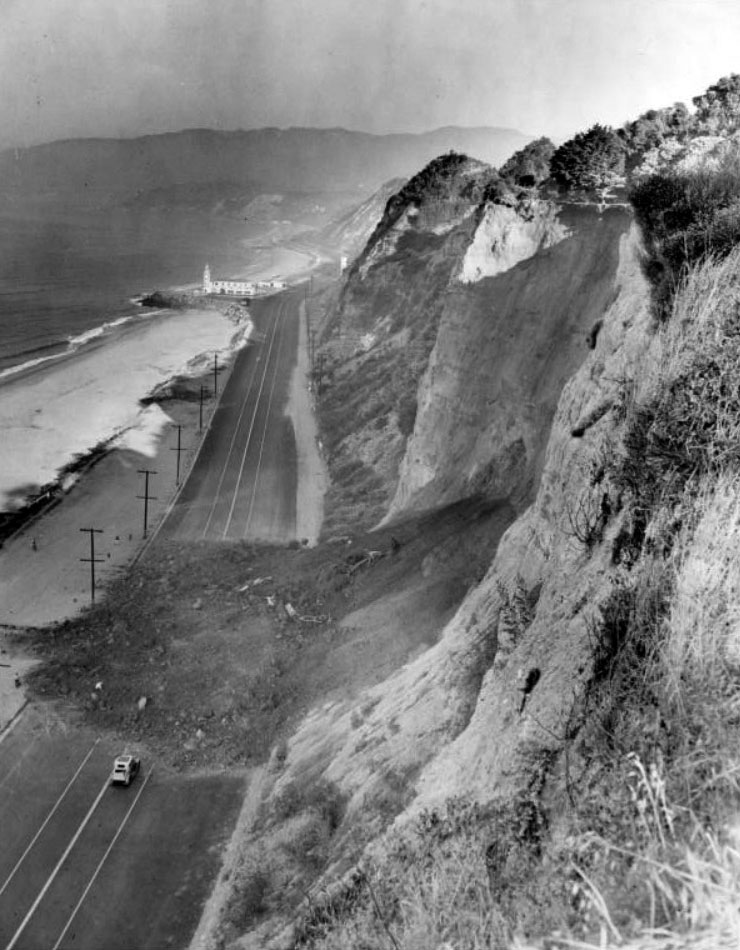 |
|
| (1944)* - A landslide blocks the Roosevelt Highway--soon to be the Pacific Coast Highway. The Lighthouse bathhouse and cafe is in the background. |
Historical Notes Notes from reverse of photo: Roosevelt Highway Blocked Again. Santa Monica, Calif.,--Southern California's Roosevelt Highway along the Pacific Ocean near here was the scene of another traffic-stopping earth slide from the towering beach front Palisades. The 200-foot, 30-foot deep chunk of earth slid from the backyard of actor Charles Laughton. Photo date: 8/29/44 |
* * * * * |
Pacific Palisades
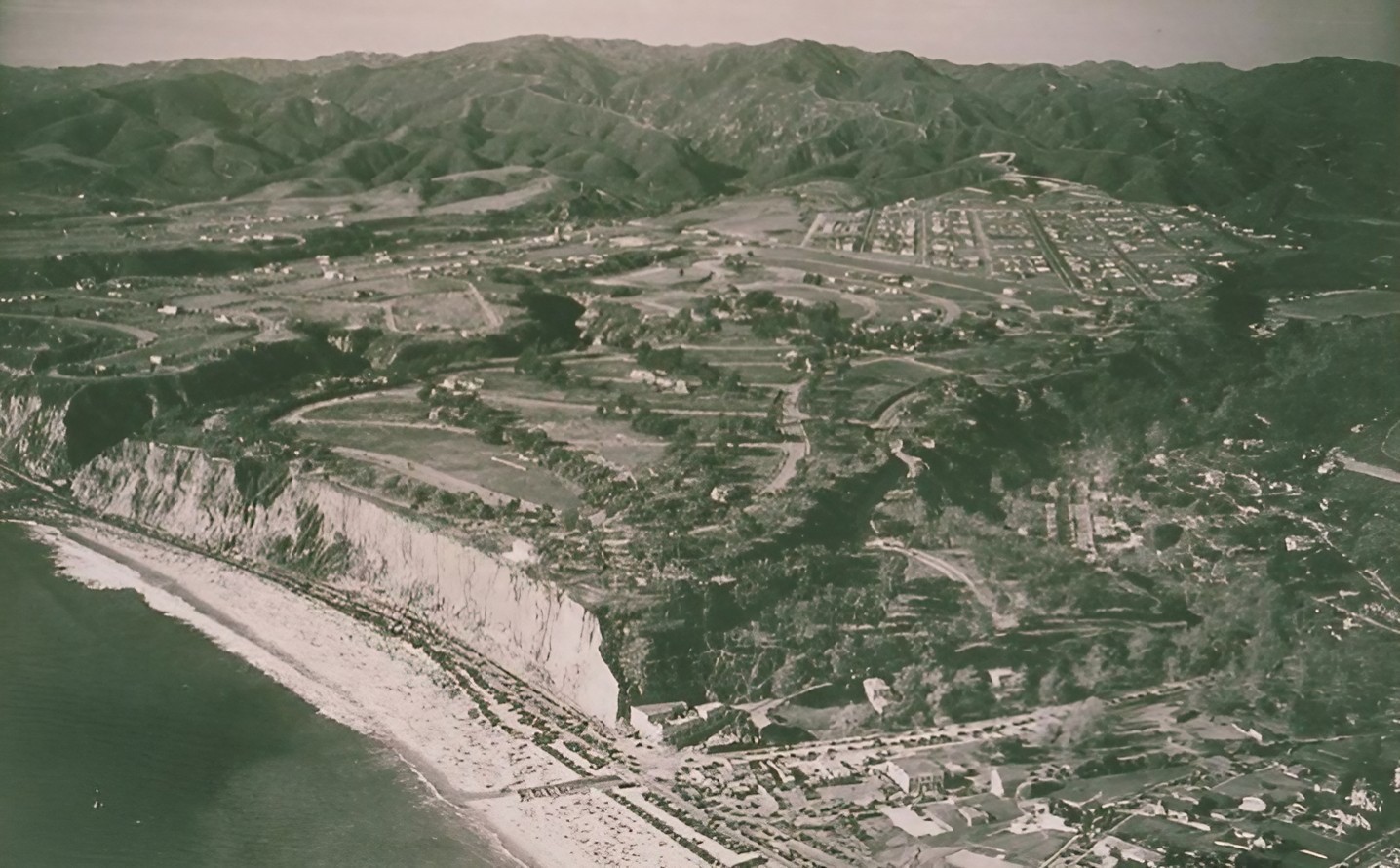 |
|
| (1932)* - Aerial view of Pacific Palisades looking north from above Santa Monica Canyon, with Chautauqua Boulevard, West Channel Road, and Rustic Creek visible near the bottom center. Note the cars parked between Roosevelt Highway and the beach, in the area that would later become Will Rogers Beach. |
Historical Notes Roosevelt Highway was widened and renamed Pacific Coast Highway (PCH) along this stretch in the 1940s. Rustic Creek, flowing through Rustic Canyon in Pacific Palisades, has a history intertwined with the area's development since the Spanish land grant era. Originally part of Rancho Boca de Santa Monica, the canyon gained prominence in 1887 when Abbot Kinney established a forestry station and planted eucalyptus trees. The early 20th century saw increased development, including the founding of Pacific Palisades in 1922 and the establishment of the Uplifters Club. Will Rogers' purchase of his ranch in Upper Rustic Canyon in 1926 further elevated the area's profile. |
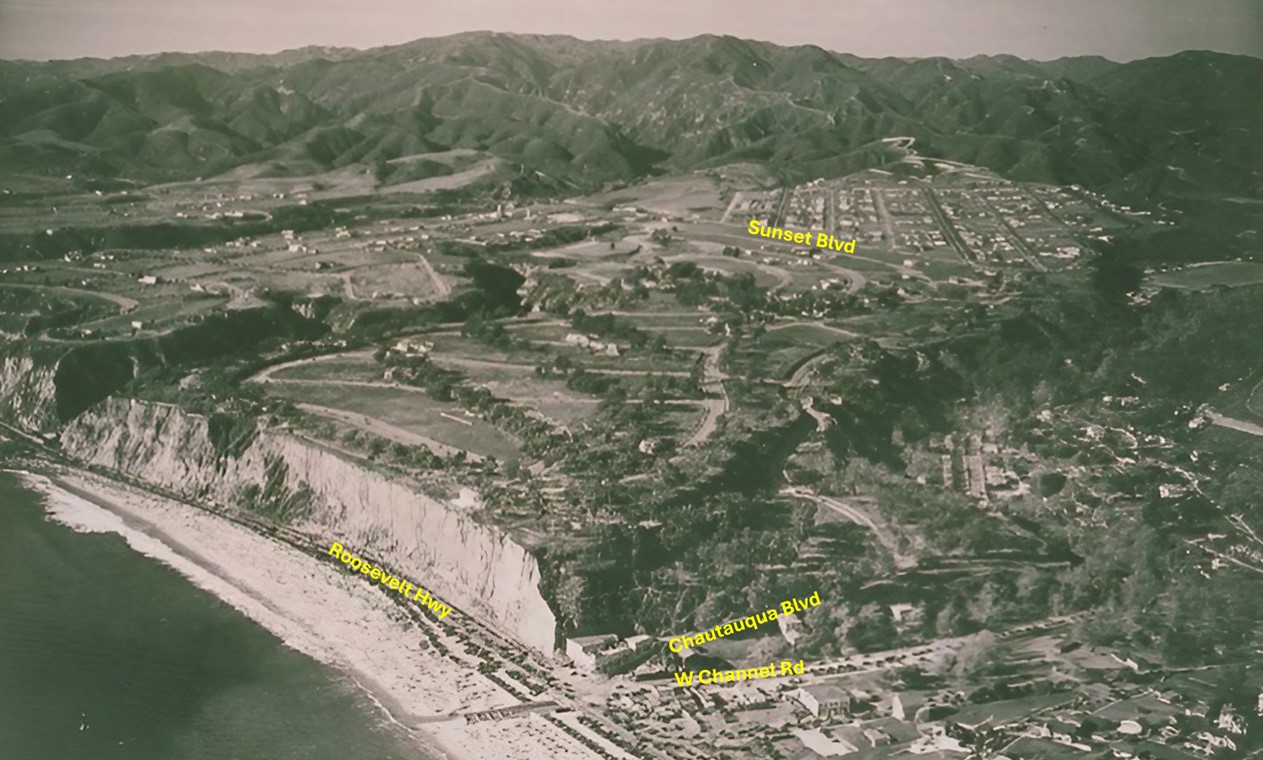 |
|
| (1932)* - Annotated aerial view of Pacific Palisades looking north from above Santa Monica Canyon, with Chautauqua Boulevard, West Channel Road, and Rustic Creek visible near the bottom center. The wide beach at the bottom would become Will Rogers State Beach in 1942. |
Historical Notes Will Rogers Beach, located near Chautauqua in the Pacific Palisades area, was officially named and dedicated on July 26, 1942. This occurred about seven years after the death of Will Rogers, who had owned the beachfront property in the 1920s and early 1930s. Following his death in a 1935 plane crash, his widow Betty developed a plan to gift their oceanfront land to the state of California. The beach was initially owned and operated by the State of California from its dedication in 1942 until 1975, when the County of Los Angeles took over its management. The naming of the beach was part of a larger effort to transform the Rogers' private property into a public recreational area, preserving Will Rogers' legacy and providing public access to this stretch of coastline. |
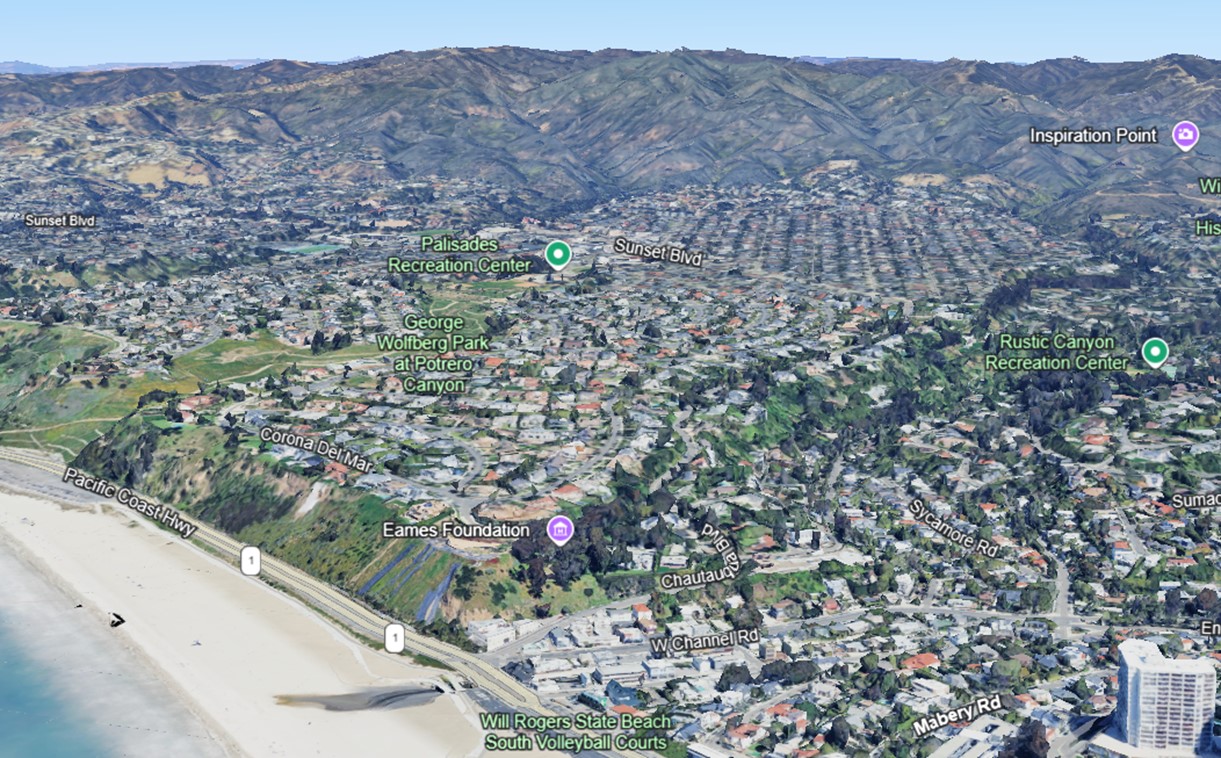 |
|
| (2023)* - Google Earth view of Pacific Palisades looking north from from above Santa Monica Canyon. You can see where Rustic Creek empties into Santa Monica Bay. |
Historical Notes Today, Rustic Creek remains one of the few natural streams in developed Los Angeles, running past Will Rogers State Historic Park and into Topanga State Park. It continues to be a vital part of the local ecosystem, surrounded by a prestigious residential neighborhood known for its natural beauty and seclusion. Highlighted in purple on the Google Earth view is the Eames Foundation, located at 203 Chautauqua Boulevard in Pacific Palisades, California. Established in 2004, the foundation preserves the Eames House—an iconic mid-20th century modernist structure designed by Charles and Ray Eames in 1949. Part of the Case Study House program, this landmark served as both their home and studio and is now recognized as a National Historic Landmark. |
Then and Now
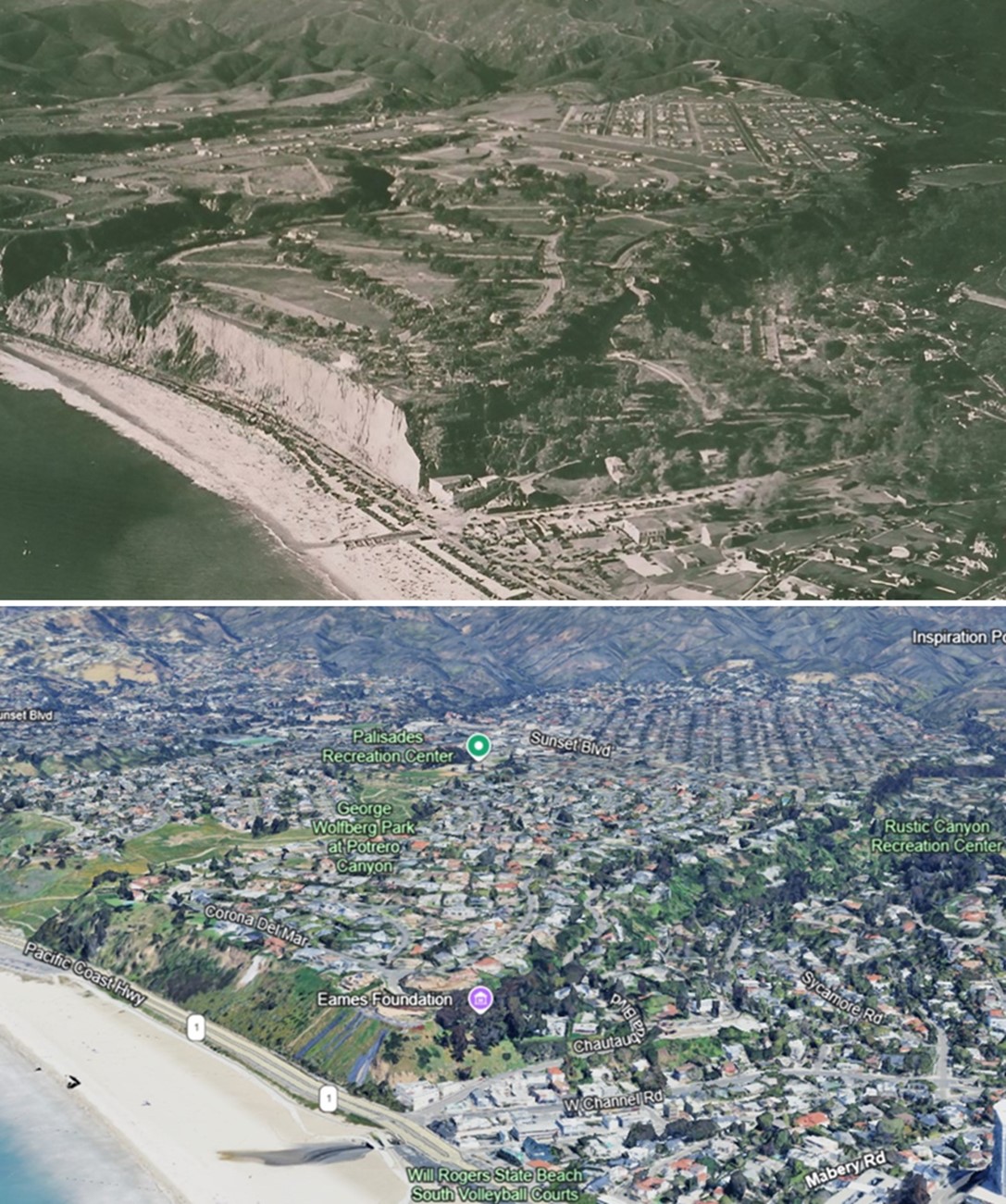 |
|
| (1932 vs. 2023)* - Looking north from above Santa Monica Canyon, illustrating how much development has occurred over 90 years. Note that the Pacific Palisades bluffs are no longer vertical; through natural erosion or engineering, they have been slanted to prevent future slides. |
Historical Notes The bluffs at Pacific Palisades above Will Rogers Beach have transformed from vertical to slanted due to a mix of natural and human influences. Eroding at an average rate of about 4 inches per year, the bluffs—composed of easily erodible materials like sand, silt, gravel, and clay—are particularly vulnerable to erosion and slumping. Significant weather events, such as heavy rains during El Niño periods, have triggered landslides, notably in 1998. Seismic activity, like the Northridge Earthquake, has also contributed to bluff collapses. Human activities may have further impacted their stability. Over time, these combined forces have reshaped the bluffs into a more stable, sloped formation, reflecting the natural evolution of coastal landscapes. |
* * * * * |
Inceville
.jpg) |
|
| (ca. 1915)* - View from the Palisades looking toward Malibu showing Inceville, the famed motion picture studio founded by Thomas Ince. |
Historical Notes In 1911, film director Thomas Ince created his Western film factory, "Inceville," which at its peak employed nearly 600 people. |
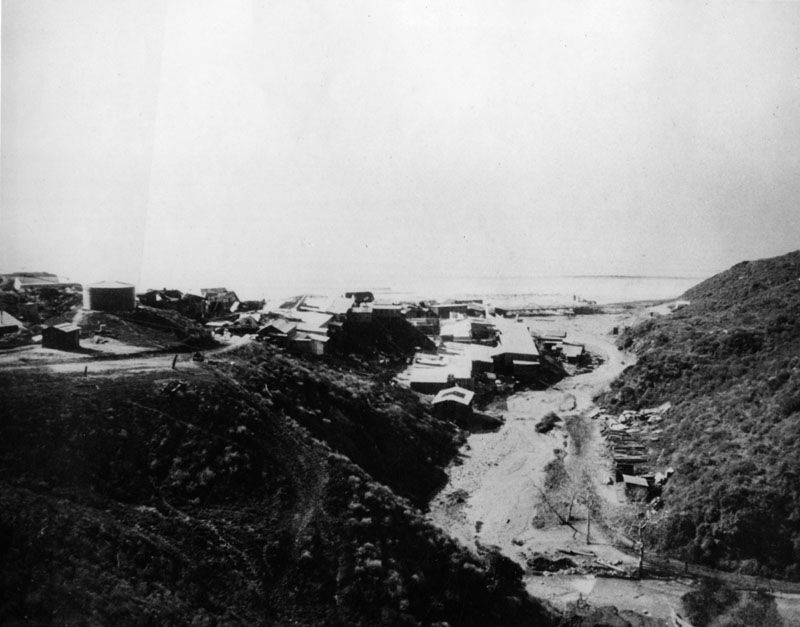 |
|
| (1915)* - View of Inceville, on Sunset Boulevard (Santa Ynez Canyon) at the Pacific Ocean, where Ince Studios filmed location scenes. |
Historical Notes Ince leased 18,000 acres of land extending from the seashore up Santa Ynez Canyon and into the mountains for 7-1/2 miles. While he was building the frame-structured studio buildings, situated where Gladstone’s Restaurant is today, he also hired Miller’s 101 Ranch Wildwest Show, including many cowboys, animals and a Sioux Indian tribe, who set up their teepees on the property. |
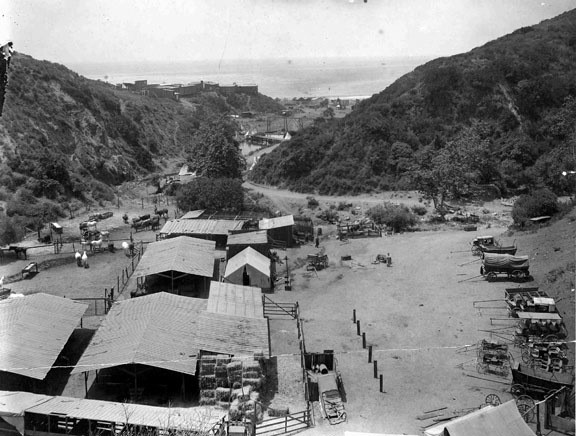 |
|
| (ca. 1916)* - The mouth of Santa Ynez Canyon at the Pacific Ocean was once home of Inceville, an early 1900s film studio built by film director Thomas Ince. |
Historical Notes Most of the cowboys, Indians and assorted workmen lived at Inceville, while the actors came from Los Angeles and other communities as needed, taking the red trolley cars to the Long Wharf at Potrero Canyon, where buckboards conveyed them to the set. Ince lived in a house that overlooked Inceville, the location of Marquez Knolls today. |
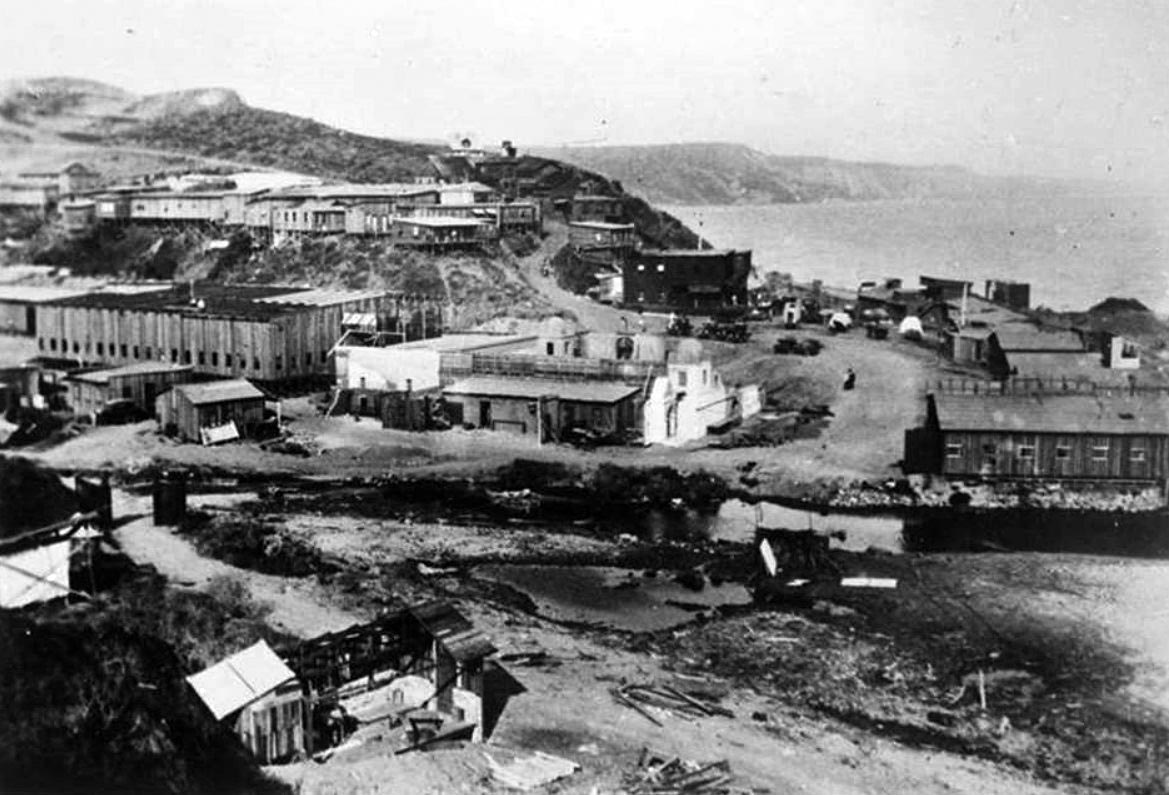 |
|
| (1916)* – View showing the Inceville Studios built by silent film producer Thomas H. Ince at the mouth of Santa Ynez Canyon. |
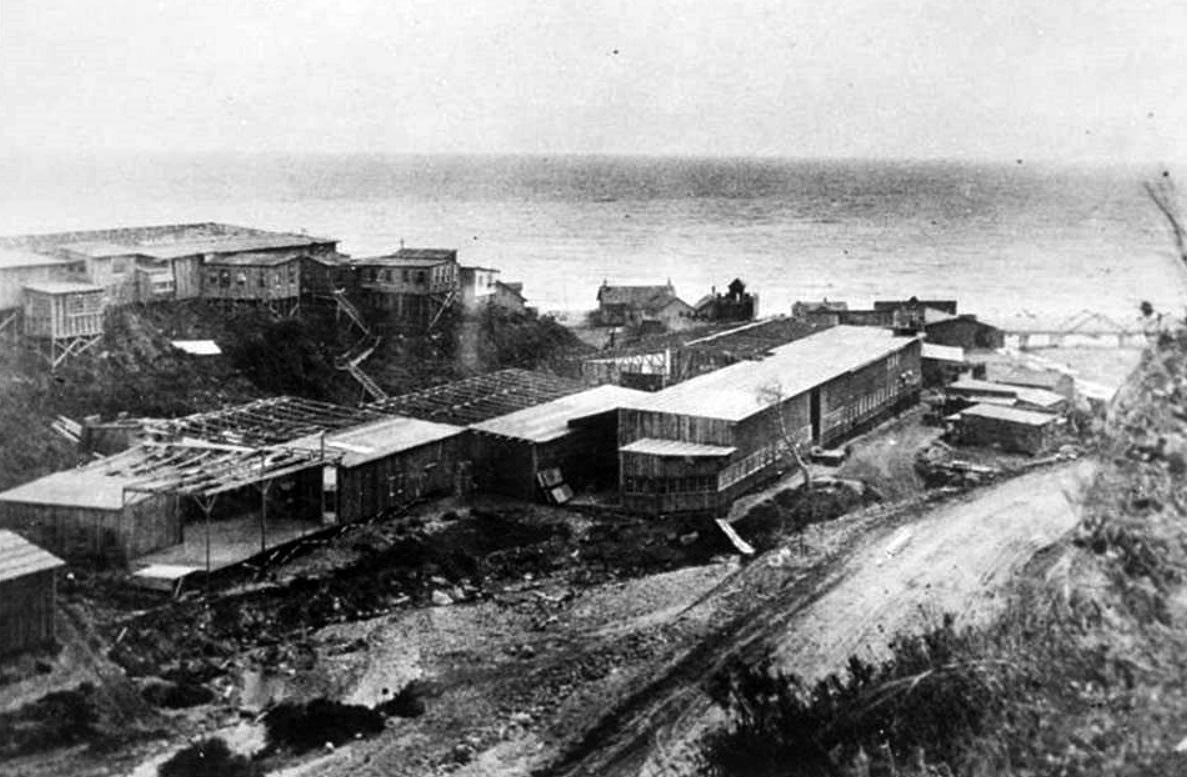 |
|
| (1916* - Looking down Sunset Boulevard with a view of silent film producer Thomas Ince's Inceville Studios in Santa Ynez Canyon. |
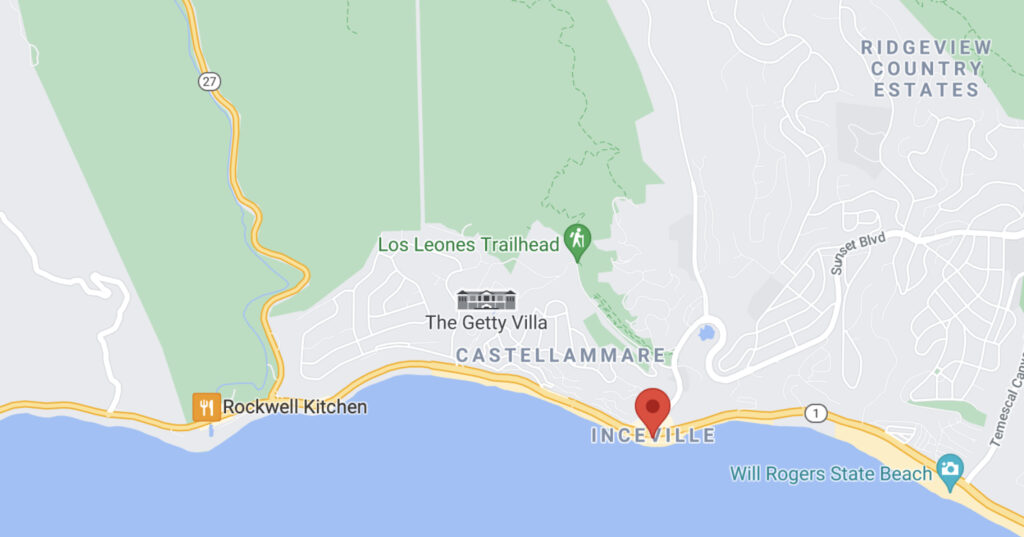 |
|
| Google map showing the location of Incville relative to where Sunset and PCH are situated today. |
Historical Notes By 1916, Ince was supervising eight directors and releasing one five-reel picture (about 50-minute films) each week at an average cost of $40,000. His film ‘Civilization,’ which employed over 25,000 extras, was by far his most ambitious endeavor. The set for the mythical city stood alone on the barren hills, where Marquez Elementary School is today. It was built by 60 carpenters over a period of three months at a cost of $80,000 and was used for only 100 feet of film. |
 |
|
| (ca. 1916)*^ - View of houses and stage sets at Incville. Large sign on one of the buildings reads: Triangle Ranch. |
Historical Notes Incville's cost continued to rise as moviegoers enjoyed the more expensive feature films, which used five reels or more. Ince, through his alliance with Triangle, a production company founded by D. W. Griffith and Mark Sennett, built a new studio in Culver City to use for indoor movies, while retaining Inceville for outdoor locations and Westerns. Ironically, on January 16, 1916, a few days after opening of his Culver City studio, a fire broke out at Inceville, the first of many which would eventually destroy all of the dry frame buildings. That same year, Ince gave up on Inceville and sold it to Hart, who renamed it Hartville. Three years later, Hart sold the lot to Robertson-Cole, which continued filming until 1922. |
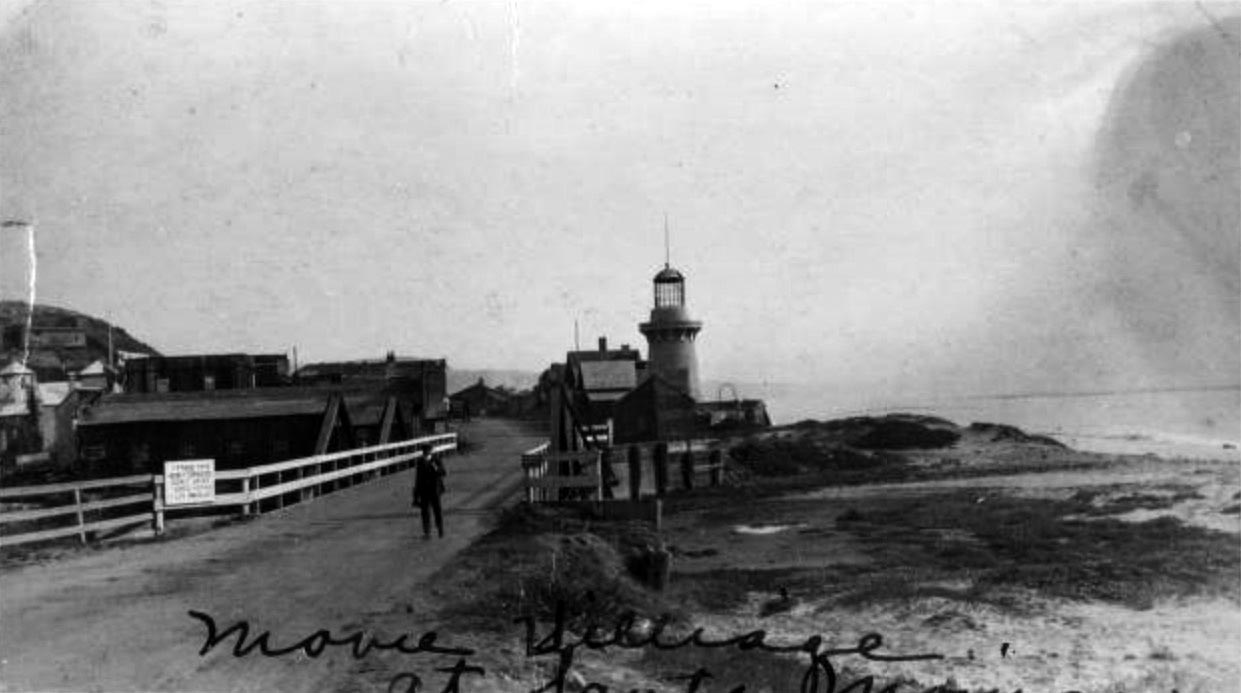 |
|
| (ca. 1915)* - View showing a man standing on a bridge leading to Inceville Movie Studio village on the beach at Pacific Palisades in Santa Monica. A sign on the bridge reads "Take this newly completed scenic drive Santa Monica Los Angeles." |
* * * * * |
Santa Monica North Beach
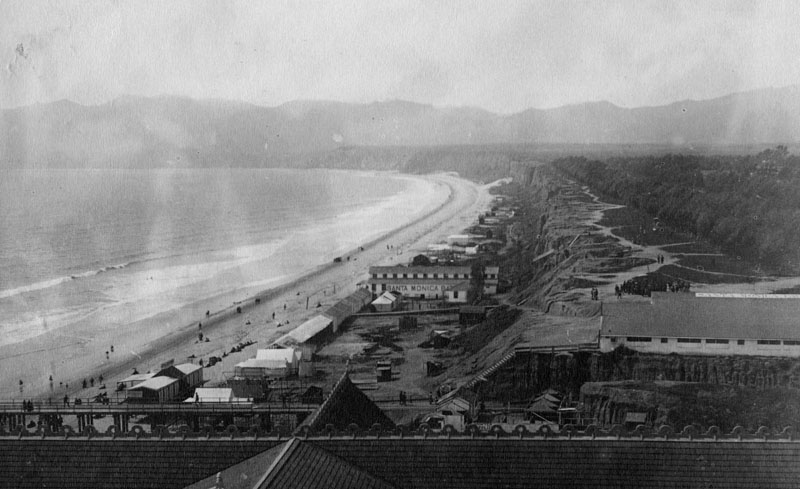 |
|
| (ca. 1891)* - View of Santa Monica beach looking north from the observation tower of the Arcadia Hotel. Palisades Park can clearly be seen to the right. |
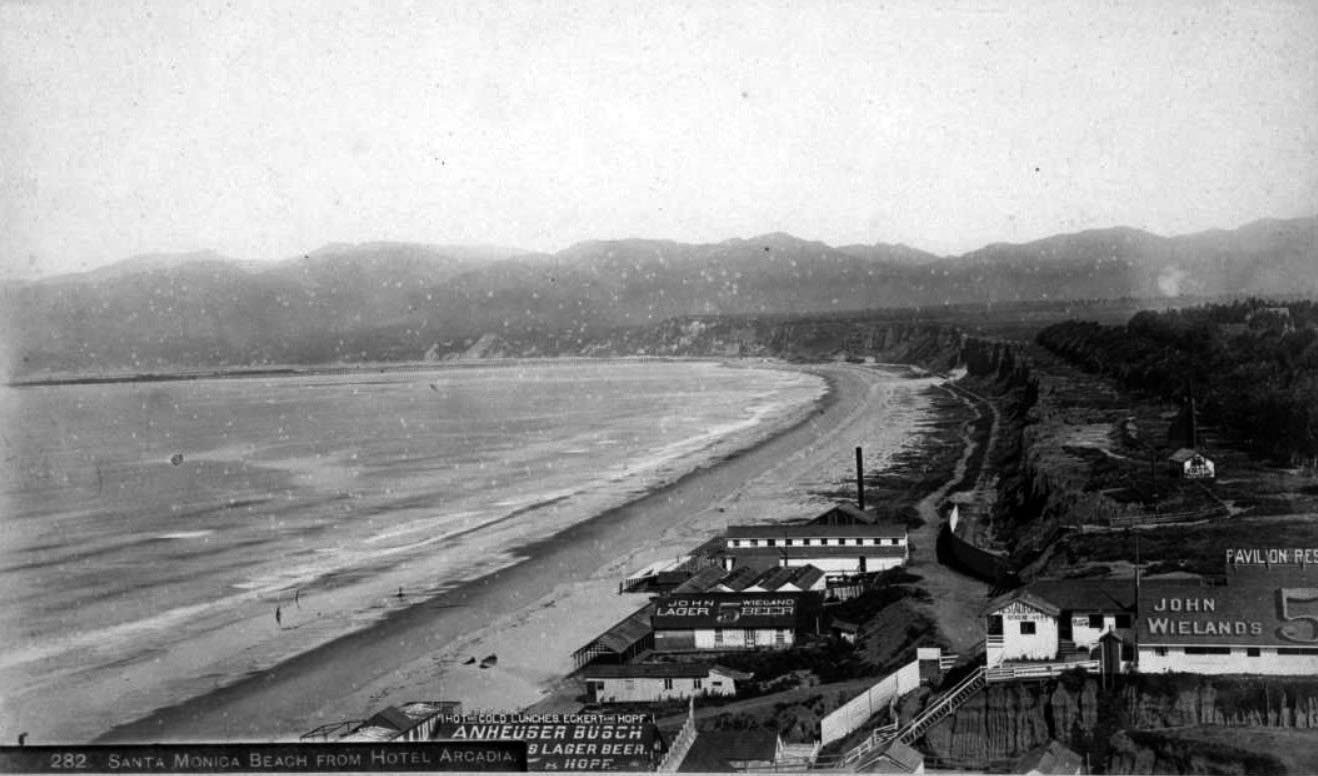 |
|
| (1893)#^^ - View showing restaurants on the North Beach, as seen from the Arcadia Hotel. Signs on the restaurants read "Hot and cold lunches, Eckert and Hopf, Anheuser Busch Lager Beer" "Pavilion Restaurant" and "John Wieland lager beer." The Santa Monica Bath House is seen beyond the "John Wieland" sign, with a bandstand shell on the bluffs above (in present-day Palisades Park) and the Long Wharf visible in the distance. |
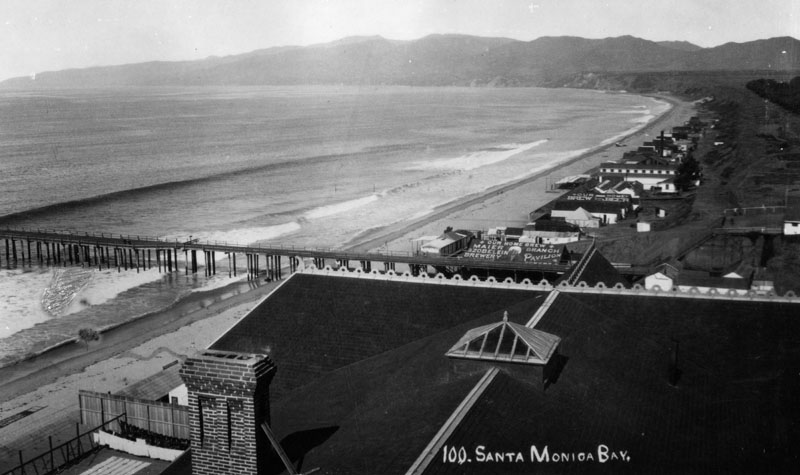 |
|
| (ca. 1893)* - View of Santa Monica beach looking north from the Arcadia Hotel observation tower. Palisades Park is on the right and the Santa Monica mountains can be seen in the distance. |
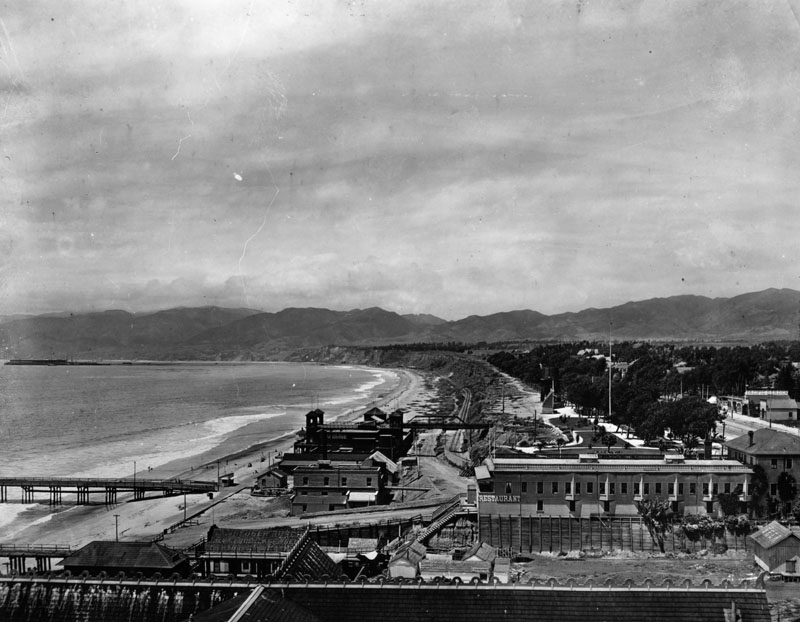 |
|
| (1898)* - This view of Santa Monica beach is looking north from the foot of Colorado Street. Ocean Avenue and Palisades Park can be seen on the right. The North Beach Bath House (dark building, center-left) is now in view. It was constructed in 1898. |
Historical Notes The Santa Monica Bath House was replaced by the North Beach Bath House in 1898. Two piers are seen in the above view. The lower pier is the remains of the Los Angeles & Independence Railroad Wharf. The pier further north is the North Beach Pier, built in 1898 (same year as the North Beach Bath House). |
North Beach Pier
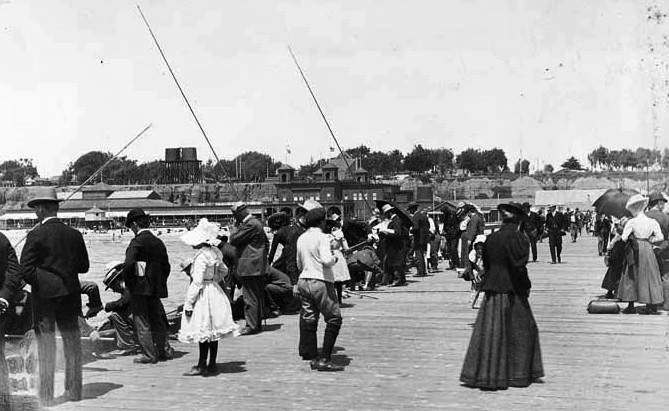 |
|
| (1898)^x^ – Crowds of people are seen enjoying the day on the newly constructed North Beach Pier. The North Beach Bath House, also constructed in 1898, can be seen in the background. |
Historical Notes The North Beach Pier was built adjacent to the North Beach Bath House in 1898. At 200 feet long, it was a place where guests of the North Beach Bath House could stroll. |
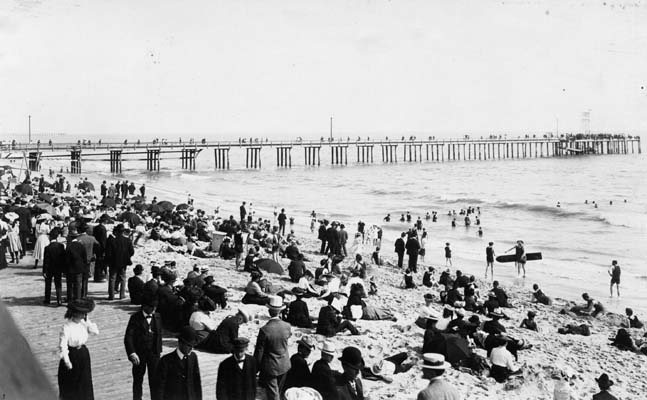 |
|
| (ca. 1898)* - View showing people walking on the boardwalk, sitting on the beach, and enjoying the surf with the North Beach Pier seen in the background. This was considered casual attire in the 1890s. |
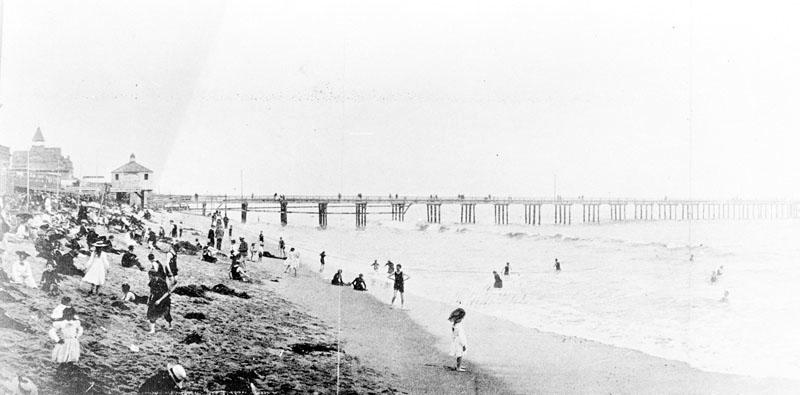 |
|
| (1898)* - Panoramic view of Santa Monica looking south from about the line of present Santa Monica Blvd. View is of the original bathing beach, or North Beach. The Camera Obscura building can be seen in the distance near the North Beach Pier. |
Historical Notes The remains of the 1875-built Los Angeles & Independence Railroad Wharf is further south closer to the Arcadia Hotel. |
|
Historical Notes The pipeline seen above is some form of discharge pipe that came out of the North Beach Bathhouse. |
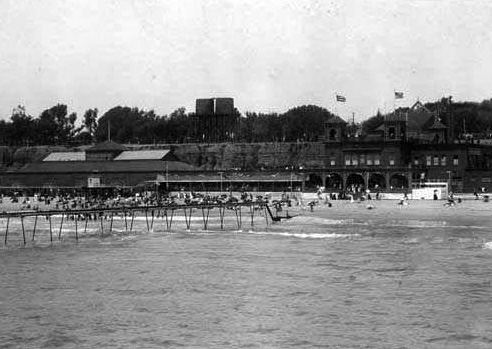 |
|
| (ca. 1898)^x^ – View as seen from the North Beach Pier looking toward the shoreline showing a pipe running from the North Beach Bathhouse out over the ocean. |
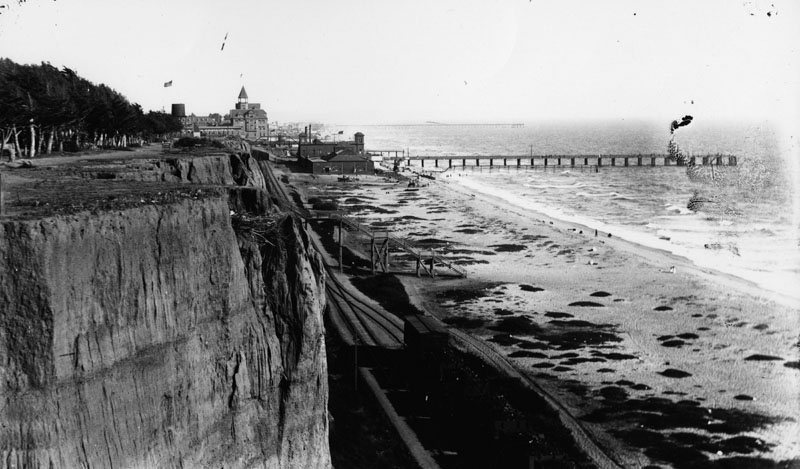 |
|
| (ca. 1898)* - View from Santa Monica palisades south toward the North Beach Pier and Bath House. A train runs along the beach at the foot of the cliffs. The Arcadia Hotel can also be seen in the distance. |
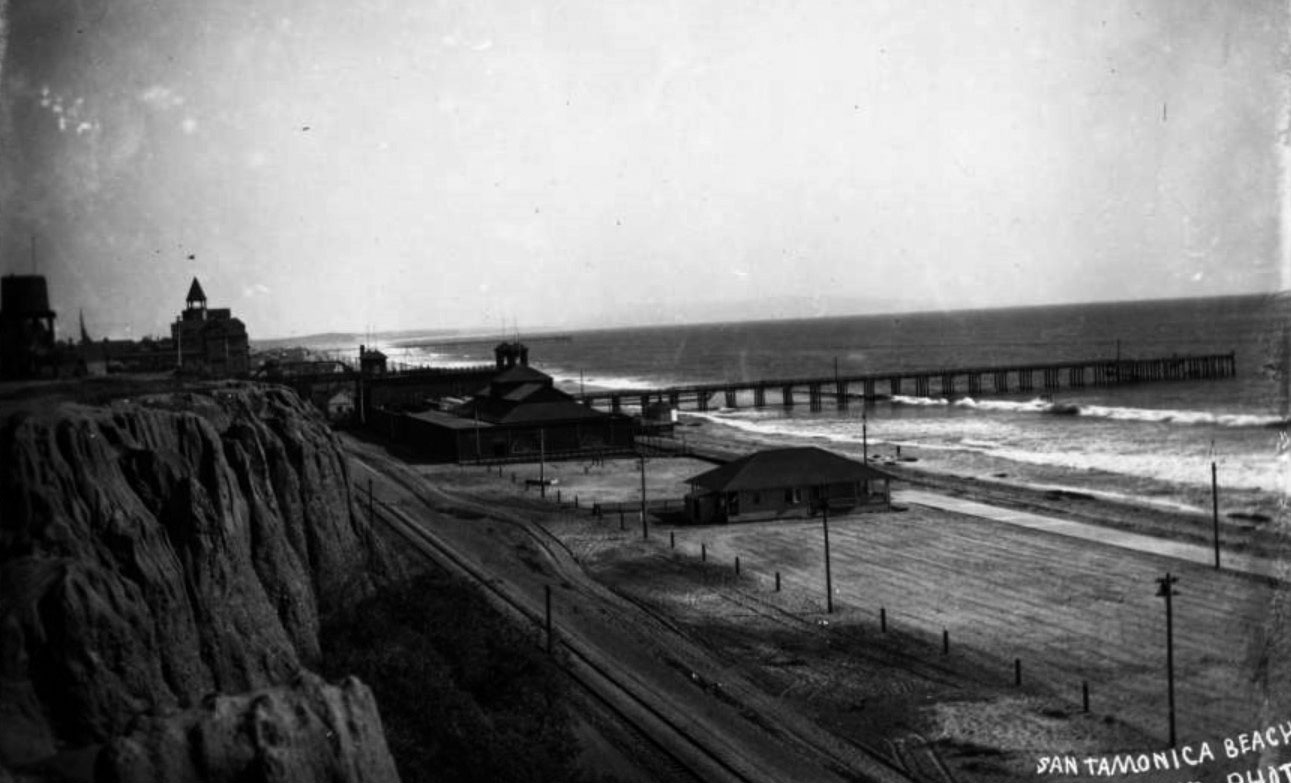 |
|
| (1901)^ - Image of the first house on the beach in Santa Monica, California, with the North Beach Bath House and North Beach Bath House Pier visible just south of the house, and the Arcadia Hotel, with one tower, in the distance. The Beach Road (which later became Pacific Coast Highway) and Southern Pacific Railroad tracks are seen behind the house next to the cliffs of Palisades Park, with a water tower at far center left. |
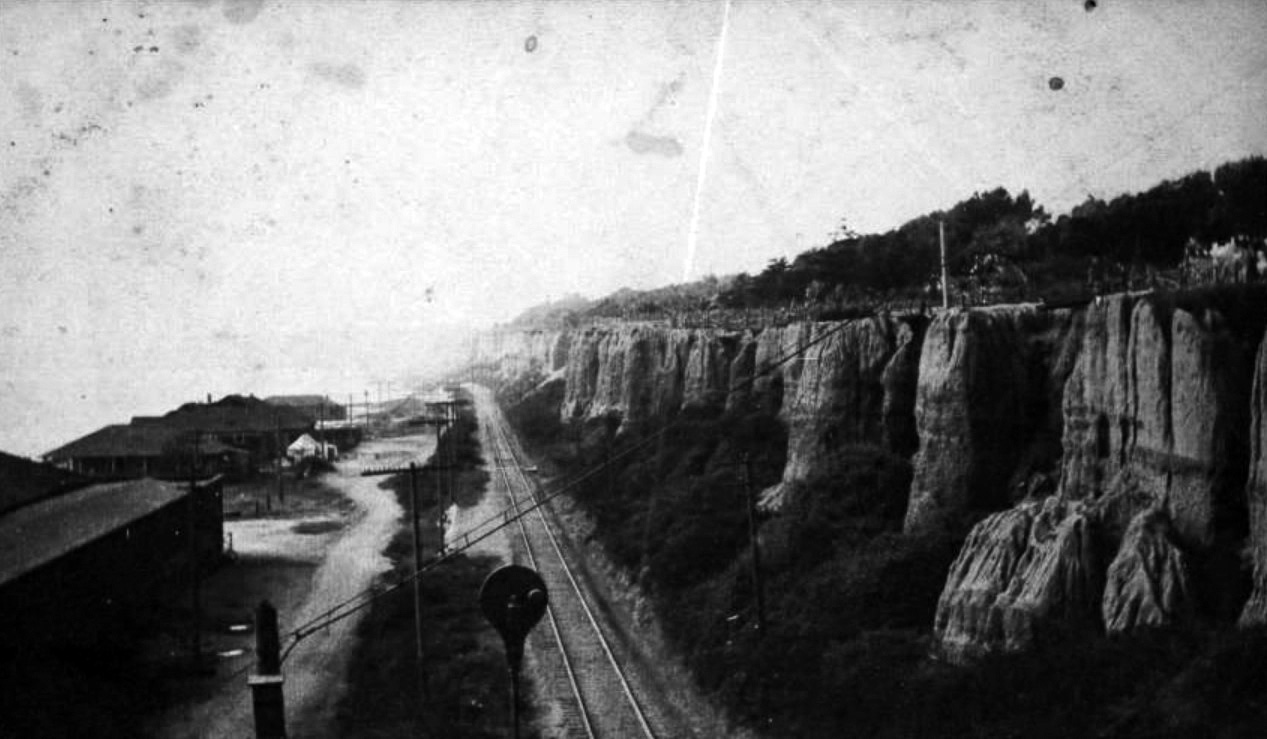 |
|
| (1900)^ - View looking north toward Santa Monica Canyon with North Beach Bath House and houses along Beach Road on the left. Also, railroad tracks and signal and Palisades Park cliffs at right. |
Santa Monica Electric and Power Co.
 |
|
| (ca. 1898)^ – View looking south toward the Arcadia Hotel showing a large building with tall smoke stack at center of photo. This was Santa Monica’s first large steam power plant operated by the Santa Monica Electric and Power Co. Note the oil storage tanks at lower-right. |
Historical Notes Santa Monica Electric and Power Company built a power house on the beach in the late 1890s. |
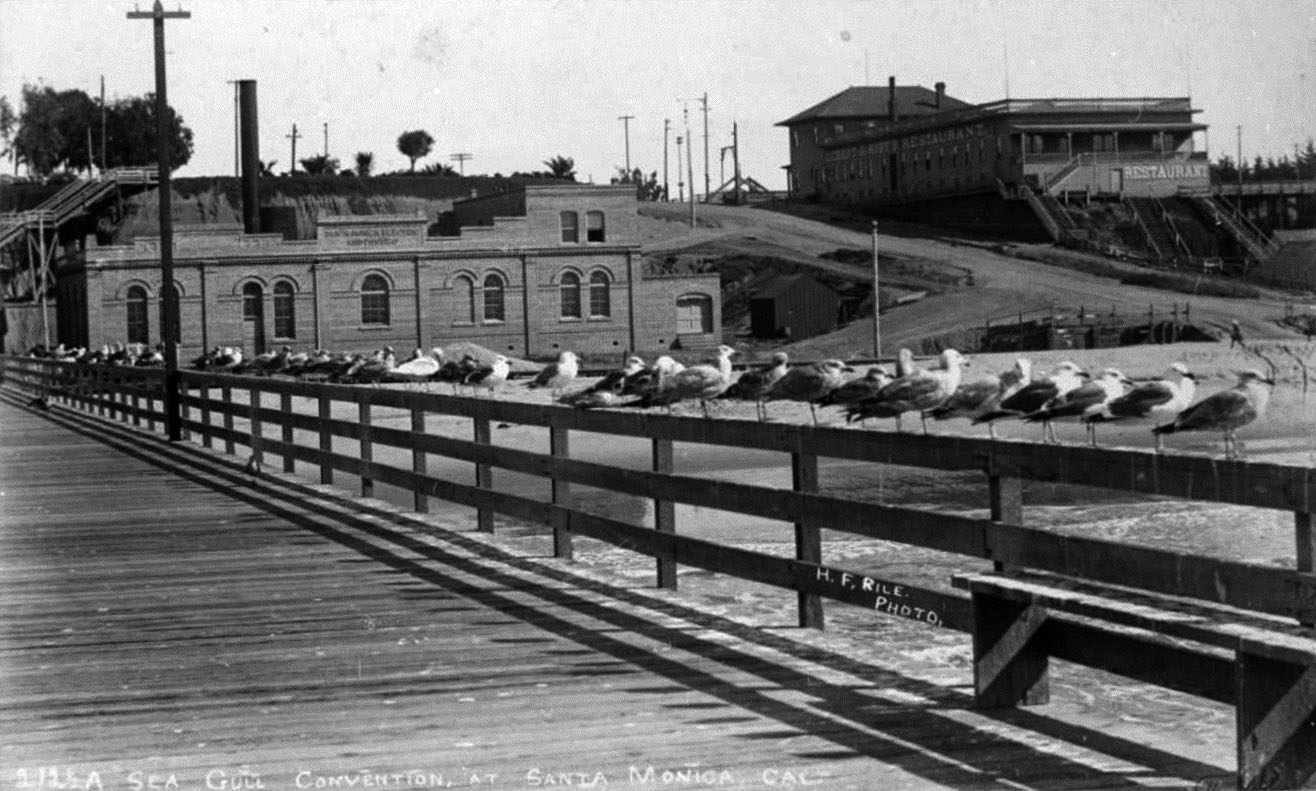 |
|
| (ca. 1900)^ - Postcard view showing a line of seagulls perched on a railing of the North Beach Bath House Pier. In the background is the brick Santa Monica Electric and Power Co. and Eckert & Hopf's Restaurant. Steps can be seen leading down from the Palisades bluffs. |
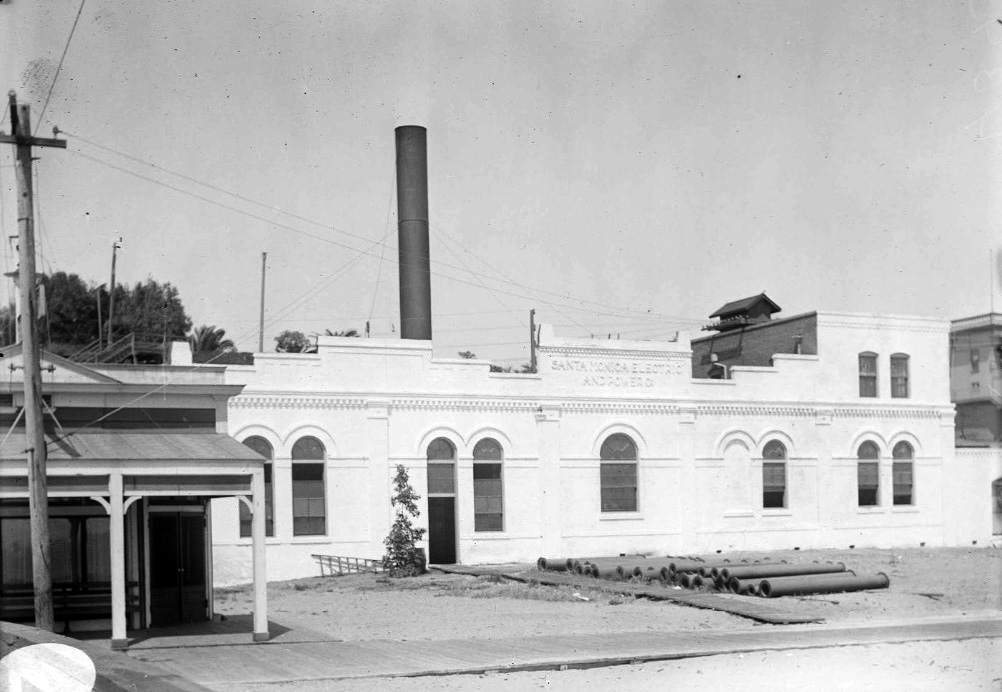 |
|
| (ca. 1900)^ - Close-up front view of the Santa Monica Steam Plant. The sign on the building reads: "Santa Monica Electric and Power Co." |
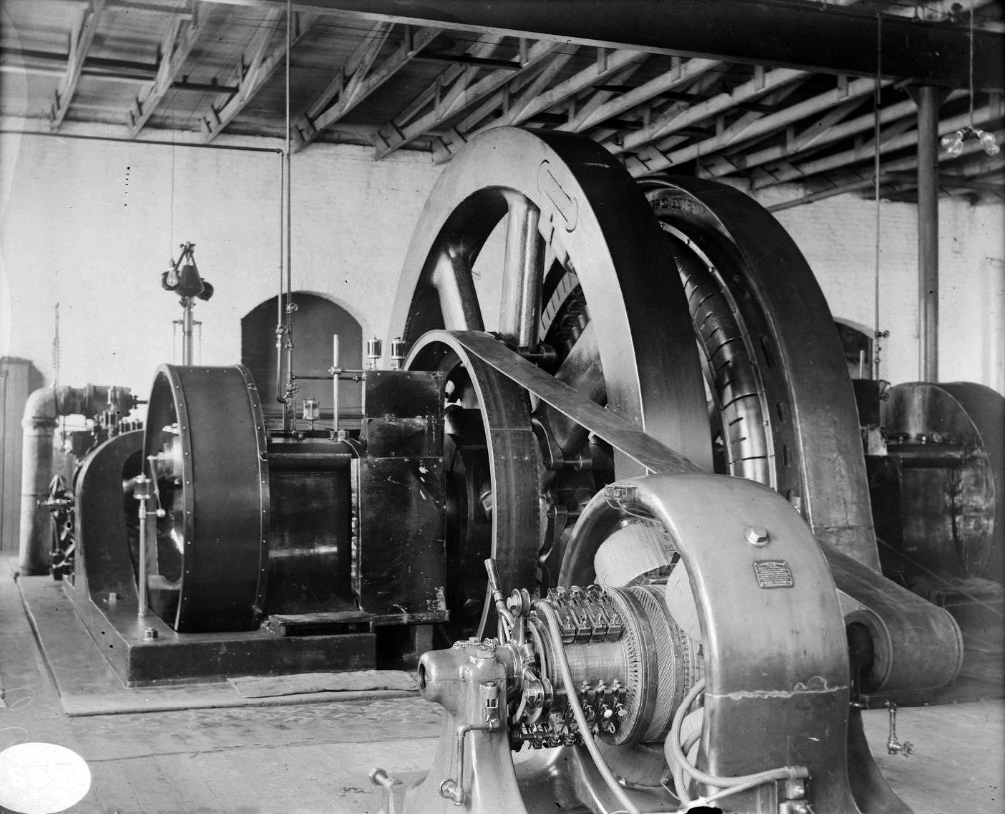 |
|
| (ca. 1900)^ – Interior view of Santa Monica Steam Plant showing steam turbine and generator of Unit 1. |
* * * * * |
North Beach Bath House
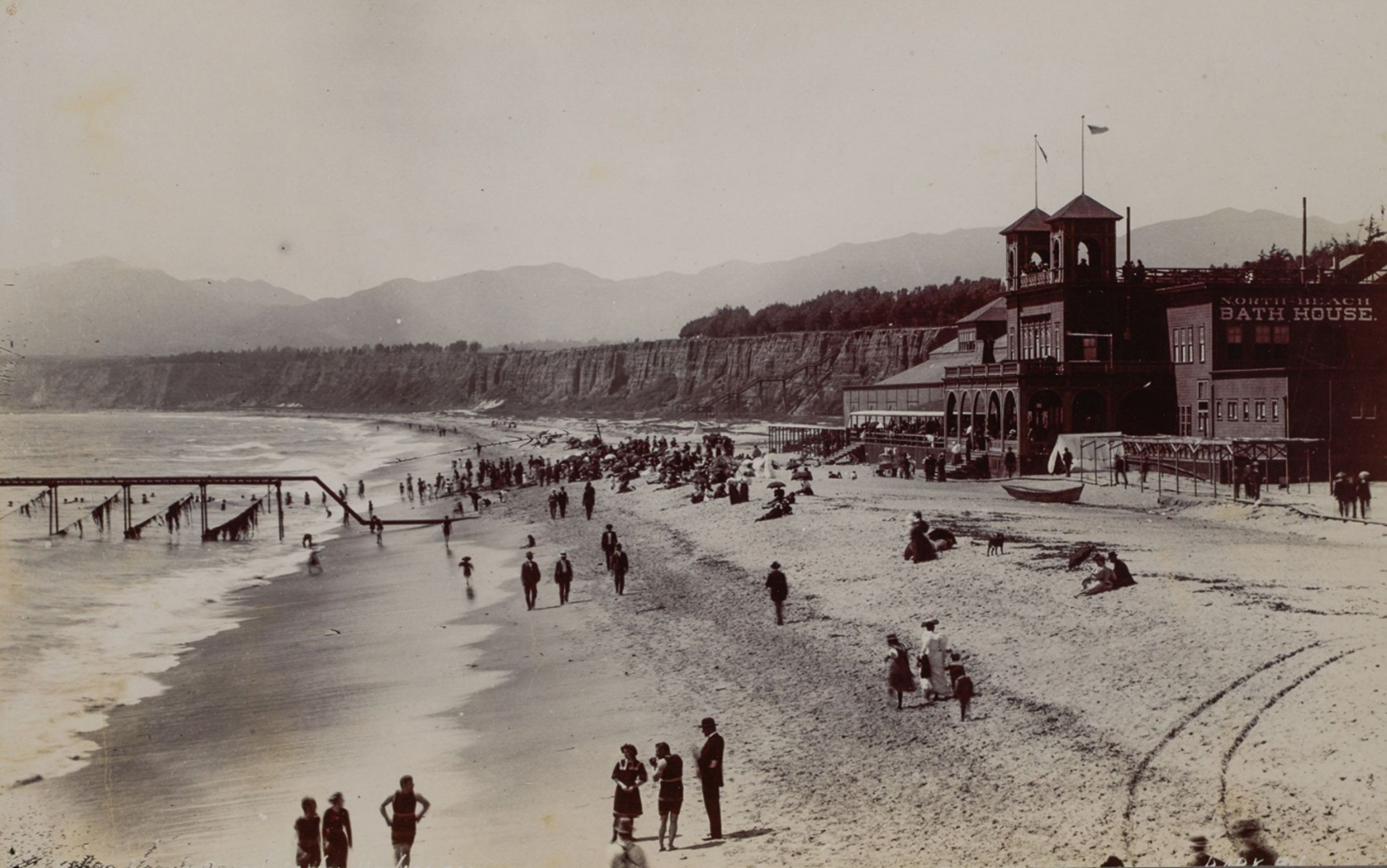 |
|
| (ca. 1900)* - Image of people in front of the North Beach Bath House dressed in clothes and bathing suits on the beach and in the water in Santa Monica. A pipe transporting sea water to the indoor plunge can be seen on the beach at left and a sign that reads "North Beach Bath House" is painted on the building at right. The "99 Steps" bridge can be seen coming from the Palisades cliffs in the distance. The warm salt water plunge is the long building at far left and the bathhouse is the building with the two towers. Photo of the Ernest Marquez Collection. |
Historical Notes The North Beach Bath House in Santa Monica has a rich history. It was opened on June 9, 1894, and was in service until 1910. The bathhouse was financed by Senator John P. Jones at a cost of $50,000 and was described as the "largest and finest of its kind on this Coast" by the Los Angeles Times. The structure was 440 feet long, two stories tall, and included a variety of features such as two large saltwater plunges, an ornate parlor, 300 dressing rooms, a rooftop garden/observation deck, a bowling alley, a ballroom, and the Pavilion Restaurant with three dining spaces. The architect behind this grand building was Sumner P. Hunt, who also designed the Southwest Museum in Los Angeles and the County of Los Angeles General Hospital. |
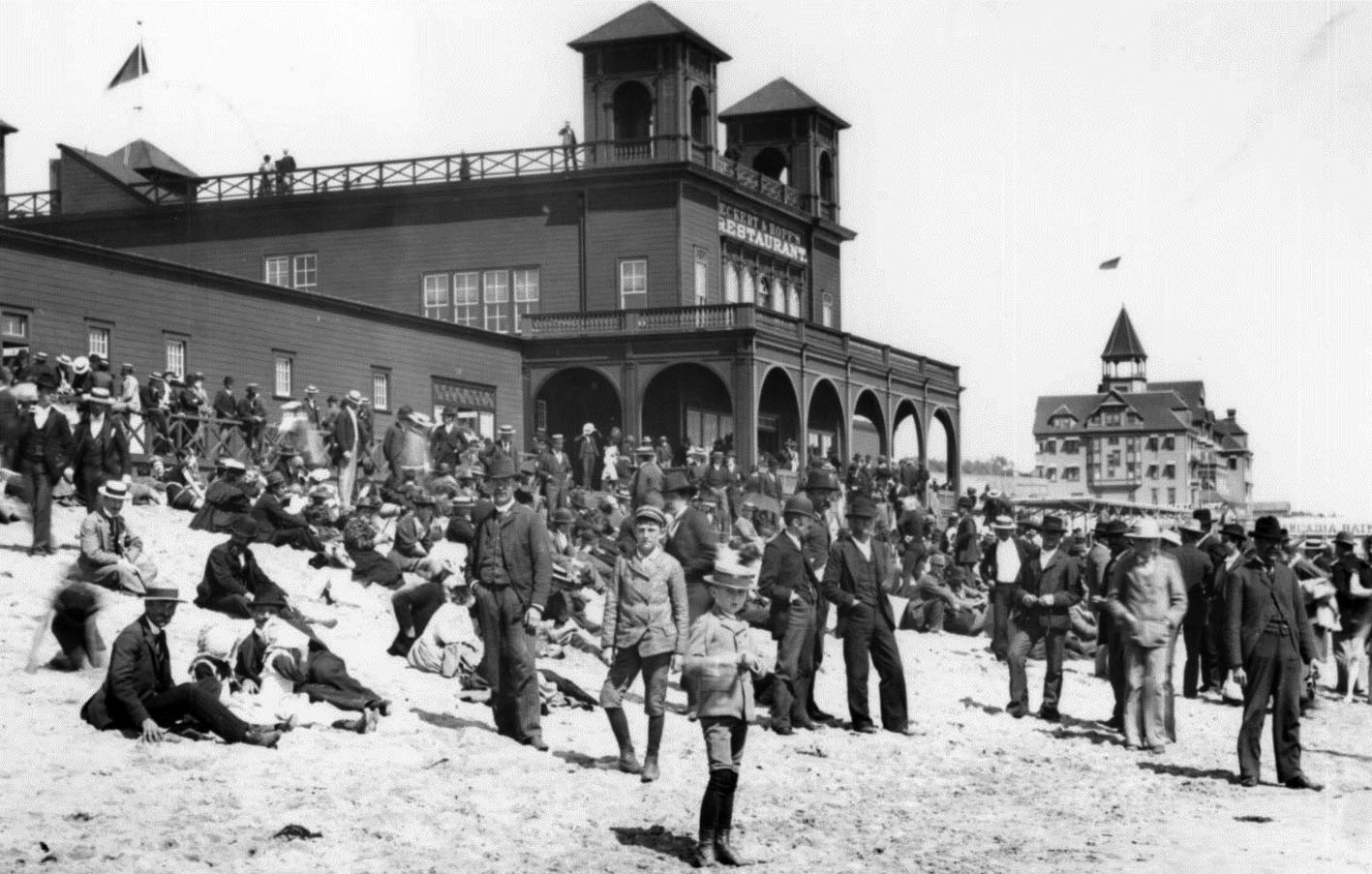 |
|
| (ca. 1898)* - Photograph of North Beach Bath House and Eckert & Hopf's Restaurant. The beach is crowded with fully clothed people. Another building is visible in the background. Flags are flying from all towers of both buildings. |
Historical Notes The North Beach Bath House was a popular attraction, drawing large crowds for its amenities and the beach experience it offered. It was eventually torn down in 1911 to make way for more modern structures, as noted in a 1912 Los Angeles Times article. The bathhouse was part of a broader development in Santa Monica that included the nearby landmark Hotel Arcadia. |
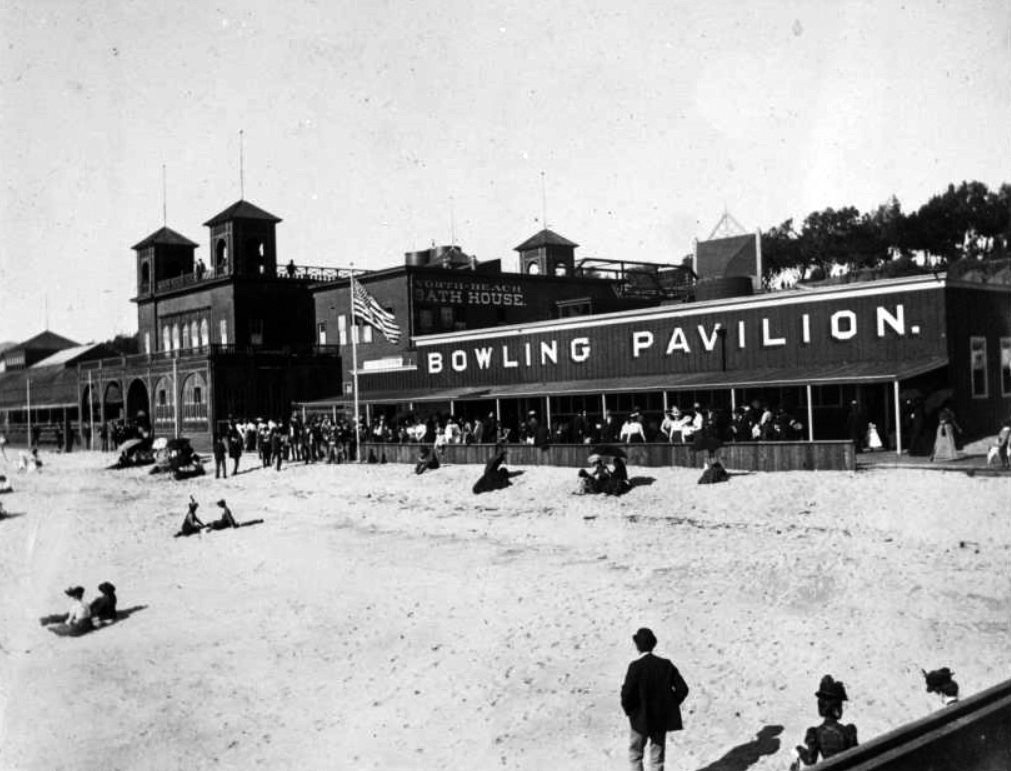 |
|
| (1898)^ – View showing people in front of the North Beach Bath House and Bowling Pavilion on the beach and boardwalk and carrying umbrellas. An edge of the North Beach Bath House Pier can be seen at bottom right. |
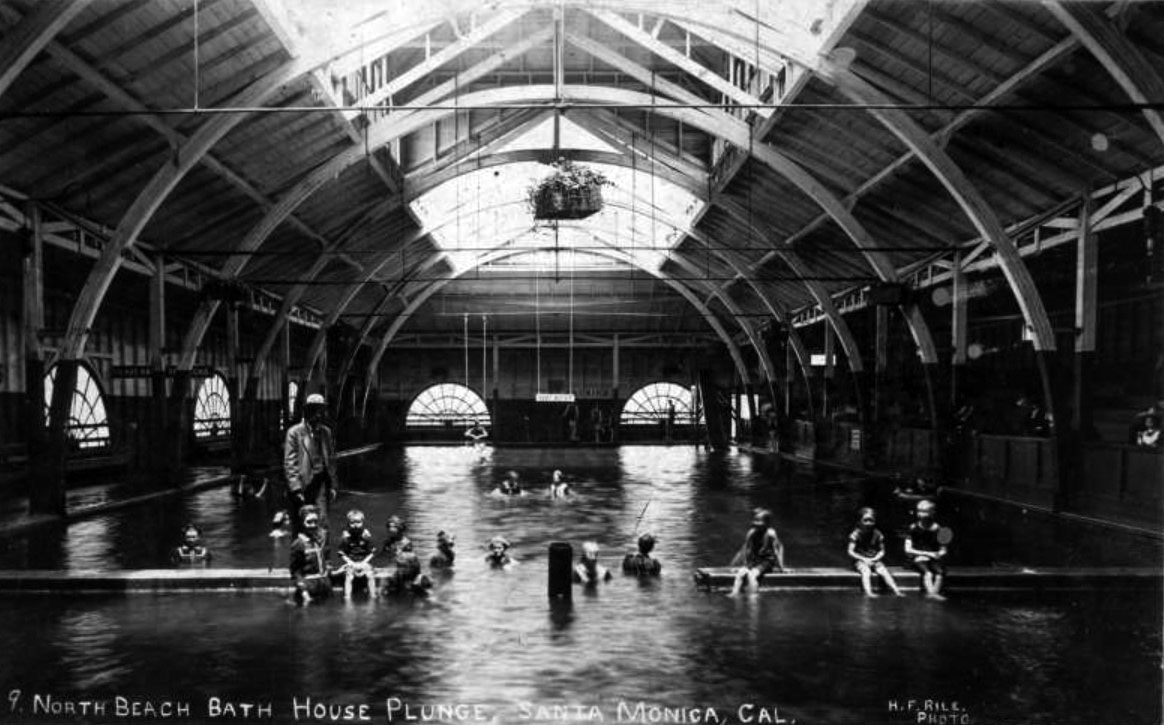 |
|
| (1901)^ - Image of people, including children, swimming in the North Beach Bath House salt water plunge in Santa Monica. A sign that reads "deep water" hangs at the center of image above the indoor pool. |
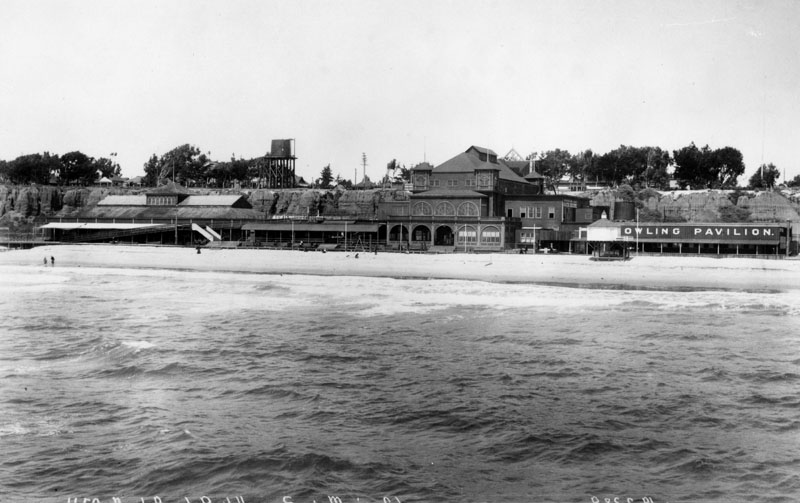 |
|
| (ca. 1900)* - View of Santa Monica North Beach from the pier's end. At center is the North Beach Bath House. To the right are the Camera Obscura and Bowling Pavilion. |
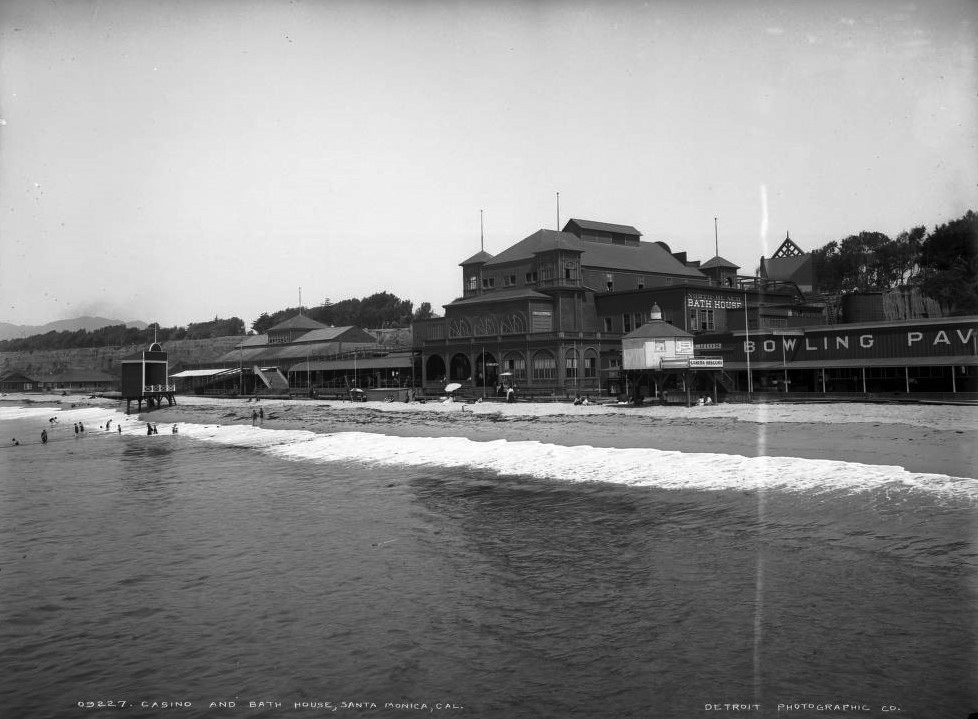 |
|
| (ca. 1900)* - View of the North Beach Bath House and casino at North Beach in Santa Monica. People mingle in front of Bath House while others swim or sit on the beach. Shows a bowling alley. Signs read: "North Beach Bath House" "Camera Obscura" "Bathing Suits" and "Bowling Pavilion." |
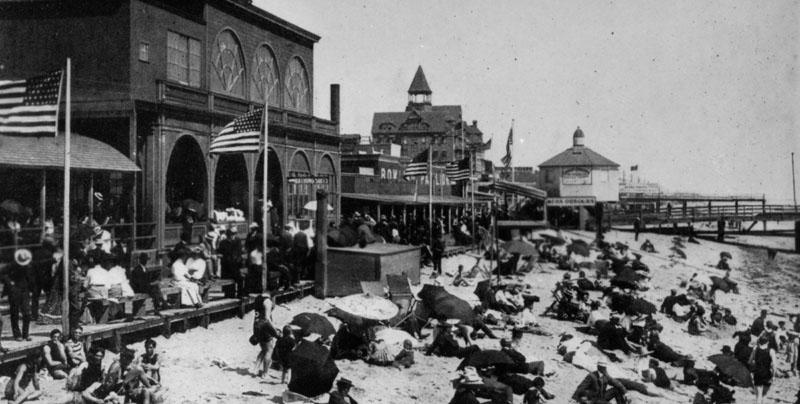 |
|
| (ca. 1898)* - Crowds of people are shown enjoying the day on the beach in front of the North Beach Bath House. The Camera Obscura building is in the background. |
* * * * * |
Camera Obscura
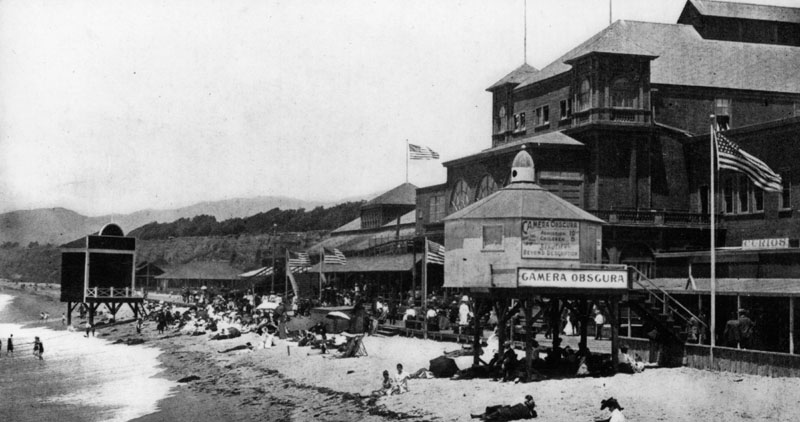 |
|
| (ca. 1898)* - Exterior view of Camera Obscura can be seen in the foreground. The beach scene and North Beach Bath House can be seen in the background. |
Historical Notes The Santa Monica Camera Obscura was an optic device built in 1898 by Robert F. Jones, nephew of Senator John P. Jones, the founder of the City of Santa Monica. “Camera Obscura” means darken chamber. It is a darken room in which the device allows a 360 degree view of the outside surroundings. Sort of like a pinhole camera, a hole in the roof allows light from outside pass through the hole striking a white board where the image is shown in color but upside down. The camera obscura was known to earlier scholars since the time of Aristole. |
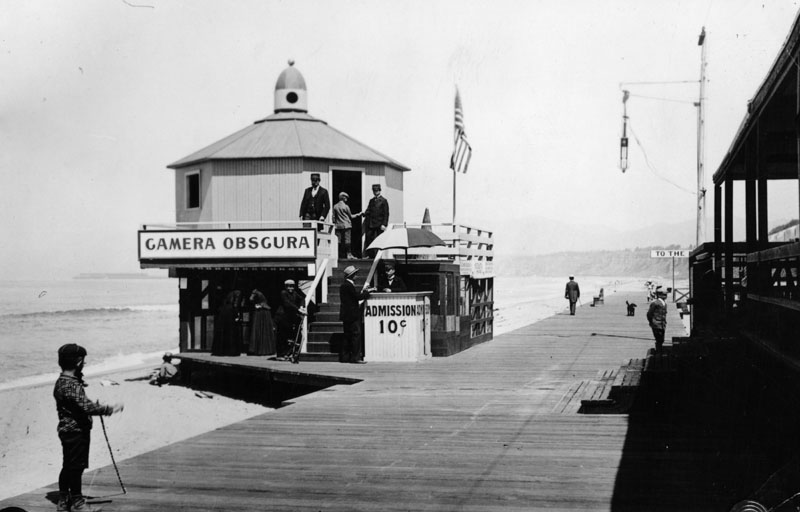 |
|
| (ca. 1900)* - Photo shows Camera Obscura located on the boardwalk of Santa Monica beach. The attendant is seen collecting a 10-cent admission fee from a young man before he enters the darkened chamber. |
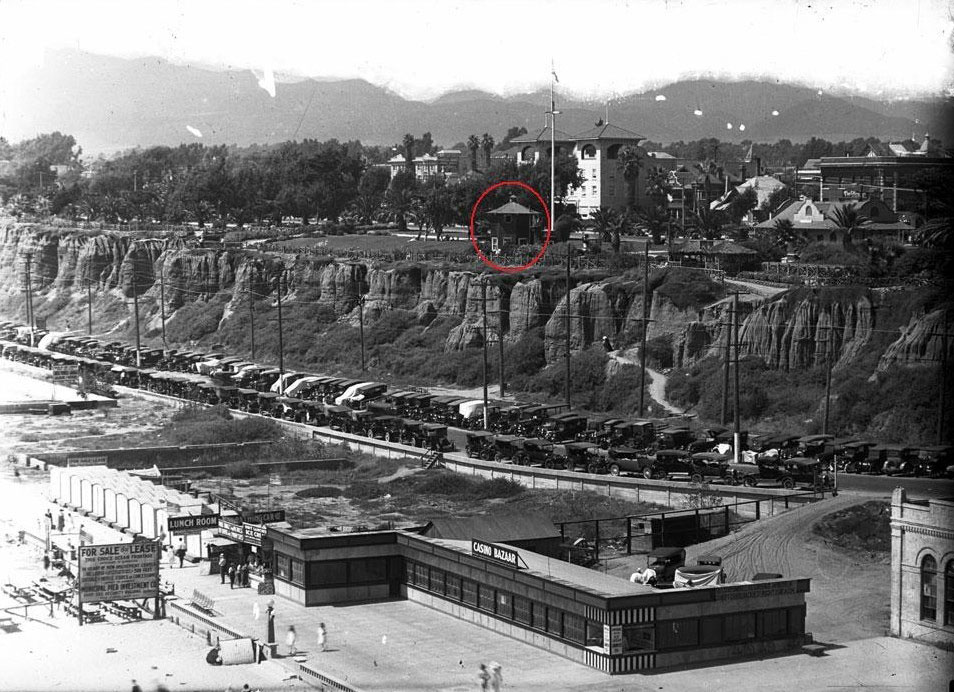 |
|
| (ca. 1907)**^ - View of the Camera Obscura after it was relocated to the top of the Palisades Bluffs. |
Historical Notes In 1907, the Camera Obscura was given to the city and then relocated to the top of the bluffs. The camera spent almost 50 years documenting life on the Santa Monica beach. |
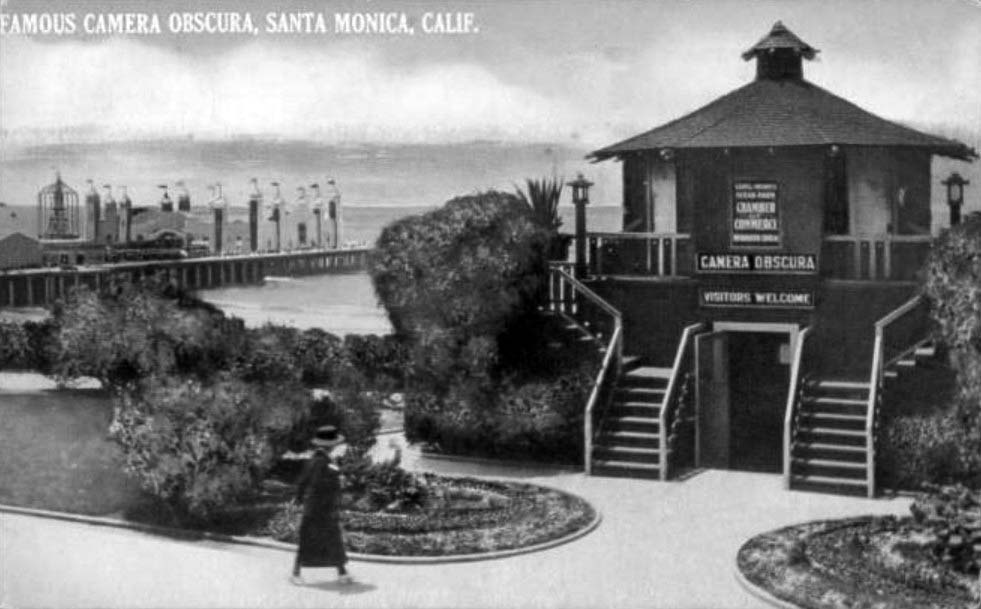 |
|
| (ca. 1924)* - Postcard view of the famous Camera Obscura, Santa Monica. The structure is a double stairway leading up to a second floor with an open door seen between the two staircases. The surrounding grounds are landscaped with large bushes and flowers planted half circles. In the background to the left is a pier with large buildings built upon it. A woman wearing a hat walks in the foreground. To the left is the Beautiful La Monica Ballroom, opened in 1924. |
Historical Notes In 1955 the Camera Obscura was installed in the nearby Senior Recreation Center at 1450 Ocean Boulevard where it can still be seen today. Many images of the popular beach community throughout the years are on display to compare to the current view. |
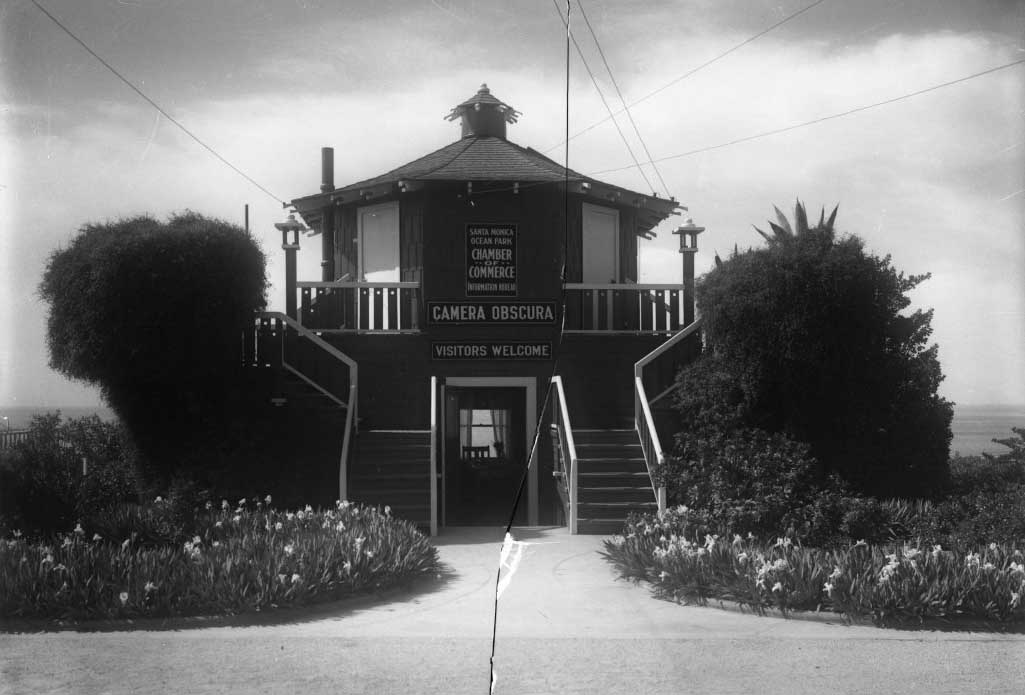 |
|
| (ca. 1920)* - Camera Obscura, Linda Vista Park (later Palisades Park). |
Historical Notes Linda Vista Park was renamed Palisades Park in the 1920s. |
* * * * * |
 |
|
| (ca. 1895)* - A panoramic view of one of the ocean piers and parks along the ocean before 1900. Huge cowds are on the pier and on the beach next to it. |
Historical Notes In 1895, Abbot Kinney acquired the deed to the coastal strip previously purchased by W.D. Vawter and named the area Ocean Park. It became his first amusement park and residential project. A race track and golf course were built on the Ocean Park Casino. After a falling out with his partners he focused on the south end of the property, which he made into Venice of America. Click HERE to see more in Early Southern California Amusement Parks. |
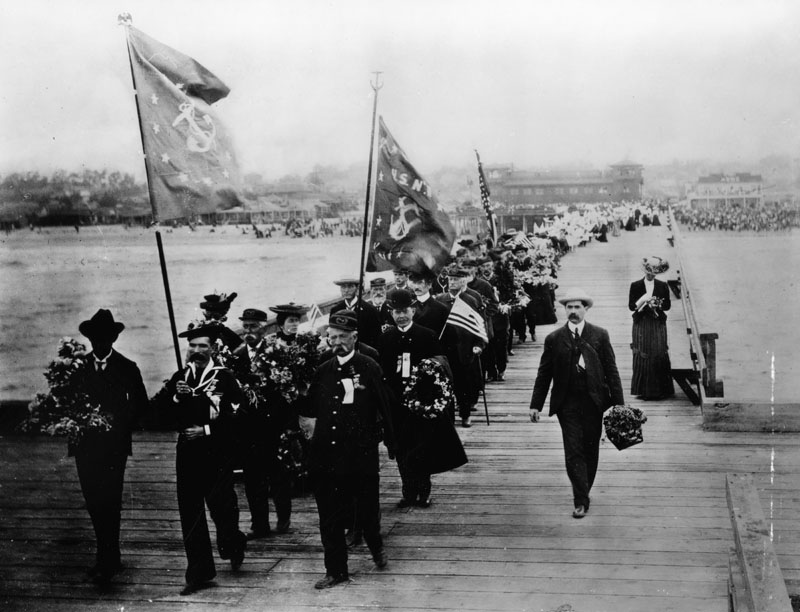 |
|
| (ca. 1900)* - A long parade line, led by U.S. Navy flag bearers, walks across a pier carrying flowers to be thrown from the pier into the water at the foot of Colorado Ave. |
Historical Notes Formerly known as Decoration Day, Memorial Day originated after the American Civil War to commemorate the Union and Confederate soldiers who died in the Civil War. By the 20th century, Memorial Day had been extended to honor all Americans who have died while in the military service.*^ |
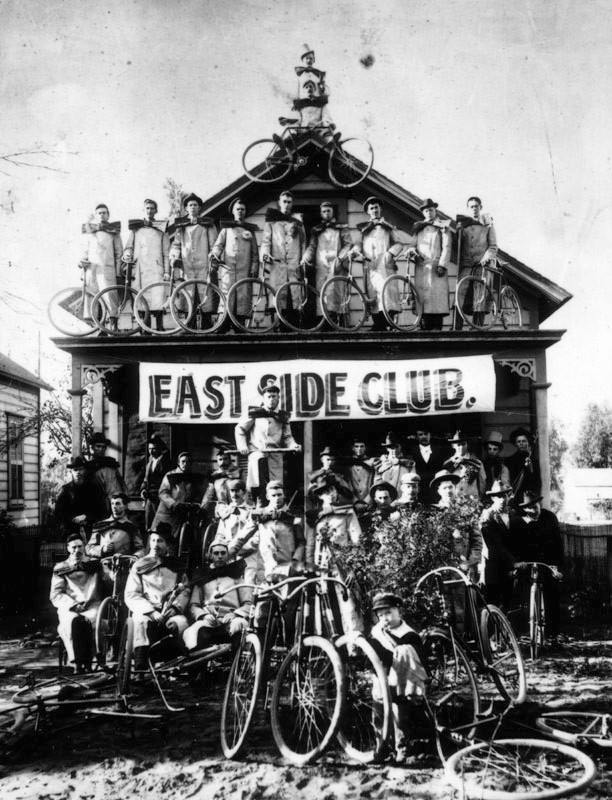 |
|
| (ca. 1898)* - Group photo of the East Side Cycle Club, showing a banner for the club, taken on the beach at Santa Monica near the old North Beach Bath House. The riders are wearing overcoats and over-sized bows. |
Los Angeles Pacific Electric Railway
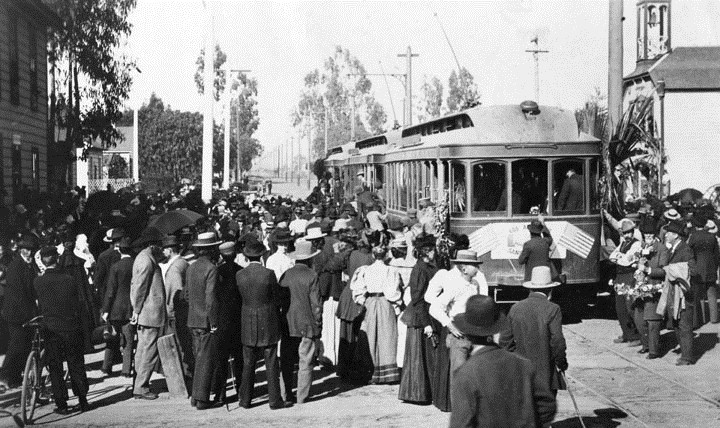 |
|
| (1896)* - Opening of the Los Angeles Pacific Electric Railway from Los Angeles to Santa Monica, April 1, 1896. The extensive Pacific Electric Railroad easily transported to the beaches people from across the Greater Los Angeles Area. |
Historical Notes The Los Angeles Pacific Railway was built by Eli Clark and Moses H. Sherman, for whom Clark Drive, Shermanton (now West Hollywood), and Sherman Avenue (now Santa Monica Boulevard) were first named. They were early pioneers of interurban electric railways that laid track from downtown to the sea. Their Los Angeles to Santa Monica line opened on April 1, 1896 to an excited beach crowd in Santa Monica.*# |
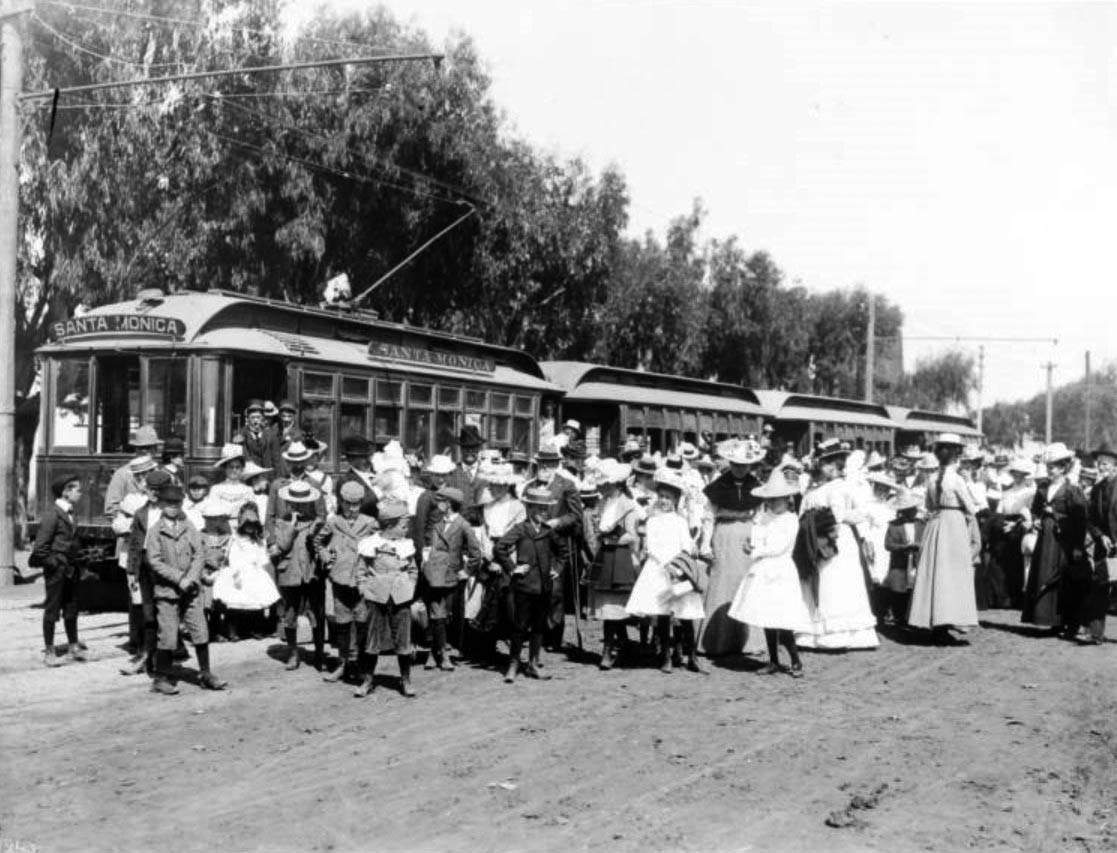 |
|
| (1896)** – View showing a crowd of people gathered for opening day of the electric car line in Santa Monica, April 1, 1896. The men, women and children are piling off of four cars at center. The finely-dressed crowd stands in front of the cars in the foreground while trees hang over the cars from the left side. |
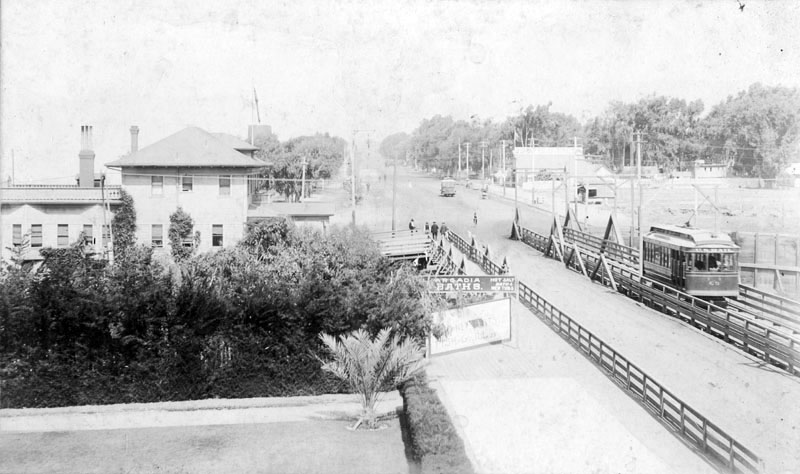 |
|
| (1896)* - View is looking north across the bridge on Ocean Avenue, from the Arcadia Hotel. A trolley can be seen on the right. In the middle of the photograph, a sign reads "Arcadia Baths, hot salt baths, new tubs." |
Whitaker Ranch
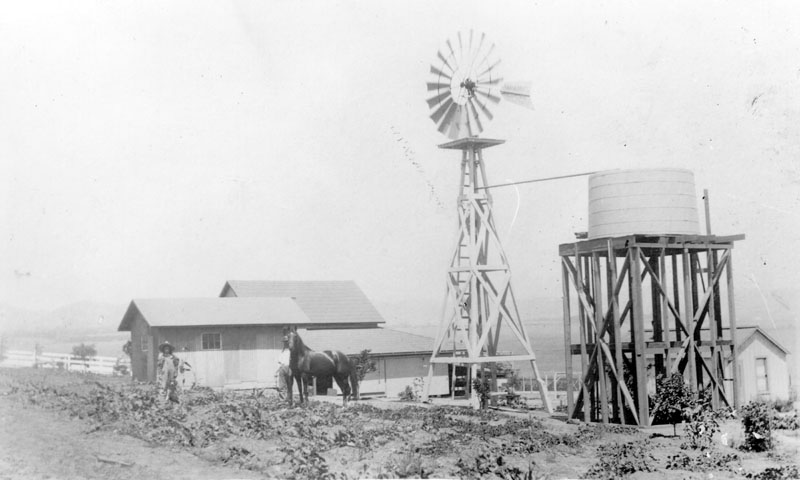 |
|
| (1897)* - Original wooden house and barn on the Whitaker Ranch located on Centinela Avenue in Santa Monica. Two men and a horse can be seen standing in the small field closest to the house, and a windmill and water tank are visible on the right. The Santa Monica Airport is now located in this same location. |
Historical Notes Santa Monica Airport was originally called "Clover Field" after World War I aviator Lieutenant Greayer "Grubby" Clover, and was home of the Douglas Aircraft company. The first circumnavigation of the world by air took off from Clover Field on St. Patrick's Day, March 17, 1942. At one point, it was the site of the Army's 40th Division Aviation, and became a Distribution Center after World War II.* |
Vawter Carnation Fields
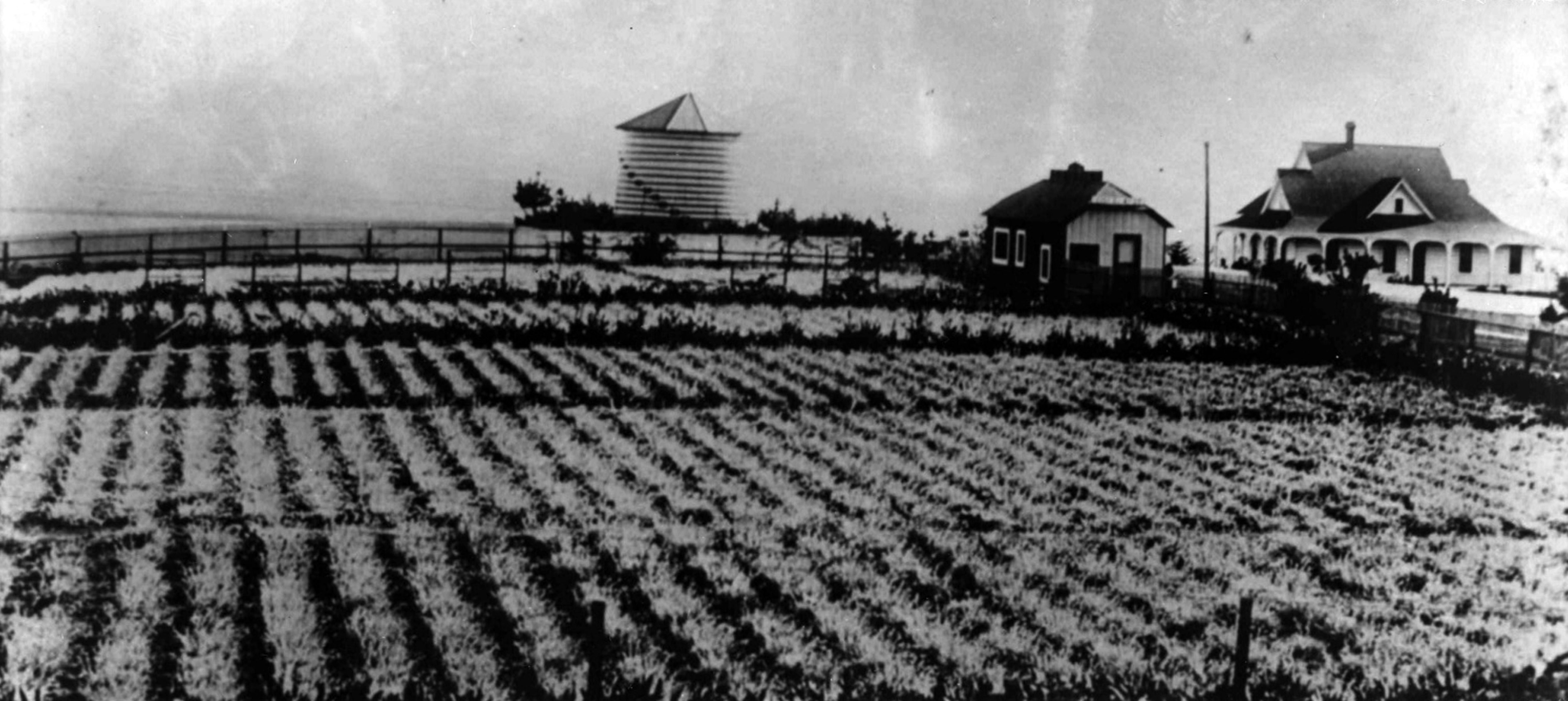 |
|
| (ca. 1900)* - Carnation field, silo, and a home, located at 4th Street and Marine Street in the Ocean Park neighborhood of Santa Monica. The property belonged to Edwin J. Vawter, a pioneering Santa Monica businessman. |
Historical Notes Edwin J. Vawter, was from a pioneering Santa Monica family. His father established Santa Monica's first general store and First National Bank. A 1901 guidebook (Wilson's Illustrated and Descriptive Souvenir and Guide to Los Angeles and Near-by Towns) described the carnation fields thus: "One of the most beautiful attractions [in Ocean Park] is the carnation field of Mr. E.J. Vawter. It is situated on a ridge overlooking the grand old Pacific. Here carnations are in full bloom summer and winter." It was probably helpful that Mr. Vawter was also in charge of the city water company. |
Ocean Park Pier
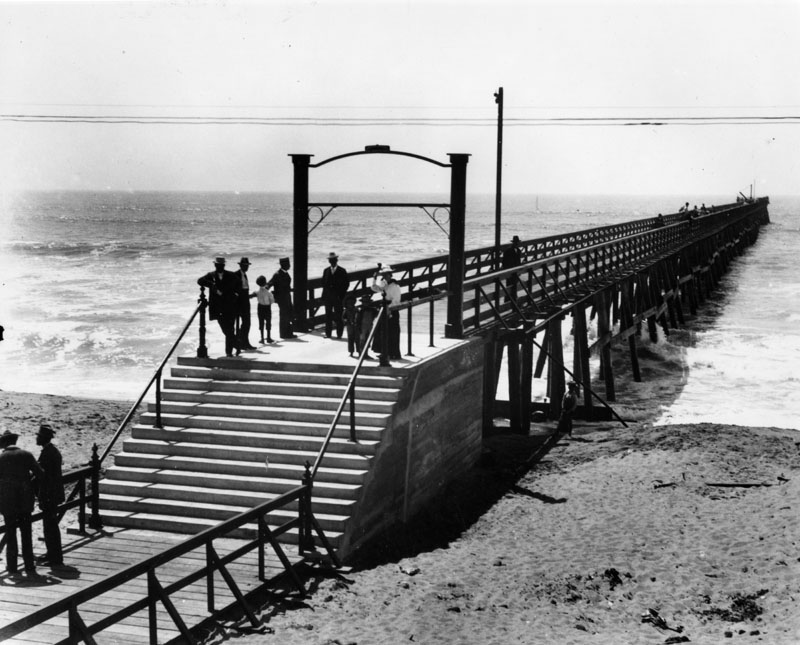 |
|
| (ca. 1897)* - A view of the 500 ft. long Ocean Park Pier, built by the Santa Fe Railroad in 1895. This view shows several people standing on the pier as we look towards the ocean. |
Historical Notes In 1891, Abott Kinney and (silent partner) Francis G. Ryan purchased a 1-1/2 mile long, narrow strip of sand dunes along the shore line south of Santa Monica extending from Strand Street to Brooks Avenue from a Captain Hutchinson. To encourage building, water was brought in, the tract was sewered, board walks laid, and lots leased to persons desiring to put up small cottages. That same year, Kinney & Ryan (Ocean Park Development Company) built a pier, golf course, horse-racing track, boardwalk and other resort amenities on the northernmost edge of their holdings. They would also give 12 acres to the Santa Fe Railroad so they would extend their Inglewood line north to Kinney and Ryan’s resort. In 1893, Kinney and Ryan began selling small 25 x 100 foot beach lots priced at $100 and featured piped water. Tents were erected on the unsold lots and were available to campers for summer rental. Frederick Rindge, who was president of the Los Angeles YMCA, founds a YMCA summer camp on 5 acres of land located on 250ft beach front near Hill St., donated by Kinney who hopes that the YMCA camp will attract people to his beach resort.* |
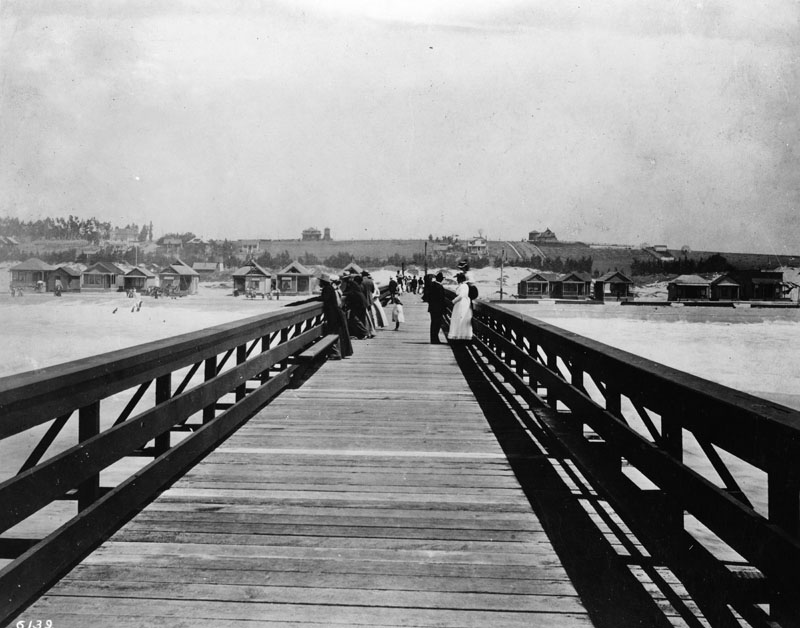 |
|
| (ca. 1897)* - A view of the 500 ft. long Ocean Park Pier, built by the Santa Fe Railroad in 1895, and located about 300 feet south of Hill St. Here we are standing on the pier looking toward Ocean Park itself. |
Historical Notes Kinney and Ryan’s original resort consisted of 150 beach cottages, and a small commercial district along Pier Avenue. A building boom added 40 new beach cottages, several stores, and Kinney’s new 40 acre Ocean Park race course and golf links. The resort would be subdivided and sold to more developers and by 1902, there were over 700 cottages in Ocean Park.* |
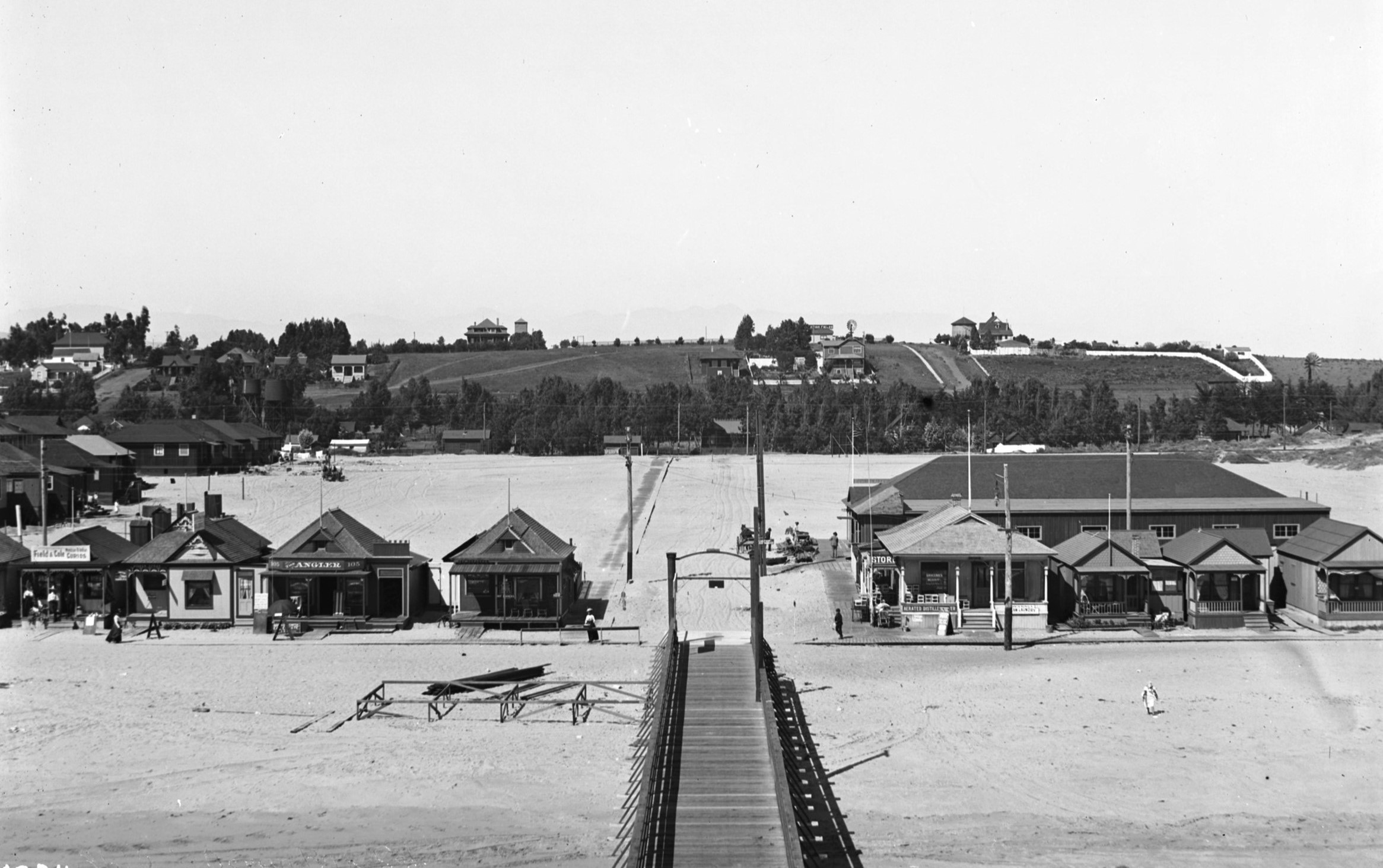 |
|
| (1898)* - Closer view of Kinney and Ryan's beach cottage resort located near Ocean Park Pier. |
Historical Notes In 1898, Ryan died and his widow married Thomas Dudley of Santa Monica who becomes Kinney's new partner. After 1904, Kinney moved his attention to his Venice of America development (also called Ocean Park at the time) , south of the Santa Monica city boundary. The history of Venice and Ocean Park are intertwinned. From 1905 to 1925, Ocean Park was developed by people such as Fraser, Merritt Jones, Hart, Hollister and Wadsworth. |
* * * * * |
Santa Monica Palisades
 |
|
| (ca. 1889)* - Looking south from the '99 steps' toward the Arcadia Hotel. In the upper left can be seen a man sitting on a bench very close to the edge of the palisades (This area would become Palisades Park). The stub of the Los Angeles and Independence Railroad Wharf can also be seen. |
Historical Notes Originally known as “Linda Vista Park,” Palisades Park was the first officially-designated public open space in Santa Monica. The land was donated to the City by Santa Monica's founder, Senator John P. Jones, in 1892. The Los Angeles and Independence Railroad Wharf was in use between 1875 and 1879, at which time it was purchased by the Southern Pacific Railroad company and partially dismantled. It stood just south of the present location of the Santa Monica Pier at the foot of Colorado Avenue. |
 |
|
| (ca. 1890)^- View looking south from the rim of the Palisades, overlooking the original "99 Steps," which provided access to the northern portion of Santa Monica beach. Seen in the distance is the Hotel Arcadia and the stub of the Los Angeles and Independence Railroad Co. Wharf. The vantage point of this photograph is near the foot of Wilshire Avenue. |
Historical Notes Most of the beach shacks would be removed with the laying of railroad tracks along the beach by Southern Pacific in 1892. |
 |
|
| (ca. 1890)* - View looking south from the rim of the Palisades, overlooking the original "99 Steps," which provided access to the northern portion of Santa Monica beach. Seen in the distance is the Hotel Arcadia and the stub of the Los Angeles and Independence Railroad Co. Wharf. The vantage point of this photograph is near the foot of Wilshire Avenue. AI image enhancement and colorization by Richard Holoff |
 |
|
| (ca. 1900)* - A family is camping on the beach circa 1900. On their tent are written the words, "Fogarty's Camp." A man and woman are sitting on chairs near the tent, while two barefoot boys pose with them. All are wearing street clothes. The tent has an annex behind and is located next to a wooden house. |
* * * * * |
"99 Steps"
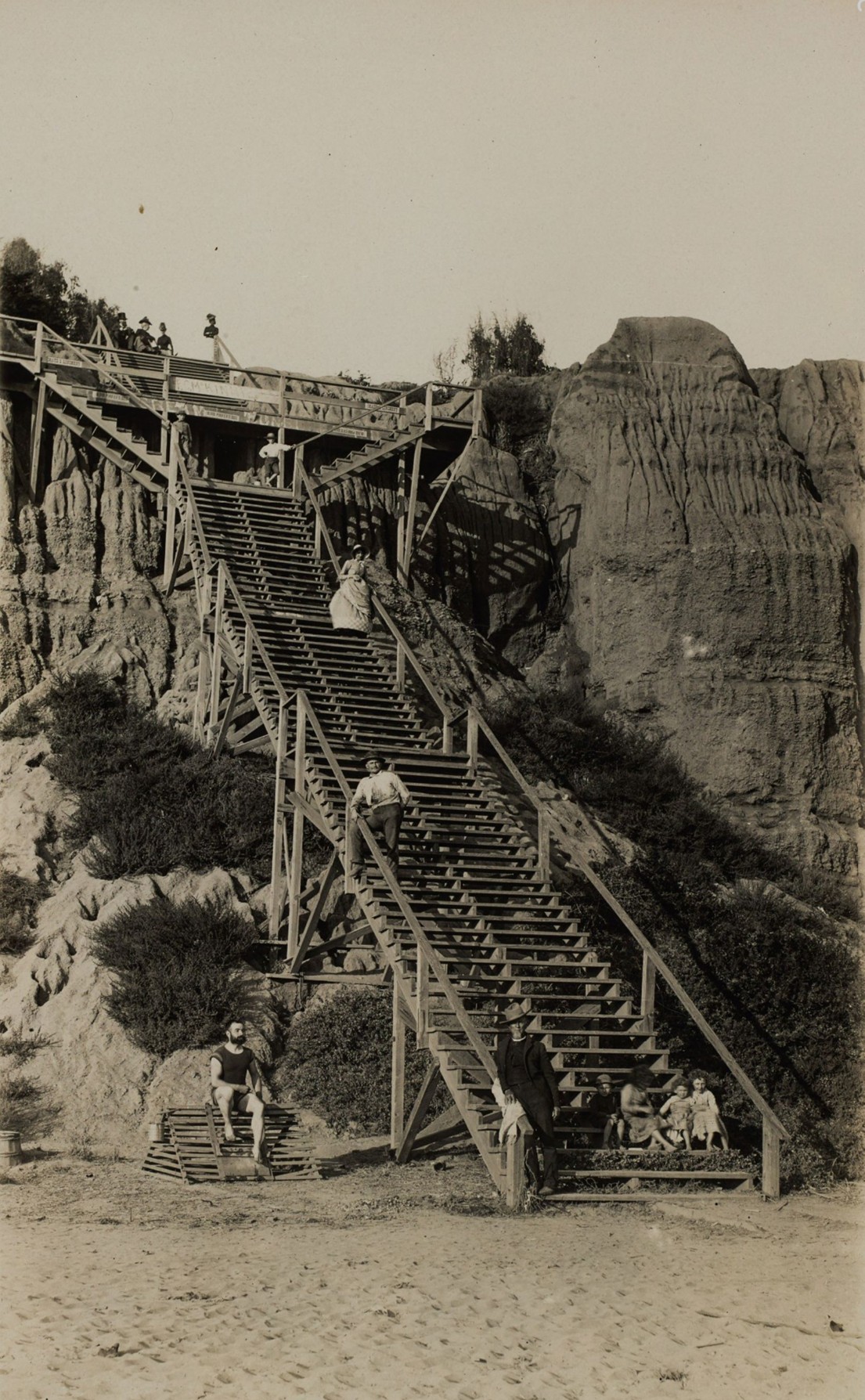 |
|
| (1886)* – This rare photo shows people posing on the original 99 wooden steps leading from the bluffs to the beach at the foot of Arizona Avenue in Santa Monica. A man in a bathing suit sits near the base, while women, children, and other visitors are arranged along the staircase. Image from the Ernest Marquez Collection. |
Historical Notes The original "99 Steps" were a wooden staircase built in 1875 at the foot of Arizona Avenue in Santa Monica, California. Their purpose was to provide easy pedestrian access from the top of the bluffs down to the sandy beach below, at a time when Santa Monica was just beginning to develop as a resort town. This staircase quickly became an important feature, allowing residents and visitors to enjoy the beachfront without having to navigate the steep and rugged bluffs. |
 |
|
| (ca. 1891)* - View of the "99 Steps" from the palisades to the beach below. Two small wood buildings -- one storage shed or shack, the other a dwelling or business with a small covered porch -- sit on the adjacent beach. The wooden steps bifurcate near the top at a landing. |
Historical Notes The steps were later altered so that Southern Pacific trains en route to the Long Wharf could pass underneath. |
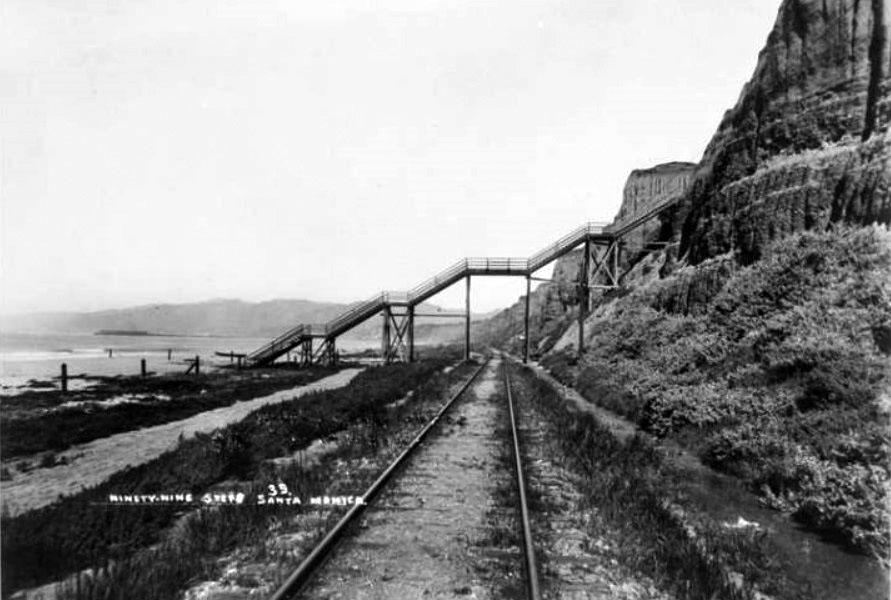 |
|
| (ca. 1898)* - View looking northwest showing railroad tracks running underneath the '99 Steps' in Santa Monica. The Long Wharf, which was the end point of this Southern Pacific Railroad line, can be seen in the distance. Note how the steps have been modified to accomodate the tracks (compare to previous image). |
Historical Notes With the expansion of the Southern Pacific Railroad in 1891, tracks were laid along the base of the bluffs, passing beneath the 99 Steps. To accommodate this, the staircase was modified to allow safe passage over both the tracks and Beach Road, ensuring continued pedestrian access to the beach. Southern Pacific Railroad installed a rail line down to Santa Monica Canyon that was later sold to the Pacific Electric Railway. It was in use from 1891 to 1933. |
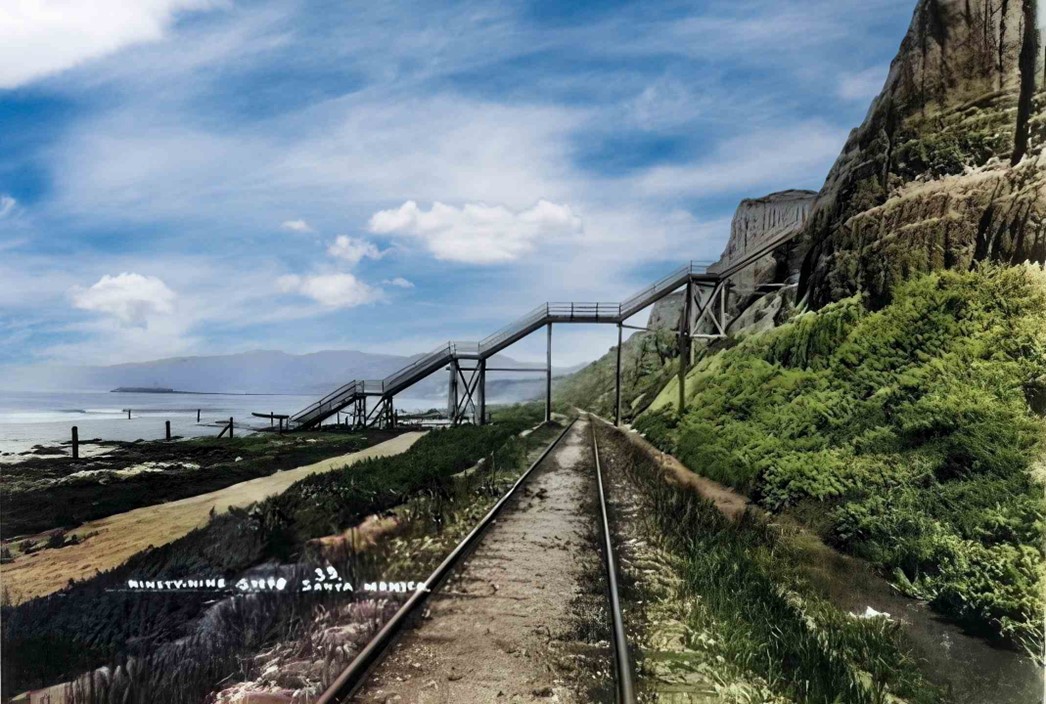 |
|
| (ca. 1898)* - A view looking northwest shows railroad tracks running beneath the '99 Steps' in Santa Monica. To the left, the dirt road known as Beach Road would later become Roosevelt Highway. In the distance, the Long Wharf marks the terminus of this Southern Pacific Railroad line. AI image enhancement and colorization by Richard Holoff. |
Historical Notes Beach Road became Roosevelt Highway in Santa Monica in 1927. This change was part of a larger effort to develop the highway system along the California coast, and the Roosevelt Highway would later become known as the Pacific Coast Highway (PCH). The railroad tracks along Santa Monica Beach were in use from 1891 until 1933. |
 |
|
| (1893)* - View looking south showing North Beach and the Arcadia Hotel with the Southern Pacific Railroad tracks running next to the Beach Road in Santa Monica. The Santa Monica Bath House and the remains of the Los Angeles and Independence Wharf are visible at right and the Palisades Bluffs are visible at left. Photo from the Ernest Marquez Collection. |
Historical Notes Tracks were first laid in Santa Monica in 1875 with the construction of the Los Angeles and Independence Railroad. This steam-powered rail line connected Santa Monica to downtown Los Angeles, running from the Santa Monica Long Wharf north of the current Santa Monica Pier to 5th and San Pedro streets in Los Angeles. This line was intended to serve both freight and passenger purposes, facilitating the transport of mined ore and beachgoers. The Los Angeles and Independence Railroad was purchased by the Southern Pacific Railroad on July 1, 1877. In 1892, the Southern Pacific Railroad extended the existing tracks, seen above, to their new Long Wharf (completed in 1893) north of Santa Monica Canyon, enhancing the line's capacity to handle larger ships and increasing its importance for freight and passenger transport. It appears that the majority of beach shacks along Santa Monica's North Beach were removed with the laying of railroad tracks by Southern Pacific in 1892. No photos of these beach shacks have been found after 1892. |
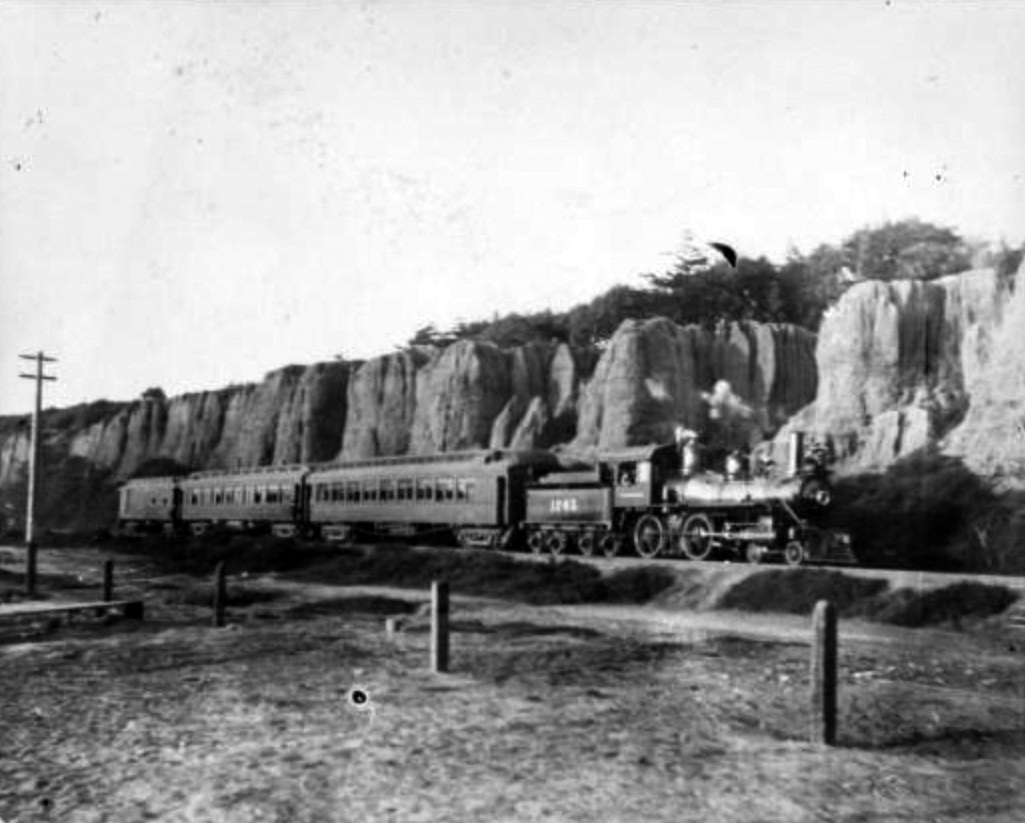 |
|
| (ca. 1892)* - A Southern Pacific train travels along the beach and the unpaved Beach Road, beneath the Linda Vista Park (now Palisades Park) bluffs in Santa Monica. |
Historical Notes Beach Road would later become Roosevelt Highway in 1927, and subsequently, Pacific Coast Highway (PCH). The land for Linda Vista Park was donated to the City of Santa Monica in 1892 by city founders John Percival Jones and Arcadia Bandini de Baker, marking the establishment of the first officially designated public open space in Santa Monica. In 1915, Linda Vista Park was renamed Palisades Park. |
 |
|
| (ca. 1898)* - View from Santa Monica palisades south toward the pier. A train runs along the beach at the foot of the cliffs. The Arcadia Hotel can be seen in the background. |
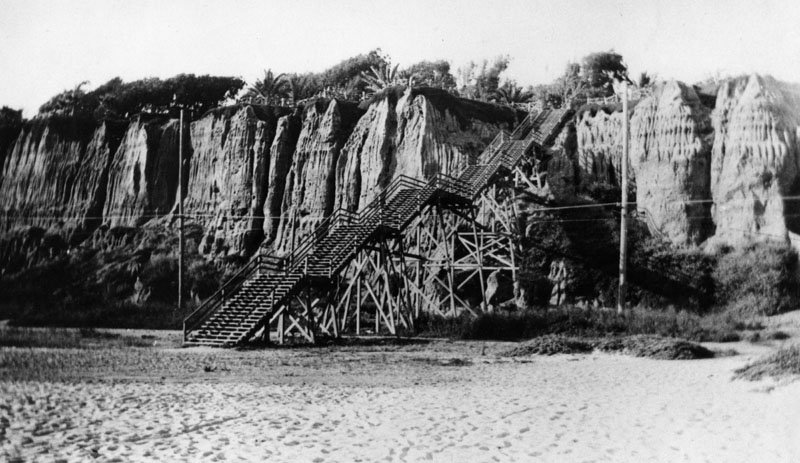 |
|
| (1915)* - View of the '99 Steps' leading from the beach to the area above the palisades at Santa Monica. |
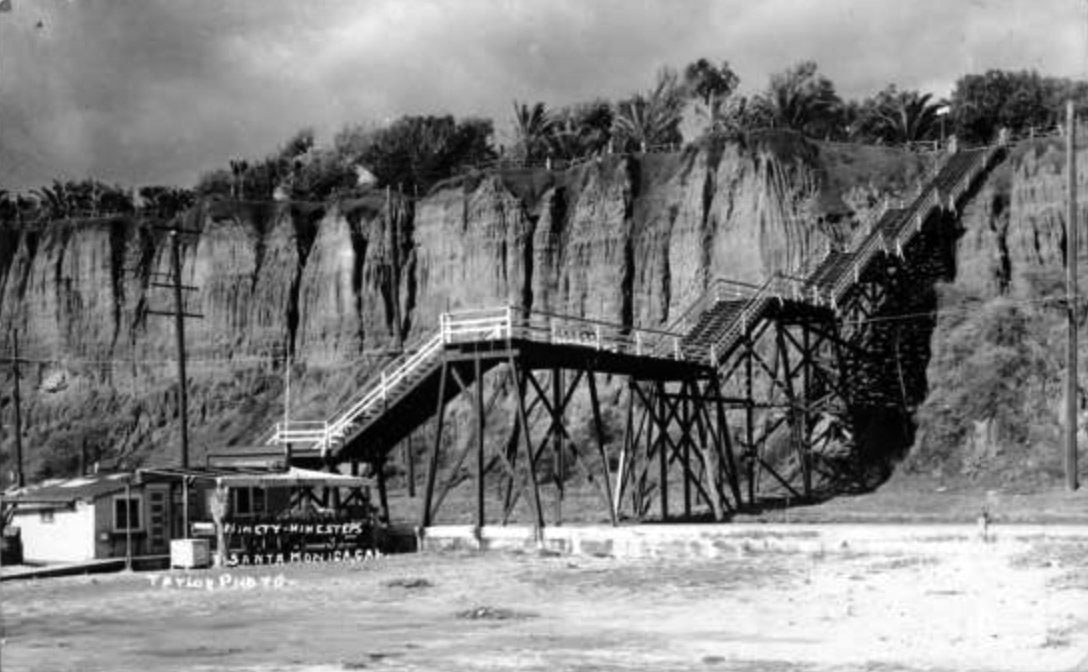 |
|
| (1920s)* - Postcard view showing the '99 steps' leading down from the Palisades bluff, over the coast road to the beach in Santa Monica, with a building with an awning that reads "Public Welcome." Trees and fence of Palisades Park are seen at the top of the bluff. |
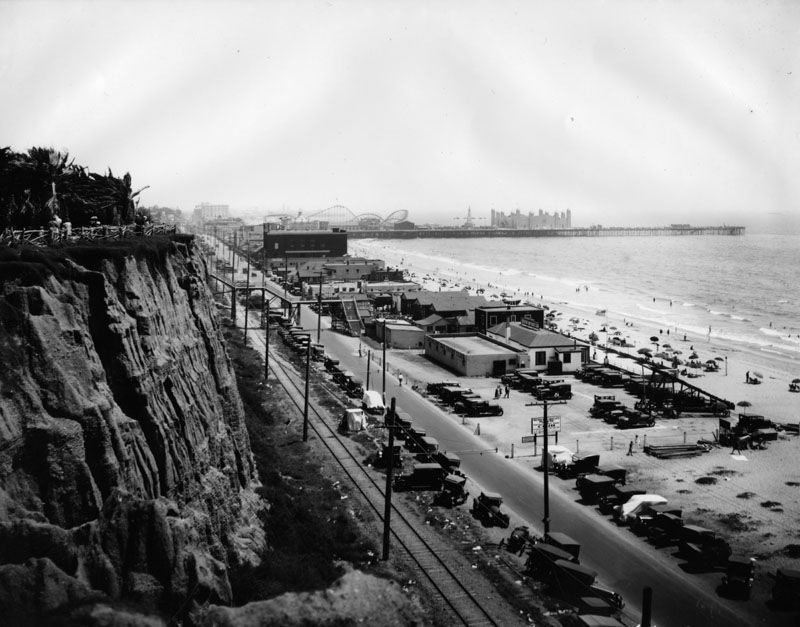 |
|
| (1927)* - Looking down at Roosevelt Highway (later Pacific Coast Highway) shortly after its completion. A new concrete staircase is seen that connects the top of the palisades to the beach. |
Historical Notes The steps and bridge seen in the above photo are at the same location as the original '99 Steps" built in 1875. The development of coastal infrastructure continued into the 20th century. In 1927, Beach Road was expanded and renamed Roosevelt Highway, now known as Pacific Coast Highway (PCH). This transformation necessitated further changes to the 99 Steps area. The original wooden staircase was replaced with a new concrete pedestrian bridge and steps, allowing people to safely cross over the busy highway to reach the beach. This bridge was constructed at the same location as the original 99 Steps, maintaining the historical beach access point. |
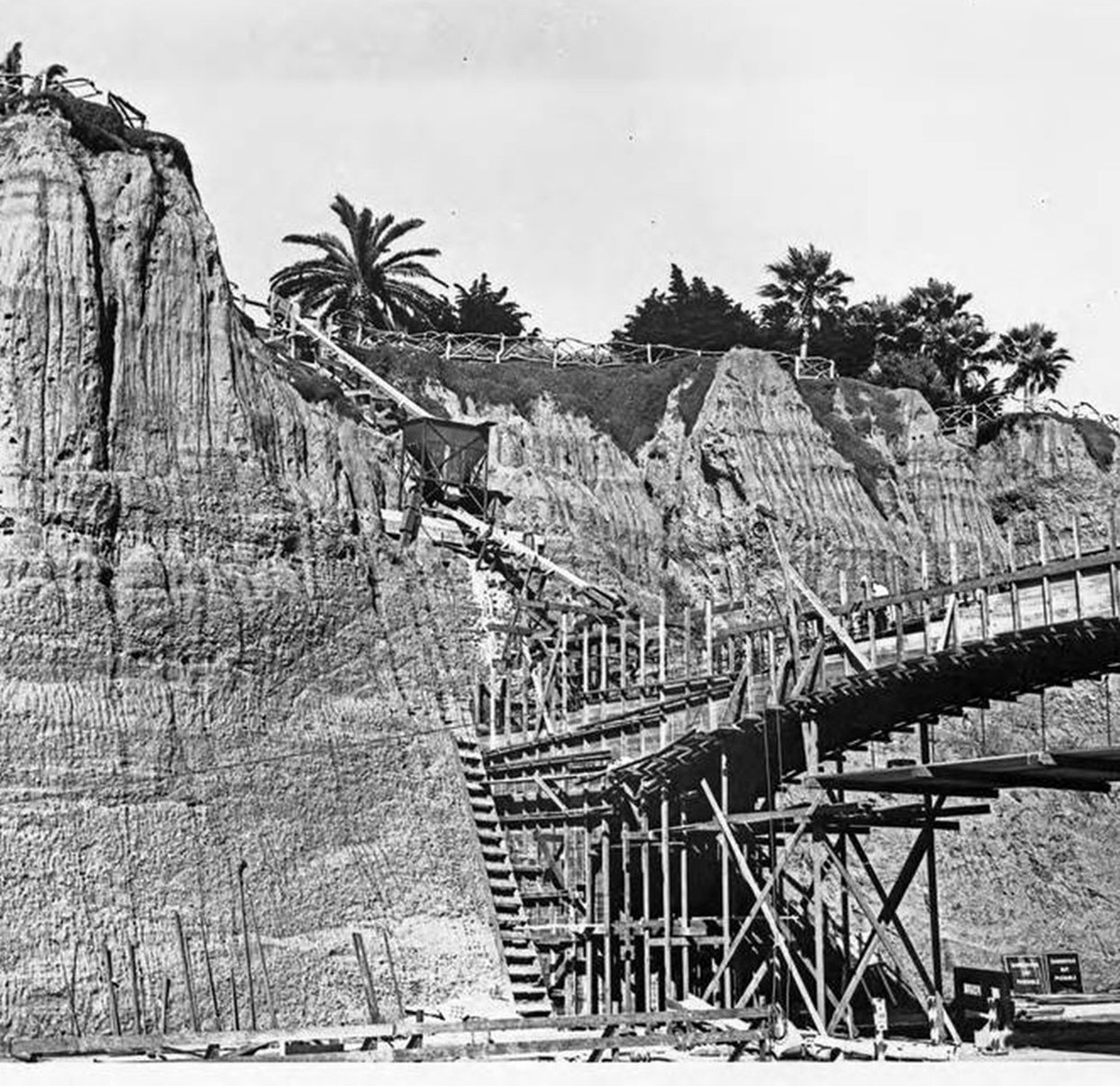 |
|
| (1935)* - View showing the construction of a new concrete bridge across Roosevelt Highway to replace an earlier, less robust concrete bridge, which had itself replaced the original wooden steps connecting Palisades Park to the beach. |
Historical Notes The concrete pedestrian bridge built in 1927 at the site of the original 99 Steps was later replaced in 1935 with a more robust structure to accommodate increasing foot traffic and ensure safety over the expanding highway. This 1935 bridge remains in place today, continuing to serve as a vital link between Palisades Park and Santa Monica Beach at the end of Arizona Avenue. |
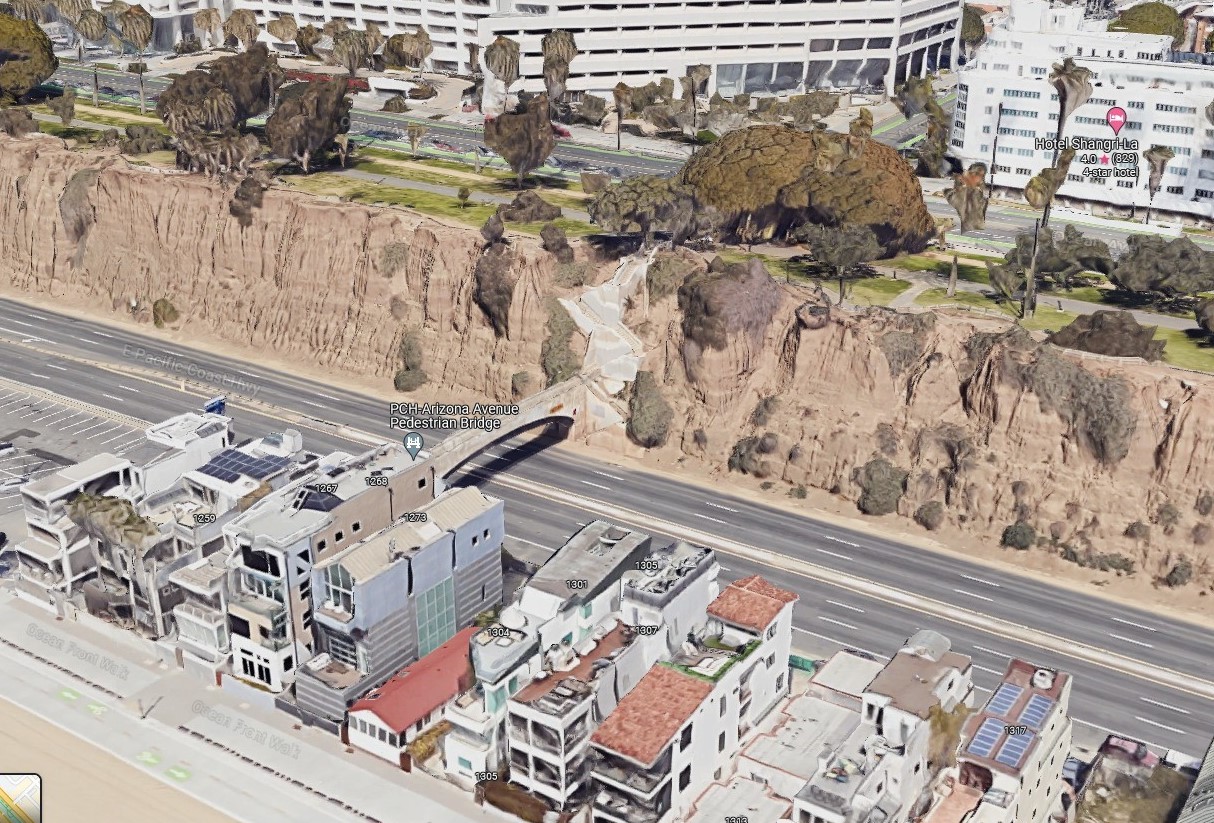 |
|
| (2022) - Google Earth view showing the Pedestrian Bridge that connects the Palisades, at the end of Arizona Ave, to the beach right where the original 1875-built 99 Steps were located. |
Then and Now
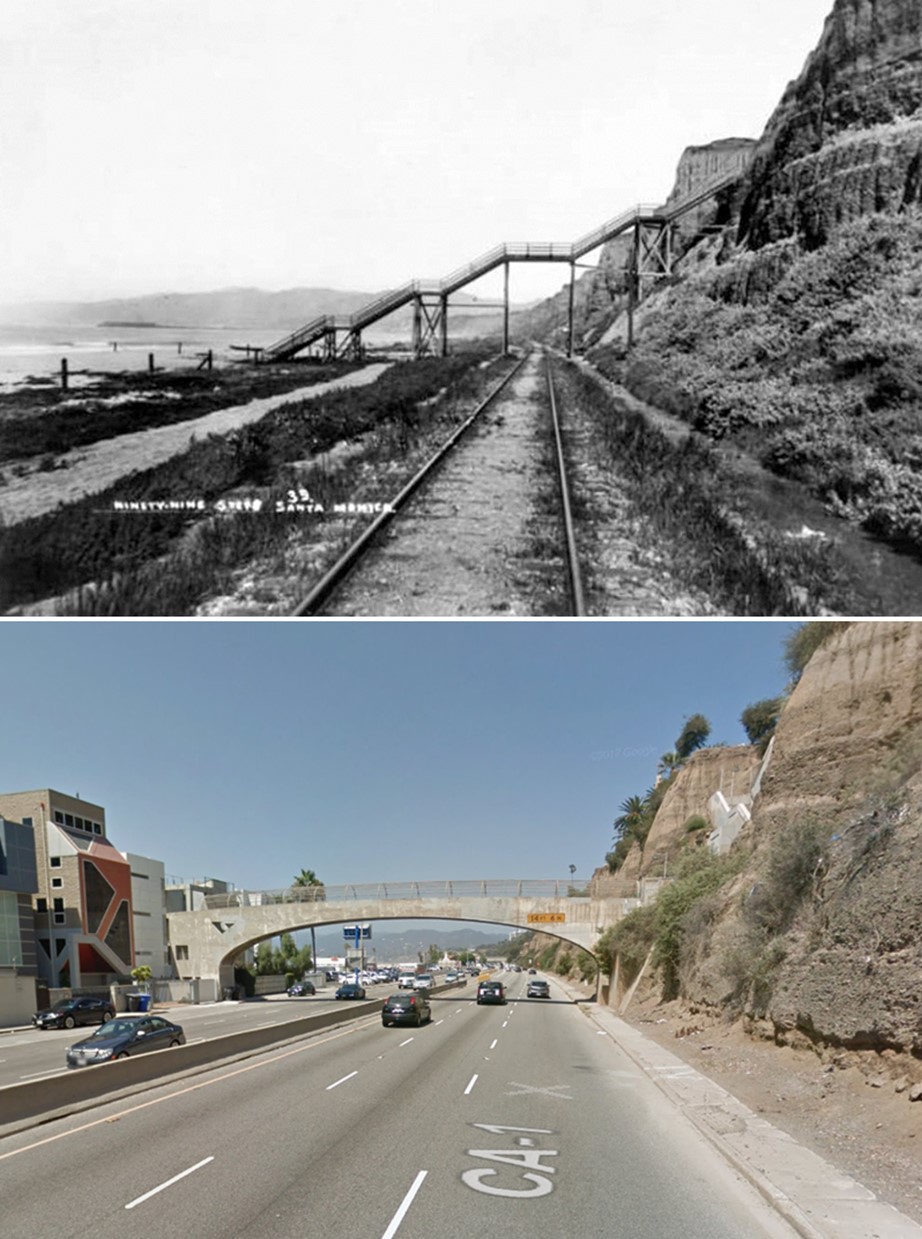 |
|
| (1898 vs 2022)* – Looking NW showing at the Pedestrian Bridge (over PCH, CA-1) that connects the Palisades, at the end of Arizona Ave, to the beach right where the original 1875-built 99 Steps were located. Photo comparison by Jack Feldman. |
Then and Now
 |
|
| (1890 vs. 2023)* – View looking south from the rim of what is now Palisades Park near the foot of Wilshire Boulevard. The 1890 photo shows the original "99 Steps," which provided access to the northern portion of Santa Monica Beach. In the distance, the Hotel Arcadia and the remains of the Los Angeles and Independence Railroad Co. Wharf are visible. The 2023 image shows the Pedestrian Bridge, connecting the Palisades at the end of Arizona Avenue to the beach below, located at the site of the original "99 Steps" built in 1875. Photo comparison by Jack Feldman. |
Historical Notes While the camera angles differ slightly, the contemporary image clearly shows more sand on the beach. This increase is largely due to human intervention, particularly through beach nourishment projects. Over the past century, efforts have been made to widen and enhance the beach to boost tourism and recreation. Key factors include adding approximately 30 million cubic yards of sand, sourced from infrastructure projects and dredging operations, and the desire to make Santa Monica Beach resemble the wider, flatter beaches of the East Coast. In 1947, for example, nearly 14 million cubic yards of sand were removed to make way for El Segundo's Hyperion power plant. They were deposited onto Santa Monica's beaches. Another million cubic yards came a couple years later, the sand this time recovered from dredging operations along a nearby breakwater. In all, some thirty million cubic yards of sand have been dumped onto the beaches of Santa Monica and Venice. |
* * * * * |
Arriving in Santa Monica
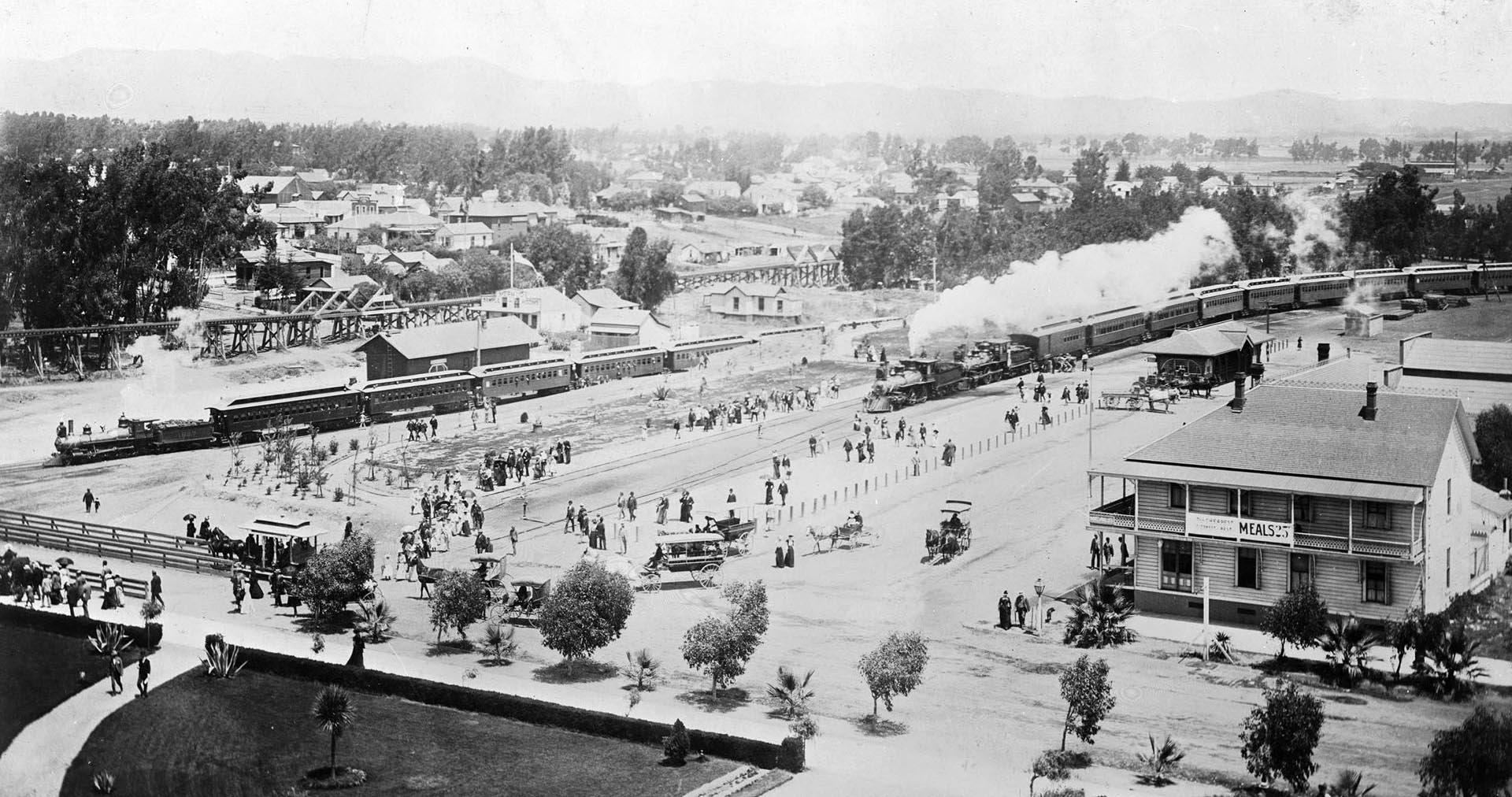 |
|
| (ca. 1900)*#* - View from the Arcadia Hotel observation tower showing two Southern Pacific excursion trains. These trains regularly brought beachgoers to Santa Monica. Horse-drawn carriages and a trolley can also be seen. |
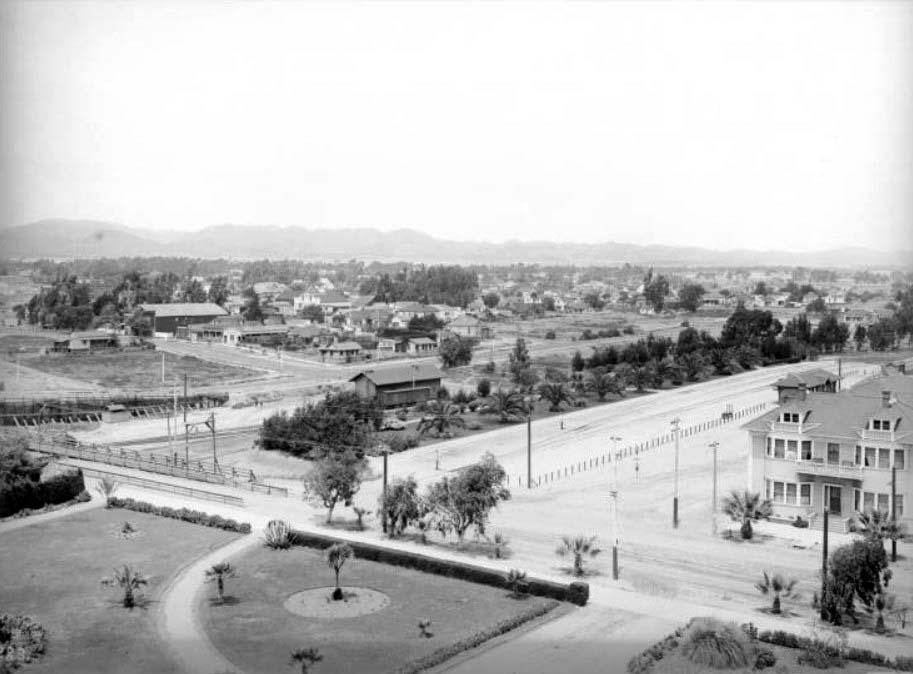 |
|
| (ca. 1904)* - Birdseye view looking northeast from the Arcadia Hotel (same view as previous photo but about 4 years later). Note how the building in the lower right has been enlarged, also, the addition of trees around the train station at center of photo. |
* * * * * |
Beach Views
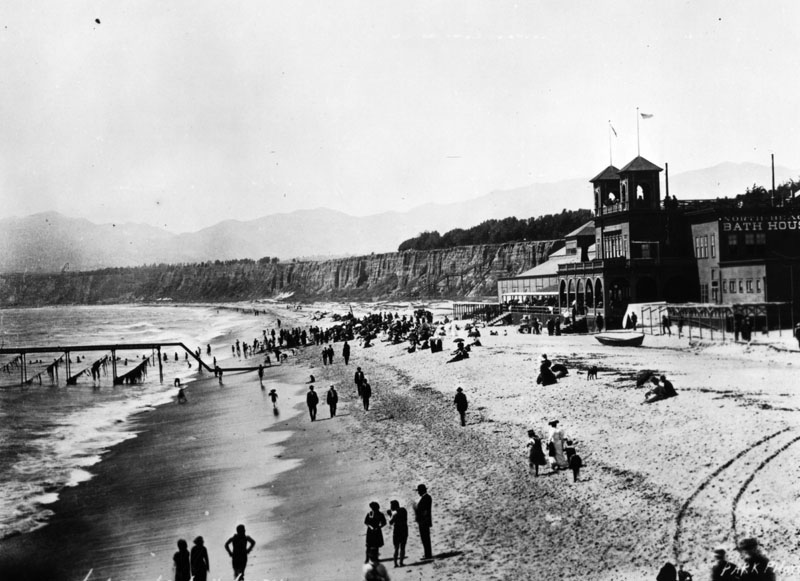 |
|
| (1900)* - Beachgoers enjoying the day at Santa Monica Beach. The large building to the right is the North Beach Bath House. Photo is looking north from the pier, at the foot of Colorado Avenue. |
 |
|
| (ca. 1900)* - Children are seen playing on the beach at Santa Monica. The Arcadia Hotel and wharf can be seen in the background. |
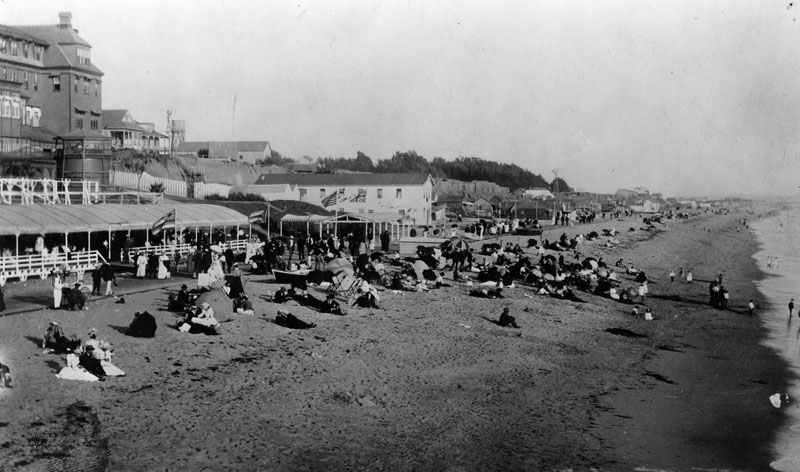 |
|
| (ca. 1900)* - Crowds of people can be seen sitting on the beach and strolling the boardwalk on South Beach in Santa Monica. The Arcadia Hotel is in the upper-left. |
* * * * * |
Santa Monica City Views
.jpg) |
|
| (1900)** - Panoramic view of Santa Monica looking northeast from Third Street and Arizona Avenue. Trees stand on the side of the street in the foreground. Large houses stand in a row with wide, manicured lawns. More houses can be seen amongst the tree tops that extend to the mountains in the distance. |
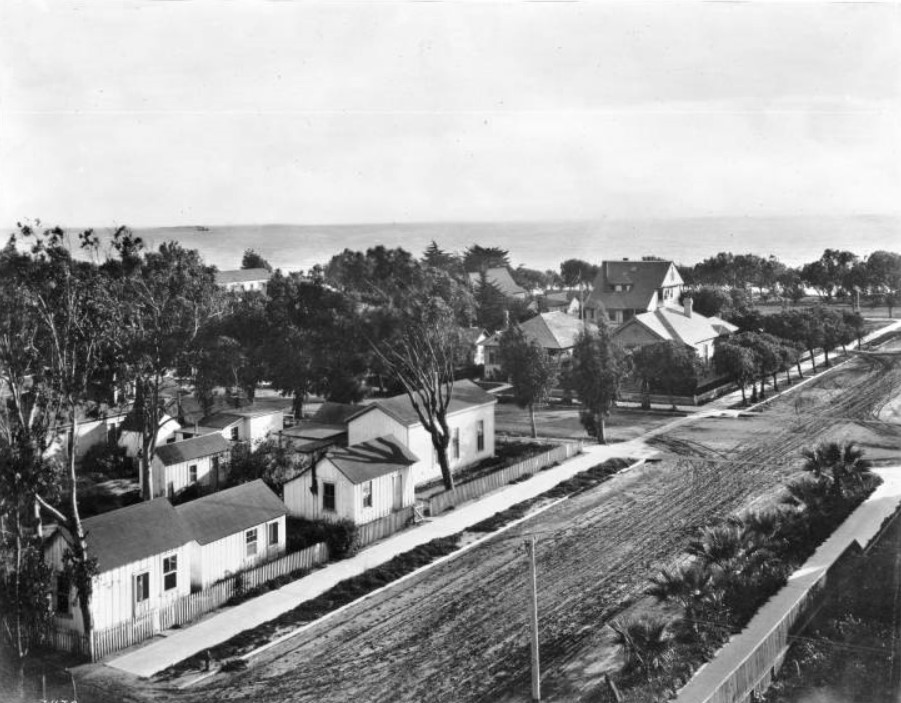 |
|
| (ca. 1900)** - View looking southwest from the tower of the Academy of Holy Names, located on Third Street and Arizona Avenue with the ocean visible in the distance. Arizona Avenue runs diagonally from lower-left to upper-right where it meets Ocean Avenue. Today, the Hotel Shangri-La stands on that corner. |
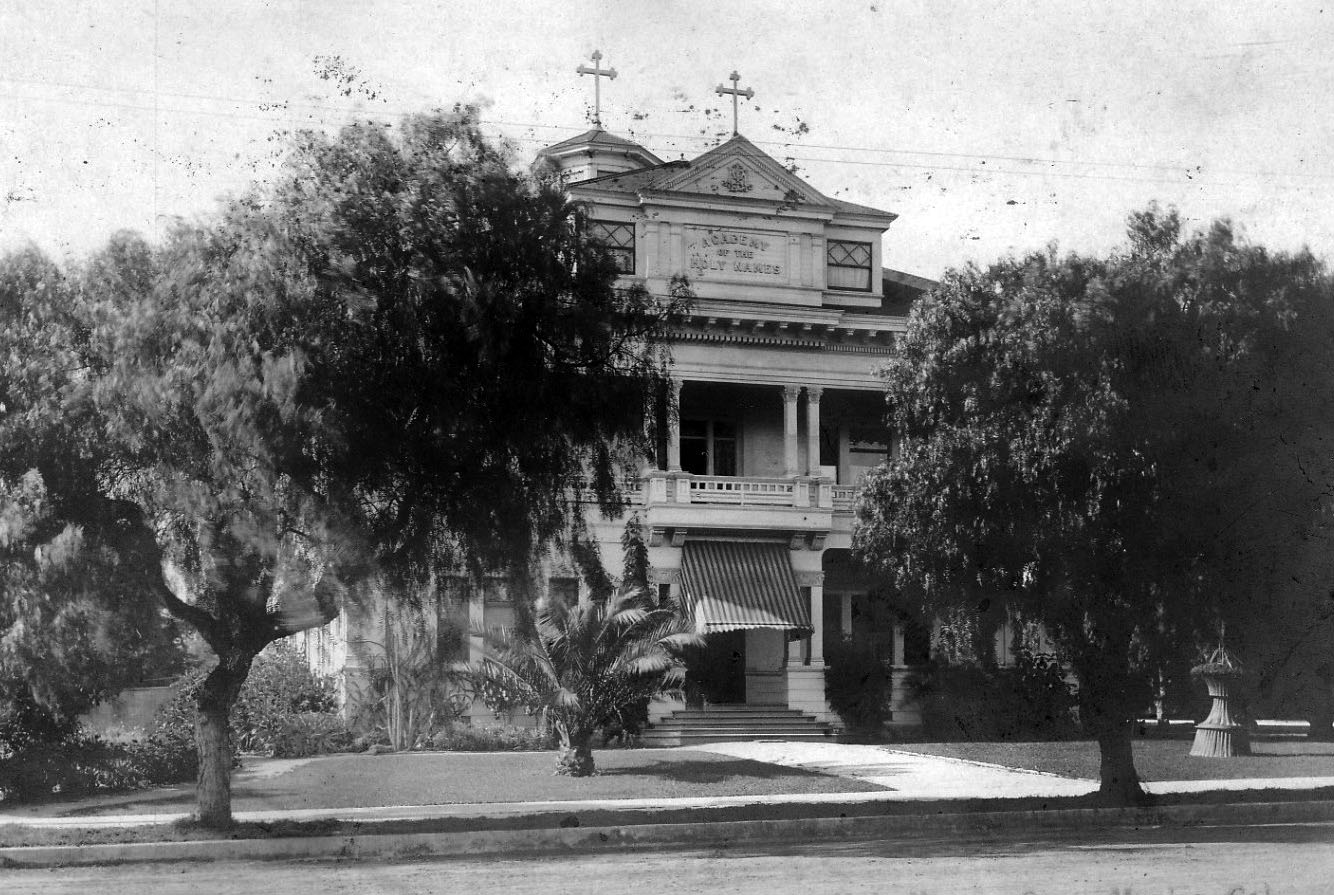 |
|
| (ca. 1900)**^ – Front view of the Academy of the Holy Names, a flourishing school for girls established by a band of holy sisters, located at 3rd Street and Arizona Avenue in Santa Monica. |
Historical Notes The Sisters of the Holy Names of Jesus and Mary had arrived in Santa Monica in July 1899. They opened the Academy of the Holy Names on September 4 of that year in a small frame building on Fourth Street and Arizona. An intense fund-raising drive was launched immediately and a more substantial Academy building was erected in 1900 at Third and Arizona. |
* * * * * |
Bank of Santa Monica
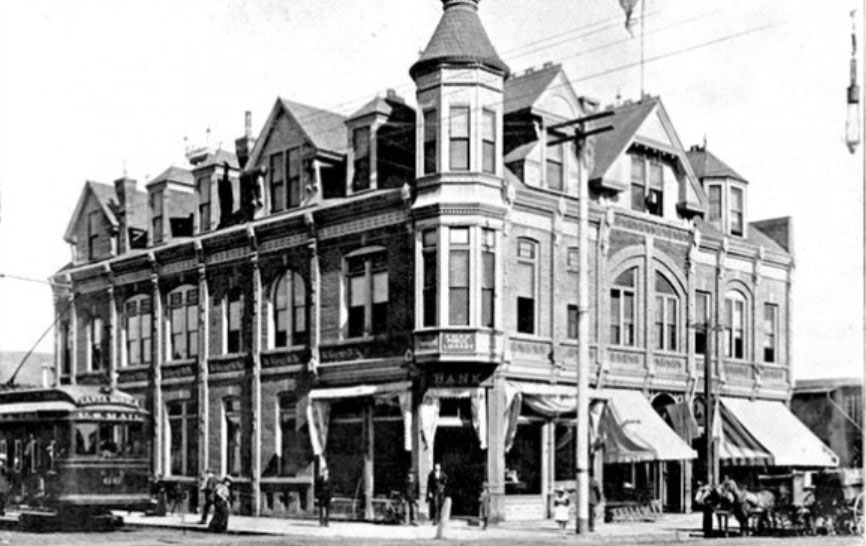 |
|
| (ca. 1899)* – View of the Bank of Santa Monica located at Third Street and Oregon Avenue (now Santa Monica). |
Historical Notes By 1899 there were two banks in the City of Santa Monica: Bank of Santa Monica located at Third Street and Oregon Avenue (now Santa Monica Blvd.) and Commercial Co's Bank at 219 Third Street. By the late 1920s there were thirteen financial institutions, including multiple branches. |
 |
|
| (ca. 1900)* - View of the corner of Third Street and Santa Monica Boulevard (then named Oregon Avenue). Today the intersection is part of the popular Third Street Promenade retail district. |
Historical Notes The 1st Santa Monica Public Library was located at Third Street and Santa Monica Blvd. on the second floor of the Bank of Santa Monica. |
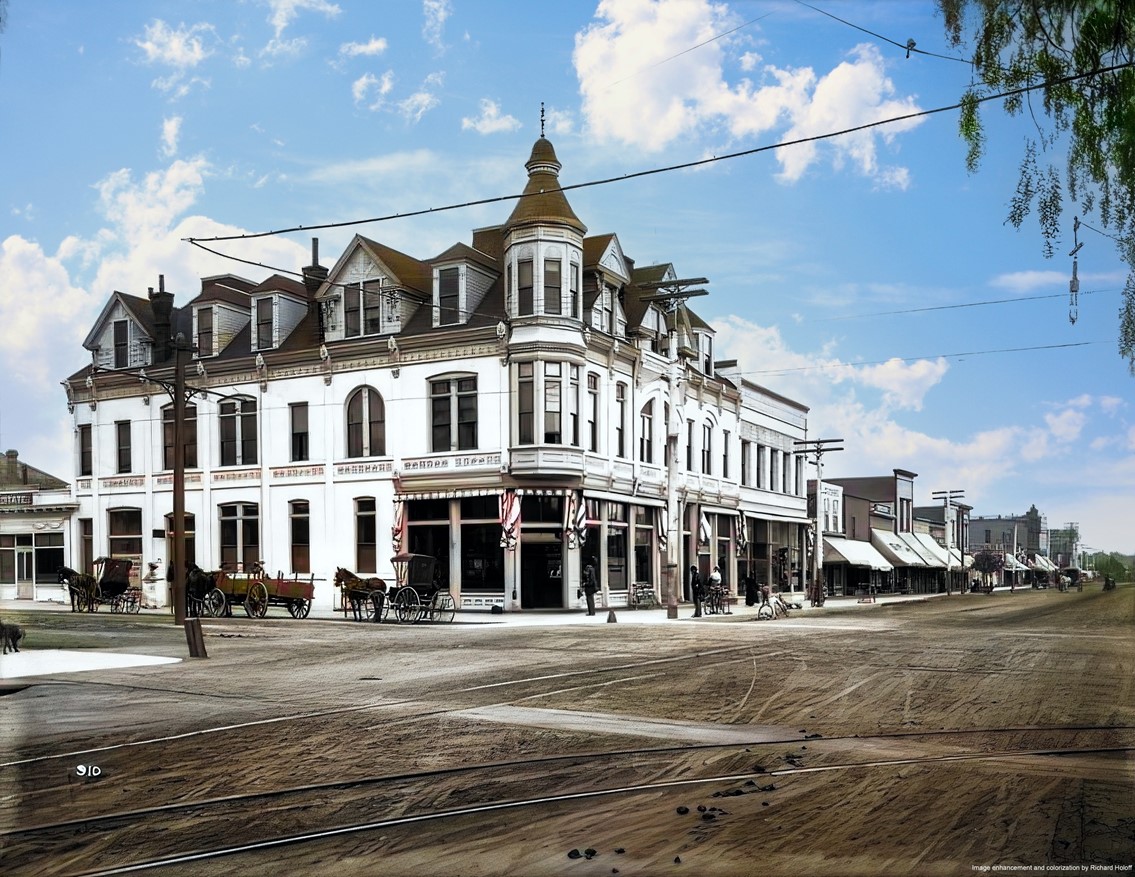 |
|
| (ca. 1900)* - View of the corner of Third Street and Santa Monica Boulevard (then named Oregon Avenue). Today the intersection is part of the popular Third Street Promenade retail district. Image enhancement and colorization by Richard Holoff. |
* * * * * |
Pacific Electric Railway
 |
|
| (ca. 1900)* - Pacific Electric Railway Pasadena and Pacific car labelled "Santa Monica,” seen crossing a street. |
Historical Notes The Los Angeles Pacific Railroad, founded by Moses Sherman and his brother-in-law Eli Clark, operated a peak network of 180 miles of track in the western parts of Los Angeles County. Its routes connected Pasadena to Santa Monica and extended along the coast to Redondo Beach. The Pacific Electric Railway served Santa Monica from 1911 to 1953. It acquired the Santa Monica Air Line during the 1911 "Great Merger," when Southern Pacific took over Henry Huntington's railway holdings. Pacific Electric also continued the popular Balloon Route excursion, originally launched in 1901 by the Los Angeles Pacific Railroad. After taking over LAP's operations in 1911, Pacific Electric maintained the Balloon Route as one of its signature attractions. |
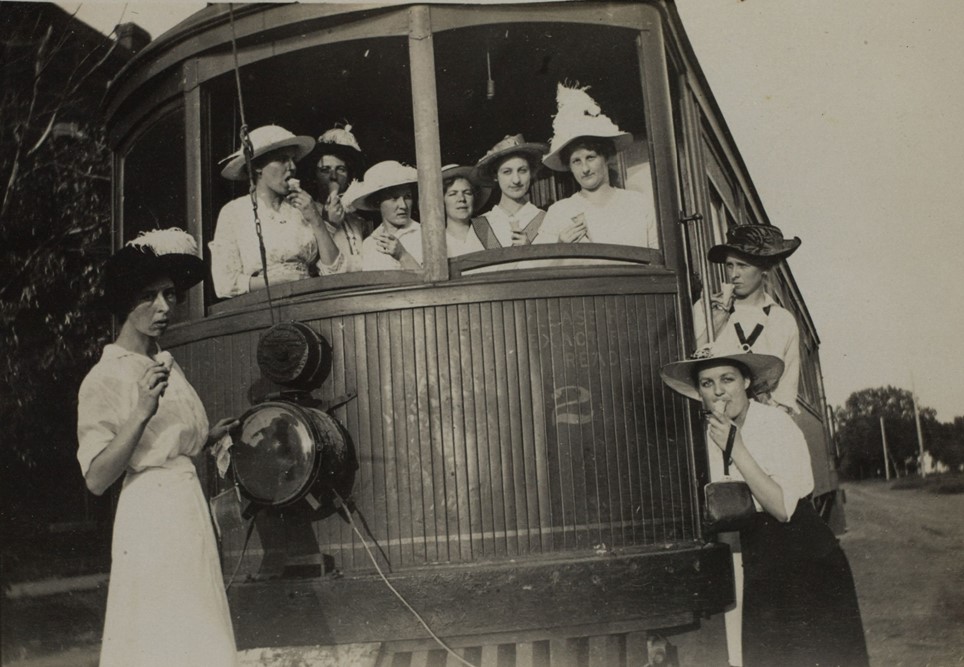 |
|
| (1913)* – A group of young women, each holding an ice cream cone, pose for the camera in and around a Pacific Electric trolley car in Santa Monica. Photo from the Ernest Marquez Collection |
Historical Notes Pacific Electric trolleys played a crucial role in Santa Monica's history, connecting the coastal city to downtown Los Angeles and other parts of Southern California. The Santa Monica Air Line, established in 1908, was a key component of this transportation network, providing electric passenger service along a 16.88-mile route with 15 stations. As part of the world's largest trolley system by the 1920s, the line contributed significantly to Southern California tourism, urban development, and economic growth. It allowed residents to live in coastal areas while working in the city center and influenced the gridded street layout of many communities. Despite its initial popularity, the Santa Monica Air Line faced challenges, with service reduced to rush hours by 1924 and passenger service ending in 1953. |
* * * * * |
Balloon Route Trolley Trip
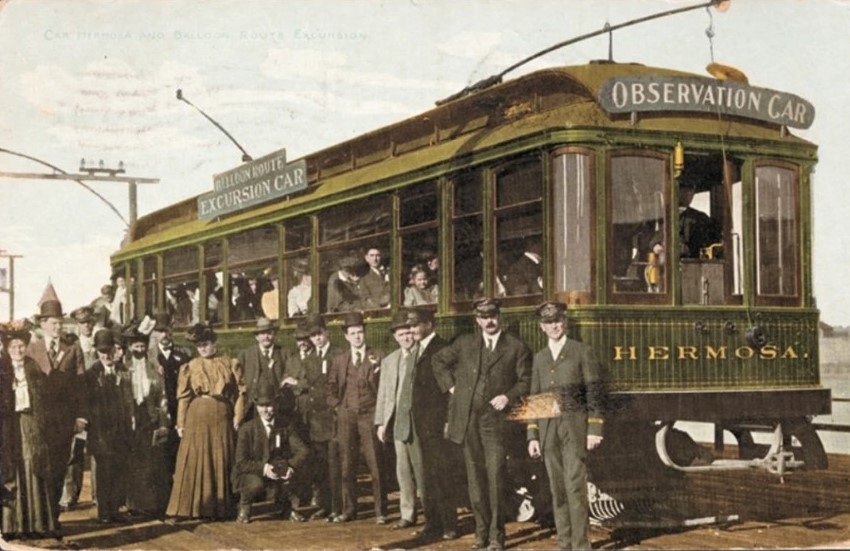 |
|
| (1902)* - Postcard view showing passengers enjoying the most famous trolley car trip in the West during the early 1900s – a daylong excursion called the “Balloon Route” from downtown Los Angeles to the beach cities and back again. The trip, billed as “the only ocean voyage on wheels,” covered 101 miles for 100 cents. |
Historical Notes Moses Sherman and Eli Clark introduced several innovations to trolley operations in the Los Angeles area. Among the most popular was the scenic Balloon Route Trolley Trip, celebrated as the most famous streetcar excursion in the West. Few tourists visiting Los Angeles skipped a ride on the Balloon Route, named for the loop-shaped course the trolleys followed. The excursion featured up to 18 cars daily, departing from downtown Los Angeles and traveling through Hollywood, Sawtelle, Santa Monica, and beach cities like Venice, Playa del Rey, and Redondo Beach. The route then returned downtown via the Palms area. |
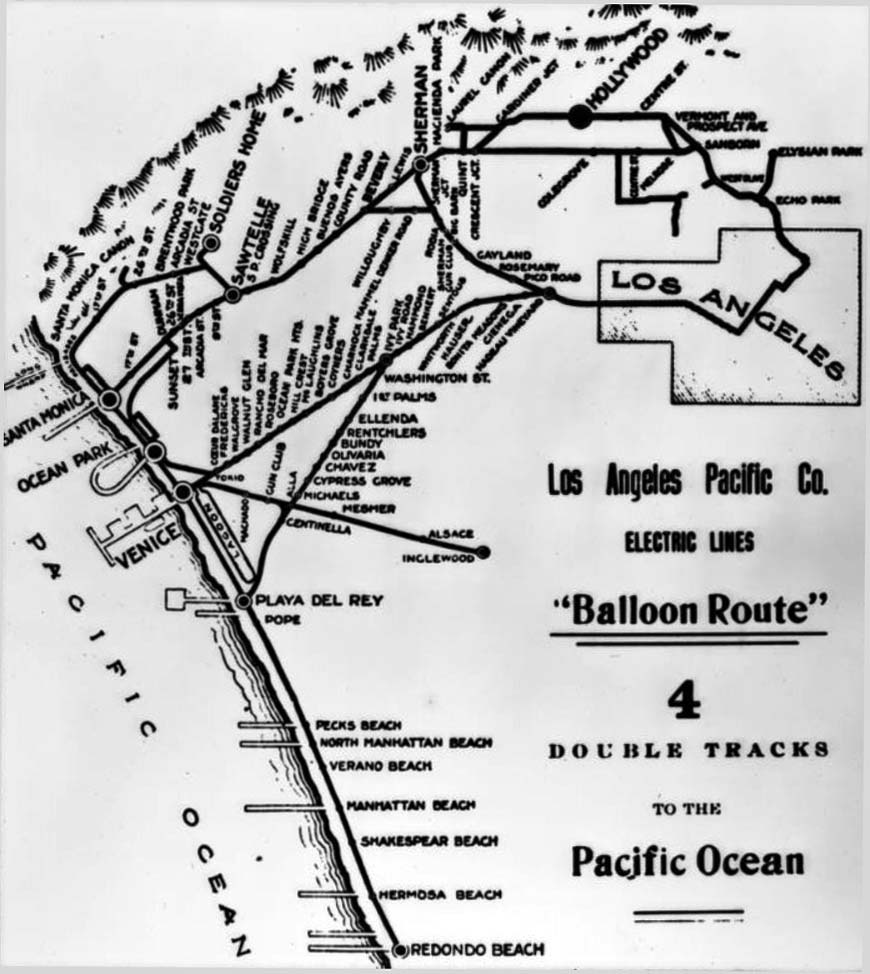 |
|
| (1910)* - Map of the Los Angeles Pacific Company Electric lines around Los Angeles, including the "Balloon Route" which would bring flocks of tourists to Santa Monica, among other places. |
Historical Notes The Balloon Route Trolley trip was the featured route of the Los Angeles Pacific, opened in September 1901. The line ran from downtown LA through Hollywood, Santa Monica, Venice Beach, Redondo Beach and back to L.A. via Culver City. The lines stopped at beach resorts and included free entrance to some en-route stops attractions along the way, including: Sunset Boulevard, studio of painter Paul de Longpré, bean fields of Morocco in Beverly Hills, Sawtelle Veterans Home and Old oldiers’ Home in Sawtelle, Long Wharf, Camera Obscura at Santa Monica, Playa del Rey Pavilion for a fish dinner, Redondo's Moonstone Beach, Venice, and Palms - Culver City. |
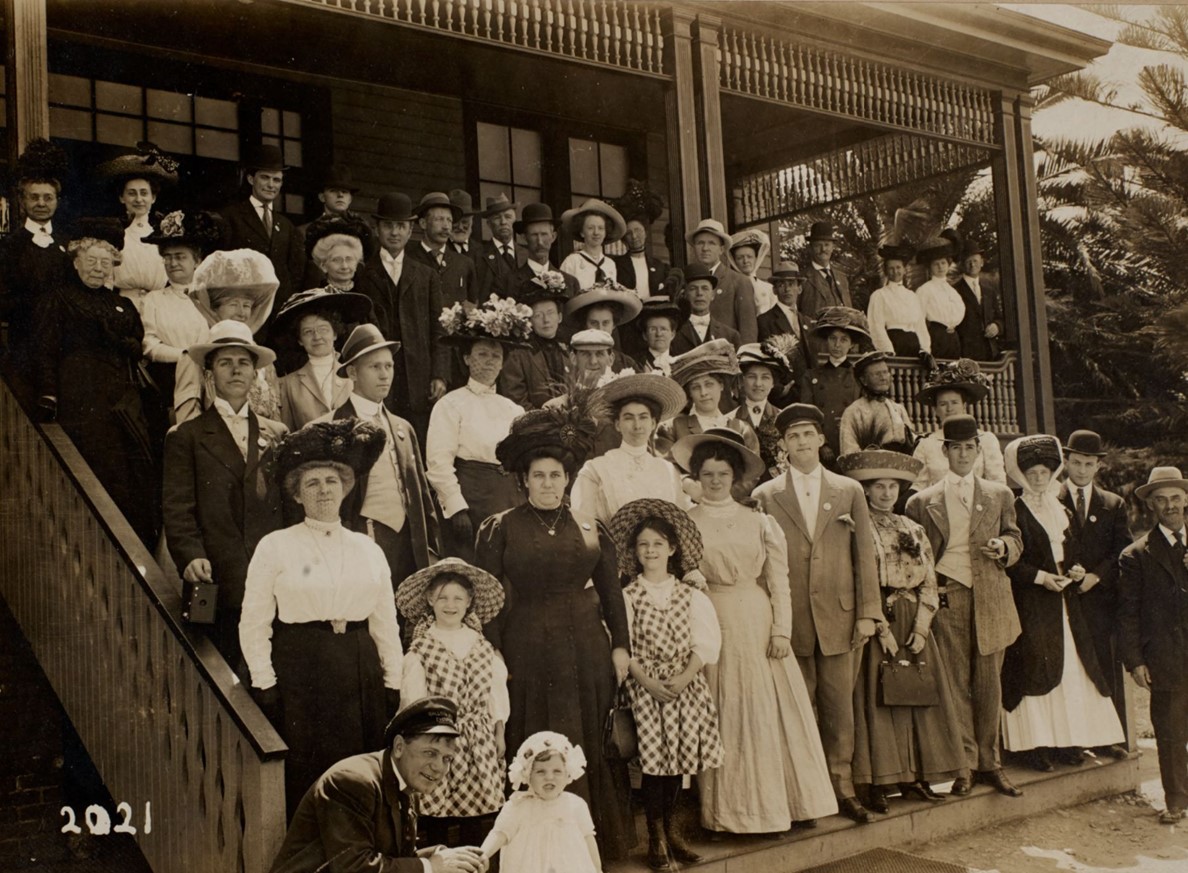 |
|
| (ca. 1905)* - Group portrait of passengers on the Balloon Route Excursion at one of their many stops, the Soldiers’ Home in Sawtelle. Photo from the Ernest Marquez Collection. |
Historical Notes Passengers enjoyed picturesque views of the city and coastline from the comfort of parlor cars. The trip featured stops at notable attractions such as Paul de Longpre's house, the Soldiers’ Home in Sawtelle, and Santa Monica's Long Wharf, offering a delightful experience for both locals and visitors. |
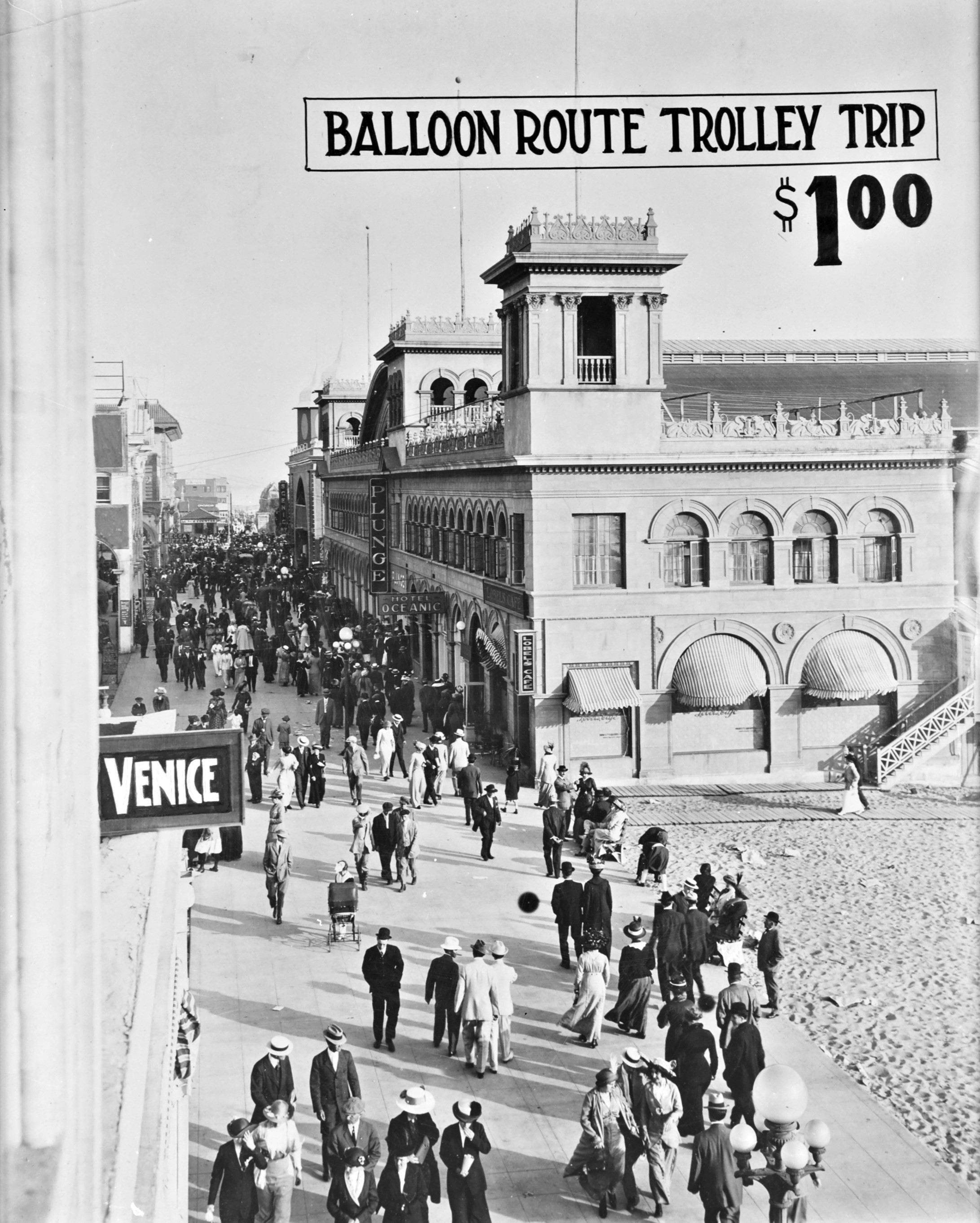 |
|
| (ca. 1905)* - Advertisement for the Balloon Route Trolley Trip: 101 miles for 100 cents—or "one whole day for a dollar. |
Historical Notes Initially developed by land promoters Moses Sherman and Eli Clark in 1901, the Balloon Route flourished under the management of Charles M. Pierce, who effectively marketed it as "the only ocean voyage on wheels." At its peak, the route attracted an average of 10,000 riders per month during the tourist season. However, its popularity waned after 1911 when a major railway merger transferred ownership to Southern Pacific, leading to neglect and ultimately the decline of this once-thriving trolley service. |
* * * * * |
Ocean Park Grammar School
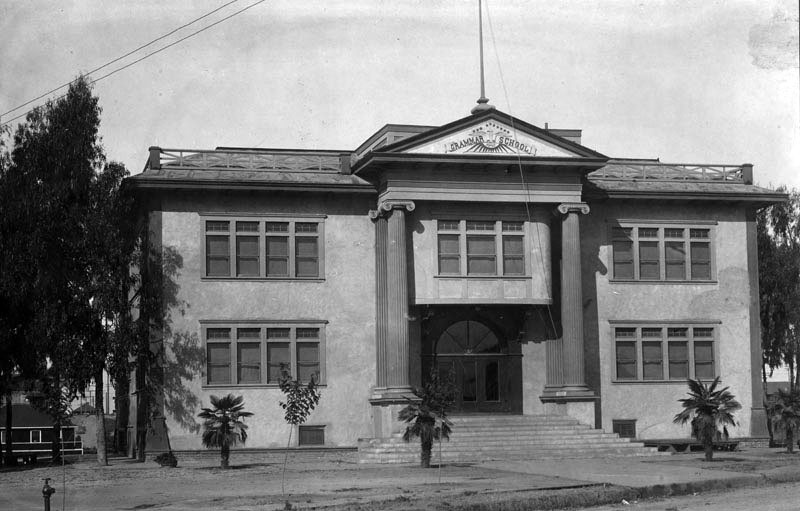 |
|
| (1900)* - Exterior view of Ocean Park Grammar School. |
* * * * * |
Pacific Café
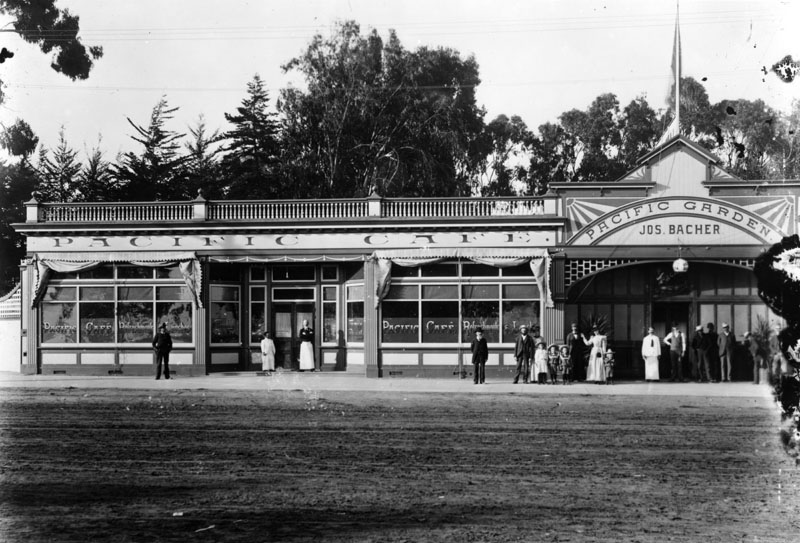 |
|
| (ca. 1900)* - View of the 1500 block on Ocean Avenue, opposite the Pacific Electric Depot. Groups of people can be seen standing outside of the Pacific Cafe and Pacific Garden restaurants. |
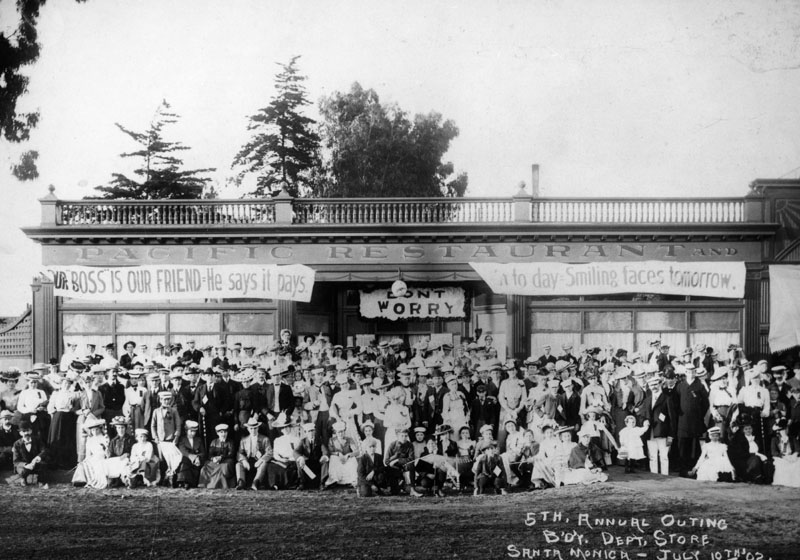 |
|
| (1902)* - Group portrait of department store employees and their families, taken in front of the Pacific Restaurant in Santa Monica. This was their 5th Annual Outing. |
Sue's Ice Cream and Confectionery
.jpg) |
|
| (1902)#^ – View showing Sue's Ice Cream and Confectionery on the northeast corner of Second Street and Utah (now Broadway) in Santa Monica. Nordstroms is located on this corner today. |
* * * * * |
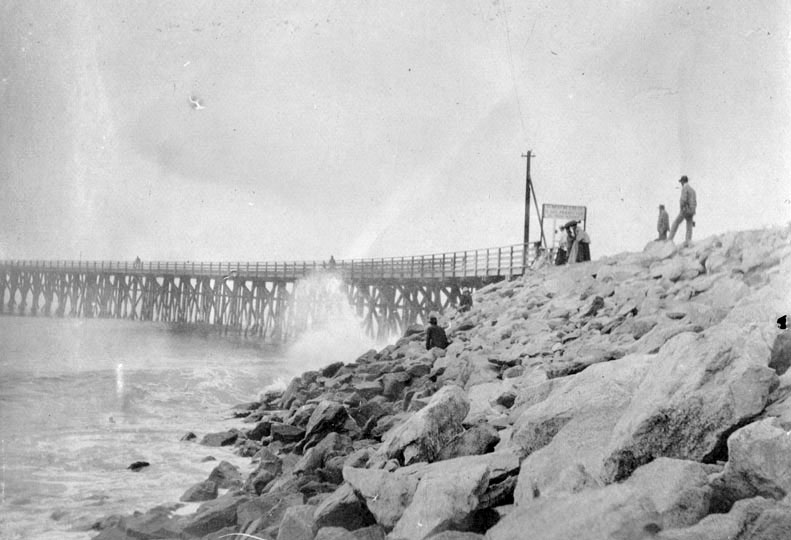 |
|
| (1902)* - Several people watch the heavy surf at the Santa Monica Pier. |
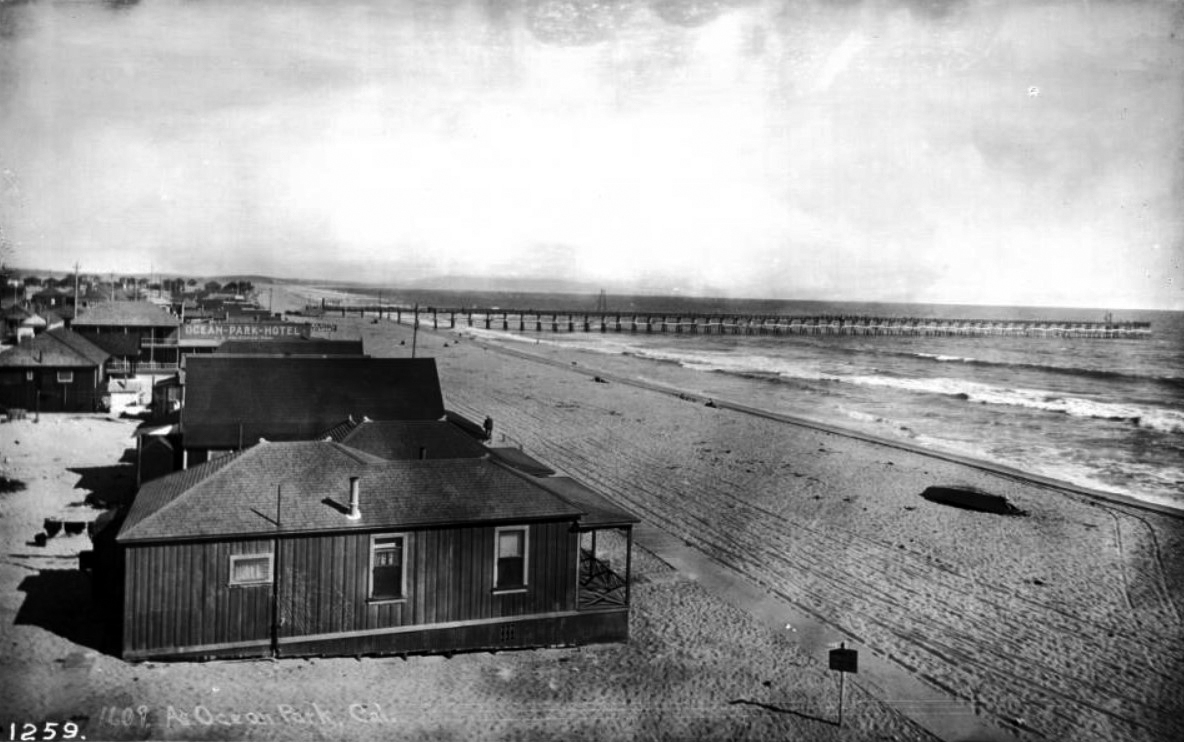 |
|
| (ca. 1903)** - View showing Ocean Park beach homes looking south toward the pier. Very few people are on the beach. Legible signs include: "Ocean-Park-Hotel, J.G. Holboro, propr.", and "Holboro's Restaurant". |
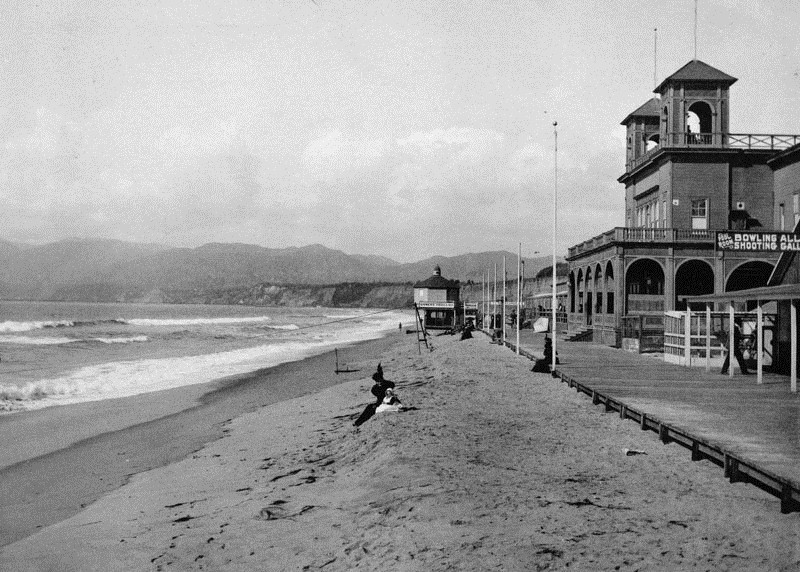 |
|
| (1904)* - A mother and child are seen sitting on the beach in front of the Santa Monica Bath House. The bath house is owned by Sen J.B. Jones. A sign shows there is also a pool room, bowling alley and a shooting gallery. The Camera Obscura booth stands at the end of the boardwalk and a long wharf can be seen in the far distance. |
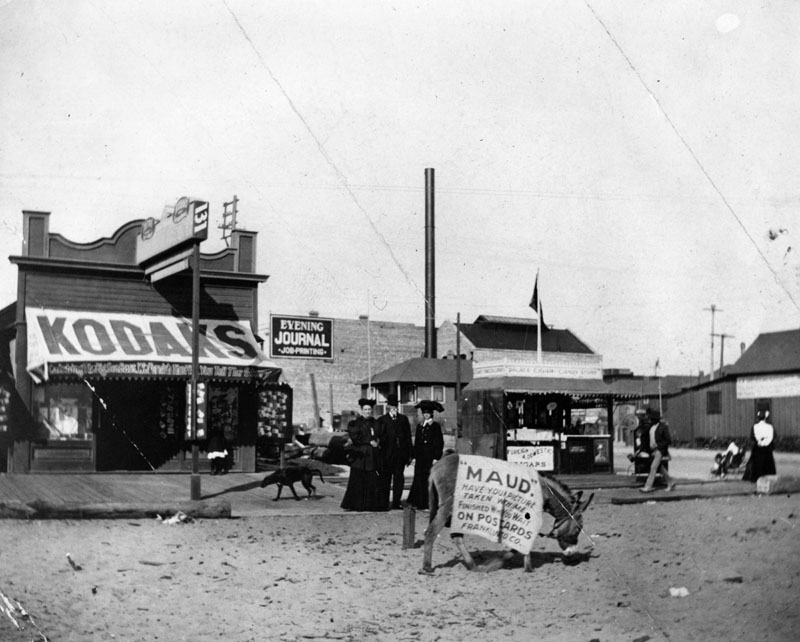 |
|
| (1905)* - A donkey with a blanklet advertising "Maud" to have your picture taken stands in the middle of an unpaved street. Buildings and people are seen behind the wooden board walk. |
* * * * * |
Arch Rock
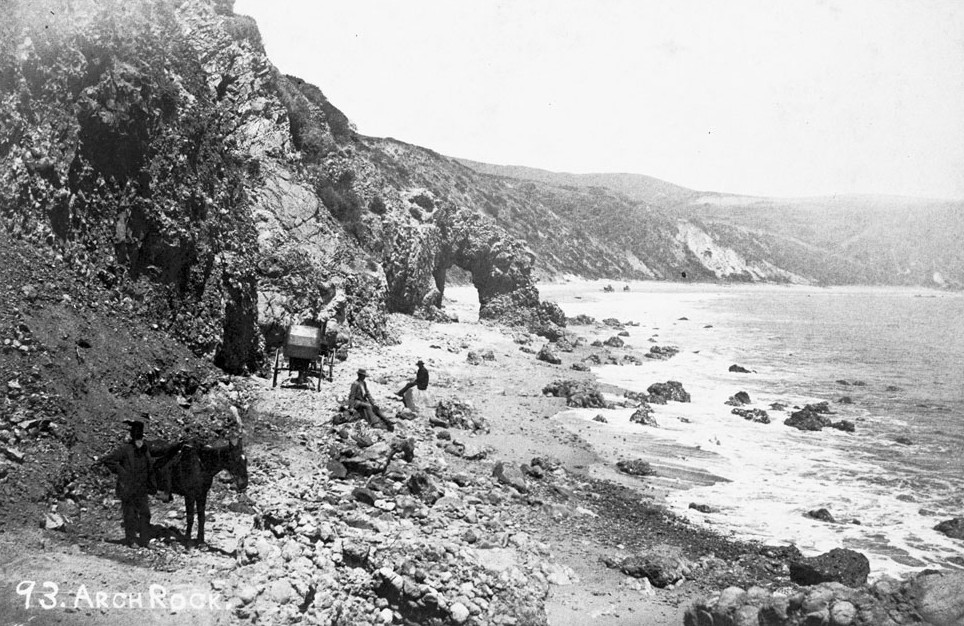 |
|
| (ca. 1880)** - View of Arch Rock (a stone formation) in Santa Monica, showing a group of men posing along the rocks nearby. The men can be seen in the center and left foreground area while either standing or sitting on rocks. In the center background, the natural rock formation can be observed while the shore is visible in the right. In the background, a ridge extends out across the horizon. |
Historical Notes One of Santa Monica’s natural wonders was the Arch Rock. It was so wide that during low tide, horse-drawn wagons could pass through its opening. It was located on what is now Pacific Coast Highway just south of Topanga Cyn Blvd. In the early 1890s, a primitive wagon road between Santa Monica and Malibu passed directly through the stony structure.*#* |
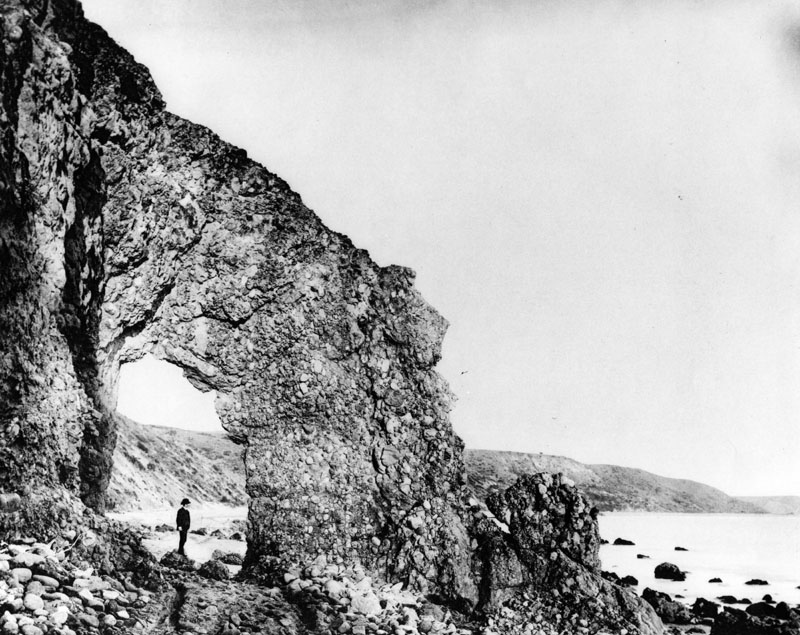 |
|
| (1890s)* - A man is seen standing on what appears to be a large rock directly below the natural arch. |
Historical Notes With improved access, the Arch Rock became a popular destination among excursion parties and day-trippers.*#* |
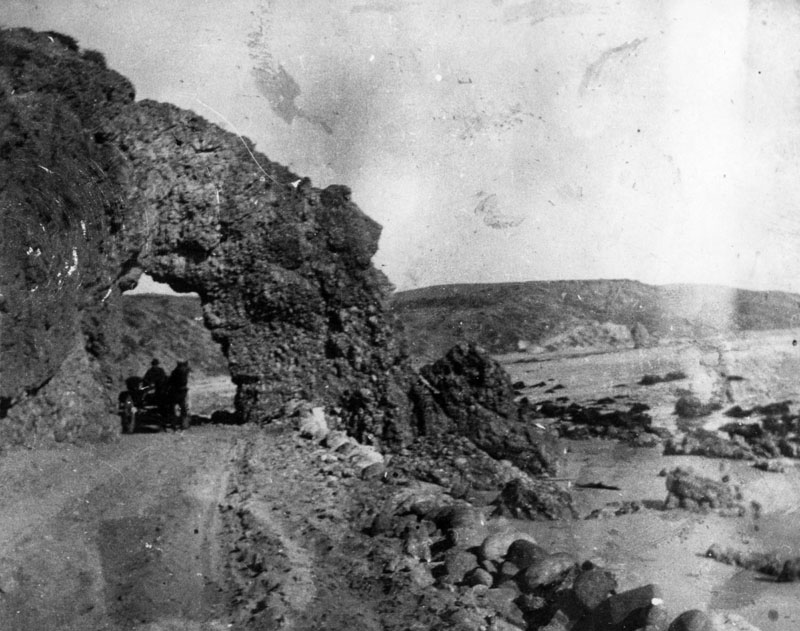 |
|
| 1890s)* - A horse and buggy are seen passing under the natural arch. |
Historical Notes The old stage road to San Francisco (later Pacific Coast Highway) passed under the Arch Rock on Santa Monica Beach.* |
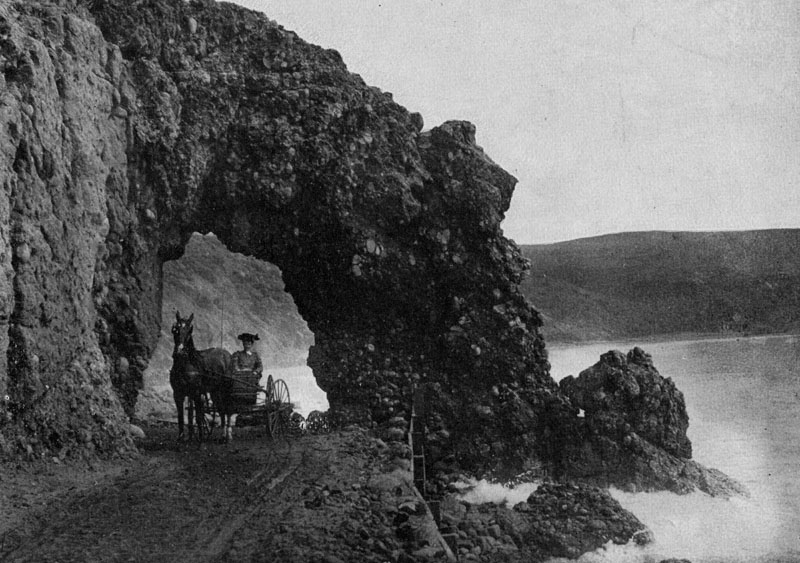 |
|
| (1890s)* - View of the Arch Rock, a natural formation on the old stage road (now Pacific Coast Highway) near Santa Monica. A horse and buggy pass under the natural arch during high tide. |
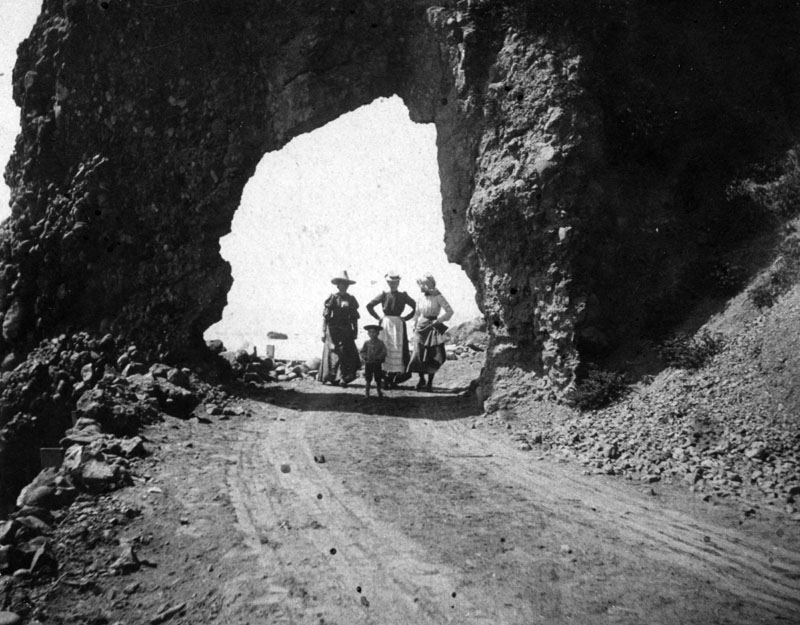 |
|
| (1890s)* - View showing three women and a child standing under the arch. |
Historical Notes For many nineteenth-century tourists, the Santa Monica Arch Rock was the place to see. It became the defining image of the Southern California coast.*# |
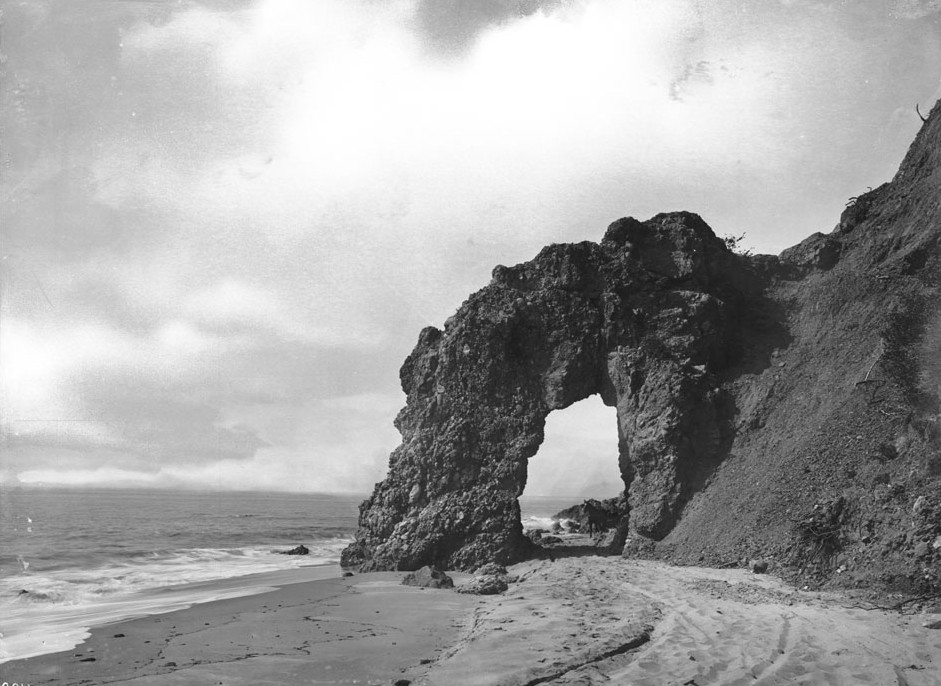 |
|
| (ca. 1895)** - View of Arch Rock on the Santa Monica Bay beach, looking north. A horse-drawn carriage is about to drive under it toward the foreground. |
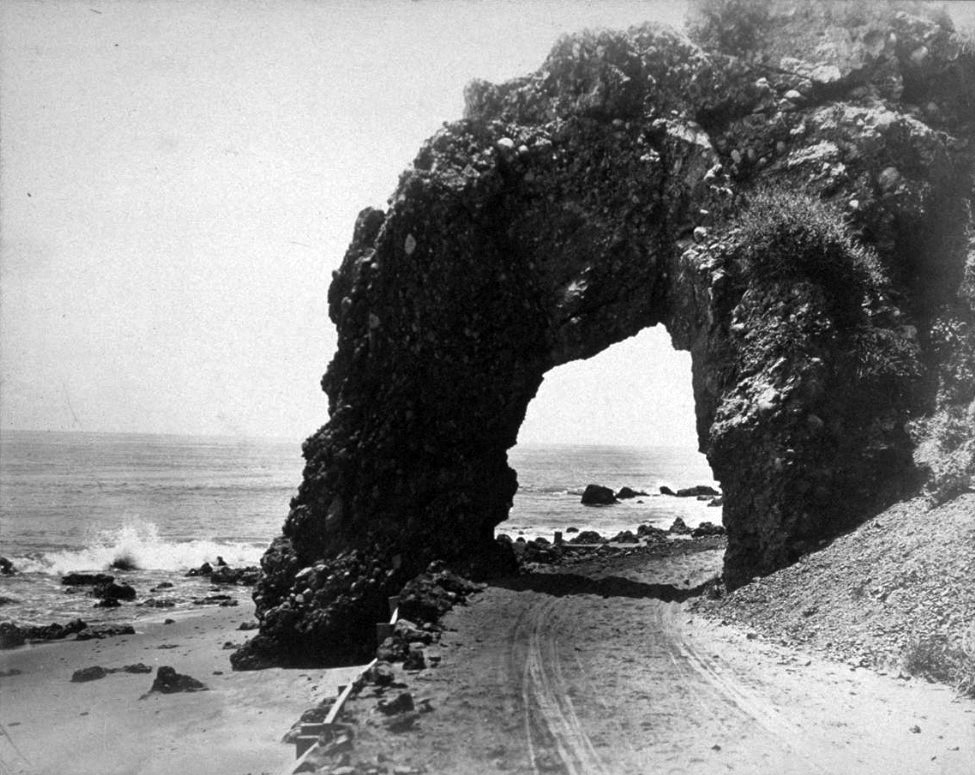 |
|
| (ca. 1906)#^# – Close-up view, looking north, of the Arch Rock. In the foreground can be seen the wood shoring supporting the dirt road going through the arch. |
Historical Notes On the morning of March 24, 1906, the bridge that once spanned the arch's two columns was found crumbled on the ground. Initial reports blamed a rainstorm, but rumors later circulated that work crews constructing a railroad to Ventura had blasted the rock, performing their nefarious deed under the cover of darkness because of public affection for the landmark. In turns out that the railroad was never completed, but some of the grading work was later incorporated into the coast highway.*#* |
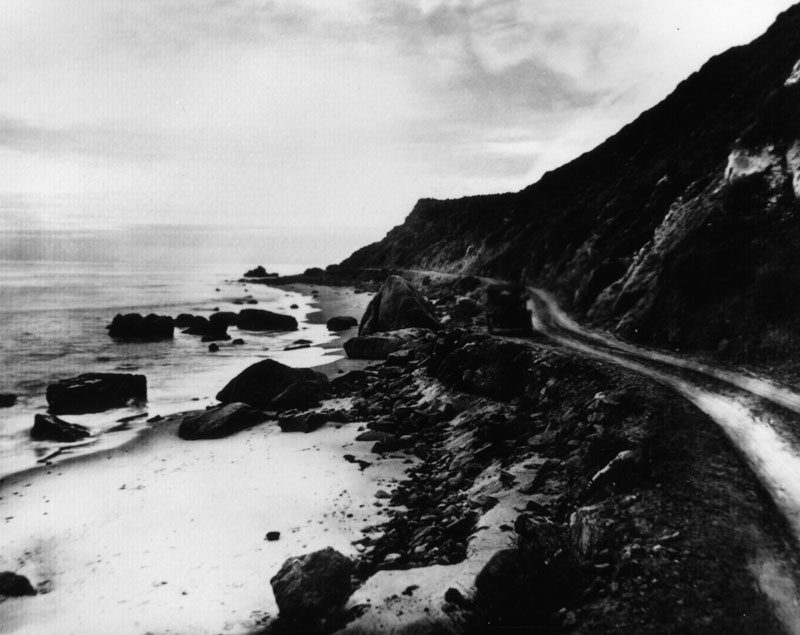 |
|
| (ca. 1920)* - View of old Roosevelt Highway (later Pacific Coast Highway) running parallel to the beach in Santa Monica. |
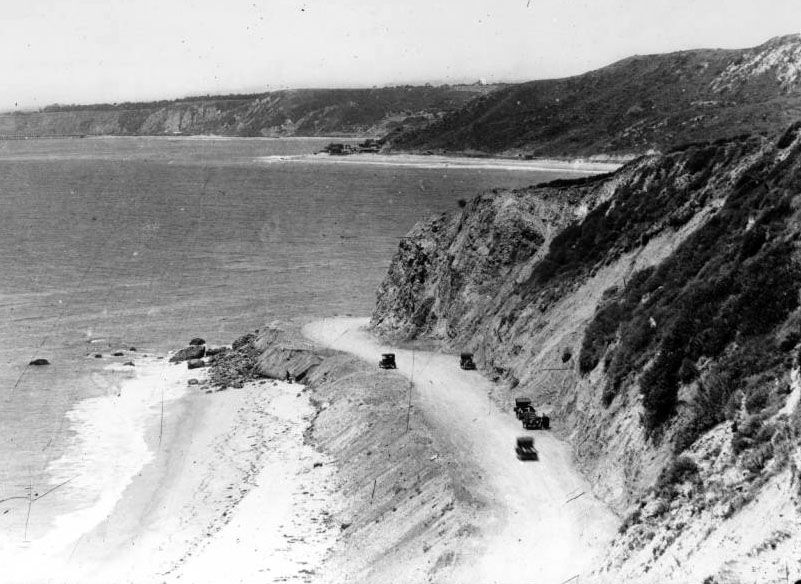 |
|
| (ca. 1920s)* - Site of Arch Rock after its demolition and subsequent highway grading. The arch was demolished in 1906. |
Historical Notes Today, Mastro's Ocean Club Restaurant (18412 E. Pacific Coast Hwy) is located where the picturesque Arch Rock once stood.* |
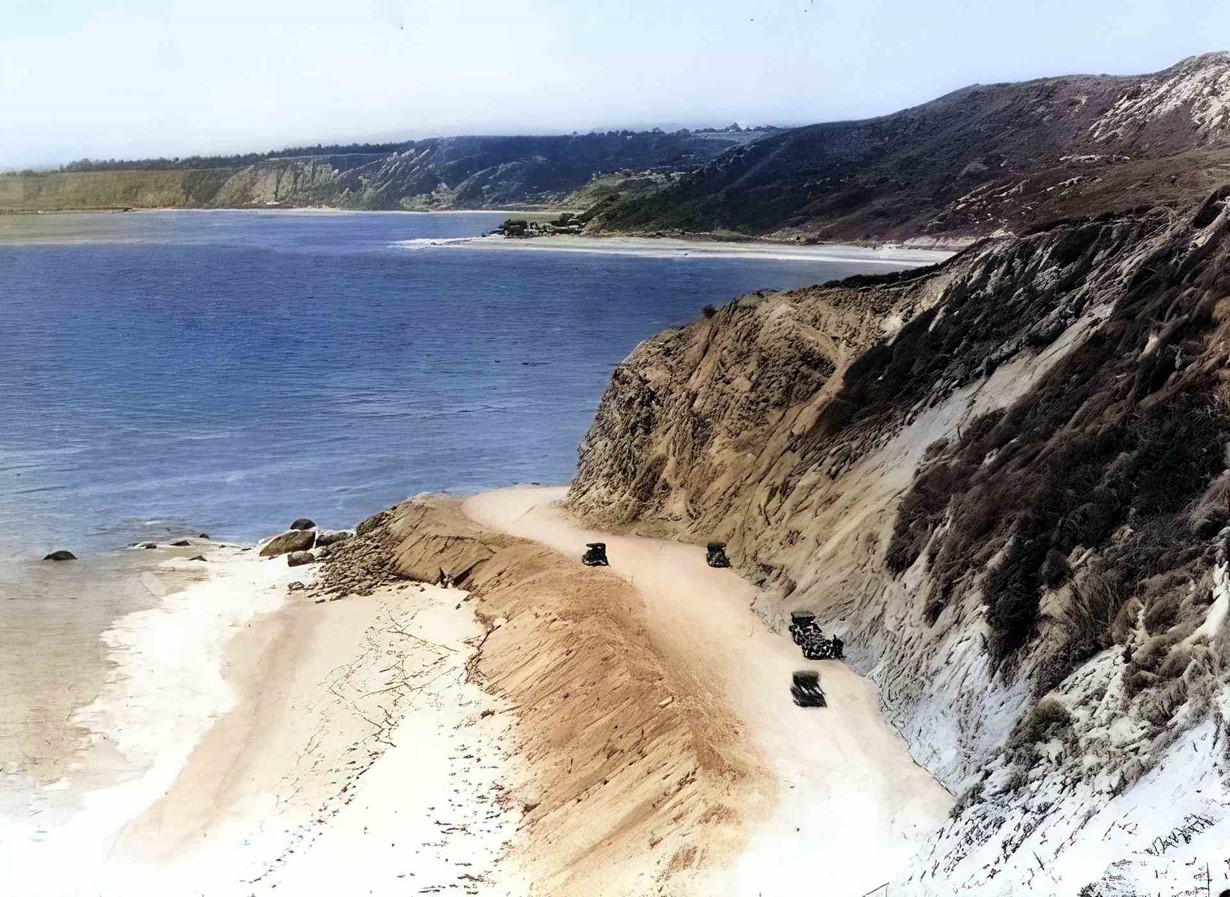 |
|
| (ca. 1920s)* - Site of Arch Rock after its demolition and subsequent highway grading. The arch was demolished in 1906. (AI image enhancement and colorization by Richard Holoff). |
Castle Rock and Haystack Rock
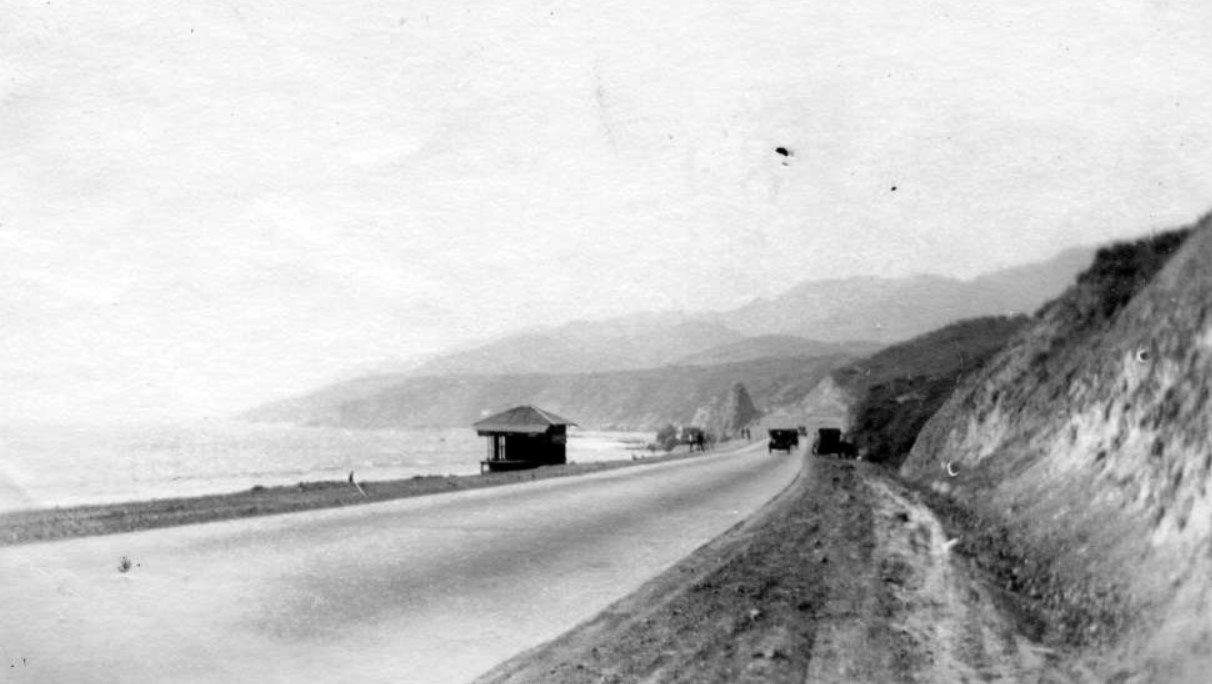 |
|
| (ca. 1915)^v^ - Cars approach Castle Rock on the coast road between Santa Monica and Malibu. Castle Rock was eventually demolished to expand the highway after World War II. |
Historical Notes Less than a mile down the coast, Castle Rock survived Arch Rock by several decades. Rising some fifty feet from a sandy beach, the promontory also became a cherished local landmark. In some ways, it functioned as a replacement for Arch Rock, with tourists routinely picnicking on the beach nearby.* |
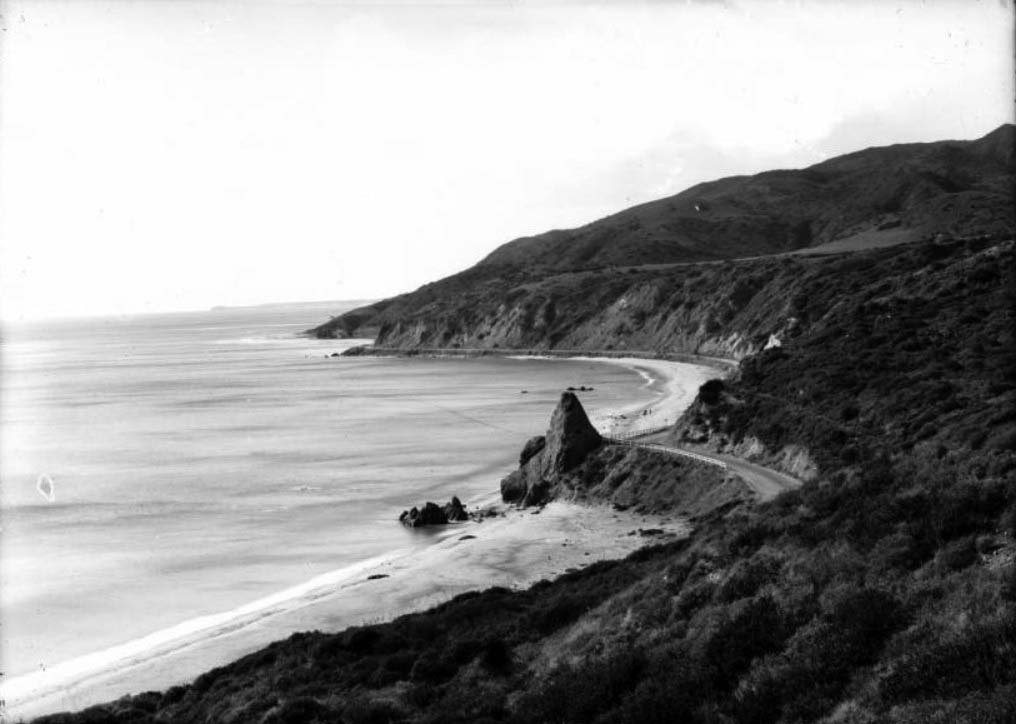 |
|
| (1910s)** - Photograph of Santa Monica's Palisades Park and Castle Rock. The conical rock is at center, jutting out from the shoreline above a sandy beach. Behind the rock at left, the Coast Highway can be seen winding its way along the shore. A wooden fence acts a guardrail near the rock. |
 |
|
| (1910s)** – Birdseye view of Castle Rock in Santa Monica from the north side hill. The large conical rock is at center, jutting out over a sandy beach at right. There is another large rock in the water near Castle Rock. Three people are seen walking near the breaking waves. |
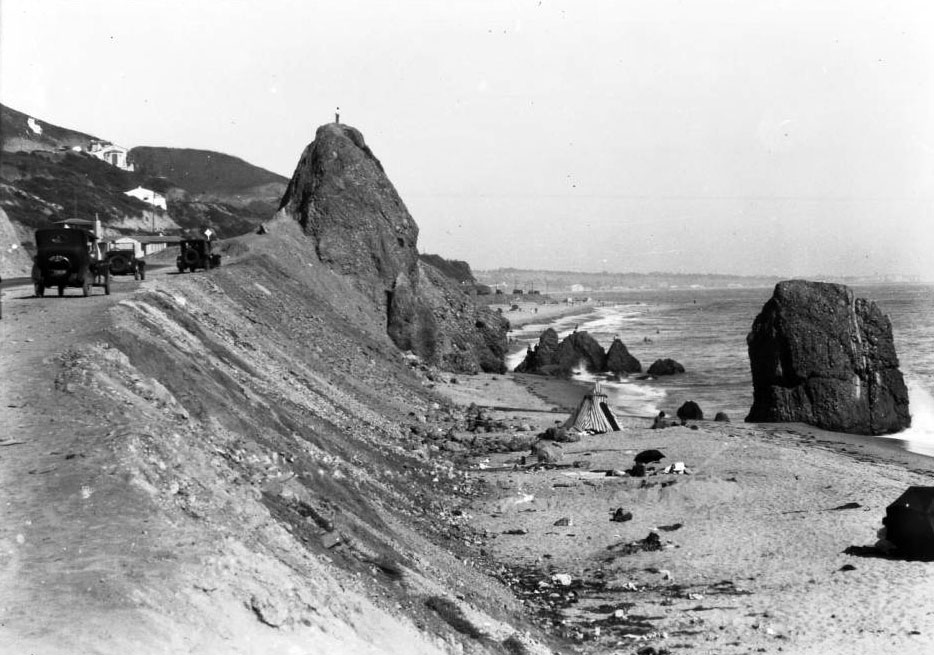 |
|
| (ca. 1920)** - Castle Rock, located between Sunset Boulevard and Coastline Drive north of Santa Monica. A man is seen standing on top of Castle Rock. |
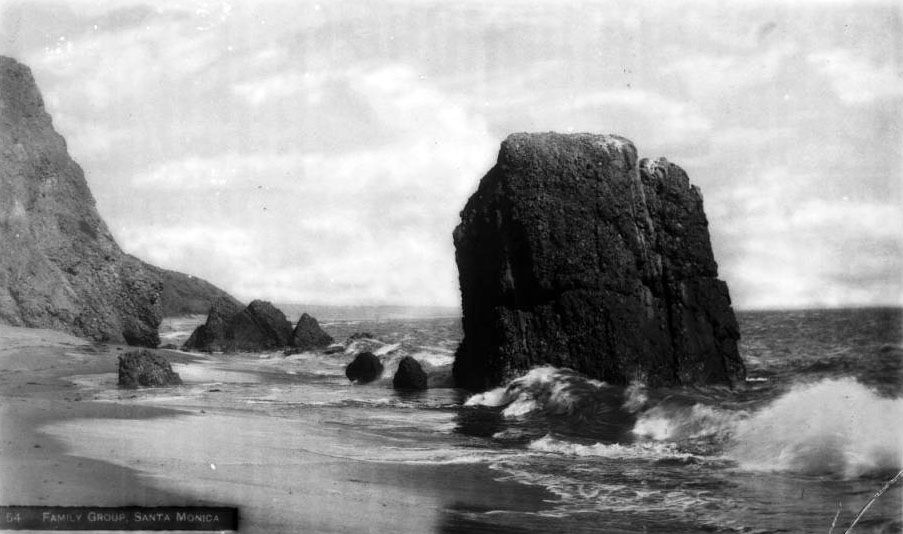 |
|
| (ca. 1925)** - Haystack Rock and the Family Group, located on the beach beneath Castle Rock. |
Historical Notes Picture-postcards romantically described Haystack Rock and the Family Group as the place "where the mountains meet the sea". *#* |
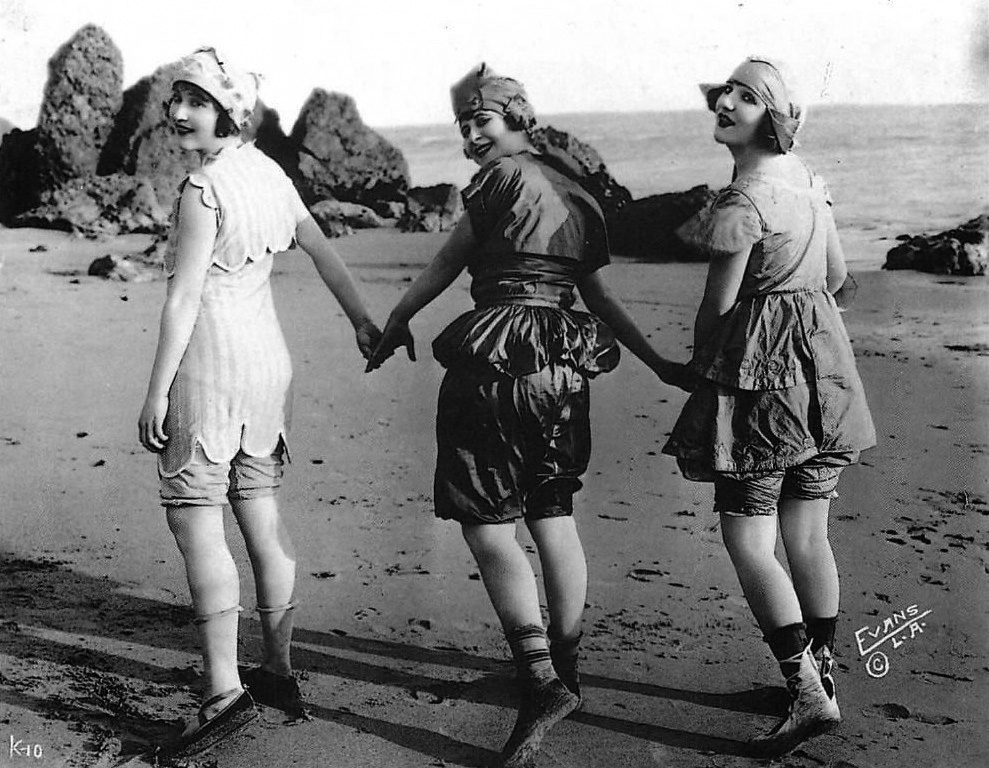 |
|
| (1918)**^ - Swimsuit in 1918 Fashion in Los Angeles Modern Postcard in front of Haystack Rock. It's difficult to imagine the beach attire in this photograph was once considered risque. |
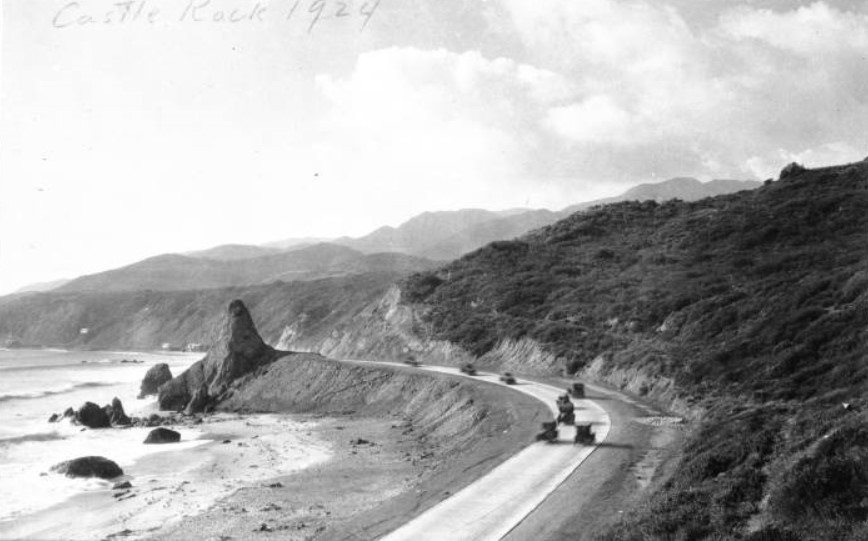 |
|
| (1924)*^ - View looking northwest showing early model cars passing Castle Rock on the two-lane Roosevelt Highway (now PCH). |
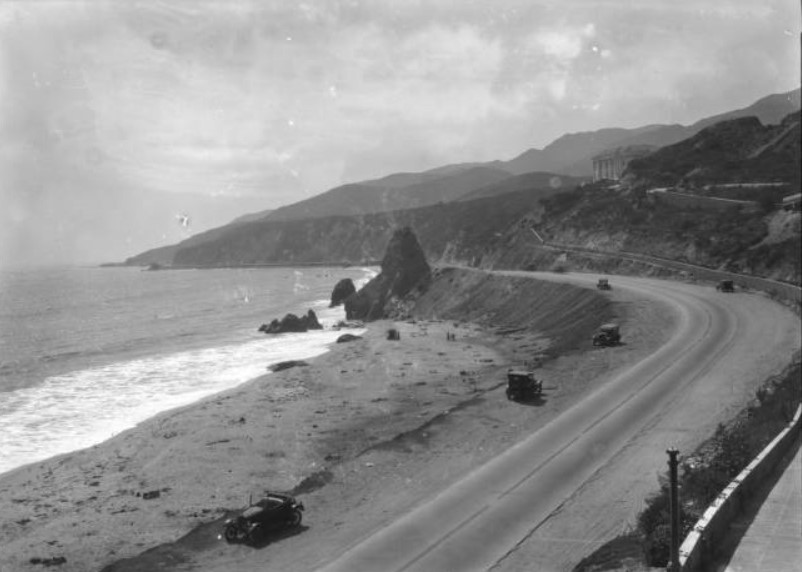 |
|
| (ca. 1928)** - View of Castle Rock in Santa Monica, looking northwest toward Topanga Canyon. The large conical rock is at center. At its base is a long sandy beach on which small waves are breaking and several people are playing. The Coast Highway is at right and winds its way along the shoreline, coming close to the back of Castle Rock. Several early-model automobiles are parked along the shoulders of the road. The right side of the road is bordered by steep hills. |
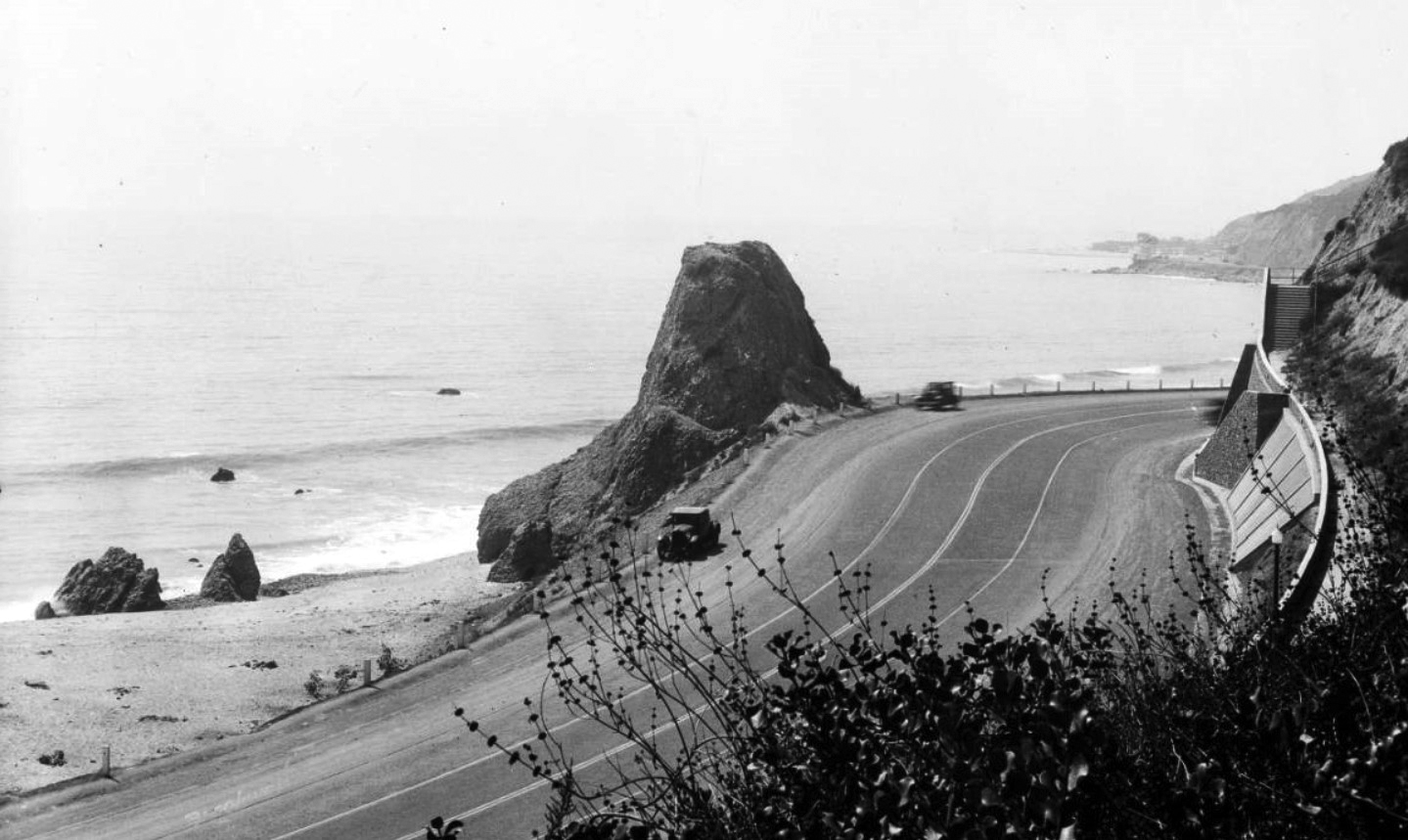 |
|
| (ca. 1930)#^^ - Closer view showing automobiles driving down Roosevelt Highway (later PCH) past Castle Rock in Santa Monica. |
Historical Notes Roosevelt Highway was improved in 1929-30 and officially named Coast Highway at that time. The Highway 1 designation came about in 1939*^ |
.jpg) |
|
| (1936)* - Closer view of Castle Rock as seen from the hillside across Roosevelt Highway at Castellamare. |
Historical Notes Castle and Haystack Rocks appeared as a backdrop in numerous films, and in 1945 Marilyn Monroe posed in front of Castle Rock in one of her first photo shoots.* |
 |
|
| (ca. 1920s)^v^ - Postcard view showing Castle Rock silhouetted against a moonlit ocean with the Malibu coastline in the background. |
Historical Notes Castle Rock used to stand beside the Roosevelt Highway at the water's edge near the present-day location of the Getty Center Villa. Castle Rock was demolished in 1945 in order to expand the highway, renamed the Pacific Coast Highway. |
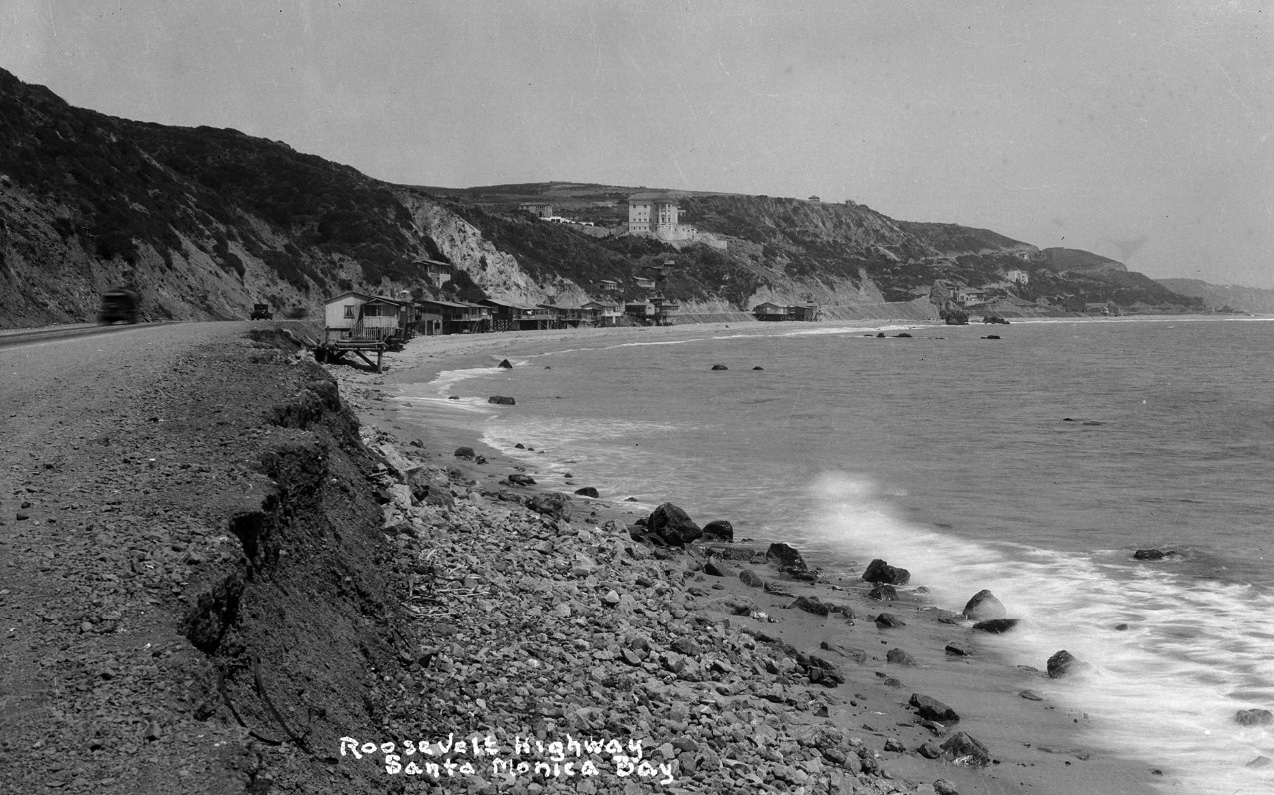 |
|
| (ca. 1927)** - Coastal view looking south towards the Villa de Leon, visible at the top of the slope in the distance, and Castle Rock. Writing on postcard reads Roosevelt Highway, Santa Monica Bay. |
Then and Now
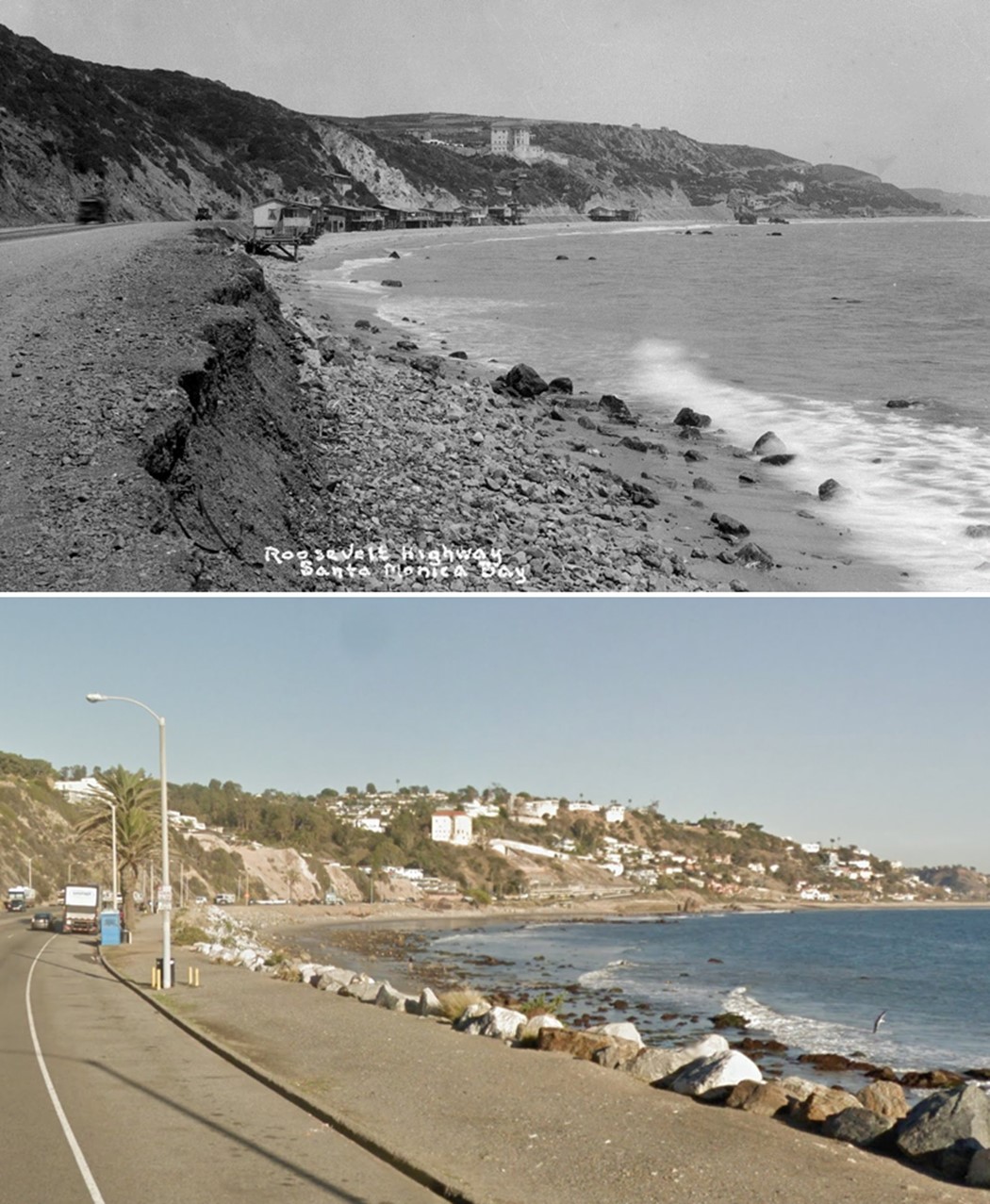 |
|
| (1927 vs 2016)* - Roosevelt Highway (today PCH, CA-1). View looking south towards Villa de Leon, visible at the top of the slope in the distance. |
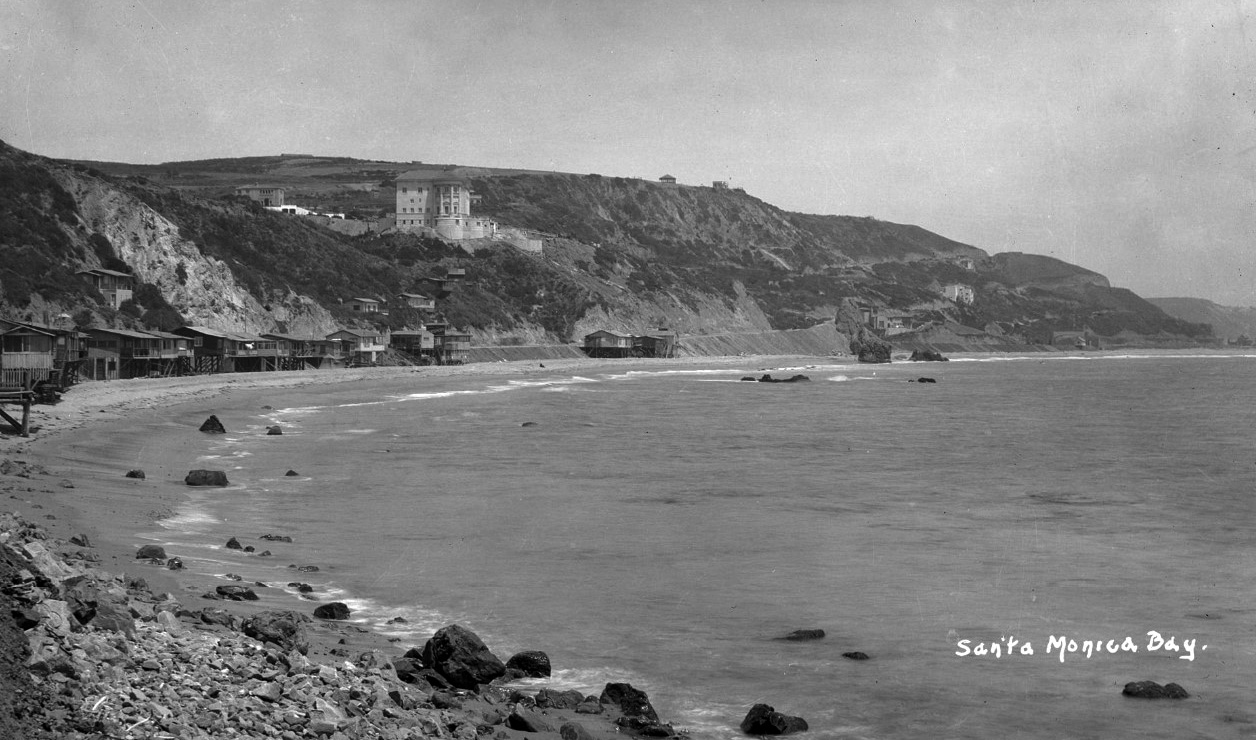 |
|
| (ca. 1927)** - View of the Topanga and Pacific Palisades coast in Santa Monica Bay facing east-southeast towards castle rock in the far distance. Beach houses line the shore with the Roosevelt Highway (later Pacific Coast Highway) and coastal slopes behind them. The Villa de Leon (Leon Kauffmann residence, 17948 Porto Marina Way, is visible at the top of a slope. |
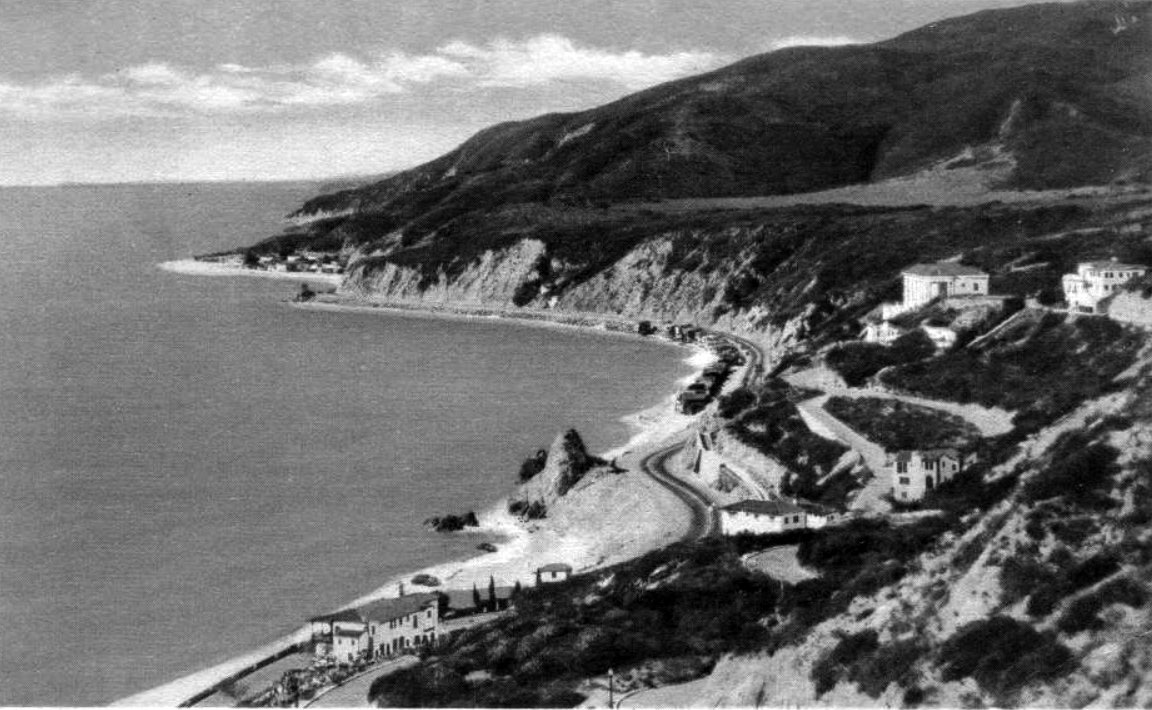 |
|
| (1930s)^v^ - The rock formation known as Castle Rock appears here (center of image) in a view looking west toward Malibu. The Roosevelt Highway (later Pacific Coast Highway) winds through coastal homes. Note the mansions that now appear on the hillside. Castle Rock was demolished to expand the highway just after World War II. |
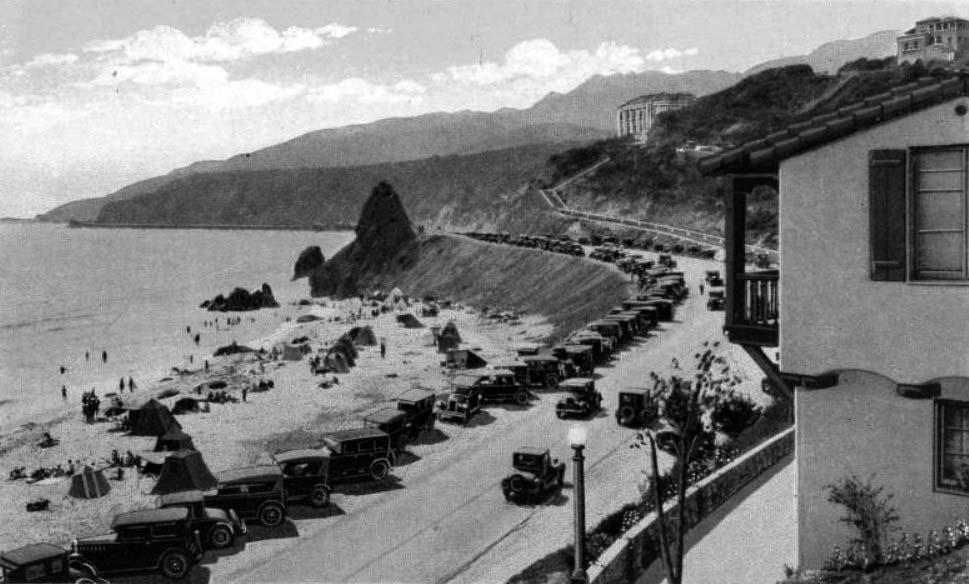 |
|
| (ca. 1930)** - Postcard view of the Coast Highway at Castle Rock, near Santa Monica. Along the edge of the roadway, numerous cars are parked in one row and tents dot the sandy beach. In the background are large estates atop the mountain, one of which is the Villa de Leone, completed in 1928. |
Historical Notes Castle Rock used to stand beside the Roosevelt Highway at the water's edge near the present-day location of the Getty Center Villa and Villa de Leone. Castle Rock was demolished in 1945 in order to expand the highway, renamed the Pacific Coast Highway (see next photo). |
 |
|
| (1950s)^v^ - View looking west (technically speaking) of Pacific Coast Highway, which was also known in the 1950s as a Highway 101 alternative. Center-left in the image is the former location of Castle Rock, which had been demolished several years earlier to expand the highway to four lanes. |
Villa de Leon
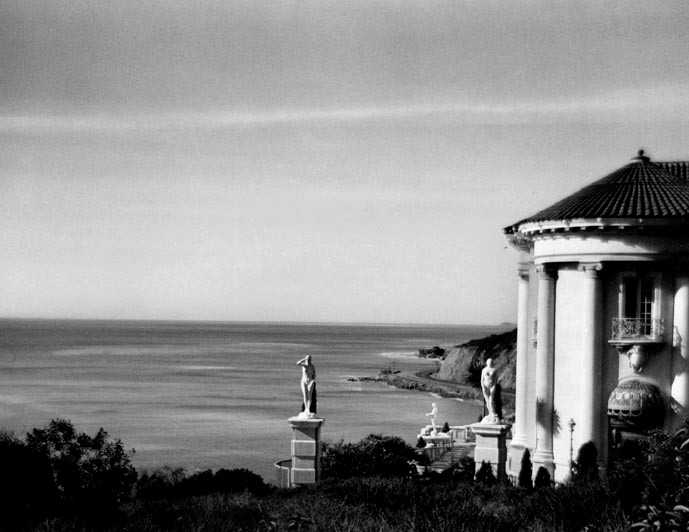 |
|
| (1930s)* - View showing the coastline and Pacific Coast Highway as seen from the grounds of the Villa de Leon. |
Historical Notes Named after its original builder, Austrian native Leon Kauffman, the Villa Leon was the result of a longstanding promise Kauffman had made to his wife Clemence that, if he ever had the money, he would build for her a dream castle by the sea. A fortune made in the wool processing business in California during the First World War allowed Kauffman to make good on his promise and, after purchasing an impressive six-lot parcel above the famous Castle and Haystack Rock formations, Kauffman began construction of his $1,000,000 dream house in 1926.^ |
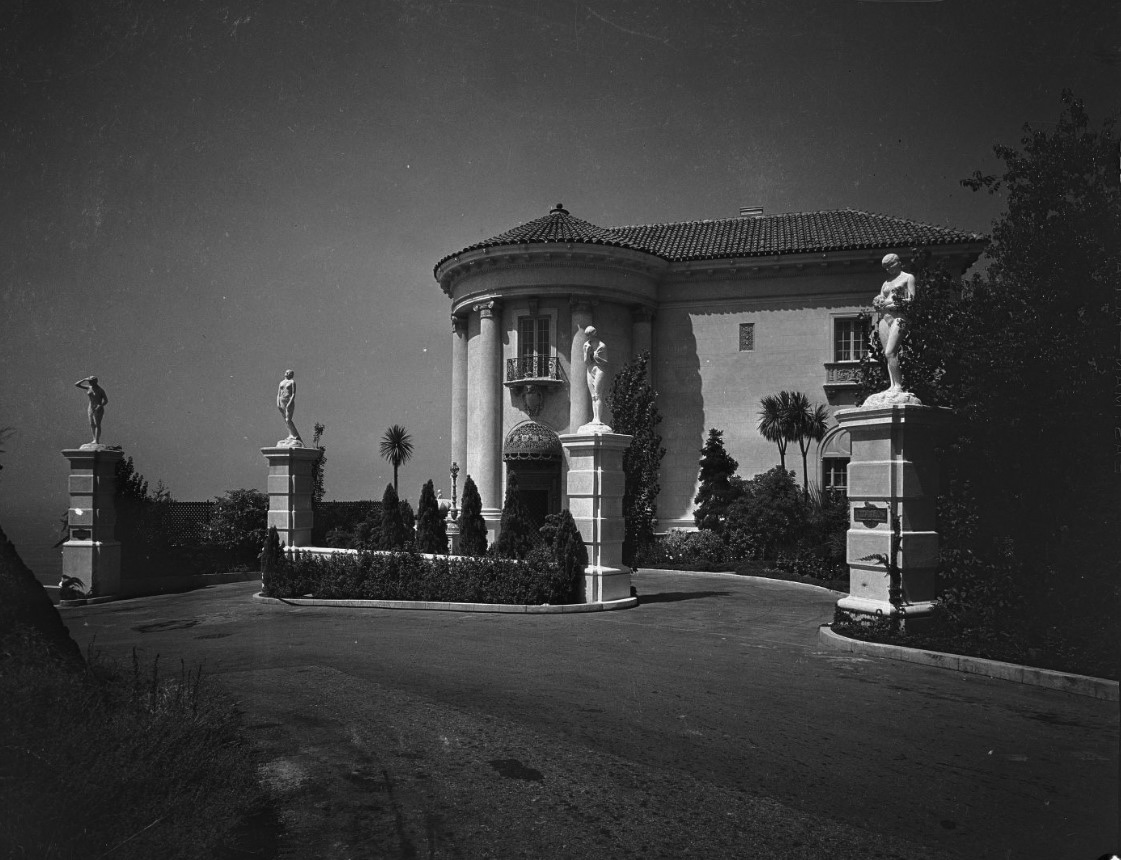 |
|
| (1929)^ – Close-up view of the front entrance to the Villa de Leon located at 17948 Porto Marina Way. At the time it was built (1927), it was one of the largest villas in Southern California. |
Historical Notes Leon Kauffman selected architect Kenneth MacDonald in 1926 to design this 12,000-square-foot palazzo in the Beaux- Arts European tradition. This imposing structure features 35 rooms, including nine bedrooms, 11 bathrooms, a huge grand salon (32’ x 64’), a library, a circular dining room, a butler’s pantry, an elevator and a seven-car garage. The construction price of $1 million (that was a lot of money in the late ‘20s!) included a first-ever central vacuum, several hand-made crystal chandeliers, Italian tiles, imported marbles, hand-carved wooden beams, mahogany paneling from Thailand, magnificent wrought-iron gates, even gold grouting for the Italian tiles. The Villa de Leon took five years to complete.* |
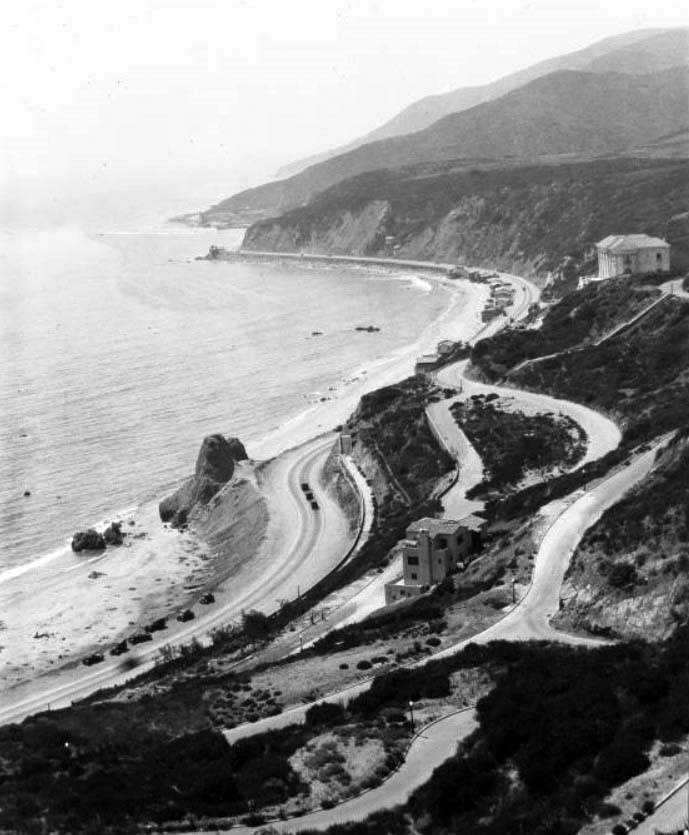 |
|
| (ca. 1930)** – Birdseye view of the Santa Monica shoreline north from Castellammare Drive. Villa de Leon sits in the upper right on the edge of the cliffs overlooking Castle Rock below. |
Historical Notes Leon Kauffman purchased six elevated lots in the 1920s in the new Castellammare (Castle by the sea) area on the Malibu coast, North of Sunset Boulevard and high above what would soon become Roosevelt Highway, predecessor of the Pacific Coast Highway.* |
.jpg) |
|
| (1929)^ - Villa de Leon (Leon Kauffmann residence) and the coast beyond with early model car parked in the driveway. |
Historical Notes When first built, the Villa de Leon boasted topiary gardens, a pipe organ and beach access via a private funicular railway, very expensive amenities that have not survived the passage of time. |
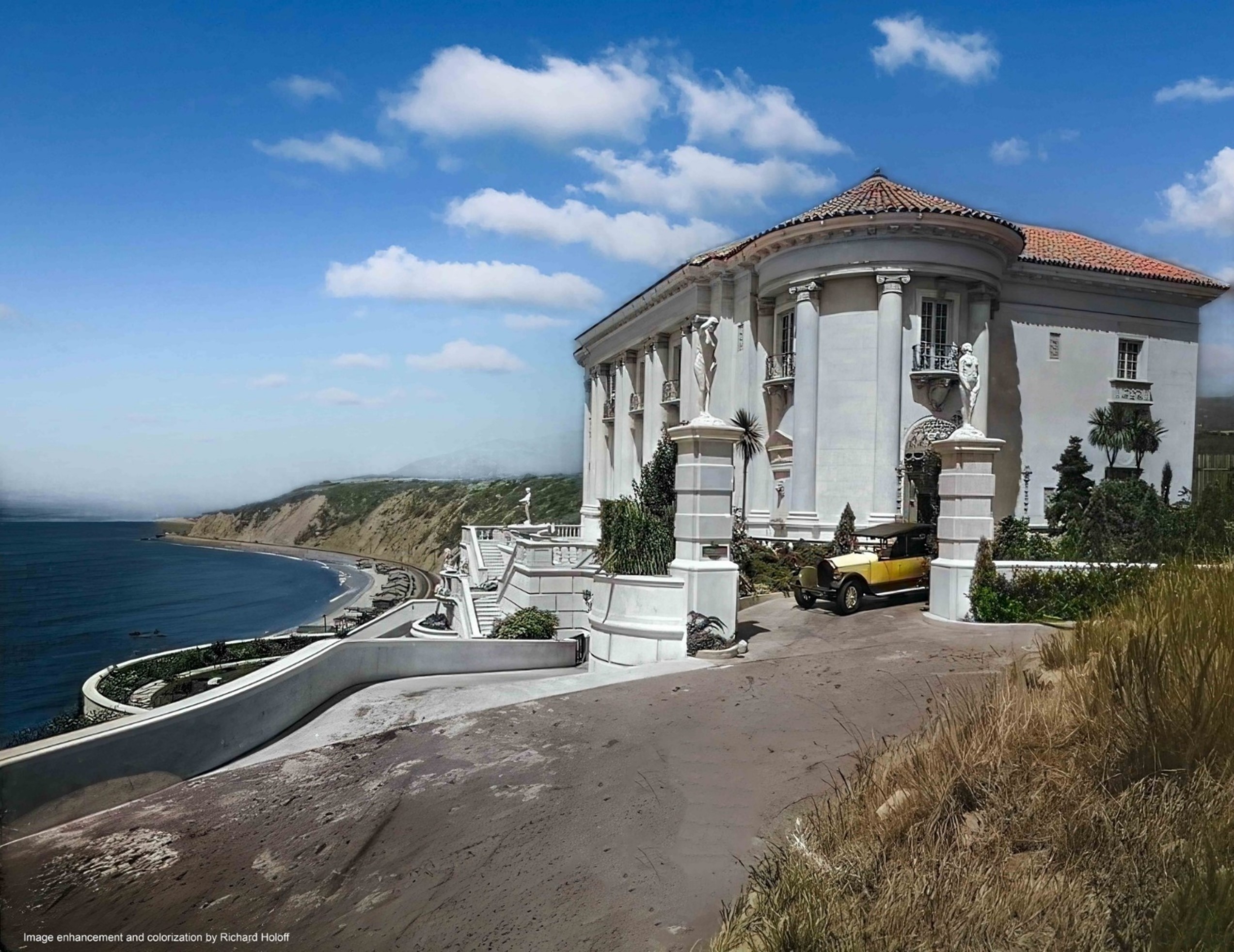 |
|
| (1929)^ - Villa de Leon (Leon Kauffmann residence) and the coast beyond with early model car parked in the driveway. Image enhanced and colorized by Richard Holoff. |
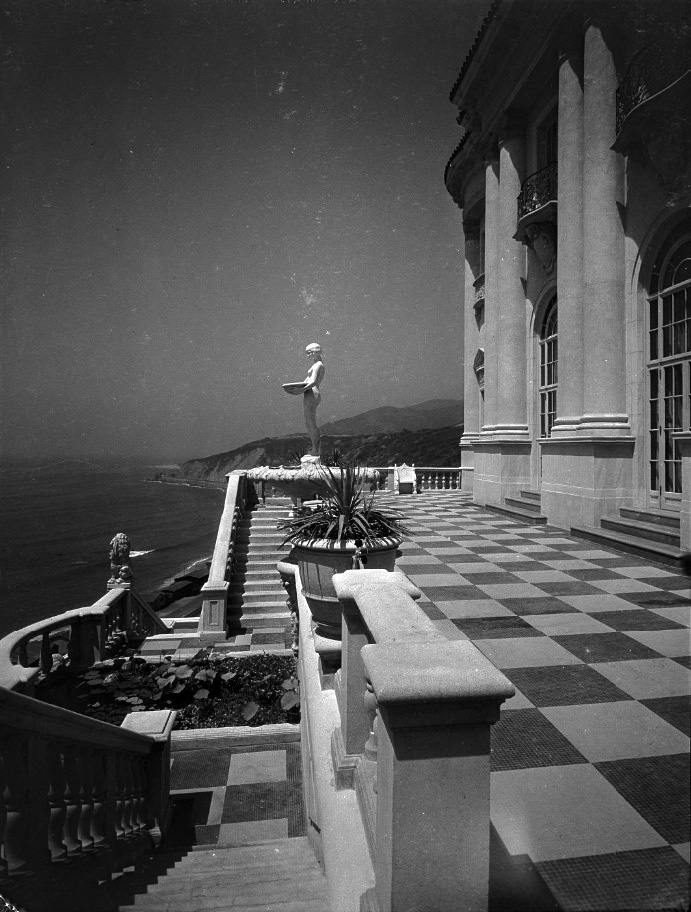 |
|
| (1929)^ - Exterior view of the ocean front terrace and terrace facade of the Villa de Leon, and the stairs leading from the paved terrace to the garden terrace below. The terrace is paced in a checkerboard pattern of dark and light stone. There is a nude statue on a pedestal and the coast is visible beyond the terrace. |
Historical Notes The Kauffmans lived in the house for five years before Leon’s wife (Clemence) died, and Leon lived only another two years. Their grown son chose not to live in the house, which was overseen by caretakers until 1952, when the estate was settled.* |
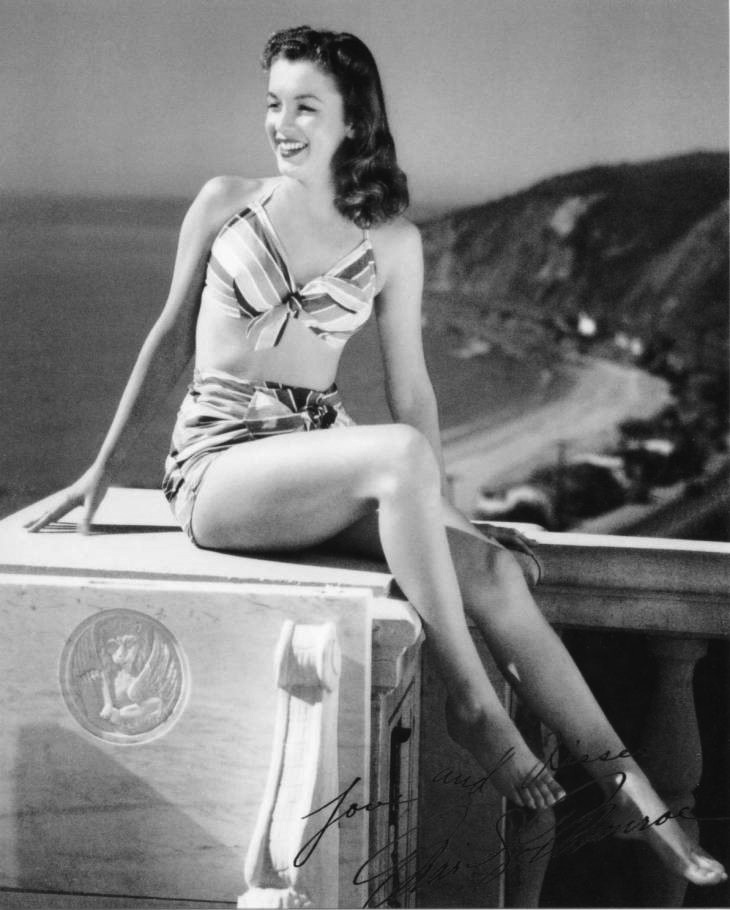 |
|
| (1946)** - Marilyn Monroe, then known as Norma Jean Baker, poses for a bikini pin-up on the terrace of Villa de Leon with the Topanga coastline in the background. Photo by Joseph Jasgur |
Historical Notes Villa de Leon has been featured in countless productions over the years, most notably photo shoots. |
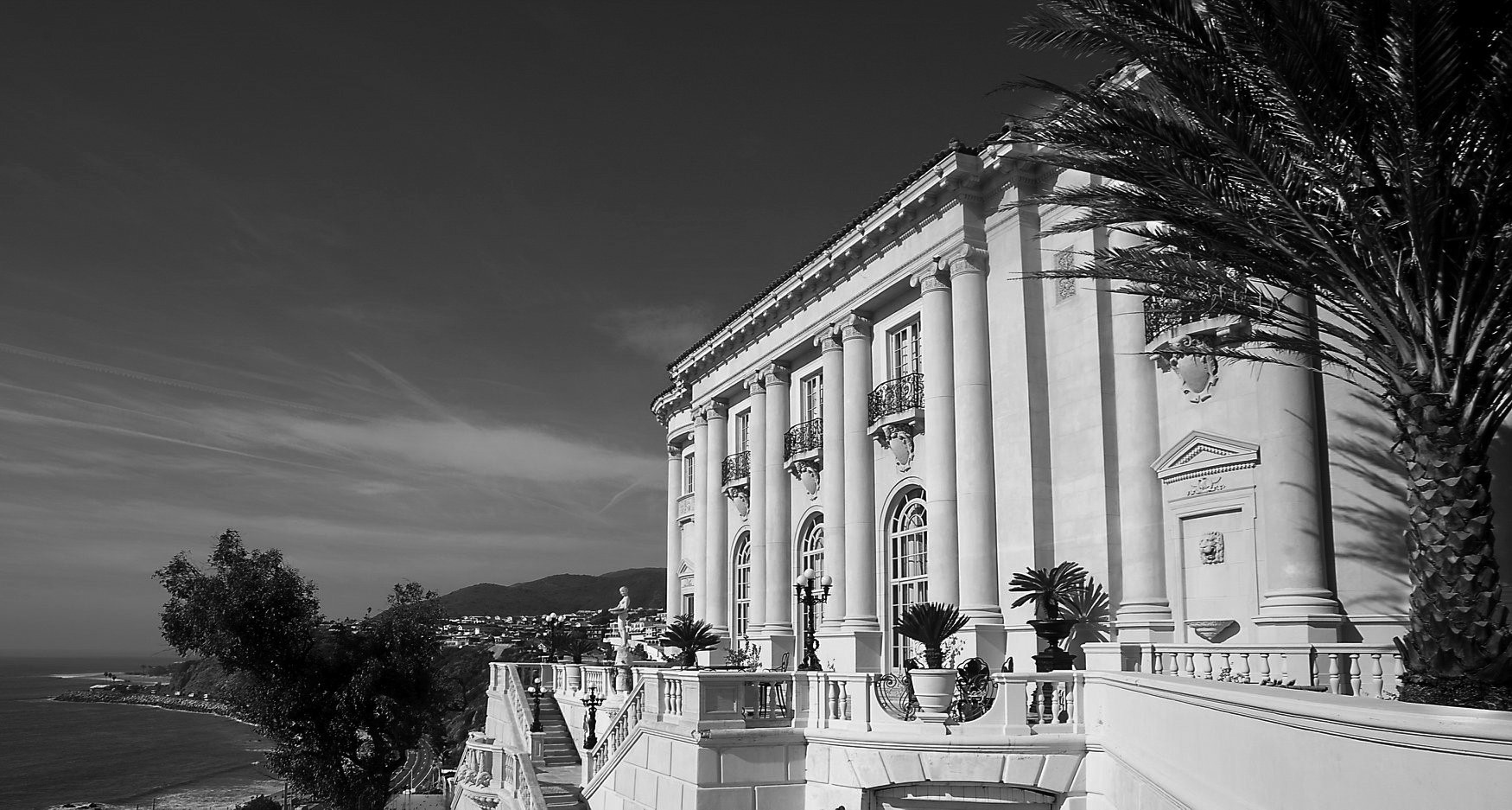 |
|
| (2020)^ - Panoramic view showing the Villa de Leon as it appears today. Photo courtesy of California Heritage |
Historical Notes The mansion overlooks Pacific Coast Highway and the Pacific Ocean and is situated in close proximity to the Getty Villa. It was designed by prominent Los Angeles architect Kenneth A. MacDonald, Jr. in 1926 for Austrian builder and investor in wool Leon Kauffman. |
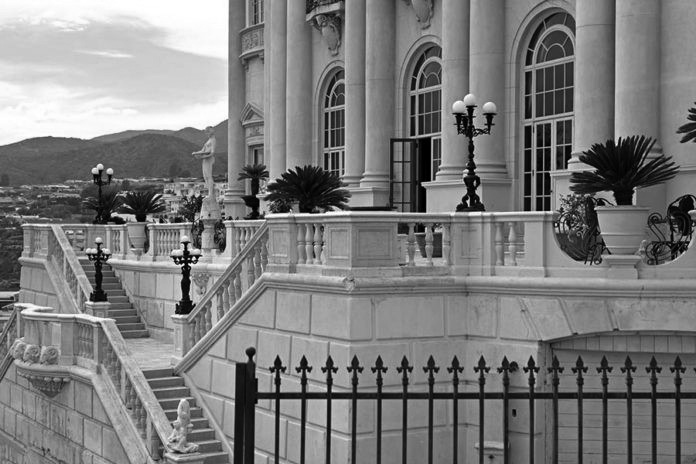 |
|
| (2017)^^ - Close-up view showing stairs leading to the terrace of Villa de Leon. Palisadian-Post |
Historical Notes The Villa de Leon has been used in many high-profile music videos, commercials, and printed ads such as Beyonce's "Haunted," Lady Gaga's "Paparazzi," Britney Spears's My Prerogative body fragrance commercial, Camila Cabello "Liar", Ariana Grande, Miley Cyrus and Lana Del Rey "Don't Call Me Angel", Rod Stewart's Christmas special Rod Stewart: Merry Christmas, Baby, and shoots featuring Heidi Klum, Victoria Beckham, Robert Pattinson, and Reese Witherspoon. Its highly recognizable grand staircase has been a major focal point in several of these videos and photographs, as has its balconies and their balustrades, including their appearance on the cover of English rock band Procol Harum's 1973 album, Grand Hotel.*^ |
|
Historical Notes Today, many first-time visitors to the adjacent J. Paul Getty Villa mistake the Italianate Revival palazzo, the Villa de Leon, for the Getty Villa museum, not visible from the Pacific Coast Highway. Even the New York Times and The Wall Street Journal have mis-identified Villa de Leon thinking it was the Getty Villa. |
* * * * * |
Roosevelt Highway
 |
|
| (ca. 1930)** - Automobiles driving on the Roosevelt Highway (PCH) at Porto Marina Way. Almost every parking space is taken along the side of the road. Tents, umbrellas, and sunbathers are visible on the beach at left, while Castle Rock can be seen further back on the ocean side of the highway. Large homes are visible on the hills at right in the Castellammare neighborhood , while mountains can be seen in the distance. The site of Thelma Todd's Sidewalk Cafe restaurant is out of frame on the right although still a couple of years in the future (1932). |
Historical Notes The new Castellammare neighborhood became popular with the Hollywood crowd. John Barrymore, Thelma Todd and Joseph Cotton had homes in the area. |
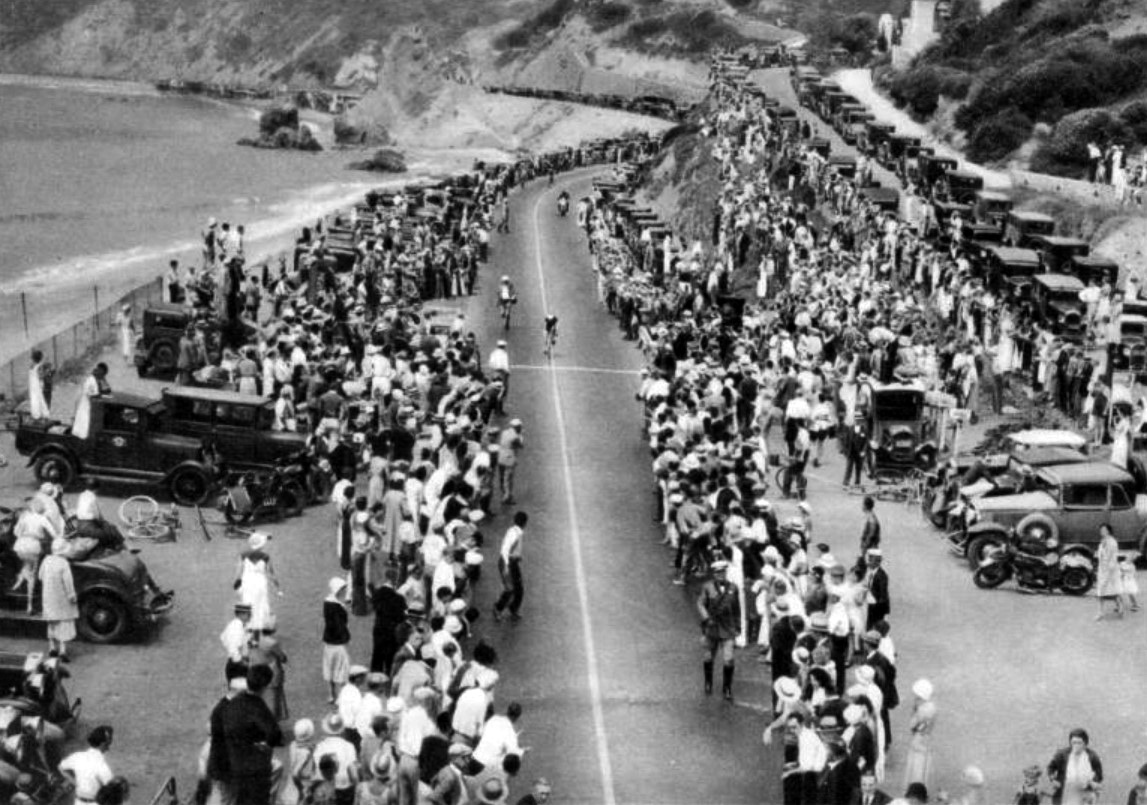 |
|
| (1932)^ - Onlookers and their cars crowd the edge of the Roosevelt Highway as cyclists approach the finish line during the 1932 Olympics. Castle Rock is in the background. Photo taken from the newly constructed footbridge over the highway. |
Historical Notes For the 1932 Summer Olympics, the segment of the PCH between Oxnard and Santa Monica (then known as the Theodore Roosevelt Highway) hosted part of the road cycling events. |
 |
|
| (1926)* – A woman looks down toward Roosevelt Highway (later PCH) at Castellammare where a pedestrian bridge is under construction. Photo by Dick Whittington |
 |
|
| (1926)* – View showing a pedestrian bridge being built over Roosevelt Highway (PCH) at Castellammare. The bridge provided beach access for residents of the new Castellammare development. Photo by Dick Whittington |
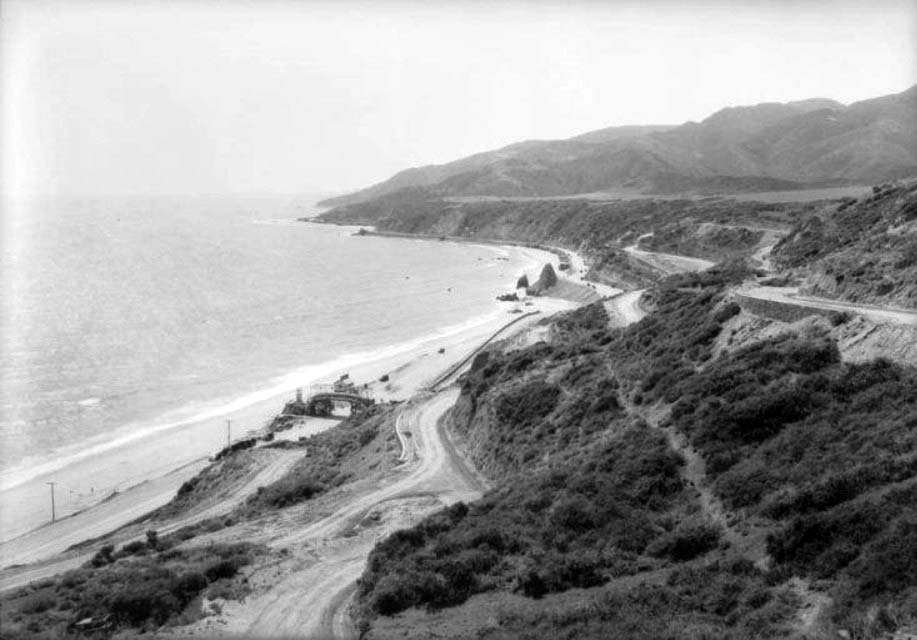 |
|
| (1926)* - View of the Castellammare development following the subdivision but before any houses were built. Pedestrian bridge can be seen down on Roosevelt Highway (PCH) which appears to be a dirt road. Castle Rock can be seen in the distance. Photo by Dick Whittington |
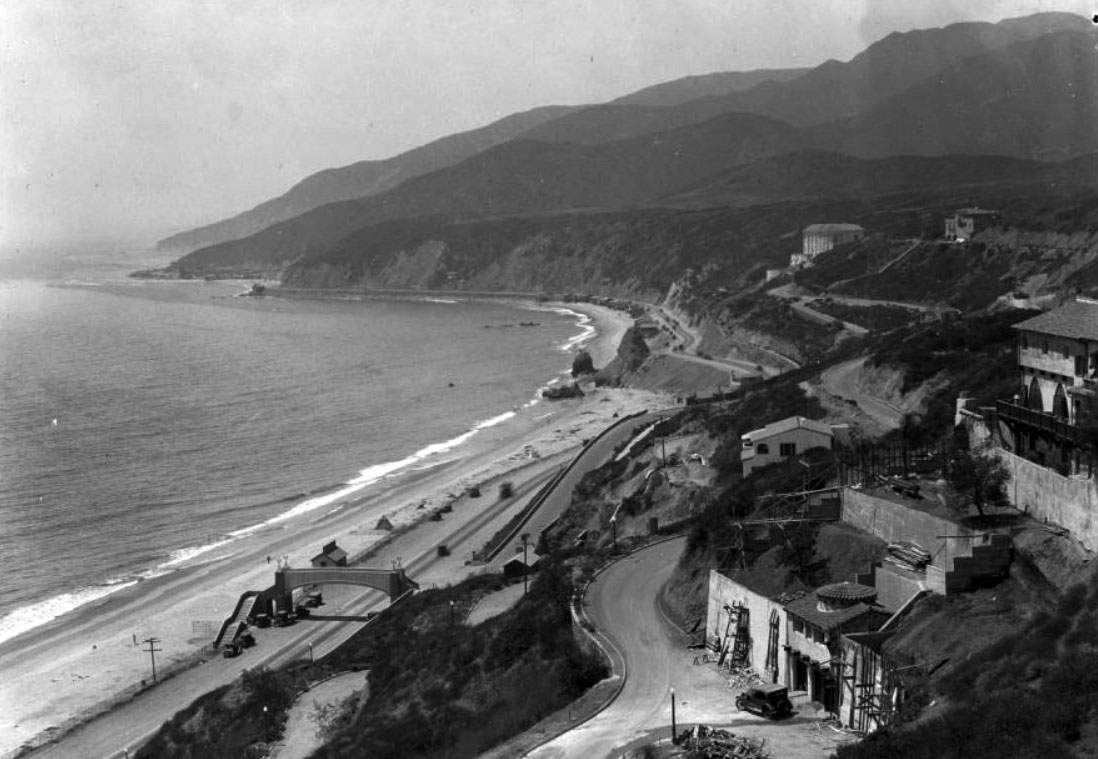 |
|
| (ca. 1928)** - Birdseye view of the Santa Monica shoreline north from Castellammare Drive. In the foreground, next to the footbridge over the highway, is the Thelma Todd Sidewalk Café, still under construction. Castle Rock is seen in the distance with the Villa de Leon standing watch in the hills above it. |
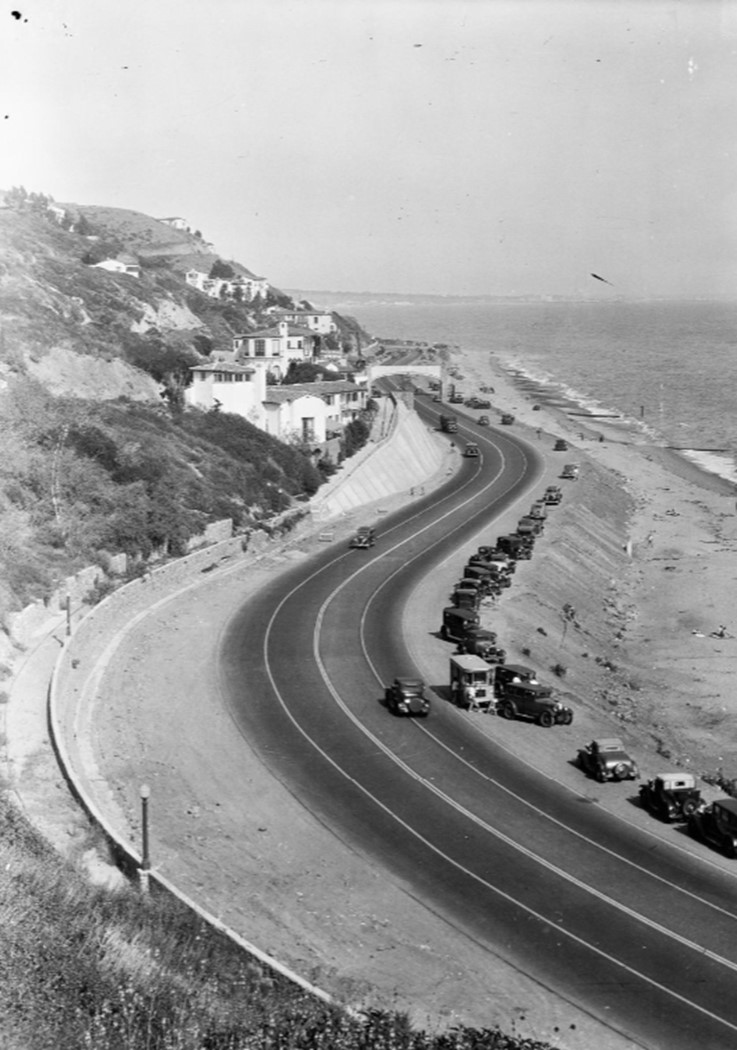 |
|
| (1930s)* - Image of the Castellammare neighborhood on the Roosevelt Highway (later Pacific Coast Highway) in Pacific Palisades, with automobiles parked along the beach, including a small trolley or bus marked "6" in the foreground and an elevated pedestrian crossing in the distance. Photo by Bob Plunkett |
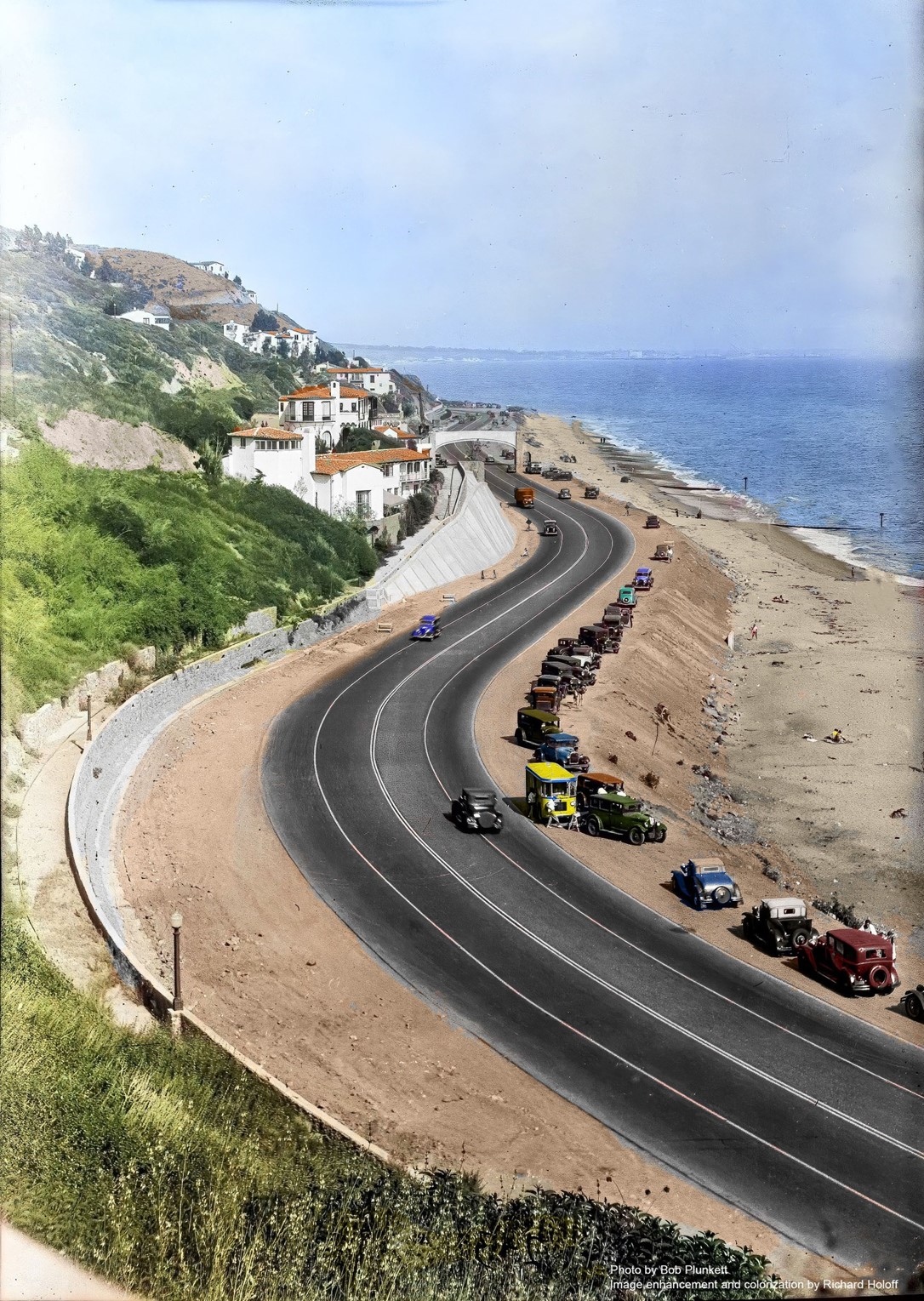 |
|
| (1930s)* - Image of the Castellammare neighborhood on the Roosevelt Highway (later Pacific Coast Highway) in Pacific Palisades, with automobiles parked along the beach, including a small trolley or bus marked "6" in the foreground and an elevated pedestrian crossing in the distance. Photo by Bob Plunkett; Image enhancement and colorization by Richard Holoff |
* * * * * |
Thelma Todd's Sidewalk Café
.jpg) |
|
| (1935)* - Close-up view of Thelma Todd's Sidewalk Café located at 17575 Pacific Coast Highway in Pacific Palisades. The structure was built in 1928. |
Historical Notes Thelma Todd's Sidewalk Café was a notable Hollywood hotspot in the 1930s, located at 17575 Pacific Coast Highway in the Castellammare neighborhood of Pacific Palisades, California. The building and café have a rich history intertwined with Hollywood's Golden Age and a tragic mystery. |
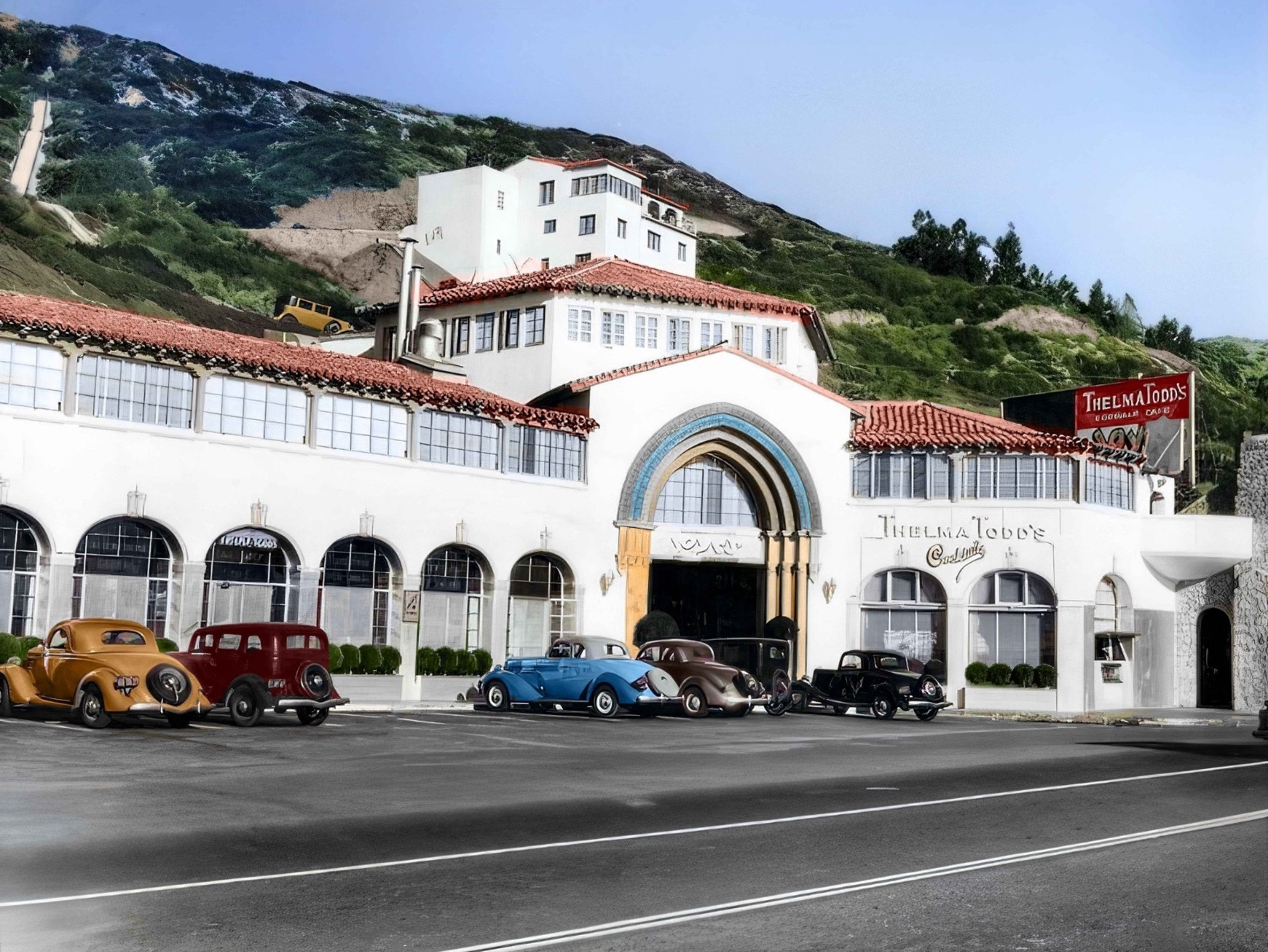 |
|
| (1935)* - Close-up view of Thelma Todd's Sidewalk Café located at 17575 Pacific Coast Highway in Pacific Palisades. Image enhancement and colorization by Richard Holoff |
Historical Notes The Spanish-style building that housed Thelma Todd's Sidewalk Café was originally constructed in 1928. It was designed by architect Mark Daniels in the California Mediterranean and Spanish Colonial Revival styles with Moorish influences. Initially, the structure served as a shopping center for the nearby Castellammare housing development. |
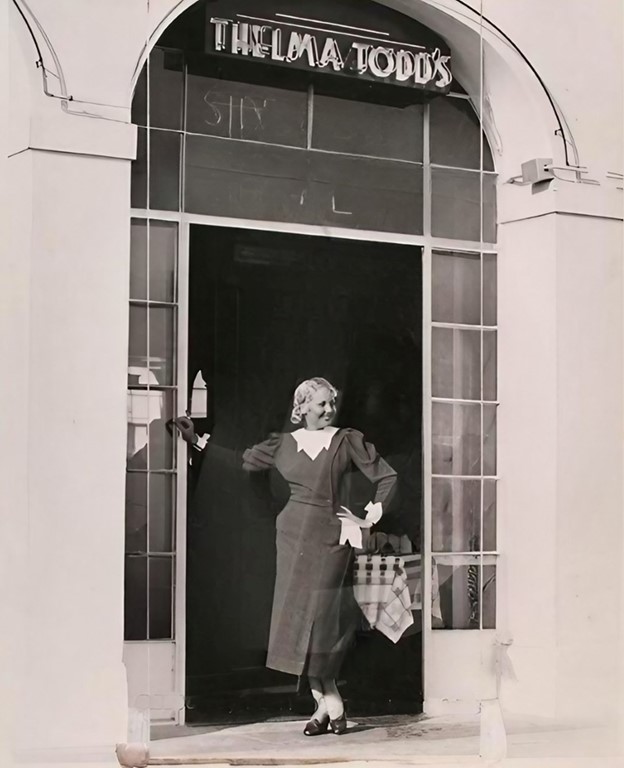 |
|
| (1934)* - Thelma Todd stands in the entryway of her new café. |
Historical Notes In the summer of 1934, Hollywood actress Thelma Todd and her lover/business partner, director Roland West, opened Thelma Todd's Sidewalk Café on the ground floor of the building. The café quickly became a popular destination for Hollywood's elite, known for its high-end seafood menu and glamorous atmosphere. |
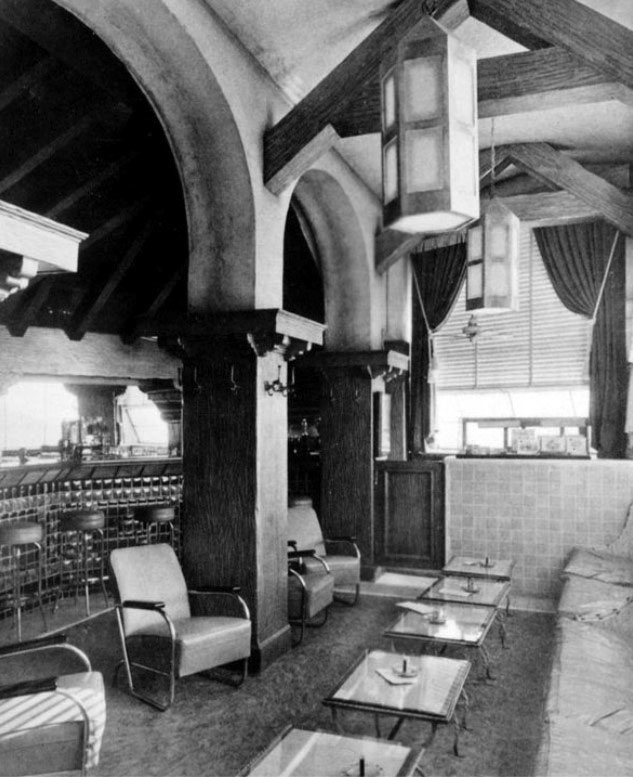 |
|
| (ca. 1934)* - Interior view of Thelma Todd's Sidewalk Café's cocktail room. |
Historical Notes Thelma Todd's Sidewalk Café was a stylish establishment featuring a ground-floor bar, a private upstairs dining area called Joya's Room, and a menu with specialty seafood dishes, including New England-style offerings. Known for its unique cocktails named after celebrities, like the Todd Gin Sour and Thelma Todd Rickey, the café attracted patrons in part due to Todd's frequent presence behind the counter, where she engaged with customers and promoted the business through interviews and photo opportunities. The building itself had a multi-level layout: the café occupied the ground floor, while the second floor housed Joya's Room, Todd’s apartment, and an adjoining apartment for her business partner, connected by a sliding door. A ballroom with a hexagonal shape and a bandstand occupied the third floor, providing an elegant space for events. |
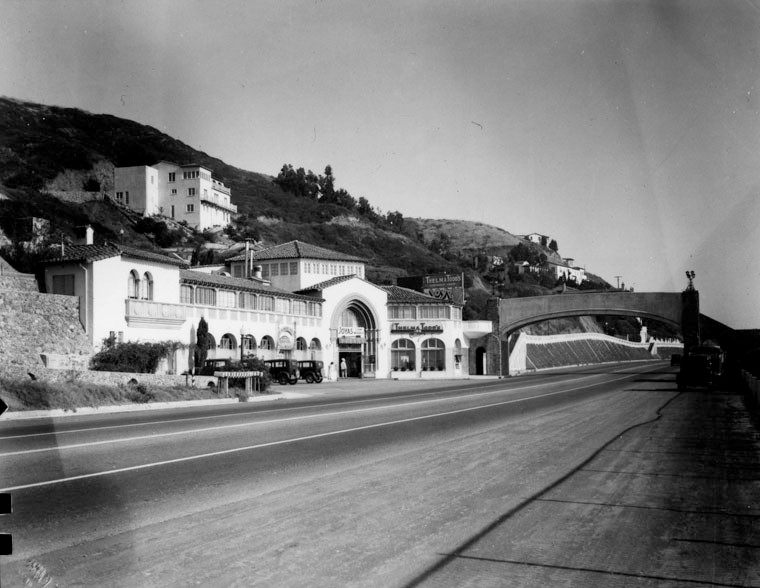 |
|
| (1937)* - View looking south of the three-story, 15,000-square-foot Spanish style Thelma Todd's Sidewalk Café, located at 17575 Pacific Coast Highway in Pacific Palisades. |
Historical Notes On the morning of December 16, 1935, Thelma Todd was found dead in her car inside the garage of Jewel Carmen, a former actress and former wife of Todd's lover and business partner, Roland West. Carmen's house was approximately a block from the topmost side of Todd's restaurant. Her death was determined to have been caused by carbon monoxide poisoning. Todd had a wide circle of friends and associates as well as a busy social life; police investigations revealed that she had spent the previous Saturday night (December 14) at the Trocadero, a popular Hollywood restaurant, at a party hosted by entertainer Stanley Lupino and his actress daughter, Ida. At the restaurant, she had had a brief but unpleasant exchange with her ex-husband, Pat DiCicco. However, her friends stated that she was in good spirits, and were aware of nothing unusual in her life that could suggest a reason for committing suicide. She was driven home from the party in the early hours of December 15 by her chauffeur. |
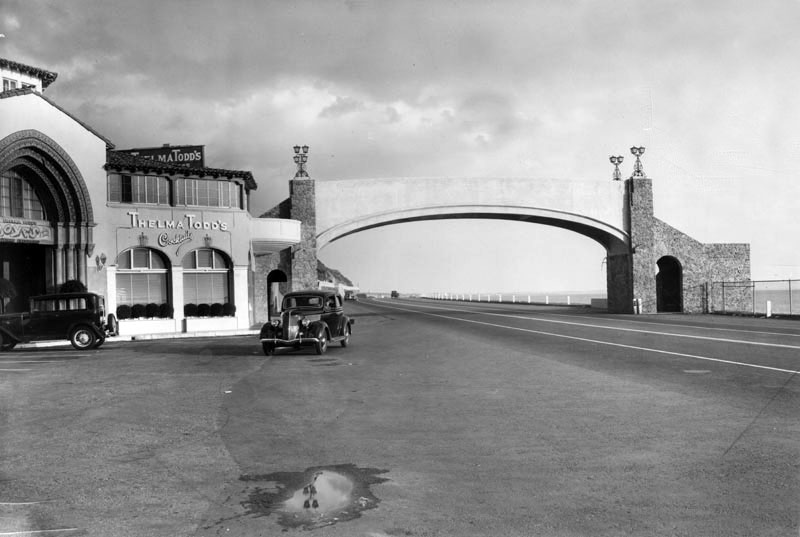 |
|
| (1935)* – View of Thelma Todd’s Sidewalk Café and the pedestrian bridge crossing over Pacific Coast Highway. |
Historical Notes The detectives of the LAPD concluded that Todd's death was accidental, the result of her either warming up the car to drive it or using the heater to keep herself warm; however, other evidence, such as a bloodied lip, seemed to point to foul play. |
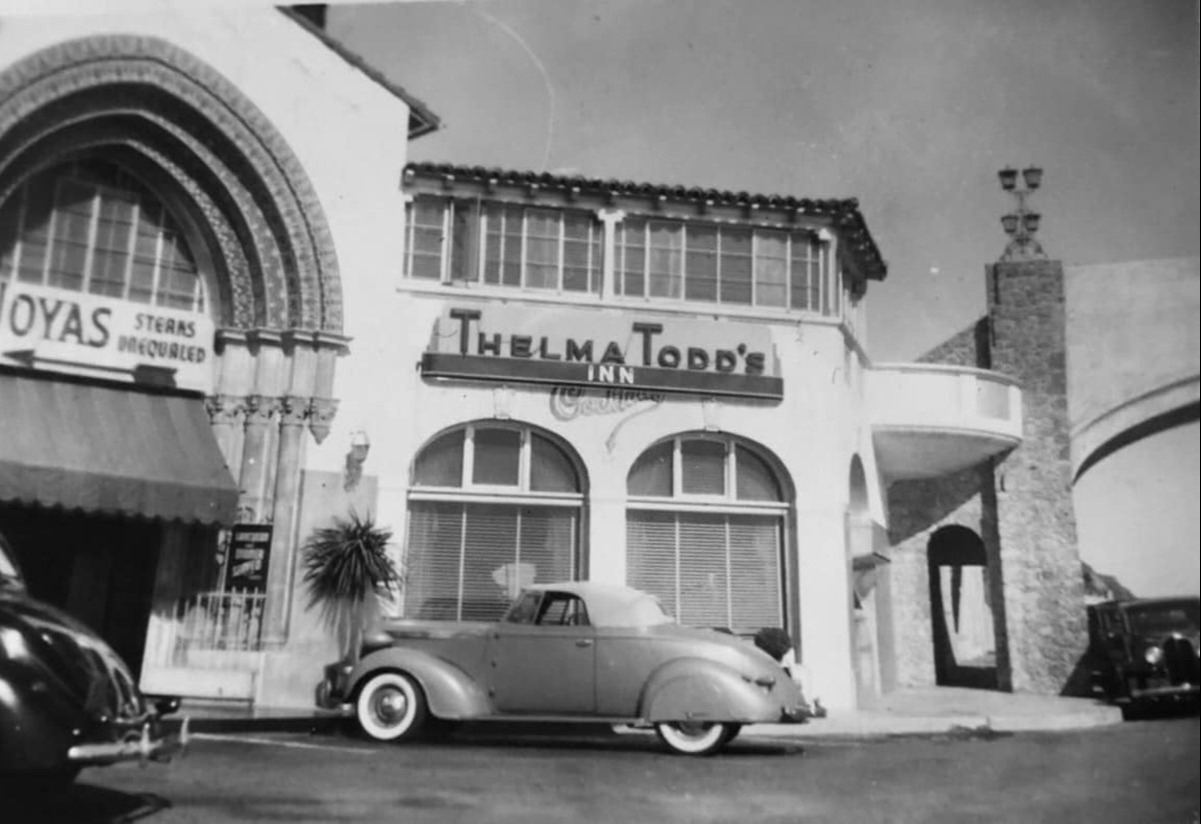 |
|
| (1930s)* - A beautiful convertible is parked in front of Thelma Todd’s Inn. |
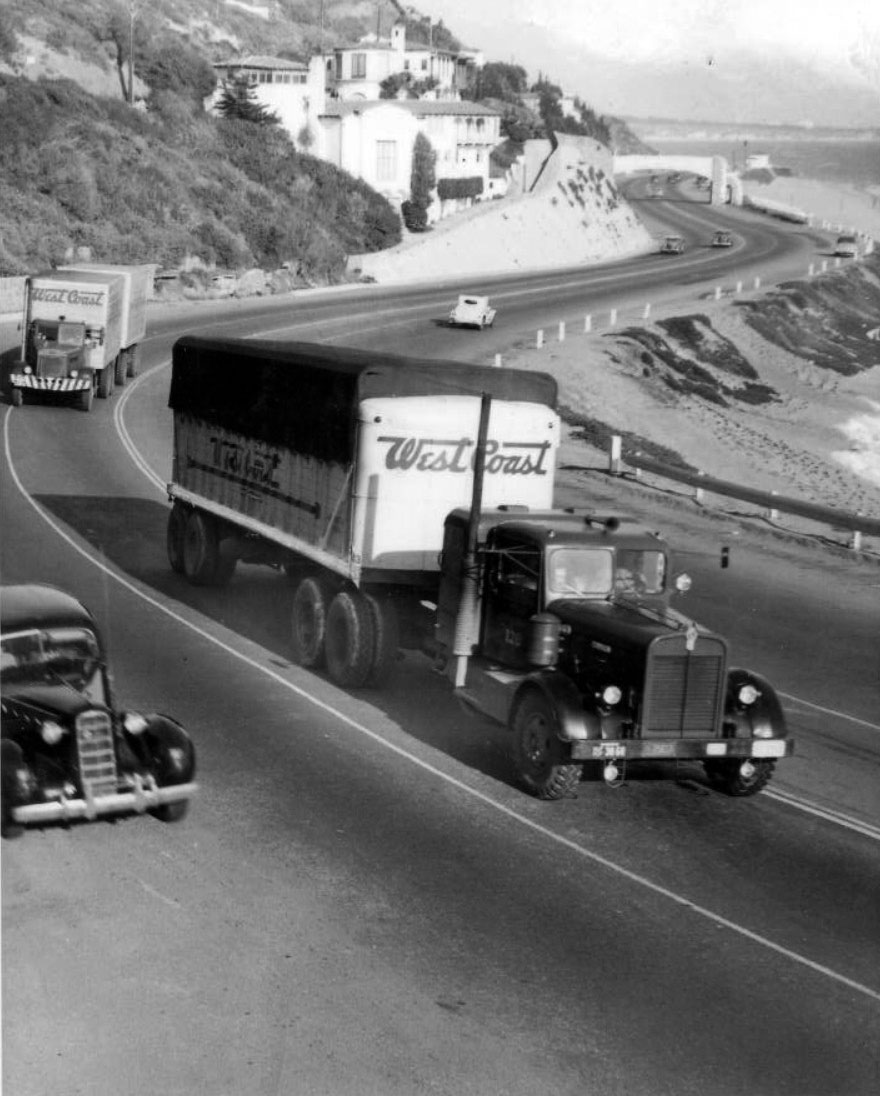 |
|
| (1930s)* – View showing two tractor trailer trucks heading west on the Roosevelt Highway (later Pacific Coast Highway) through the residential area known as Castellammare in Pacific Palisades. The pedestrian bridge adjacent to Thelma Todd’s Sidewalk Café is seen in the background. |
Historical Notes Tractor trailer trucks first became widely used on American highways in the 1930s. This period marked a crucial turning point for the trucking industry, as these vehicles revolutionized long-distance haulage and transportation of goods. |
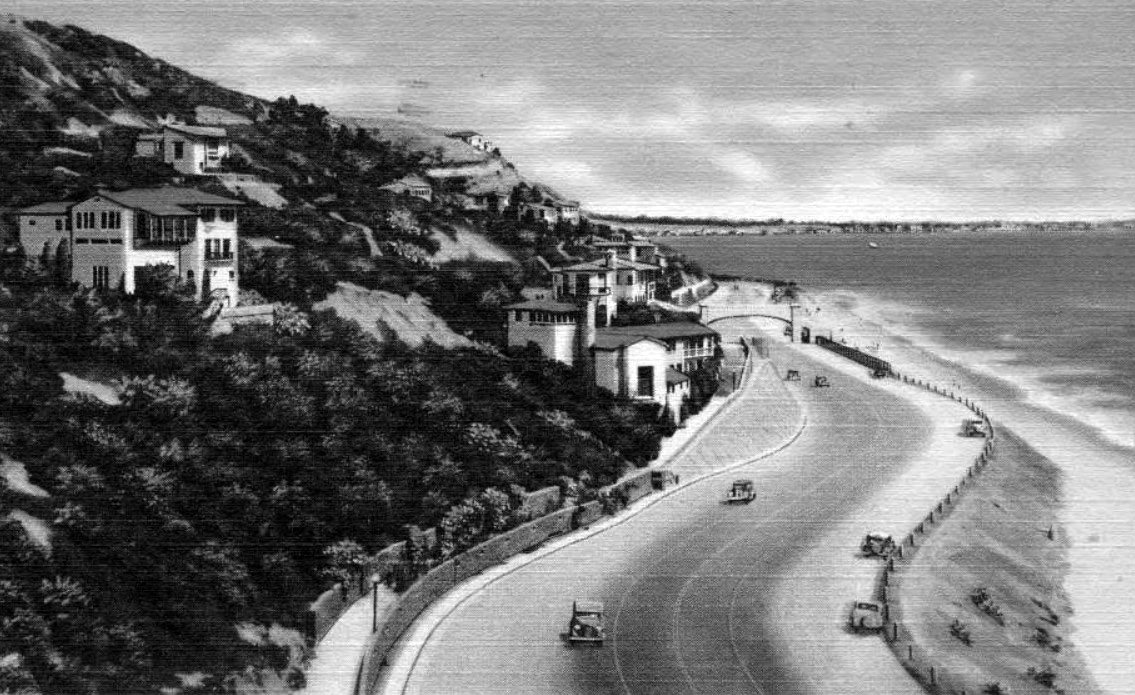 |
|
| (1930s)* – Postcard view looking east on Roosevelt Highway (later Pacific Coast Highway) and the beach near the Castellammare area of Pacific Palisades just northwest of Santa Monica. |
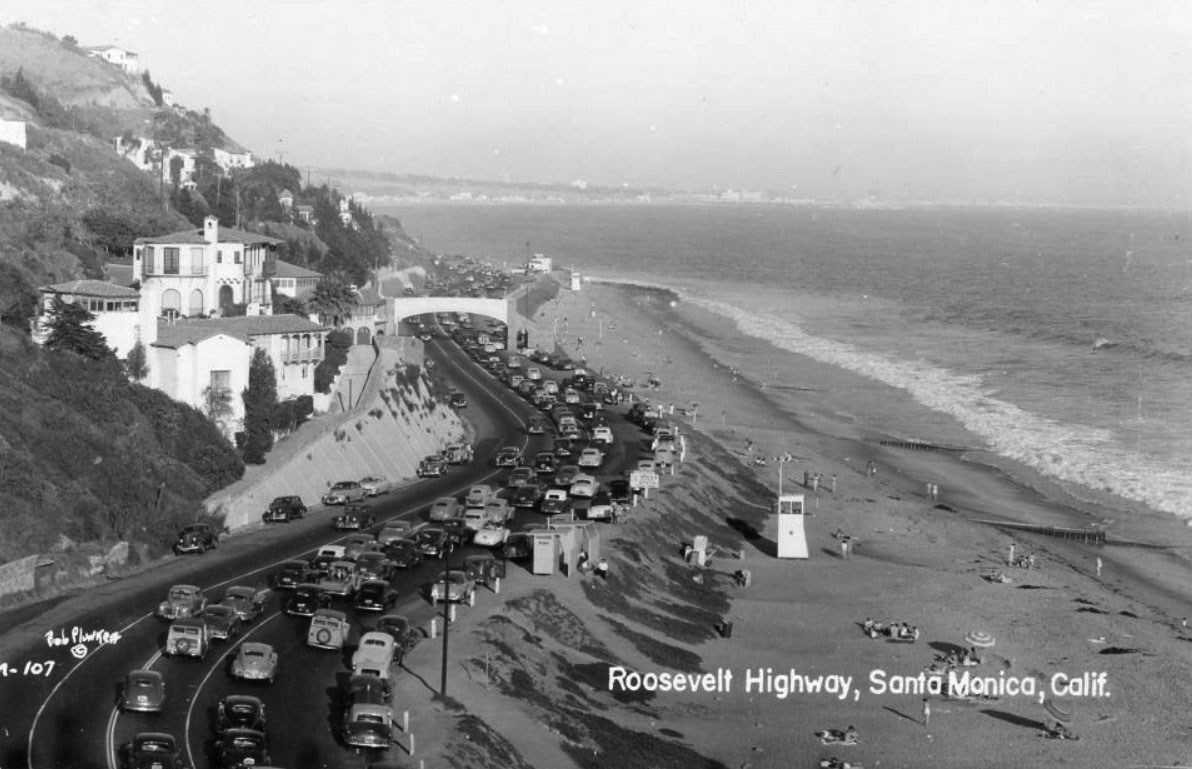 |
|
| (1940s)* – Postcard view looking east on the Roosevelt Highway (later Pacific Coast Highway) crowded with traffic near the Castellammare area of Pacific Palisades just northwest of Santa Monica. |
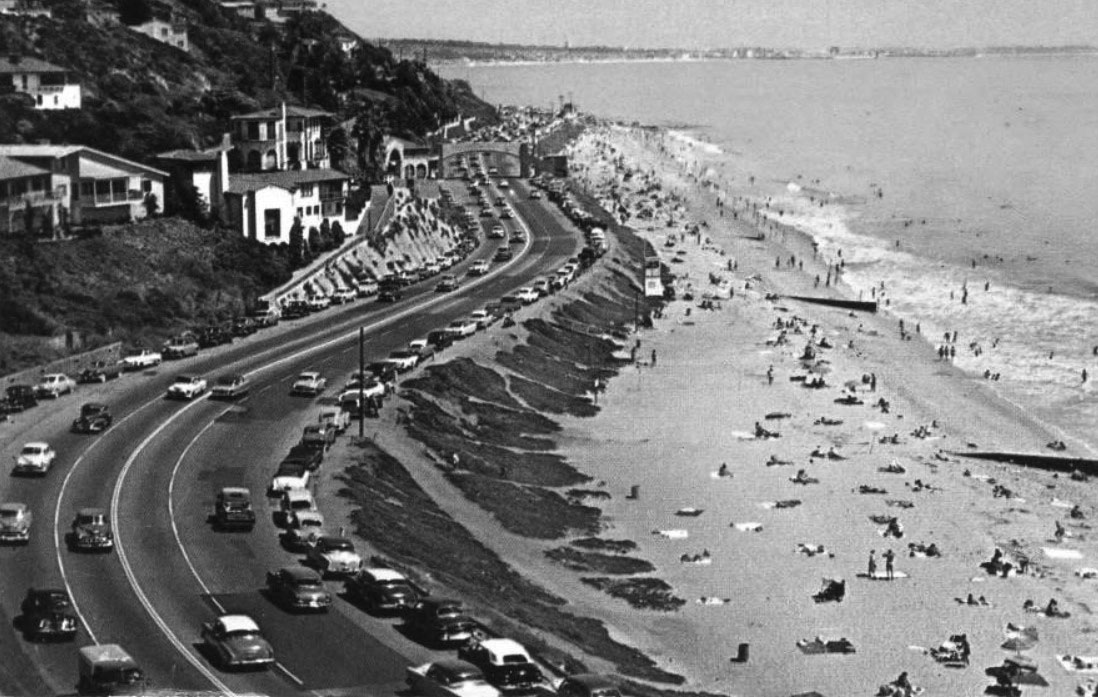 |
|
| (1950s)* - View looking east towards Santa Monica, from Pacific Palisades on the Pacific Coast Highway. |
Then and Now
 |
|
| Then and Now - Thelma Todd’s Café Shop, today a commercial office building, 17575 Pacific Coast Highway in Pacific Palisades. Photo comparison by Trey Callaway* |
Historical Notes Over the decades, the building experienced periods of vacancy and various uses, including serving as a private residence and housing different businesses. Today, the Spanish Colonial Revival building has been renovated and is marketed as a creative office space called "Surfside" by Vibe Office Properties. Photo comparison by Trey Callaway. |
* * * * * |
Please Support Our CauseWater and Power Associates, Inc. is a non-profit, public service organization dedicated to preserving historical records and photos. Your generosity allows us to continue to disseminate knowledge of the rich and diverse multicultural history of the greater Los Angeles area; to serve as a resource of historical information; and to assist in the preservation of the city's historic records.
|
More Historical Early Views
Newest Additions
Early LA Buildings and City Views
History of Water and Electricity in Los Angeles
* * * * * |
References and Credits
* LA Public Library Image Archive
^^California State Library Image Archive
^* LMU Digital Collection: Arcadia Hotel
*# The Los Angeles County Metro Division 7
#^ Santa Monica Public Library Image Archive
#+ Wehoville.com: Balloon Route
#^*Ocean Park History: oceanpark.wordpress.com
*^*Paradise Leased: Arcadia Hotel
**^Noirish Los Angeles - forum.skyscraperpage.com; The Long Wharf; Camera Obscura; Acadamy of the Holy Names; Inceville - Inceville - palipost.com
*#*KCET: Arch Rock and Castle Rocks; Rail Returns to the Westside: The Expo Line's Historical Precursors
^#*Santa Monica History Museum
^*#Huntington Palisades - A Brief History
*^#Nuestra Señora la Reina de los Ángeles: losangelespast.com
#**MTA Transportation and Research Library Archives
#^^Huntington Digital Library Archive; Arcadia Roller Coaster; Arcadia Roller Coaster 2; Visitors to SM Beach; Southern Pacific RR
^##The Malibu Times: On the Villa de Leon
###Ingersoll's Century History, Santa Monica Bay Cities
^x^Facebook.com: Venice, Ca, Ocean Park, & Santa Monica in the 20th Century
***^History of the Fairmont Miramar Hotel and Bungalows
**^^TheLosAngelesBeat.com: Camera Obscura
^^**Atlas Obscura: Santa Monica Camera Obscura
^*##Facebook.com - Bizarre Los Angeles
*^^#LAistory: The Santa Monica Pier
^##^San Fernando Valley Historical Society/Facebook.com 1st Mail Wagon
^##*Inthecanyon.com: History of Santa Monica Canyon
^#^#CSUN Oviatt Library Digital Archives
+#+#The Famous Lighthouse that Almost Came to Pepperdine
#**#Santa Monica Local History: blogspot.com
#^^^Survey LA: Brentwod-Pacific Palisades Community Plan Area
#^^*Pinterest.com: Old Hollywood
#^#*Denver Public Library Image Archive
*^Wikipedia: California State Route 1; History of Santa Monica; Los Angeles and Independence Railroad; Griffith J. Griffith; Memorial Day; Pacific Electric Railway; Thelma Todd
< Back
Menu
- Home
- Mission
- Museum
- Major Efforts
- Recent Newsletters
- Historical Op Ed Pieces
- Board Officers and Directors
- Mulholland/McCarthy Service Awards
- Positions on Owens Valley and the City of Los Angeles Issues
- Legislative Positions on
Water Issues
- Legislative Positions on
Energy Issues
- Membership
- Contact Us
- Search Index
